Palm 93001 CELL/PCS CDMA Smartphone W/ Bluetooth User Manual Ventura Sprint User Guide
Palm Inc CELL/PCS CDMA Smartphone W/ Bluetooth Ventura Sprint User Guide
Palm >
Users Manual
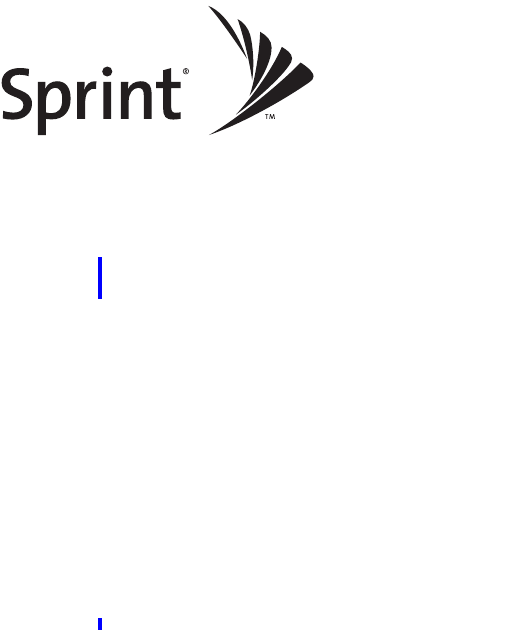
Sprint PCS® Service
Sprint Power Vision Smart Device
Treo™ 700P by Palm
www.sprint.com
© Sprint Nextel. All rights reserved. No reproduction in whole
or in part without prior written approval. Sprint, the “Going
Forward” logo, and other trademarks are trademarks of Sprint
Nextel.
Printed in the U.S.A.
PN: 406-10412-00
v. 0 0
FINAL DRAFT Palm, Inc. Confidential
Intellectual Property Notices
© 2006 Palm, Inc. All rights reserved. Blazer, HotSync, Palm, Palm OS, Treo device, VersaMail, and the Palm and Treo
device logos are among the trademarks or registered trademarks owned by or licensed to Palm, Inc. This product con-
tains ACCESS Co., Ltd.’s NetFront 3.0 Internet browser software. © 1996-2005 ACCESS Co., Ltd. and ACCESS Systems
America, Inc. NetFront is the trademark or registered trademark of ACCESS Co., Ltd. in Japan and in other countries
except the United States of America. NetFront is a registered trademark of NetFront Communications, Inc. in the
United States of America and is used under a license. Documents To Go is a trademark or registered trademark of Dat-
aViz, Inc. A portion of the enclosed product is © copyrighted by Fraunhofer IIS (2005). All rights reserved. All other
brand and product names are or may be trademarks of, and are used to identify products or services of, their respec-
tive owners.
This product is protected by one or more of the following United States patents:
6,976,226; 6,975,304; 6,965,375; 6,961,567; 6,961,029; 6,957,397;
6,952,571; 6,950,988; 6,947,975; 6,947,017; 6,943,667; 6,940,490;
6,924,752; 6,907,233; 6,906,701; 6,906,741; 6,901,276; 6,850,780;
6,845,408; 6,842,628; 6,842,335; 6,831,662; 6,819,552; 6,804,699;
6,795,710; 6,788,285; 6,781,824; 6,781,575; 6,766,490; 6,745,047;
6,744,451; 6,738,852; 6,732,105; 6,724,720; 6,721,892; 6,712,638;
6,708,280; 6,697,639; 6,687,839; 6,685,328; 6,665,803; 6,618,044
;6,590,588; 6,539,476; 6,532,148 ;6,523,124; 6,519,141; 6,516,202;
6,490,155; 6,480,146; 6,457,134; 6,456,247; 6,442,637; 6,441,824;
6,437,543; 6,429,625; 6,425,087; 6,389,572; 6,388,877; 6,381,650;
6,363,082; 6,344,848; 6,317,085; 6,241,537; 6,222,857; 6,185,423;
6,147,314; 6,115,248; 6,064,342; D421,251; D429,252; D466,128;
D478,091. Patent pending.
This product also is licensed under United States patent 6,058,304.
A portion of this software includes software modules developed by the Independent JPEG group. MPEG Layer-3 audio
decoding technology is licensed from Fraunhofer IIS and Thomson. This product is protected by certain intellectual
property rights of Microsoft Corporation. Use or distribution of such technology outside of this product is prohibited
without a license from Microsoft or an authorized Microsoft subsidiary.
Disclaimer and Limitation of Liability
Palm, Inc. and its suppliers assume no responsibility for any damage or loss resulting from the use of this guide. Palm,
Inc. and its suppliers assume no responsibility for any loss or claims by third parties that may arise through the use of
this software. Palm, Inc. and its suppliers assume no responsibility for any damage or loss caused by deletion of data
as a result of malfunction, dead battery, or repairs. Be sure to make backup copies of all important data on other
media to protect against data loss.
FINAL DRAFT Palm, Inc. Confidential

Table of Contents
Welcome to Sprint . . . . . . . . . . . . . . . . . . . . . . . . . . . . . . . . . . . . . . . . . . . . . . . . . . . i
How to Use This Guide . . . . . . . . . . . . . . . . . . . . . . . . . . . . . . . . . . . . . . . . . . . . . . . .ii
Section 1: Setting Up Your Smart Device
and Your Computer . . . . . . . . . . . . . . . . . . . . . . . . . . . . . . . . . . . . . . . . . . . . . . . . . . .1
1A. Setting Up Your Sprint Power Vision Smart Device Treo™ 700P by Palm . . . . 3
What You Need . . . . . . . . . . . . . . . . . . . . . . . . . . . . . . . . . . . . . . . . . . . . . . . . . . . . . . . . . . . . . . . . . . . . . . . 4
Your New Treo 700P Smart Device . . . . . . . . . . . . . . . . . . . . . . . . . . . . . . . . . . . . . . . . . . . . . . . . . . . . . 6
Inserting the Battery . . . . . . . . . . . . . . . . . . . . . . . . . . . . . . . . . . . . . . . . . . . . . . . . . . . . . . . . . . . . . . . . .11
Charging the Battery . . . . . . . . . . . . . . . . . . . . . . . . . . . . . . . . . . . . . . . . . . . . . . . . . . . . . . . . . . . . . . . . .13
1B. Setting Up Service . . . . . . . . . . . . . . . . . . . . . . . . . . . . . . . . . . . . . . . . . . . . . . . . . . 19
Making Your First Call . . . . . . . . . . . . . . . . . . . . . . . . . . . . . . . . . . . . . . . . . . . . . . . . . . . . . . . . . . . . . . . .20
Setting Up Your Voicemail . . . . . . . . . . . . . . . . . . . . . . . . . . . . . . . . . . . . . . . . . . . . . . . . . . . . . . . . . . . . 23
Creating Sprint PCS® Account Passwords . . . . . . . . . . . . . . . . . . . . . . . . . . . . . . . . . . . . . . . . . . . . .24
1C. Connecting to Your Computer . . . . . . . . . . . . . . . . . . . . . . . . . . . . . . . . . . . . . . . . 25
Why Connect My Device to My Computer? . . . . . . . . . . . . . . . . . . . . . . . . . . . . . . . . . . . . . . . . . . . .26
Upgrading From Another Palm OS® Device . . . . . . . . . . . . . . . . . . . . . . . . . . . . . . . . . . . . . . . . . . .27
Installing the Desktop Synchronization Software . . . . . . . . . . . . . . . . . . . . . . . . . . . . . . . . . . . . . . 30
Connecting Your Treo Device to Your Computer . . . . . . . . . . . . . . . . . . . . . . . . . . . . . . . . . . . . . . . 32
Synchronizing Information—The Basics . . . . . . . . . . . . . . . . . . . . . . . . . . . . . . . . . . . . . . . . . . . . . .33
FINAL DRAFT Palm, Inc. Confidential
Section 2: Your Treo™ 700P Smart Device . . . . . . . . . . . . . . . . . . . . . . . . . . . . . .37
2A. Moving Around on Your Smart Device . . . . . . . . . . . . . . . . . . . . . . . . . . . . . . . . . 39
Moving Around the Device Screen . . . . . . . . . . . . . . . . . . . . . . . . . . . . . . . . . . . . . . . . . . . . . . . . . . . .40
Using the Keyboard . . . . . . . . . . . . . . . . . . . . . . . . . . . . . . . . . . . . . . . . . . . . . . . . . . . . . . . . . . . . . . . . . . 45
Opening Applications . . . . . . . . . . . . . . . . . . . . . . . . . . . . . . . . . . . . . . . . . . . . . . . . . . . . . . . . . . . . . . . . 50
2B. Using Your Device’s Phone Features . . . . . . . . . . . . . . . . . . . . . . . . . . . . . . . . . . 53
Turning Your Device On and Off . . . . . . . . . . . . . . . . . . . . . . . . . . . . . . . . . . . . . . . . . . . . . . . . . . . . . . 54
Opening the Phone Application . . . . . . . . . . . . . . . . . . . . . . . . . . . . . . . . . . . . . . . . . . . . . . . . . . . . . .56
Making Calls . . . . . . . . . . . . . . . . . . . . . . . . . . . . . . . . . . . . . . . . . . . . . . . . . . . . . . . . . . . . . . . . . . . . . . . . . 57
Receiving Calls . . . . . . . . . . . . . . . . . . . . . . . . . . . . . . . . . . . . . . . . . . . . . . . . . . . . . . . . . . . . . . . . . . . . . . . 62
Using Voicemail . . . . . . . . . . . . . . . . . . . . . . . . . . . . . . . . . . . . . . . . . . . . . . . . . . . . . . . . . . . . . . . . . . . . . 64
Managing Active Calls . . . . . . . . . . . . . . . . . . . . . . . . . . . . . . . . . . . . . . . . . . . . . . . . . . . . . . . . . . . . . . . .67
Using Sprint PCS® Voice Command . . . . . . . . . . . . . . . . . . . . . . . . . . . . . . . . . . . . . . . . . . . . . . . . . . .76
Defining Favorite Buttons . . . . . . . . . . . . . . . . . . . . . . . . . . . . . . . . . . . . . . . . . . . . . . . . . . . . . . . . . . . . 78
Using a Phone Headset . . . . . . . . . . . . . . . . . . . . . . . . . . . . . . . . . . . . . . . . . . . . . . . . . . . . . . . . . . . . . . . 82
Customizing Phone Settings . . . . . . . . . . . . . . . . . . . . . . . . . . . . . . . . . . . . . . . . . . . . . . . . . . . . . . . . . .88
Controlling Your Roaming Experience . . . . . . . . . . . . . . . . . . . . . . . . . . . . . . . . . . . . . . . . . . . . . . . .98
Checking Signal Strength and Phone Status . . . . . . . . . . . . . . . . . . . . . . . . . . . . . . . . . . . . . . . . . .100
Section 3: Using Sprint PCS Vision® and Other Wireless Connections . . . . 105
3A. Sprint PCS Vision®—The Basics . . . . . . . . . . . . . . . . . . . . . . . . . . . . . . . . . . . . . . 107
Getting Started With Sprint PCS Vision . . . . . . . . . . . . . . . . . . . . . . . . . . . . . . . . . . . . . . . . . . . . . .108
Sprint Power Vision Features . . . . . . . . . . . . . . . . . . . . . . . . . . . . . . . . . . . . . . . . . . . . . . . . . . . . . . . .109
Accessing Sprint PCS Vision . . . . . . . . . . . . . . . . . . . . . . . . . . . . . . . . . . . . . . . . . . . . . . . . . . . . . . . . .111
FINAL DRAFT Palm, Inc. Confidential
3B. Sprint Power VisionSM . . . . . . . . . . . . . . . . . . . . . . . . . . . . . . . . . . . . . . . . . . . . . 113
Getting to Know Sprint Power Vision . . . . . . . . . . . . . . . . . . . . . . . . . . . . . . . . . . . . . . . . . . . . . . . .114
Personalizing Your Service With On Demand . . . . . . . . . . . . . . . . . . . . . . . . . . . . . . . . . . . . . . . . .115
Using Your Device’s Phone as a Modem . . . . . . . . . . . . . . . . . . . . . . . . . . . . . . . . . . . . . . . . . . . . . .118
3C. Using Email . . . . . . . . . . . . . . . . . . . . . . . . . . . . . . . . . . . . . . . . . . . . . . . . . . . . . . . 121
What Email Applications Can I Use on My Smart Device? . . . . . . . . . . . . . . . . . . . . . . . . . . . . .122
The VersaMail Application . . . . . . . . . . . . . . . . . . . . . . . . . . . . . . . . . . . . . . . . . . . . . . . . . . . . . . . . . .124
Sprint PCS Business ConnectionSM Personal Edition . . . . . . . . . . . . . . . . . . . . . . . . . . . . . . . . . . .142
Using GoodLink™ Applications Software . . . . . . . . . . . . . . . . . . . . . . . . . . . . . . . . . . . . . . . . . . . . .143
3D. Messaging . . . . . . . . . . . . . . . . . . . . . . . . . . . . . . . . . . . . . . . . . . . . . . . . . . . . . . . . 145
Creating and Sending Messages . . . . . . . . . . . . . . . . . . . . . . . . . . . . . . . . . . . . . . . . . . . . . . . . . . . . .146
Receiving Messages . . . . . . . . . . . . . . . . . . . . . . . . . . . . . . . . . . . . . . . . . . . . . . . . . . . . . . . . . . . . . . . . .151
Using Messaging to Chat . . . . . . . . . . . . . . . . . . . . . . . . . . . . . . . . . . . . . . . . . . . . . . . . . . . . . . . . . . . .154
Managing Your Messages . . . . . . . . . . . . . . . . . . . . . . . . . . . . . . . . . . . . . . . . . . . . . . . . . . . . . . . . . . .155
Customizing Your Messaging Settings . . . . . . . . . . . . . . . . . . . . . . . . . . . . . . . . . . . . . . . . . . . . . . .156
Using Online Services . . . . . . . . . . . . . . . . . . . . . . . . . . . . . . . . . . . . . . . . . . . . . . . . . . . . . . . . . . . . . . .158
3E. Browsing the Web . . . . . . . . . . . . . . . . . . . . . . . . . . . . . . . . . . . . . . . . . . . . . . . . . 159
Viewing a Web Page . . . . . . . . . . . . . . . . . . . . . . . . . . . . . . . . . . . . . . . . . . . . . . . . . . . . . . . . . . . . . . . .160
Working With Web Pages . . . . . . . . . . . . . . . . . . . . . . . . . . . . . . . . . . . . . . . . . . . . . . . . . . . . . . . . . . .163
Working With Bookmarks and Saved Pages . . . . . . . . . . . . . . . . . . . . . . . . . . . . . . . . . . . . . . . . . .167
Customizing Your Web Browser Settings . . . . . . . . . . . . . . . . . . . . . . . . . . . . . . . . . . . . . . . . . . . .170
3F. Using Bluetooth® Wireless Technology and
Dial-Up Networking 173
Connecting to Devices With Bluetooth® Wireless Technology . . . . . . . . . . . . . . . . . . . . . . . .174
Using Your Device as a Wireless Modem . . . . . . . . . . . . . . . . . . . . . . . . . . . . . . . . . . . . . . . . . . . . .178
FINAL DRAFT Palm, Inc. Confidential
Section 4: Your Portable Media Device . . . . . . . . . . . . . . . . . . . . . . . . . . . . . . 183
4A. Working With Your Pictures and Videos . . . . . . . . . . . . . . . . . . . . . . . . . . . . . . 185
Taking Pictures and Videos . . . . . . . . . . . . . . . . . . . . . . . . . . . . . . . . . . . . . . . . . . . . . . . . . . . . . . . . . .186
Customizing Your Camera Settings . . . . . . . . . . . . . . . . . . . . . . . . . . . . . . . . . . . . . . . . . . . . . . . . . .191
Viewing Pictures and Videos . . . . . . . . . . . . . . . . . . . . . . . . . . . . . . . . . . . . . . . . . . . . . . . . . . . . . . . .193
Organizing Pictures and Videos . . . . . . . . . . . . . . . . . . . . . . . . . . . . . . . . . . . . . . . . . . . . . . . . . . . . . .195
Using Your Online Album . . . . . . . . . . . . . . . . . . . . . . . . . . . . . . . . . . . . . . . . . . . . . . . . . . . . . . . . . . .200
Viewing Pictures and Videos on Your Computer . . . . . . . . . . . . . . . . . . . . . . . . . . . . . . . . . . . . . .202
4B. Listening to Music . . . . . . . . . . . . . . . . . . . . . . . . . . . . . . . . . . . . . . . . . . . . . . . . . 203
Setting Up Windows Media Player for MP3 . . . . . . . . . . . . . . . . . . . . . . . . . . . . . . . . . . . . . . . . . .204
Transferring MP3 Files From Your Computer . . . . . . . . . . . . . . . . . . . . . . . . . . . . . . . . . . . . . . . . .206
Transferring Music From a CD to Your Device . . . . . . . . . . . . . . . . . . . . . . . . . . . . . . . . . . . . . . . .208
Listening to Music on Your Treo Device . . . . . . . . . . . . . . . . . . . . . . . . . . . . . . . . . . . . . . . . . . . . . .209
4C. Watching Sprint TVSM . . . . . . . . . . . . . . . . . . . . . . . . . . . . . . . . . . . . . . . . . . . . . . . 213
Accessing Streamed Media . . . . . . . . . . . . . . . . . . . . . . . . . . . . . . . . . . . . . . . . . . . . . . . . . . . . . . . . . .214
Viewing Streamed Media . . . . . . . . . . . . . . . . . . . . . . . . . . . . . . . . . . . . . . . . . . . . . . . . . . . . . . . . . . .216
Section 5: Your Mobile Organizer . . . . . . . . . . . . . . . . . . . . . . . . . . . . . . . . . . . 217
5A. Using Your Device’s Organizer Features . . . . . . . . . . . . . . . . . . . . . . . . . . . . . . 219
Contacts . . . . . . . . . . . . . . . . . . . . . . . . . . . . . . . . . . . . . . . . . . . . . . . . . . . . . . . . . . . . . . . . . . . . . . . . . . . .220
Calendar . . . . . . . . . . . . . . . . . . . . . . . . . . . . . . . . . . . . . . . . . . . . . . . . . . . . . . . . . . . . . . . . . . . . . . . . . . . .224
Tasks . . . . . . . . . . . . . . . . . . . . . . . . . . . . . . . . . . . . . . . . . . . . . . . . . . . . . . . . . . . . . . . . . . . . . . . . . . . . . . .235
Memos . . . . . . . . . . . . . . . . . . . . . . . . . . . . . . . . . . . . . . . . . . . . . . . . . . . . . . . . . . . . . . . . . . . . . . . . . . . . .240
FINAL DRAFT Palm, Inc. Confidential
5B. Increasing Your Productivity . . . . . . . . . . . . . . . . . . . . . . . . . . . . . . . . . . . . . . . . 241
Using the Documents Application to Work With Your Office Files . . . . . . . . . . . . . . . . . . . . .242
Voice Memo . . . . . . . . . . . . . . . . . . . . . . . . . . . . . . . . . . . . . . . . . . . . . . . . . . . . . . . . . . . . . . . . . . . . . . . .244
World Clock . . . . . . . . . . . . . . . . . . . . . . . . . . . . . . . . . . . . . . . . . . . . . . . . . . . . . . . . . . . . . . . . . . . . . . . . .246
Calculator . . . . . . . . . . . . . . . . . . . . . . . . . . . . . . . . . . . . . . . . . . . . . . . . . . . . . . . . . . . . . . . . . . . . . . . . . .248
Section 6: Managing Your Information
and Settings . . . . . . . . . . . . . . . . . . . . . . . . . . . . . . . . . . . . . . . . . . . . . . . . . . . . . . 251
6A. Managing Files and Applications . . . . . . . . . . . . . . . . . . . . . . . . . . . . . . . . . . . . 253
Using Find . . . . . . . . . . . . . . . . . . . . . . . . . . . . . . . . . . . . . . . . . . . . . . . . . . . . . . . . . . . . . . . . . . . . . . . . . .254
Installing Applications . . . . . . . . . . . . . . . . . . . . . . . . . . . . . . . . . . . . . . . . . . . . . . . . . . . . . . . . . . . . . .255
Removing Applications . . . . . . . . . . . . . . . . . . . . . . . . . . . . . . . . . . . . . . . . . . . . . . . . . . . . . . . . . . . . . .258
Viewing Application Information . . . . . . . . . . . . . . . . . . . . . . . . . . . . . . . . . . . . . . . . . . . . . . . . . . . .260
Sending Information Using Bluetooth® Wireless Technology . . . . . . . . . . . . . . . . . . . . . . . . .261
Beaming Information . . . . . . . . . . . . . . . . . . . . . . . . . . . . . . . . . . . . . . . . . . . . . . . . . . . . . . . . . . . . . . .264
Synchronizing Information—Advanced . . . . . . . . . . . . . . . . . . . . . . . . . . . . . . . . . . . . . . . . . . . . . .268
Using Expansion Cards . . . . . . . . . . . . . . . . . . . . . . . . . . . . . . . . . . . . . . . . . . . . . . . . . . . . . . . . . . . . . .276
6B. Customizing Your Device . . . . . . . . . . . . . . . . . . . . . . . . . . . . . . . . . . . . . . . . . . . 283
Setting System Sounds . . . . . . . . . . . . . . . . . . . . . . . . . . . . . . . . . . . . . . . . . . . . . . . . . . . . . . . . . . . . . .284
Adjusting the Display and Appearance . . . . . . . . . . . . . . . . . . . . . . . . . . . . . . . . . . . . . . . . . . . . . . .286
Changing the Applications Settings . . . . . . . . . . . . . . . . . . . . . . . . . . . . . . . . . . . . . . . . . . . . . . . . . .290
Customizing Device Buttons . . . . . . . . . . . . . . . . . . . . . . . . . . . . . . . . . . . . . . . . . . . . . . . . . . . . . . . .292
Setting the Date and Time . . . . . . . . . . . . . . . . . . . . . . . . . . . . . . . . . . . . . . . . . . . . . . . . . . . . . . . . . .294
Optimizing Power Settings . . . . . . . . . . . . . . . . . . . . . . . . . . . . . . . . . . . . . . . . . . . . . . . . . . . . . . . . . .296
Locking Your Device and Information . . . . . . . . . . . . . . . . . . . . . . . . . . . . . . . . . . . . . . . . . . . . . . . .297
Using Connection Settings . . . . . . . . . . . . . . . . . . . . . . . . . . . . . . . . . . . . . . . . . . . . . . . . . . . . . . . . . .306
FINAL DRAFT Palm, Inc. Confidential
Purchasing Accessories for Your Device . . . . . . . . . . . . . . . . . . . . . . . . . . . . . . . . . . . . . . . . . . . . . .307
Section 7: Resources . . . . . . . . . . . . . . . . . . . . . . . . . . . . . . . . . . . . . . . . . . . . . . . 309
7A. Help . . . . . . . . . . . . . . . . . . . . . . . . . . . . . . . . . . . . . . . . . . . . . . . . . . . . . . . . . . . . . .311
Trouble Upgrading? . . . . . . . . . . . . . . . . . . . . . . . . . . . . . . . . . . . . . . . . . . . . . . . . . . . . . . . . . . . . . . . . .312
Resetting Your Treo 700P Smart Device . . . . . . . . . . . . . . . . . . . . . . . . . . . . . . . . . . . . . . . . . . . . . .314
Replacing the Battery . . . . . . . . . . . . . . . . . . . . . . . . . . . . . . . . . . . . . . . . . . . . . . . . . . . . . . . . . . . . . . .317
Troubleshooting . . . . . . . . . . . . . . . . . . . . . . . . . . . . . . . . . . . . . . . . . . . . . . . . . . . . . . . . . . . . . . . . . . . .319
Making Room on Your Treo 700P Smart Device . . . . . . . . . . . . . . . . . . . . . . . . . . . . . . . . . . . . . . .346
Third-Party Applications . . . . . . . . . . . . . . . . . . . . . . . . . . . . . . . . . . . . . . . . . . . . . . . . . . . . . . . . . . . . .347
Errors . . . . . . . . . . . . . . . . . . . . . . . . . . . . . . . . . . . . . . . . . . . . . . . . . . . . . . . . . . . . . . . . . . . . . . . . . . . . . . .349
Where to Learn More . . . . . . . . . . . . . . . . . . . . . . . . . . . . . . . . . . . . . . . . . . . . . . . . . . . . . . . . . . . . . . . .350
7B. Glossary . . . . . . . . . . . . . . . . . . . . . . . . . . . . . . . . . . . . . . . . . . . . . . . . . . . . . . . . . . 353
Section 8: Safety and Specifications . . . . . . . . . . . . . . . . . . . . . . . . . . . . . . . . . 359
8A. Important Safety Information . . . . . . . . . . . . . . . . . . . . . . . . . . . . . . . . . . . . . . . 361
General Precautions . . . . . . . . . . . . . . . . . . . . . . . . . . . . . . . . . . . . . . . . . . . . . . . . . . . . . . . . . . . . . . . . .362
Maintaining Safe Use of and Access to Your Device . . . . . . . . . . . . . . . . . . . . . . . . . . . . . . . . . . .363
Using Your Phone With a Hearing Aid Device . . . . . . . . . . . . . . . . . . . . . . . . . . . . . . . . . . . . . . . .366
Caring for the Battery . . . . . . . . . . . . . . . . . . . . . . . . . . . . . . . . . . . . . . . . . . . . . . . . . . . . . . . . . . . . . . .368
Radiofrequency (RF) Energy . . . . . . . . . . . . . . . . . . . . . . . . . . . . . . . . . . . . . . . . . . . . . . . . . . . . . . . . .370
Static Electricity, ESD, and Your Device . . . . . . . . . . . . . . . . . . . . . . . . . . . . . . . . . . . . . . . . . . . . . . .373
Owner’s Record . . . . . . . . . . . . . . . . . . . . . . . . . . . . . . . . . . . . . . . . . . . . . . . . . . . . . . . . . . . . . . . . . . . . .375
User’s Guide Proprietary Notice . . . . . . . . . . . . . . . . . . . . . . . . . . . . . . . . . . . . . . . . . . . . . . . . . . . . .375
FINAL DRAFT Palm, Inc. Confidential
8B. Specifications . . . . . . . . . . . . . . . . . . . . . . . . . . . . . . . . . . . . . . . . . . . . . . . . . . . . . 377
Specifications . . . . . . . . . . . . . . . . . . . . . . . . . . . . . . . . . . . . . . . . . . . . . . . . . . . . . . . . . . . . . . . . . . . . . . .378
Index . . . . . . . . . . . . . . . . . . . . . . . . . . . . . . . . . . . . . . . . . . . . . . . . . . . . . . . . . . . . . 381
FINAL DRAFT Palm, Inc. Confidential
FINAL DRAFT Palm, Inc. Confidential

i
Welcome to Sprint
Sprint and Nextel have come together offering you more choice and flexibility to do
whatever you want, whenever you want.
This powerful combination brings you access to more products, more services,
and more of what you need to do more of what you want. Welcome to a future
full of possibility. Welcome to the new Sprint.
Welcome and thank you for choosing Sprint.
FINAL DRAFT Palm, Inc. Confidential

ii
How to Use This Guide
We know you’re eager to start using your device right away, and the sections of
this guide are designed to help you do just that.
ࡗSection 1: Setting Up Your Smart Device and Your Computer guides you through
the process of setting up your new Treo™ 700P smart device, your Sprint PCS®
Service, and your computer.
ࡗSection 2: Your Treo™ 700P Smart Device shows you the basics of your device and
service with quick, easy-to-follow instructions. This section also describes the
features of your device’s phone and shows you how to use Sprint PCS service
features such as voicemail, call waiting, and call forwarding.
ࡗSection 3: Using Sprint PCS Vision® and Other Wireless Connections shows you how
to use Sprint PCS Vision features, including Web browsing, messaging, and
email. It also describes other types of wireless connections such as Bluetooth®
wireless technology.
ࡗSection 4: Your Portable Media Device shows you how to use your device’s
camera—including how to use the Sprint PCS® Picture Mail application—and
how to transfer and listen to music files on your device.
ࡗSection 5: Your Mobile Organizer guides you through the process of using the
built-in, full-featured, Palm OS® organizer that gives you instant access to your
Contacts, Calendar, Tasks, Memos, Calculator, and more.
FINAL DRAFT Palm, Inc. Confidential

iii
ࡗSection 6: Managing Your Information and Settings describes the tools for
managing files and applications and the preferences that enable you to
customize your device.
ࡗSection 7: Resources answers frequently asked questions and shows you what
to do if something goes wrong. It also includes a helpful glossary of terms.
ࡗSection 8: Safety and Specifications outlines recommended safety
and maintenance guidelines and displays the technical specifications for your
Treo 700P smart device.
WARNING: Please refer to “Important Safety Information” on page 361 to learn
about information that will help you safely use your phone. Failure to
read and follow the Important Safety Information in this phone guide
may result in serious bodily injury, death, or property damage.
FINAL DRAFT Palm, Inc. Confidential
iv
FINAL DRAFT Palm, Inc. Confidential
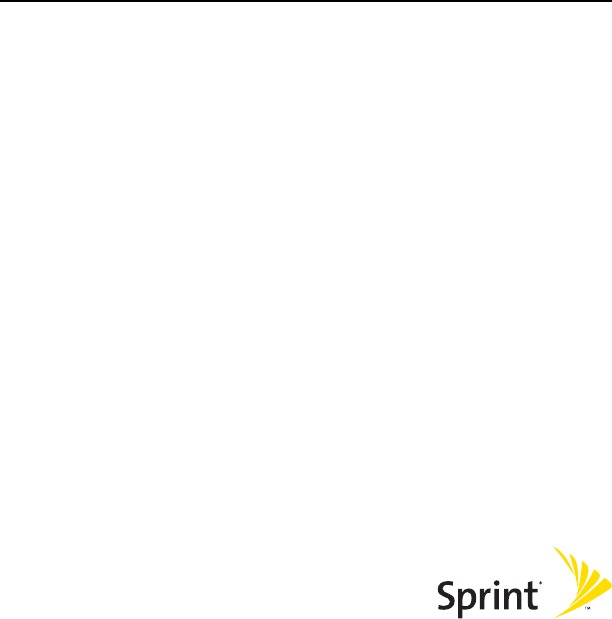
Section 1
Setting Up Your Smart Device
and Your Computer
FINAL DRAFT Palm, Inc. Confidential
2
FINAL DRAFT Palm, Inc. Confidential

Section 1A: Device Setup 3
Device Setup
Section 1A
Setting Up Your Sprint Power Vision Smart Device
Treo™ 700P by Palm
In This Section
ࡗWhat You Need
ࡗYour New Treo 700P Smart Device
ࡗInserting the Battery
ࡗCharging the Battery
FINAL DRAFT Palm, Inc. Confidential

4 Section 1A: Device Setup
What You Need
Your Treo™ 700P smart device box contains the following:
Hardware
ⅷTreo device
ⅷRechargeable battery
ⅷAC charger
ⅷUSB sync cable
ⅷStereo headset
ⅷSprint® charger adapter
Documentation
ⅷRead This First poster
ⅷWelcome to Sprint pamphlet
ⅷSprint Power Vision Smart Device Treo™ 700P by Palm Quick Reference Guide
ⅷEmail on Your Sprint Power Vision Smart Device Treo™ 700P by Palm booklet
ⅷSprint Power Vision Network pamphlet
ⅷTerms & Conditions
ⅷWarranty
ⅷSoftware License Agreement
ⅷAudible insert
FINAL DRAFT Palm, Inc. Confidential

Section 1A: Device Setup 5
Device Setup
Software
ⅷPalm Software Installation CD (includes desktop synchronization software
and bonus software for your device)
You’ll also need the following items to complete the installation and activation:
ⅷAn activated Sprint PCS® service plan
ⅷA location with wireless coverage for your device
ⅷAn electrical outlet
ⅷThe computer with which you will synchronize your personal information
FINAL DRAFT Palm, Inc. Confidential
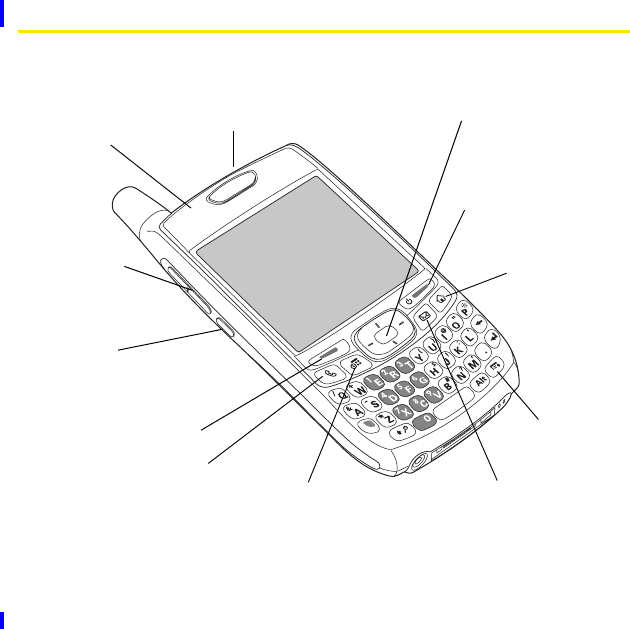
6 Section 1A: Device Setup
Your New Treo 700P Smart Device
Your Device’s Features: Front View
1. Indicator
Light
3. 5-way
Navigator
4. Power/End
Button
10. Send Button
9. Phone Button
11. Side
Button
2. Earpiece
12. Volume
Button
6. Menu
Button
8. Calendar Button
5. Applications
Button
7. Messaging
Button
FINAL DRAFT Palm, Inc. Confidential

Section 1A: Device Setup 7
Device Setup
1. Indicator Light provides status information for your device based on the color
of the light and the blink state.
2. Earpiece serves as the speaker on your device when you are not using the
speakerphone feature or a headset.
3. 5-way Navigator gives you one-handed access to moving around the device
screen and selecting options. See “Moving Around the Device Screen” on
page 40 for instructions.
4. Power/End Button turns the device’s phone on and off, wakes up and turns
off the screen, and hangs up calls.
5. Applications Button opens Applications view.
6. Menu Button opens the application menus.
7. Messaging Button opens the Messaging application. If you downloaded and
installed the Sprint PCS Business ConnectionSM application, this button
opens Business Connection (see “Sprint PCS Business ConnectionSM Personal
Edition” on page 142 for information).
8. Calendar Button opens the Calendar application.
9. Phone Button opens the Phone application.
10. Send Button dials when a phone number is selected or entered, and answers
an incoming phone call.
11. Side Button records voice memos by default, and performs context-sensitive
actions when an application is open, such as playing or pausing MP3 files in
the Pocket Tunes™ application. You can also reassign this button to open
your favorite application.
12. Volume Button adjusts the earpiece, speaker, and ringer volume levels.
FINAL DRAFT Palm, Inc. Confidential
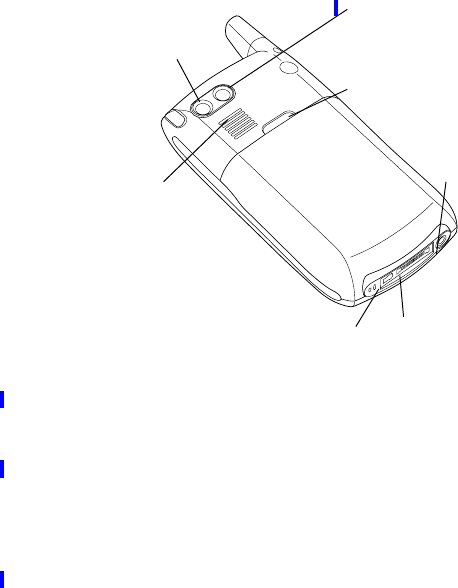
8 Section 1A: Device Setup
Your Device’s Features: Back View
13. Camera Lens enables you to take pictures using the built-in camera (if
included). There are two models of the Treo 700P smart device: One comes
with a camera and the other does not. The packaging for your device
identifies whether a camera is included.
14. Self-Portrait Mirror enables you to take a picture of yourself (if your device
includes a camera).
15. Battery Door Release opens the battery compartment.
13. Camera Lens
(camera
version
only)
15. Battery Door
Release
17. Multi-connector
19. Speaker
14. Self-Portrait
Mirror
16. Headset
Jack
18. Microphone
FINAL DRAFT Palm, Inc. Confidential

Section 1A: Device Setup 9
Device Setup
16. Headset Jack enables you to connect a hands-free headset. Use only
headsets that are compatible with your device.
17. Multi-connector enables you to attach the USB sync cable and AC charger to
your device. You can connect the charger either to the sync cable connector
or directly to the charger jack on the Multi-connector.
18. Microphone serves as the mouthpiece on your device’s phone.
19. Speaker plays ringtones and alarms, and serves as the speaker for the
speakerphone feature.
Note: The Treo 700P smart device speaker includes a large magnet, so be sure to keep
your device away from credit cards or other items that could become
demagnetized.
FINAL DRAFT Palm, Inc. Confidential
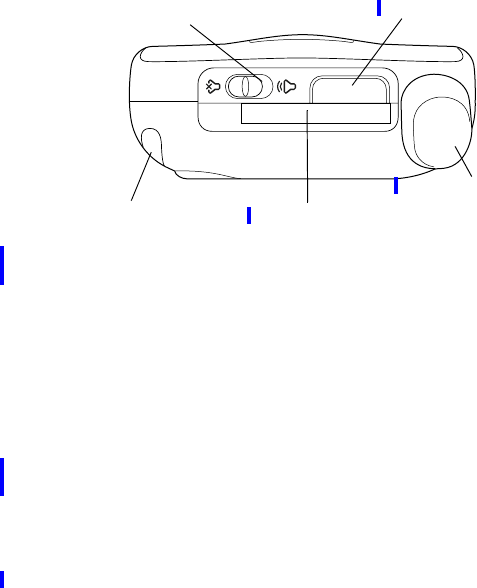
10 Section 1A: Device Setup
Your Device’s Features: Top View
20. Ringer Switch controls the ringer setting. See “Setting System Sounds” on
page 284 for details on changing the settings. Silencing the ringer turns off
all system sounds, including alarms.
21. Infrared (IR) Port uses infrared technology to transmit information to and
receive information from other infrared-enabled devices that use
compatible software.
22. Antenna receives and sends wireless communication signals. The antenna
does not telescope out of your device.
23. Expansion Card Slot allows you to expand the capabilities of your device
using a MultiMediaCard, SD, or SDIO card. See “Using Expansion Cards” on
page 276.
24. Stylus allows you to tap options on your device’s screen. To use the stylus,
slide it out of the slot and hold it as you would a pen or pencil.
22. Antenna
24. Stylus 23. Expansion Card Slot
21. Infrared (IR) Port
20. Ringer Switch
FINAL DRAFT Palm, Inc. Confidential
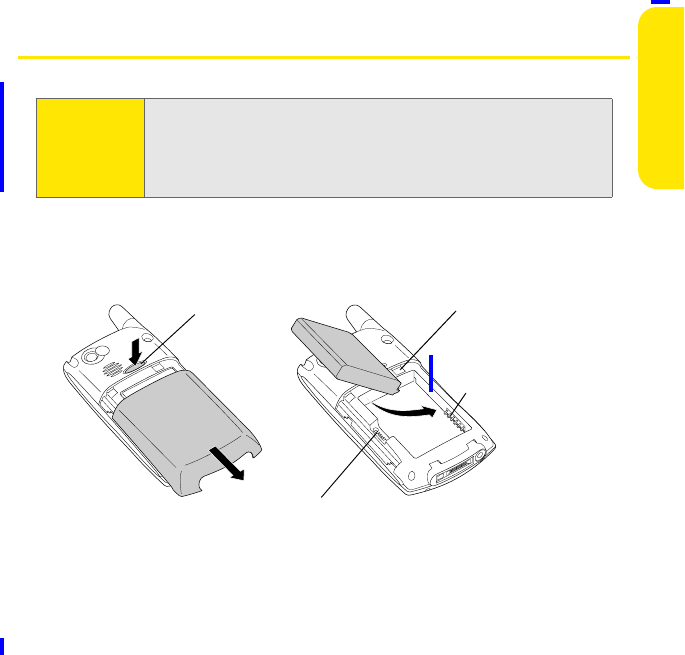
Section 1A: Device Setup 11
Device Setup
Inserting the Battery
1. Use one hand to press the Battery Door Release button, and use your other
hand to slide the battery door downward to remove it from your device.
2. Align the battery contacts with the battery compartment contacts.
WARNING: Use only Sprint-approved or manufacturer-approved batteries and
chargers with your device. The failure to use a Sprint-approved or
manufacturer-approved battery and charger may increase the risk that
your device will overheat, catch fire, or explode, resulting in serious bodily
injury, death, or property damage.
Notch
Battery
Contacts
Battery
Compartment
Contacts
Battery Door Release
Button
FINAL DRAFT Palm, Inc. Confidential

12 Section 1A: Device Setup
3. Insert the battery into the compartment at a 45-degree angle, and then
press it into place.
4. Slide the battery door onto the back of the device until it clicks into place.
5. Follow the onscreen instructions to set up your device.
Tip: Buy an extra battery as a spare for long trips or heavy data use. Visit
www.palm.com to purchase batteries that are approved by Sprint and
that are compatible with your device.
FINAL DRAFT Palm, Inc. Confidential
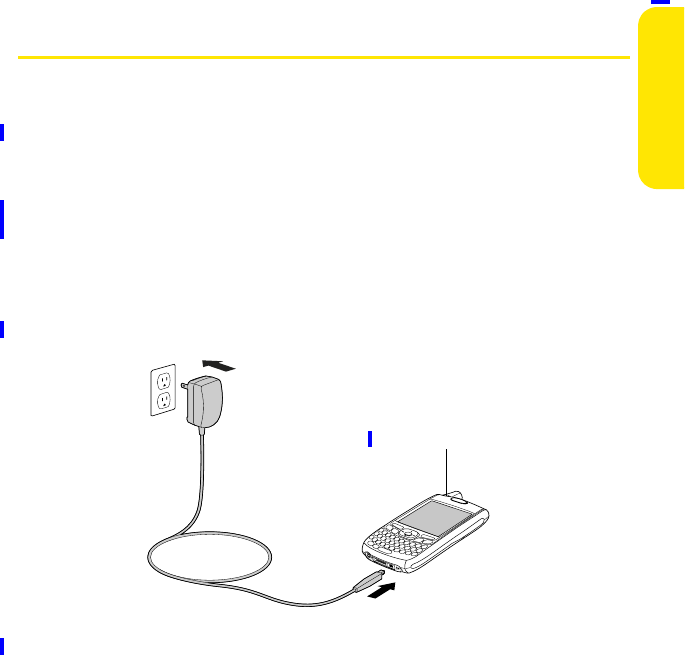
Section 1A: Device Setup 13
Device Setup
Charging the Battery
The battery comes with a sufficient charge to complete the setup process and
activate your phone. After activation, we recommend charging your device for
three and a half hours to give it a full charge. See “Maximizing Battery Life” on
page 16 for tips on maximizing the life of your device’s battery.
1. Plug the AC charger into a wall outlet.
2. Connect the charger cable to the charger jack on the bottom of the device.
Make sure the arrow on the connector is facing up, toward your Treo device
screen.
3. To confirm that your device is charging, check the indicator light.
ⅢRed indicates that your device is charging.
ⅢGreen indicates that your device is fully charged.
Indicator Light
FINAL DRAFT Palm, Inc. Confidential
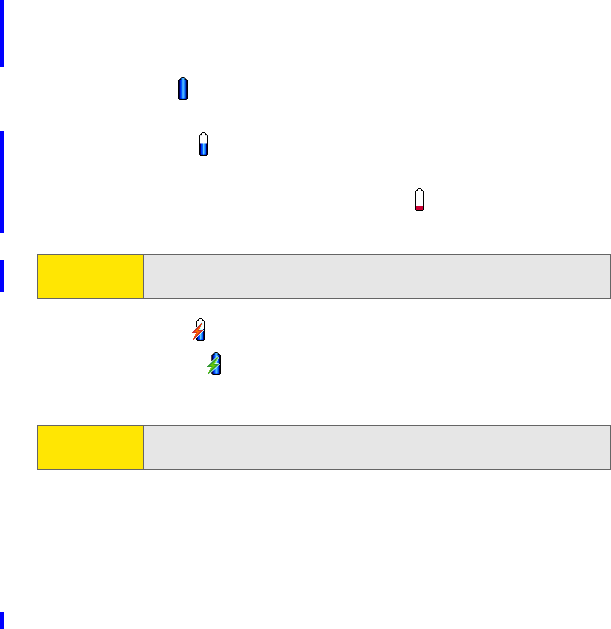
14 Section 1A: Device Setup
If the battery is fully drained, it may take a few moments for the indicator light to
turn on while the battery is charging.
The onscreen battery icon displays the power status:
ⅷFull battery icon : Battery is not connected to a wall outlet and is fully
charged.
ⅷPartial battery icon : Battery is not connected to a wall outlet and has some
power but is not fully charged.
ⅷAlmost-empty battery icon with red at the bottom : Battery needs to be
charged immediately.
ⅷRed lightning bolt : Battery is connected to a wall outlet and is charging.
ⅷGreen lightning bolt : Battery is connected to a wall outlet and is fully
charged.
Note: Your device’s indicator light blinks red when the battery needs to be
charged.
Tip: To see exactly how much power is left in your battery, tap the onscreen
battery icon.
FINAL DRAFT Palm, Inc. Confidential
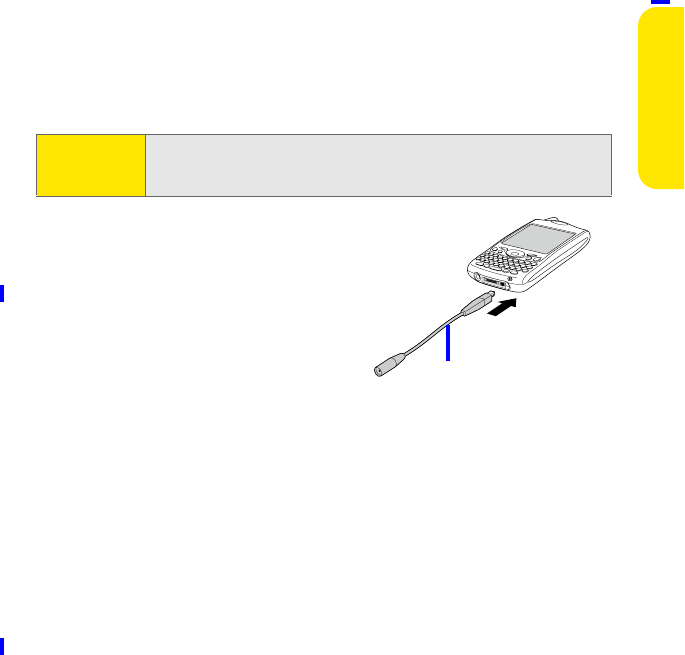
Section 1A: Device Setup 15
Device Setup
Using a Sprint Charger Adapter
If the connector on your Sprint-approved 1 Amp AC charger or vehicle charger
doesn’t fit into the connector on the bottom of your device, use the included
Sprint charger adapter.
1. Plug the AC charger into a power
source.
2. Connect the Sprint charger adapter to
the charger jack on bottom of the
Treo 700P smart device.
3. Connect the charger cable to the
Sprint charger adapter.
4. Charge your Treo 700P smart device as
described earlier.
Warning: Use only with 1 Amp AC chargers distributed by Sprint for your device.
Using any unapproved AC charger may destroy the AC charger and cause
a fire.
Sprint Charger
Adapter
FINAL DRAFT Palm, Inc. Confidential
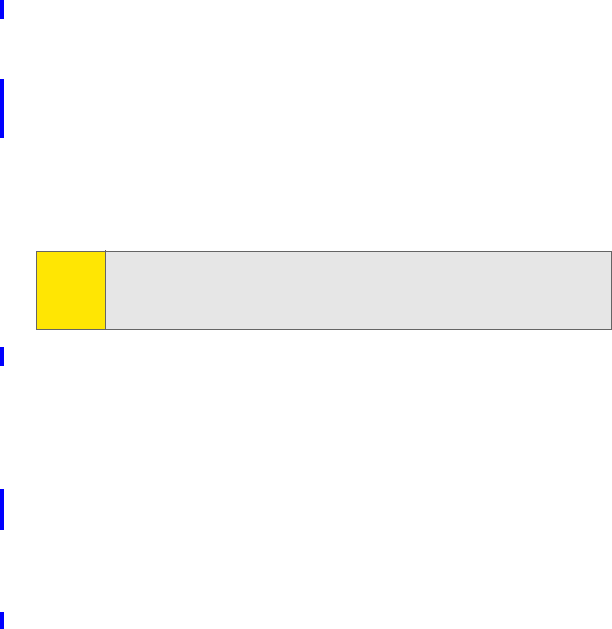
16 Section 1A: Device Setup
Battery Life
Battery life depends on individual use. Consumption factors include signal
strength, speakerphone use, and use of wireless features.
When used as a phone, the Treo device battery provides up to 4.5 hours of talk
time on the Nationwide Sprint PCS® Network or up to 15 days of standby time.
Talk time is slightly lower when you are roaming on the cellular 800 MHz band.
If the battery drains to the point where your device doesn’t turn on, the device
stores your information safely until you recharge the battery. To avoid draining
the battery, we recommend that you charge and synchronize your device every
day, especially if you use the wireless features of your device often.
Maximizing Battery Life
You can increase the life of your Treo 700P smart device battery by following a few
easy guidelines. Remember that battery life depends on how you use your device.
ⅷCharge your device whenever you’re at your desk, or charge it overnight each
day. The Lithium Ion (Li-Ion) battery has a much longer useful life when it is
topped off frequently, versus charging it after it is fully drained.
ⅷYour device’s wireless features (phone, email, messaging, Web, and any
applications that use a Sprint Power VisionSM connection, such as Sprint TV)
and media features (camera, media players, eBooks, and games) consume
more power than its organizer features. If you spend a lot of time using the
Note: Using your device’s phone has an effect on the battery life. You can extend the
battery life by turning off your device’s phone while using the organizer
features. In any case, regular charging is recommended for optimal
performance.
FINAL DRAFT Palm, Inc. Confidential

Section 1A: Device Setup 17
Device Setup
wireless and media features, keep an eye on the battery icon and charge
when necessary.
ⅷIf you don’t plan to use the wireless features on your device for awhile, turn
off your phone (see “Turning Your Device’s Phone On and Off” on page 55).
You can forward calls to a different number or let all calls be picked up by
voicemail (see “Call Forwarding” on page 73).
ⅷAs with any mobile phone, if you are in an area with no wireless coverage,
your device searches for a signal, which consumes power. If you cannot move
to an area of better coverage, you may want to temporarily turn off your
phone. While your phone is off, you can continue to use your device’s
nonwireless features.
ⅷTurn down the screen brightness (see “Adjusting the Brightness” on
page 286).
ⅷDecrease the settings in Power Preferences and turn off Beam Receive (see
“Optimizing Power Settings” on page 296).
ⅷTurn off the Bluetooth® feature if you are not using it (see “Connecting to a
Bluetooth Hands-Free Device” on page 84).
FINAL DRAFT Palm, Inc. Confidential

18 Section 1A: Device Setup
FINAL DRAFT Palm, Inc. Confidential

Section 1B: Setting Up Service 19
Setting Up Service
Section 1B
Setting Up Service
In This Section
ࡗMaking Your First Call
ࡗSetting Up Your Voicemail
ࡗCreating Sprint PCS® Account Passwords
Setting up service on your new Treo™ 700P smart device is quick and easy. This section
walks you through the necessary steps to unlock your device, set up your
voicemail, establish passwords, and contact Sprint for assistance with your
Sprint PCS® Service.
FINAL DRAFT Palm, Inc. Confidential
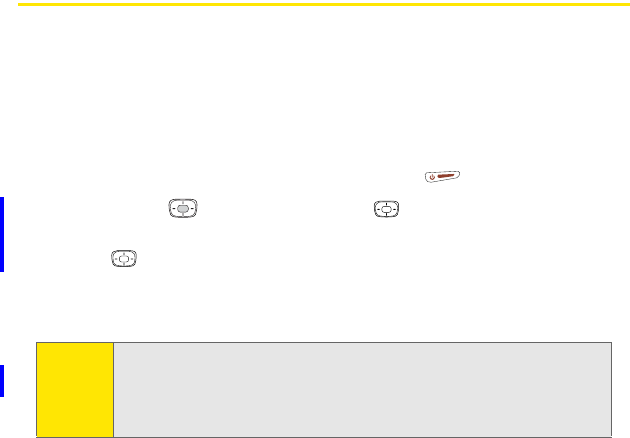
20 Section 1B: Setting Up Service
Making Your First Call
Determining If Your Device’s Phone Is Already Activated
If you received your device in the mail or purchased it at a Sprint Store, it probably
has already been activated. All you need to do is unlock it.
If your phone is not activated, please call Sprint at 1-888-211-4PCS (4727).
Unlocking Your Device
1. If the screen is off, press and release Power/End to wake up the screen.
2. Press Center on the 5-way navigator to turn off Keyguard (see
“Moving Around the Device Screen” on page 40 for information on the 5-
way ).
3. Enter your four-digit lock code. (For security purposes, the code is not visible
as you type.)
Note: If you can’t recall your lock code, try using the last four digits of either your
Social Security number or wireless phone number, or try 0000. If none of these
works, call Sprint Customer Service at 1-888-211-4PCS (4727). See “Where to
Learn More” on page 350 for other ways to get help from Sprint if you are
having trouble with your service.
FINAL DRAFT Palm, Inc. Confidential
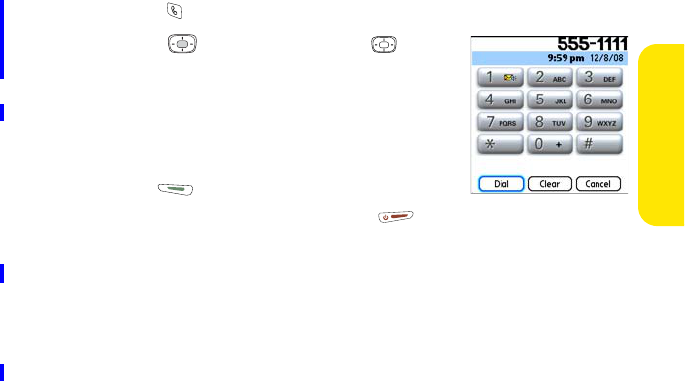
Section 1B: Setting Up Service 21
Setting Up Service
Making a Call
1. Press Phone .
2. Press Center on the 5-way navigator to turn
off Keyguard (see “Locking Your Keyboard
(Keyguard)” on page 297 for information on
Keyguard).
3. Tap the onscreen Dial Pad to enter the number you
want to call.
4. Press Send to dial.
5. After you finish the call, press Power/End to
end the call.
Adjusting Call Volume
While a call is in progress, press the Volume button on the side of your device to
adjust the call volume.
ⅷTo increase the volume, press the upper half of the Volume button.
ⅷTo decrease the volume, press the lower half of the Volume button.
FINAL DRAFT Palm, Inc. Confidential
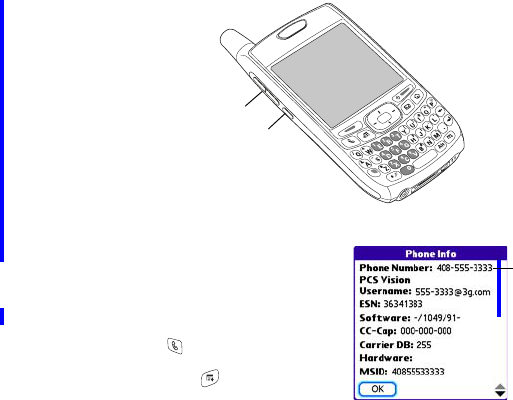
22 Section 1B: Setting Up Service
What’s My Phone Number?
1. Make sure your phone is on (see
“Turning Your Device’s Phone On
and Off” on page 55 for
information).
2. Press Phone .
3. Open the menus .
4. Select Options, and then select
Phone Info.
Volume Button
Side Button
Look Here for
Your Phone
Number
FINAL DRAFT Palm, Inc. Confidential
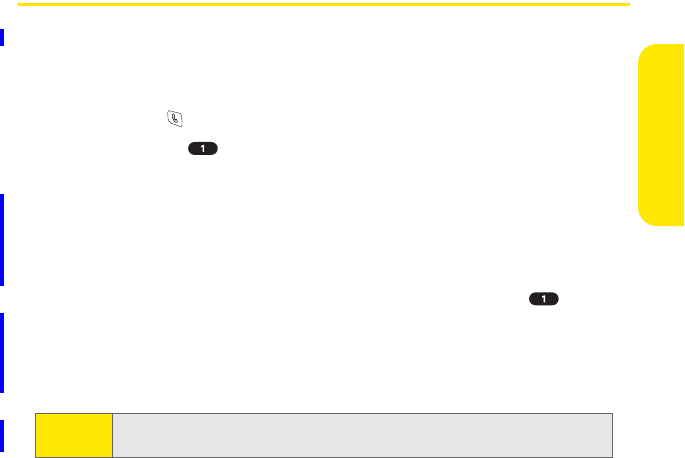
Section 1B: Setting Up Service 23
Setting Up Service
Setting Up Your Voicemail
All unanswered calls to your device’s phone are automatically transferred to your
voicemail, even if your phone is in use or turned off.
To set up your voicemail:
1. Press Phone .
ᮣPress and hold .
2. Follow the system prompts to:
ⅢCreate your password.
ⅢRecord your name announcement.
ⅢRecord your greeting.
ⅢChoose whether or not to activate Skip Pass Code (a feature that lets
you access your voicemail simply by pressing and holding ,
bypassing the need for you to enter your password). If you do not
activate Skip Pass Code, your device uses the Voicemail Pass Code
feature, which requires you to enter your password each time you want
to access your voicemail.
For more information about using your voicemail, see “Using Voicemail” on
page 64.
Note: If you are concerned about unauthorized access to your voicemail account, we
recommend that you use the Voicemail Pass Code.
FINAL DRAFT Palm, Inc. Confidential

24 Section 1B: Setting Up Service
Creating Sprint PCS® Account Passwords
As a Sprint PCS customer, you enjoy unlimited access to your personal account
information, your voicemail account, and your Sprint PCS Vision® or Sprint Power
VisionSM account. To ensure that no one else has access to your information, you
will need to create passwords to protect your privacy.
Account Password
If you are the account owner, you’ll have an account password to sign on to
www.sprint.com and to use when calling Sprint Customer Service. Your default
account password is the last four digits of your Social Security number. If you are not
the account owner (if someone else pays for your Sprint PCS Service), you can get
a sub-account password at www.sprint.com.
Voicemail Password
You'll create your voicemail password when you set up your voicemail. See
“Setting Up Your Voicemail” on page 23.
Sprint PCS Vision or Sprint Power Vision Password
With your Treo 700P smart device, you may elect to set up a Sprint PCS Vision or
Sprint Power Vision password. This optional password can be used to authorize
the purchase of Premium Services content and to protect personal information
on multi-phone accounts.
For more information or to change your passwords, sign on to www.sprint.com or
call Sprint Customer Service at 1-888-211-4PCS (4727).
FINAL DRAFT Palm, Inc. Confidential

Section 1C: Connecting to Your Computer 25
Computer Connection
Section 1C
Connecting to Your Computer
In This Section
ࡗWhy Connect My Device to My Computer?
ࡗUpgrading From Another Palm OS® Device
ࡗInstalling the Desktop Synchronization Software
ࡗConnecting Your Treo Device to Your Computer
ࡗSynchronizing Information—The Basics
FINAL DRAFT Palm, Inc. Confidential

26 Section 1C: Connecting to Your Computer
Why Connect My Device to My Computer?
You can enter or change information on your device or on your computer (using
Palm® Desktop software or Microsoft Outlook for Windows), and then
synchronize to automatically update the information in both places, so there’s no
need to enter it twice. We strongly recommend that you synchronize your device
and your computer frequently to keep your information up-to-date (and backed
up) in both locations.
Before you can synchronize, you need to install the desktop synchronization
software on your computer and connect the sync cable to your computer.
System Requirements
Windows computers
ⅷWindows 2000 or XP (or later)
ⅷ32MB of available memory (RAM)
ⅷ170MB of free hard disk space
ⅷCD drive
ⅷAvailable USB port
Mac computers
ⅷMac OS X version 10.2 or later
ⅷ128MB of total memory (RAM)
ⅷ190MB of free hard disk space
ⅷCD drive
ⅷAvailable USB port
FINAL DRAFT Palm, Inc. Confidential
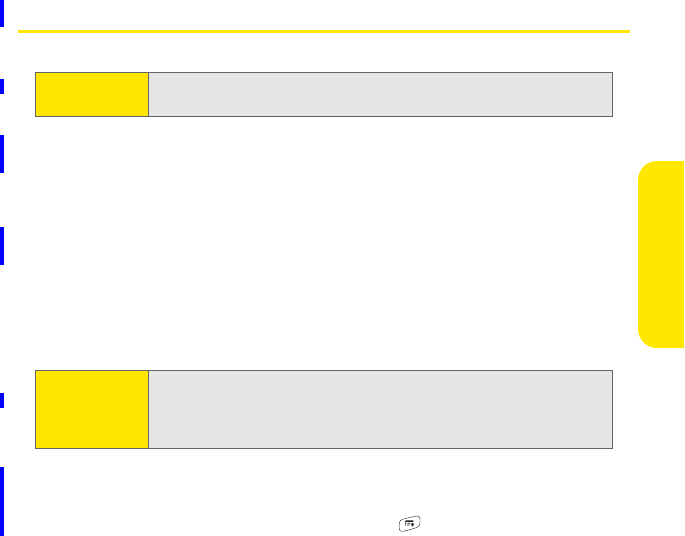
Section 1C: Connecting to Your Computer 27
Computer Connection
Upgrading From Another Palm OS® Device
You can transfer all compatible applications and information from your previous
Palm OS® device to your new Treo™ 700P smart device. This includes your
calendar events, contacts, memos, and tasks, as well as your application settings
and any compatible third-party applications and files.
When you install Palm Desktop software, some third-party applications may be
quarantined because they are not compatible with the Palm OS software version
5.4.9 on your new Treo device. Quarantined files are not installed on your device,
nor are they deleted; these files are placed in a new folder on your computer:
C:\Program Files\Palm\<device name>\PalmOS5 Incompatible Apps. (On some
systems, Palm may be replaced with palmOne.)
1. Calculate how much space your applications and information occupy on
your previous Palm OS device:
ⅢFrom Applications view, open the menus .
ⅢSelect Info on the App menu.
ⅢAt the bottom of the screen, select Size.
Note: If you are setting up your first Palm OS® device, skip ahead to
“Connecting Your Treo Device to Your Computer” on page 32.
Note: Some third-party utilities allow you to back up your old device’s
information onto an expansion card and then transfer the information
to your Treo device. We do not recommend this method because any
incompatible applications are also transferred.
FINAL DRAFT Palm, Inc. Confidential
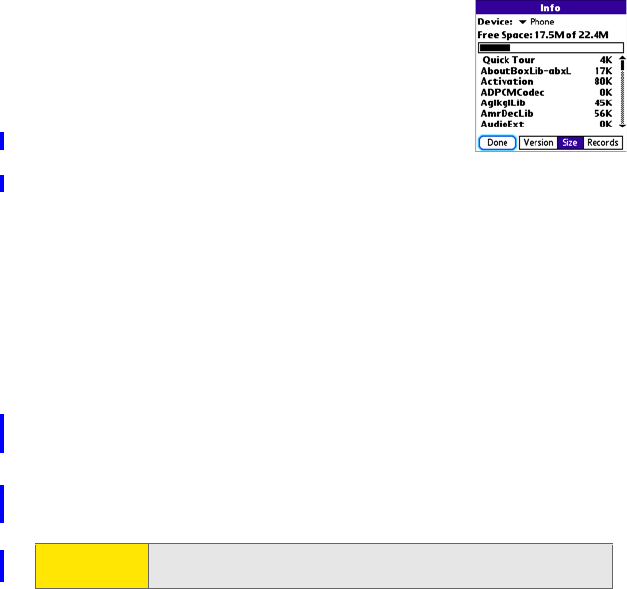
28 Section 1C: Connecting to Your Computer
ⅢLook at the numbers on the Free Space line and
subtract the number on the left from the
number on the right to calculate the space used.
For example, on the device shown here, 22.4 -
17.5 = 4.9. This means that 4.9MB of space is
occupied on this device.
2. If the space occupied on your old device is 60MB or
less, go to step 3. If the space occupied is greater
than 60MB, then do any of the following to free up some space before you
go to the next step:
ⅢDelete any third-party applications that you no longer use.
ⅢMove large files, such as eBooks and images, to an expansion card.
ⅢMove third-party applications to an expansion card.
ⅢPurge old information in applications such as Calendar (Date Book), Tas ks
(To Do), and email. Refer to the documentation that came with your old
device for instructions on these items.
3. Synchronize your old device with your old desktop software to back up your
information one last time.
4. Connect your new smart device to your computer (see “Connecting Your
Treo Device to Your Computer” on page 32).
5. Install the new desktop synchronization software from the Palm Software
Installation CD (see “Installing the Desktop Synchronization Software” on
page 30).
Important: Do not synchronize your new Treo 700P smart device with any previous
versions of Palm Desktop software.
FINAL DRAFT Palm, Inc. Confidential

Section 1C: Connecting to Your Computer 29
Computer Connection
6. During the installation process, synchronize your new Treo device with your
new desktop synchronization software as instructed. When prompted, do
the following:
ⅢConnect your new device to your computer (see “Connecting Your Treo
Device to Your Computer” on page 32).
ⅢIndicate whether you want to sync all applications or only PIM (personal
information management) applications.
ⅢSelect a device name for your new device; be sure to select the same
name that you used for your old device. (This is the name that appears
in the User list in Palm Desktop software.)
7. (Mac users only) If you have pictures on your old device, copy them from your
old device to an expansion card or beam them to your new Treo device.
8. If you plan to continue using your old device, perform a hard reset to
remove its associated device name. (See the documentation that came with
your old device for instructions on performing a hard reset.) Each device you
synchronize with your computer must have a unique name. The next time
you synchronize your old device with your computer, be sure to assign it a
new name.
If any third-party applications are quarantined during the installation, do not
manually install any of the quarantined files. Contact the third-party developer
for software updates and information about compatibility with your new device.
FINAL DRAFT Palm, Inc. Confidential
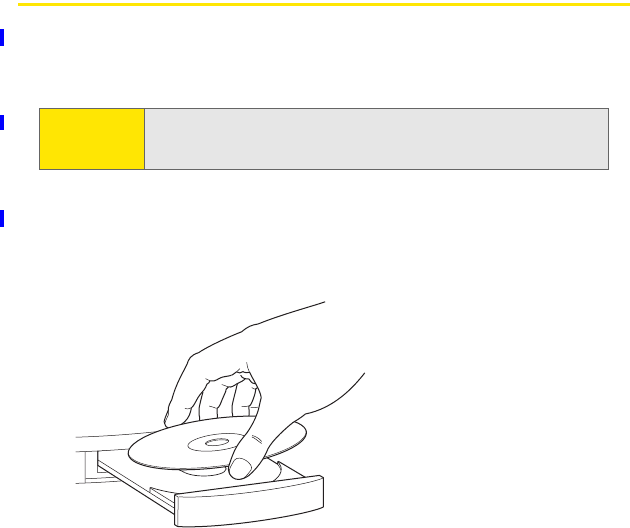
30 Section 1C: Connecting to Your Computer
Installing the Desktop Synchronization Software
Even if you already own a Palm OS device and have installed a previous version of
the desktop software, you must install the software from the Palm Software
Installation CD that comes with your Treo 700P smart device.
1. Close any applications that are currently running on your computer,
including those that are minimized. Your computer must have all its
resources available to install the software.
2. Insert the Palm Software Installation CD into the CD drive on your
computer.
Note: If you are installing the software on a computer at work, make sure your
company allows you to install new software. Contact your company’s IT
department for help.
FINAL DRAFT Palm, Inc. Confidential

Section 1C: Connecting to Your Computer 31
Computer Connection
3. If you are installing the software on a Mac, double-click the CD icon on the
desktop, and then double-click the PalmSoftware.pkg icon.
4. When the installation wizard opens, follow the onscreen instructions.
Please note these important points about the installation process:
ⅢYou can choose which desktop software you want to use for
synchronization: Palm Desktop software or Microsoft Outlook
(Windows only).
ⅢWhen the install process prompts you to connect your device to your
computer, go to “Connecting Your Treo Device to Your Computer” on
page 32.
Note: If you use Microsoft Outlook as your desktop email application, select
Microsoft Outlook as your desktop synchronization software. If you
select Microsoft Outlook, Palm Desktop software is still installed on your
computer. When you enter information on your computer, be sure to
enter your information in Microsoft Outlook, not in Palm Desktop
software.
Tip: If you want to sync information with applications other than
Palm Desktop or Microsoft Outlook, you need to purchase additional
third-party sync software. This sync software is sometimes called a
conduit.
FINAL DRAFT Palm, Inc. Confidential
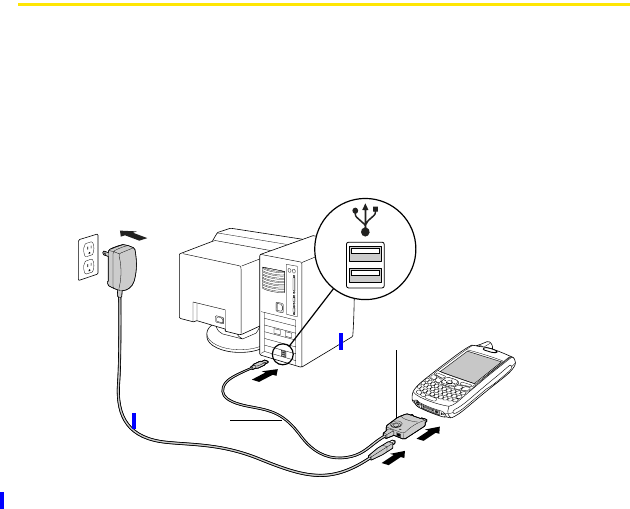
32 Section 1C: Connecting to Your Computer
Connecting Your Treo Device to Your Computer
1. Plug the AC charger into a wall outlet.
2. Plug the USB sync cable into an available USB port or a powered USB hub on
your computer.
3. With the sync button facing up, connect the sync cable to the bottom of
your device. Do not press the sync button until you are instructed to do so.
4. Connect the charger cable to the connector on the sync cable.
You are now ready to synchronize. Go to “Synchronizing Information—The Basics”
on page 33.
Sync Button
Sync Cable
FINAL DRAFT Palm, Inc. Confidential
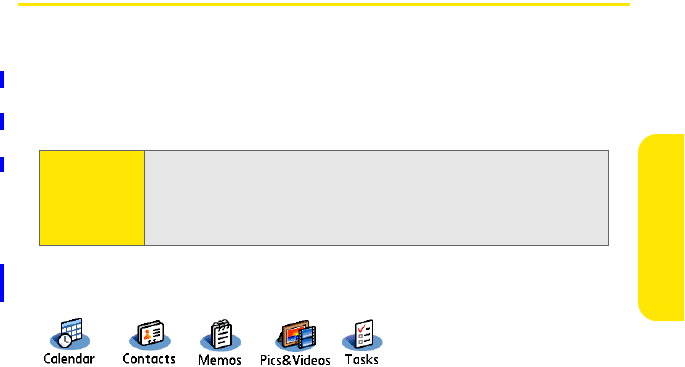
Section 1C: Connecting to Your Computer 33
Computer Connection
Synchronizing Information—The Basics
Synchronizing means that information that is entered or updated in one place
(your device or your computer) is automatically updated in the other, so there’s
no need to enter the information twice. We strongly recommend that you
synchronize your Treo device with your computer or corporate server frequently
to keep your information up-to-date (and backed up) in both locations.
Information from all the following applications is updated by default each time
you synchronize your device with your desktop software:
Important: To sync your information, you must install the software from the Palm
Software Installation CD that came with your Treo 700P smart device—
even if you sync with Outlook or another third-party application. See
“Installing the Desktop Synchronization Software” on page 30 for
instructions.
FINAL DRAFT Palm, Inc. Confidential

34 Section 1C: Connecting to Your Computer
How each application syncs depends on your computer type and the desktop
software you are using, as follows:
1. Connect your Treo 700P smart device to your computer as described in
“Connecting Your Treo Device to Your Computer” on page 32.
Computer Desktop What Syncs and Where
Windows Outlook ⅷCalendar, Contacts, Memos, and
Tasks sync with Outlook.
ⅷPics&Videos syncs with
Palm Desktop software.
Windows Palm Desktop software All applications sync with
Palm Desktop.
Mac Palm Desktop software All applications sync with
Palm Desktop.
Tip: For information on locating your pictures and videos on your computer,
see “Viewing Pictures and Videos on Your Computer” on page 202.
Note: If you’re performing initial setup, your device should already be
connected to your computer.
FINAL DRAFT Palm, Inc. Confidential
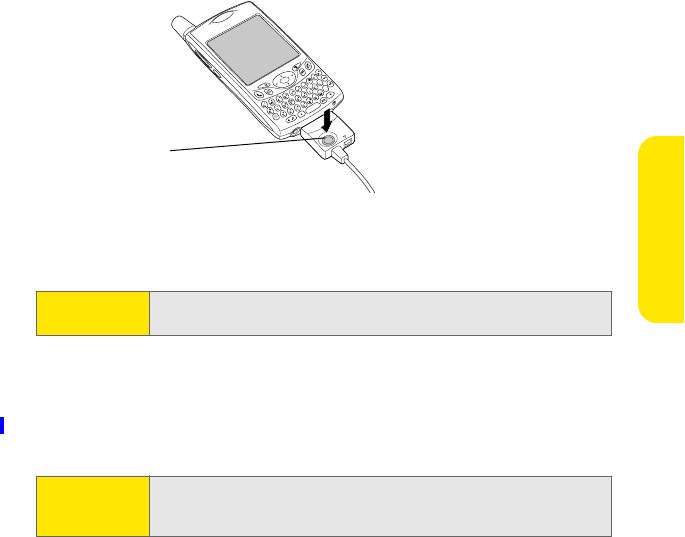
Section 1C: Connecting to Your Computer 35
Computer Connection
2. Press the sync button on the sync cable.
A message indicates that synchronization is in progress.
3. Wait for a message that indicates that the process is complete before you
disconnect the sync cable.
If you’re finishing your initial setup, you now have the option to install bonus
software from the Palm Software Installation CD. If you choose to install some of
the bonus software, you need to sync again to install the software on your device.
To install bonus software later, see “Installing Bonus Software From the CD” on
page 255.
Tip: If you have any problems synchronizing, see “Synchronization” on
page 321 for troubleshooting suggestions.
Note: For more synchronization options, including customizing which
applications sync, see “Synchronizing Information—Advanced” on
page 268.
Sync
Button
FINAL DRAFT Palm, Inc. Confidential
36 Section 1C: Connecting to Your Computer
FINAL DRAFT Palm, Inc. Confidential
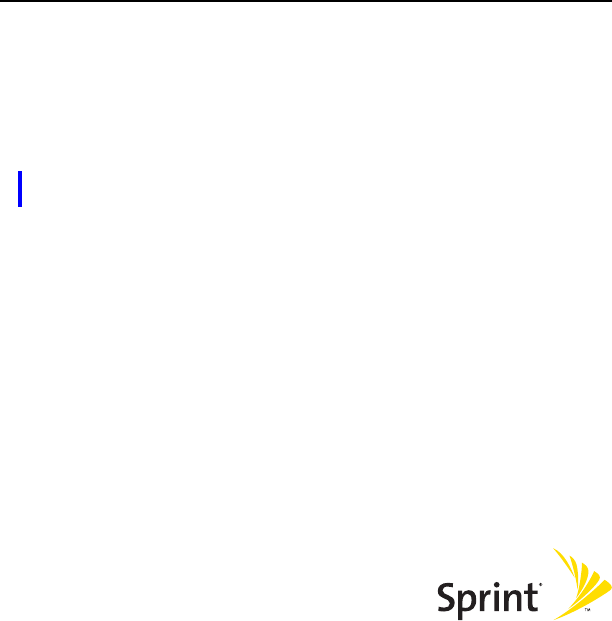
Section 2
Your Treo™ 700P Smart Device
FINAL DRAFT Palm, Inc. Confidential
38
FINAL DRAFT Palm, Inc. Confidential

Section 2A: Moving Around on Your Smart Device 39
Moving Around
Section 2A
Moving Around on Your Smart Device
In This Section
ࡗMoving Around the Device Screen
ࡗUsing the Keyboard
ࡗOpening Applications
FINAL DRAFT Palm, Inc. Confidential
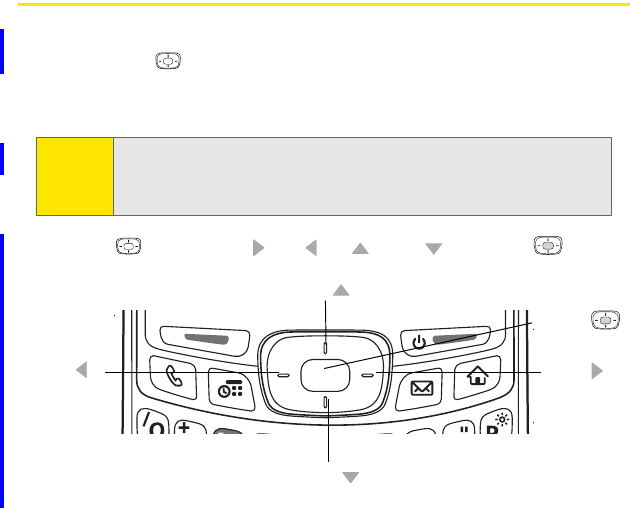
40 Section 2A: Moving Around on Your Smart Device
Moving Around the Device Screen
To move around the Treo™ 700P smart device screen, you can use the
5-way navigator for one-handed navigation, or you can tap items on the
screen with the stylus. With use, you will find your own favorite way to scroll,
highlight, and select menu items.
The 5-way includes Right , Left , Up , Down , and Center buttons.
Note: Some third-party applications may not work with the 5-way navigator, and
you must use the stylus instead. In this guide, arrow icons are used to indicate
directions on the 5-way navigator. These arrows are different from any
onscreen scroll arrows or pick list arrows.
Up
Left
Center
Right
Down
FINAL DRAFT Palm, Inc. Confidential
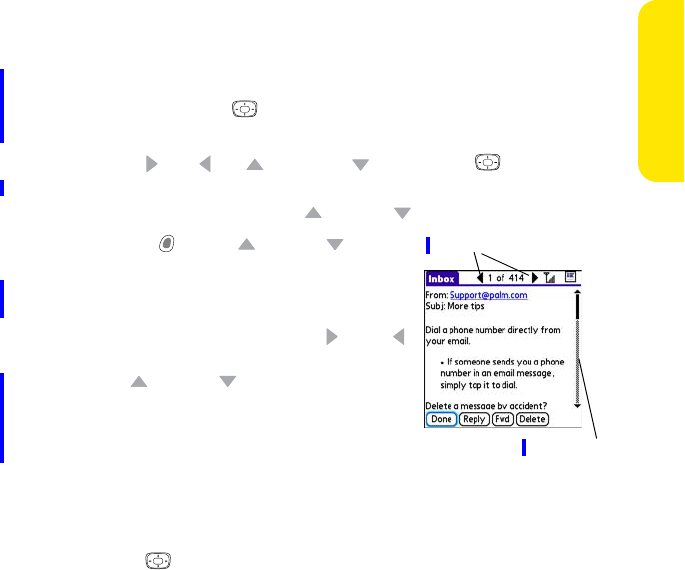
Section 2A: Moving Around on Your Smart Device 41
Moving Around
Scrolling Through Screens
As on a computer, you scroll on the Treo device to move from field to field or page
to page, or in some cases to highlight an item or option in a list.
The behavior of the 5-way for list screens and entry screens varies by
application. Here are some general scrolling tips that apply to most applications:
ⅷPress Right , Left , Up , and Down on the 5-way to move to the
next field, button, or action in that direction.
ⅷIn list screens, press and hold Up or Down to scroll one screen at a time.
ⅷPress Option and Up or Down to scroll
to the next page of information within the
current record (see “Using the Keyboard” on
page 45).
ⅷWhen inside a text field, press Right or Left
to scroll to the next character or word, and
press Up or Down to scroll between lines.
You can also scroll using the stylus. Tap an onscreen
scroll arrow, or drag the slider of an onscreen scroll
bar.
Highlighting and Selecting Items
On most screens, one item—a button, a list entry, or a check box—is highlighted
by default. The highlight identifies which item is affected by your next action.
Use the 5-way to move the highlight from one item to another before
opening or selecting it.
Scroll Arrows
Scroll Bar
FINAL DRAFT Palm, Inc. Confidential
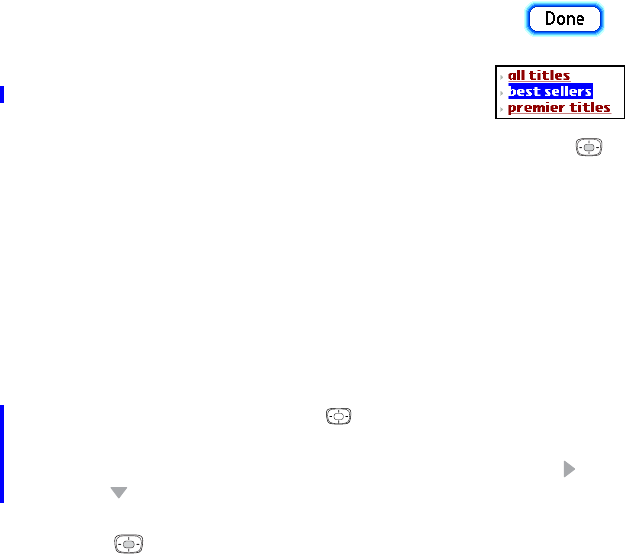
42 Section 2A: Moving Around on Your Smart Device
The highlight can take one of two forms, depending on what is highlighted:
ⅷBorder glow: When an onscreen button (OK, Cancel, etc.) or
pick list is highlighted, the button acquires a glow around
its border.
ⅷColored background: When a phone number, text, an
email address, or a Web link is highlighted, the item
appears as white text against a colored background.
After highlighting an item, you can select or activate it by pressing Center or
by tapping the item with the stylus.
Highlighting Text
You can use the stylus to highlight text on the screen.
ⅷTap and drag the stylus across the text you want to highlight.
ⅷTo highlight a word, double-tap it.
ⅷTo highlight a paragraph, triple-tap it.
Accessing Command Buttons
In most applications, command buttons such as New, OK, and Details appear at
the bottom of the screen. In many cases, you can jump directly to these buttons
instead of scrolling to them. The 5-way controls vary according to the
application, but here are some general rules that apply to most applications:
ⅷFrom a list screen, such as the Contacts list or Memos list, press Right or
Down to jump to the first button.
ⅷFrom a screen where you create or edit entries, such as Edit Contacts, press
Center to jump to the first button.
FINAL DRAFT Palm, Inc. Confidential
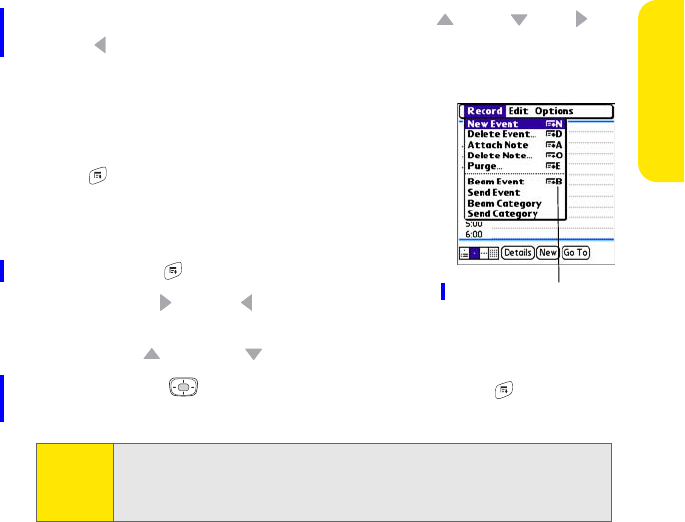
Section 2A: Moving Around on Your Smart Device 43
Moving Around
ⅷFrom a dialog box, such as Edit Categories, press Up , Down ,Right or
Left to scroll to the buttons.
Selecting Menu Items
Many applications have menus to provide access to
additional features. These menus are usually hidden
from view, but they appear when you open the
menus . To get the most out of your Treo device,
it’s a good idea to familiarize yourself with the
additional features available through the various
application menus.
1. Press Menu to open an application’s menus.
2. Press Right and Left to switch between
menus.
3. Press Up and Down to highlight a menu item.
4. Press Center to select the menu item, or press Menu to close the
menus and cancel your selection.
Tip: Most menu items have menu shortcuts listed in the menu. To use a menu
shortcut, press Menu plus the shortcut letter. You don’t have to see the menu
item to use the menu shortcut. For example, when you’re in Calendar, you can
press Menu + N to create a new event.
Menu Shortcut
FINAL DRAFT Palm, Inc. Confidential
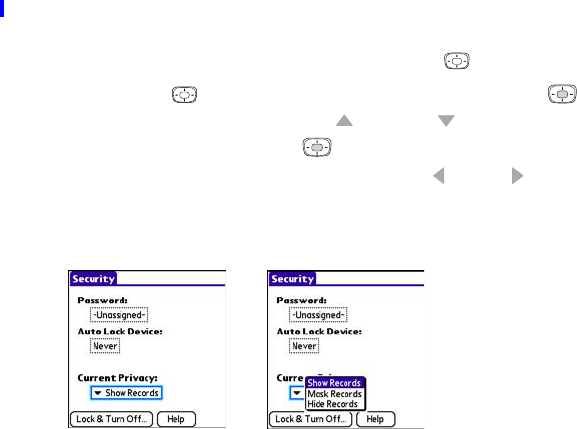
44 Section 2A: Moving Around on Your Smart Device
Selecting Options in a Pick List
A range of options is often presented in a type of menu called a pick list, which
can be identified by a downward-pointing arrow. Pick lists are different from the
application menus previously described. The application menus give you access
to additional features, and pick lists enable you to select the contents for a
particular field.
You can select an option from a pick list with the 5-way or the stylus:
ⅷUse the 5-way to highlight the pick list, and then press Center to
display the items in the list. Press Up and Down to highlight the item
you want, and then press Center to select the highlighted item. To exit
the pick list without making a selection, press Left or Right .
ⅷUse your stylus to tap the pick list, and then tap the item you want from
the list. To exit the pick list without making a selection, tap outside the list.
FINAL DRAFT Palm, Inc. Confidential
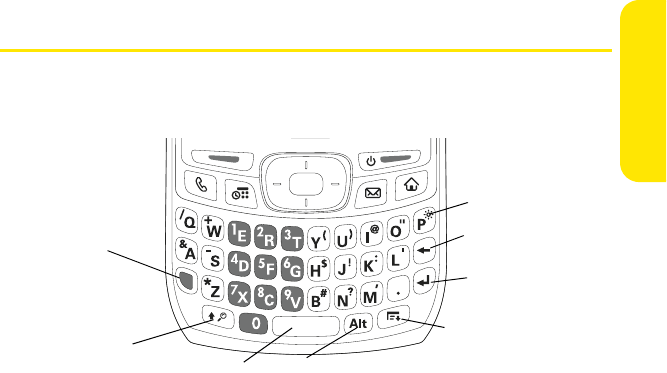
Section 2A: Moving Around on Your Smart Device 45
Moving Around
Using the Keyboard
When using the keyboard, most people find it easiest to hold the Treo device with
two hands and use the tips of both thumbs to press the keys.
The Backspace, Return, Space, and Shift keys, as well as the letter keys, work in the
same way as do those found on any computer keyboard. In addition, your device
offers several special function keys.
Option
Shift/Find
Alt
Space
Backspace
Return
Backlight
Menu
FINAL DRAFT Palm, Inc. Confidential

46 Section 2A: Moving Around on Your Smart Device
Key Function
Option When pressed in conjunction with a second key, gives that key an
alternate function. For example:
ⅷOption + <any lettered key> enters the symbol or number
displayed at the top of the key.
ⅷOption + <any quick button> opens a secondary application (see
“Using the Quick Buttons” on page 50).
ⅷOption + Shift/Find opens the Find feature (see “Using Find” on
page 254).
ⅷOption + Menu dims the device screen.
Alt When pressed in conjunction with a second key, displays a variety of
alternate characters that can be entered using that key. See “Entering
Other Symbols and Accented Characters” on page 48 for details.
Menu Opens application menus. See “Selecting Menu Items” on page 43 for
details.
Tip: The Treo device includes a keyboard backlight that turns on and off when the
screen turns on or off. Press Option + P to adjust screen and keyboard backlight
brightness. The backlight also dims when an active call lasts longer than a
specified period of time. See “Optimizing Power Settings” on page 296 to
adjust the automatic shut-off and dimming intervals.
FINAL DRAFT Palm, Inc. Confidential

Section 2A: Moving Around on Your Smart Device 47
Moving Around
Entering Lowercase and Uppercase Letters
ⅷTo enter lowercase letters, press the desired keys.
ⅷTo enter an uppercase letter, press Shift/Find , and then press a letter key.
You don’t need to press and hold Shift/Find while entering uppercase
letters. When Shift is active, an up arrow appears in the lower-right corner
of the screen.
ⅷTo turn Caps Lock on, press Shift/Find twice. To turn it off, press Shift/Find
once. When Caps Lock is on, an underlined up arrow appears in the
lower-right corner of the screen.
Entering Numbers, Punctuation, and Symbols
Numbers, punctuation, and symbols appear above the
letters on the keys. To enter these characters, do one of
the following:
ⅷPress Option , and then press the key with the
desired character shown above the letter. You don’t need to press and hold
Option while pressing the second key. When Option is active, the symbol
appears in the lower-right corner of the screen.
ⅷTo turn Option Lock on, press Option twice. To turn it off, press Option
once. When Option Lock is on, the symbol appears in the lower-right
corner of the screen.
Tip: Some application views automatically default to Option Lock, such as the Dial
Pad view of the Phone application, or the Calculator. In this case, you do not
need to press Option to enter numbers.
Letter
Symbol
FINAL DRAFT Palm, Inc. Confidential
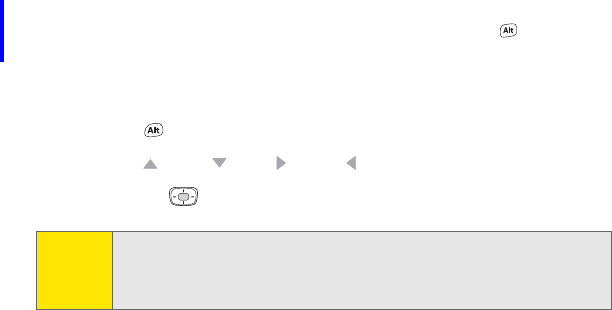
48 Section 2A: Moving Around on Your Smart Device
Entering Other Symbols and Accented Characters
Symbols and accented characters that do not appear on the keyboard are
sometimes called alternate characters because you use the Alt key to enter
them.
1. Enter the character that corresponds to the symbol or accented character
you want. (See the table on the next page.)
2. Press Alt .
3. Press Up , Down , Right , or Left to highlight the desired character.
4. Press Center to insert the character.
Tip: To see a list of additional alternate characters, position the cursor at the
beginning of the line or after a space, and then press Alt. The alternate
characters are grouped by their similarity to the base key. For example, the
alternate characters available for the e key are é, è, ë, and ê.
FINAL DRAFT Palm, Inc. Confidential
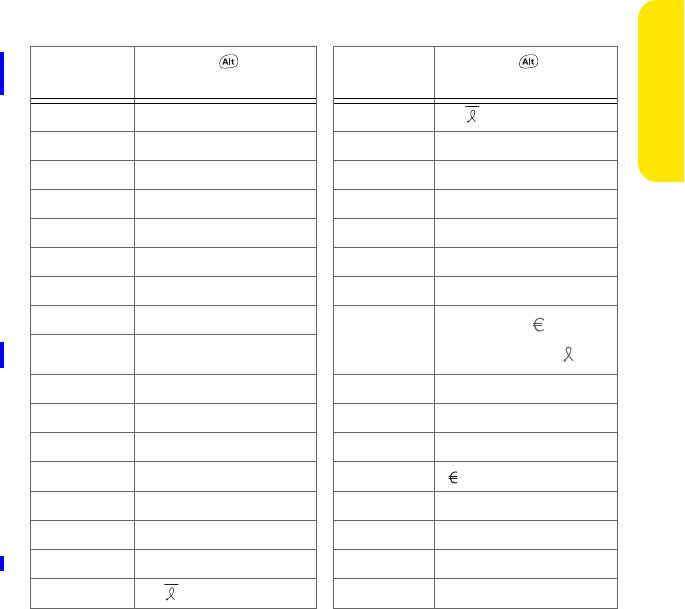
Section 2A: Moving Around on Your Smart Device 49
Moving Around
Symbols and Accented Characters
Enter … Then press to
select …
Enter … Then press to
select …
aá à ä â ã å æ Sß Š §
AÁ À Ä Â Ã Å Æ t or T ™
b or B ßuú ù ü û
cç ¢ © UÙ Ú Ü Û
CÇ ¢ © x or X פ
eè é ë ê yý ÿ
EÈ É Ë Ê YÝ Ÿ
iì í ï î 0 1 2 3 4 5 6
7 8 9 . , ‘ “ @
+ - * / # ( or )
; _ • \ % = °÷ £ ¥ ¢ [ ] {
} < > « » © ® ™ ^ Ø |
IÌ Í Ï Î
l or L £!¡
nñ?¿
NÑ:; :-) :-( ;-)
o
ò ó ö ô
œ õ $ £ ¥ ¢
O Ò Ó Ö Ô Œ Õ
p or P ¶
r or R ®
sß š
FINAL DRAFT Palm, Inc. Confidential
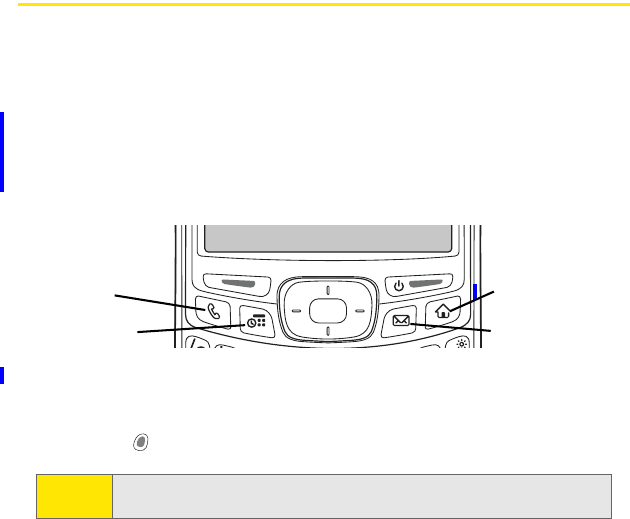
50 Section 2A: Moving Around on Your Smart Device
Opening Applications
When you open an application using either a quick button or Applications view,
you automatically close the application you were previously using.
Using the Quick Buttons
The front of the Treo 700P smart device has three buttons that you can use to
open applications. The fourth button opens Applications view, which allows you
to open all the applications on your device (see “Using Applications View” on
page 52).
Each of the three application quick buttons can be used to open two applications.
To access a button’s primary application—as indicated by the graphic on the
button—simply press the button. To access a button’s secondary application,
press Option , and then press the quick button.
Note: Pressing any of the quick buttons or the Applications button automatically
wakes up your device screen. See “Waking Up the Screen” on page 54.
Phone
Calendar Messaging
Applications
FINAL DRAFT Palm, Inc. Confidential
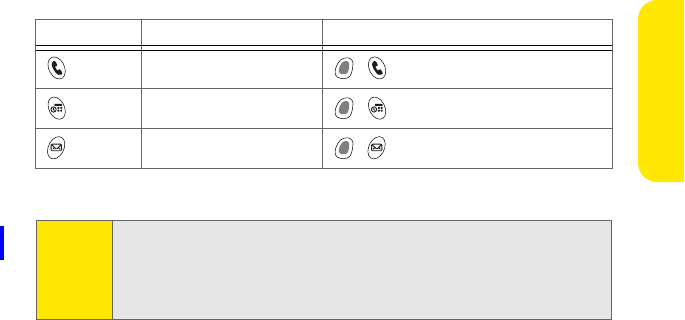
Section 2A: Moving Around on Your Smart Device 51
Moving Around
Pressing Option + Applications dims your device screen.
Button Primary Application Secondary Application
Phone + Web
Calendar + Memos
Messaging + Email
Note: The Messaging button opens Sprint PCS Business ConnectionSM if you have
downloaded and installed this application on your device. See “Sprint PCS
Business ConnectionSM Personal Edition” on page 142 for information on using
this application. You can also customize the buttons yourself. See
“Customizing Device Buttons” on page 292 for details.
FINAL DRAFT Palm, Inc. Confidential

52 Section 2A: Moving Around on Your Smart Device
Using Applications View
You can access all available applications through Applications view.
1. Press Applications .
2. Use the 5-way navigator to highlight the
application you want to open.
3. Press Center to open the selected application.
In Applications view, you can also do any of the following:
ⅷPress Applications repeatedly to cycle through
various categories of applications. See “Changing the Applications Settings”
on page 290 for more information on categories.
ⅷEnter the first few letters of the application’s name to highlight it. For
example, if you enter “p,” it highlights Phone; if you then enter “r,”
it highlights Prefs. If you pause and then enter “r,” it highlights the first
application that starts with “r.”
FINAL DRAFT Palm, Inc. Confidential

Section 2B: Using Your Device’s Phone Features 53
Phone Features
Section 2B
Using Your Device’s Phone Features
In This Section
ࡗTurning Your Device On and Off
ࡗOpening the Phone Application
ࡗMaking Calls
ࡗReceiving Calls
ࡗUsing Voicemail
ࡗManaging Active Calls
ࡗUsing Sprint PCS® Voice Command
ࡗDefining Favorite Buttons
ࡗUsing a Phone Headset
ࡗCustomizing Phone Settings
ࡗControlling Your Roaming Experience
ࡗChecking Signal Strength and Phone Status
FINAL DRAFT Palm, Inc. Confidential
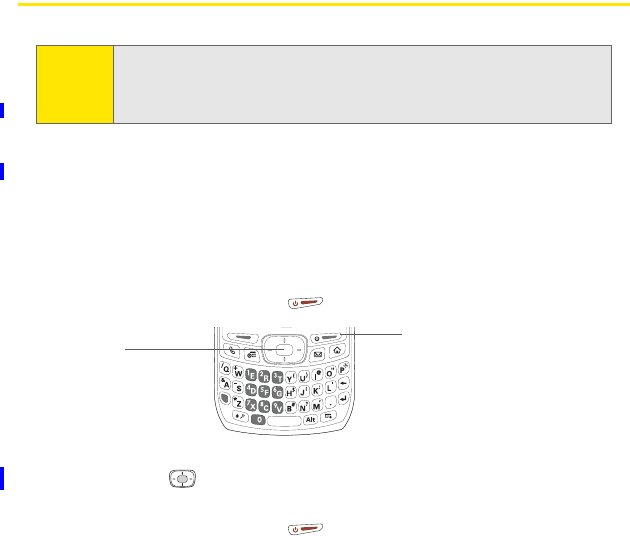
54 Section 2B: Using Your Device’s Phone Features
Turning Your Device On and Off
You can turn on your device screen and your phone independently. For example,
the device screen can be off while the phone is on, or the device screen can be on
while the phone is off. You can also have both the device screen and the phone
turned on or off at the same time.
Waking Up the Screen
When your device screen is off, you need to wake up the screen.
1. Press and release Power/End to wake up the screen.
2. Press Center to turn off Keyguard. For more information about turning
Keyguard on and off, see “Locking Your Keyboard (Keyguard)” on page 297.
3. Press and release Power/End to turn off the screen.
Note: Throughout this guide the term device is used to describe your Treo smart
device and its physical aspects. The term phone is used to describe the feature
of your smart device that enables you to connect to the Nationwide Sprint
PCS® Network.
Center Power/End
FINAL DRAFT Palm, Inc. Confidential
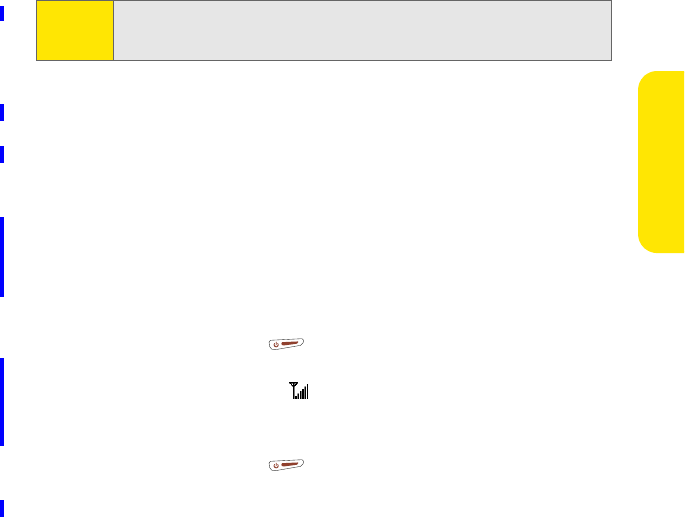
Section 2B: Using Your Device’s Phone Features 55
Phone Features
Turning Your Device’s Phone On and Off
When your phone is on, it is connected to the Nationwide Sprint PCS Network
(provided you are in a coverage area) so that you can make and receive phone
calls and use wireless services, such as email, messaging, and the Web browser.
During initial setup, your phone is on by default, so you can use wireless services
right away.
If you turn off your phone, you can still use the organizer features such as
Contacts and Calendar, as well as the media features such as the Pocket Tunes™
music application and Pics&Videos. This is sometimes referred to as flight mode
and is ideal for using your device on airplanes and for maximizing battery life.
1. Wake up the screen.
2. Press and hold Power/End . (You will hear a series of ascending tones
and see a “Welcome” screen. When your device locates a signal, “Sprint”
and the signal-strength icon appear at the top of the Phone application
screen, indicating that you can use the phone and Internet features, if they
are supported by the local network.)
3. Press and hold Power/End again to turn off your phone. (You will hear
a series of descending tones and see a “Powering off” screen. When your
phone is off, “Phone Off” appears at the top of the Phone application
screen. You can still use the nonwireless features of your device, such as
Contacts, Calendar, Tasks, and Memos.)
Note: You can also press any of the application quick buttons on the front of your
device to wake up the screen and to go directly to the application associated
with that button.
FINAL DRAFT Palm, Inc. Confidential
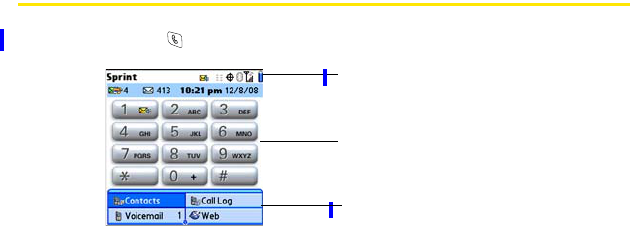
56 Section 2B: Using Your Device’s Phone Features
Opening the Phone Application
ᮣPress Phone to open the Main view of the Phone application.
Favorite Buttons
Dial Pad
Status Icons
FINAL DRAFT Palm, Inc. Confidential
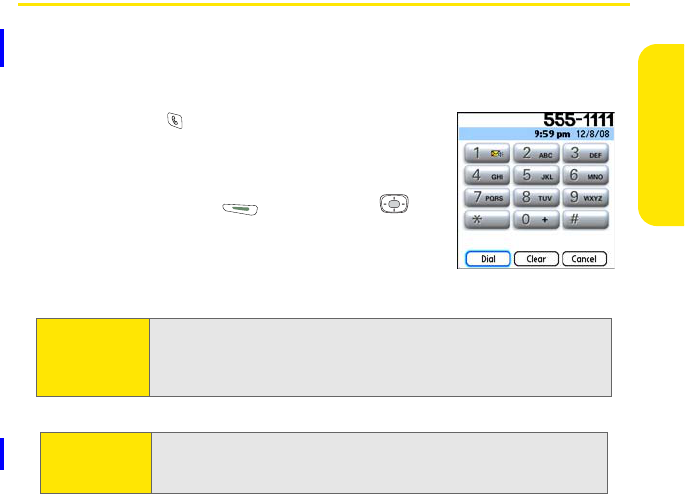
Section 2B: Using Your Device’s Phone Features 57
Phone Features
Making Calls
Your Treo™ 700P smart device offers several options for making phone calls. As
you become familiar with your device, you’ll discover which method you prefer.
Dialing Using the Onscreen Dial Pad
1. Press Phone .
2. Enter the phone numbers by tapping the
onscreen Dial Pad with the stylus.
3. Tap Dial, press Send , or press Center
to dial.
Note: If you changed the wallpaper in the Main view of the Phone application
(see “Customizing the Main View in the Phone Application” on page 92),
you can still access the Dial Pad. From the Main view of the Phone
application, press Send, and then select Dial Pad.
Tip: You can paste numbers directly into Main view. Copy a number from
another application, and then press Phone to switch to Main view.
Open the Edit menu, and then select Paste. Press Send to dial.
FINAL DRAFT Palm, Inc. Confidential
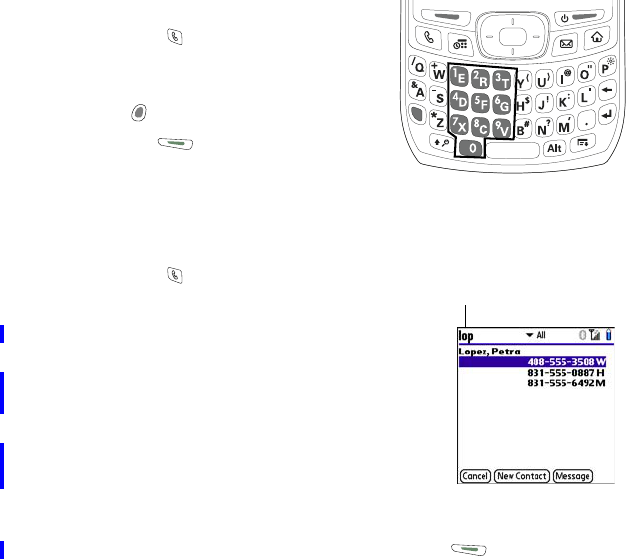
58 Section 2B: Using Your Device’s Phone Features
Dialing With the Keyboard
1. Press Phone .
2. Press the numbered keys to enter the
phone number. (You don’t need to press
Option .)
3. Press Send to dial.
Dialing by Contact Name
Before you can dial a call by contact name, you must create some contacts (see
“Adding a Contact” on page 220), or import them by synchronizing (see
“Synchronizing Information—The Basics” on page 33).
1. Press Phone .
2. Select the Contacts favorite button.
3. Using the keyboard, start entering one of the
following for the contact you want to call:
ⅢFirst name (JOH for John).
ⅢLast name (SMI for Smith).
ⅢFirst initial and last name (JSM for John
Smith).
For example, entering SM might display Smila
Anderson, John Smith, and Sally Martin. Entering
JSM finds only John Smith.
4. Select the number you want to call, and press Send to dial.
Characters you enter
appear here
FINAL DRAFT Palm, Inc. Confidential
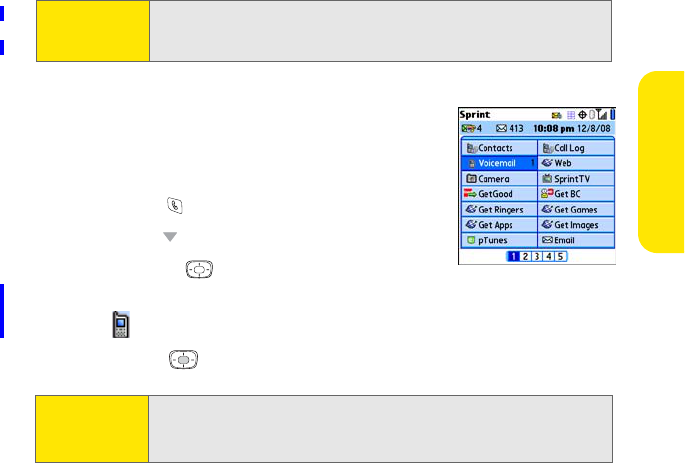
Section 2B: Using Your Device’s Phone Features 59
Phone Features
Dialing With a Speed-Dial Favorite Button
Your device comes with a few predefined speed-dial
favorite buttons, but you can also create your own
favorites. See “Creating a Speed-Dial Favorite Button”
on page 79.
1. Press Phone .
2. Press Down to access your favorite buttons.
3. Use the 5-way to highlight the desired
speed-dial favorite button. Speed-dial favorite buttons are indicated by the
icon .
4. Press Center to dial the number associated with the selected button.
Tip: To see more information for a contact, highlight the name and press
Center on the 5-way. To restart your search, press Backspace to delete
letters you’ve entered, or select Cancel to return to Main view.
Tip: To view more favorite buttons, press Right or Down on the 5-way. If the
highlighted favorite was added from Contacts, press Space to view all
numbers associated with that contact.
FINAL DRAFT Palm, Inc. Confidential

60 Section 2B: Using Your Device’s Phone Features
Dialing From a Web Page or Message
Your Treo device recognizes most phone numbers that
appear on Web pages or in text, email, or Sprint PCS®
Picture Mail messages. If you can’t use the 5-way or stylus
to highlight and dial a phone number on a Web page or in
a message, it means that your device doesn’t recognize
the number as a phone number.
1. Select the phone number on the Web page or in the
message.
2. Press Center to open the Dial Number dialog box.
3. Select Dial to dial the number.
FINAL DRAFT Palm, Inc. Confidential
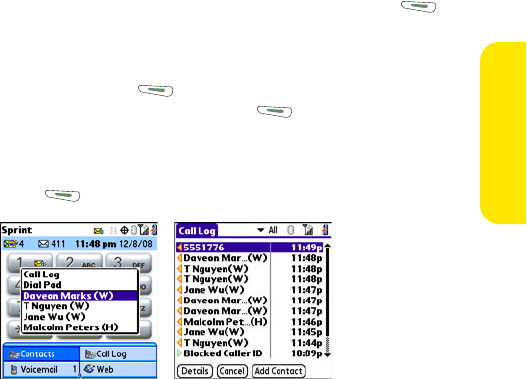
Section 2B: Using Your Device’s Phone Features 61
Phone Features
Redialing a Recently Called Number
ᮣFrom the Main view in the Phone application, press and hold Send to
dial the last number you called.
–or–
To select from your most recently dialed numbers, from the Main view in the
Phone application, press Send to open the Redial list, select the
number you want to call, and then press Send again to dial.
–or–
To select from a chronological list of calls, select the Call Log favorite button.
You can also access the Call Log from the Main view in the Phone application
by pressing Send and selecting Call Log from the Redial list.
FINAL DRAFT Palm, Inc. Confidential
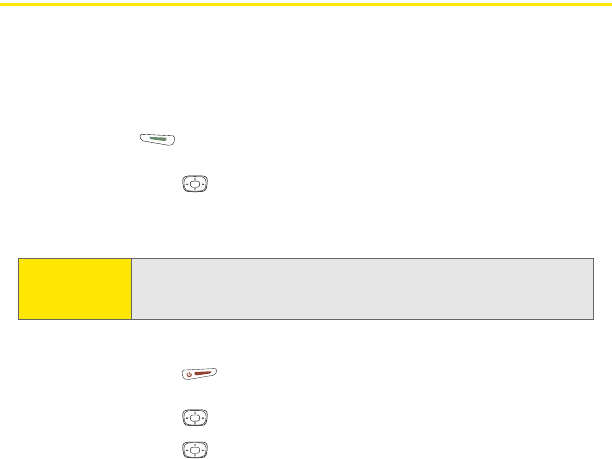
62 Section 2B: Using Your Device’s Phone Features
Receiving Calls
To receive calls, your device’s phone must be on. This is different from having only
the screen turned on (see “Turning Your Device’s Phone On and Off” on page 55).
When your phone is off, your calls go to voicemail.
Answering Calls
ᮣPress Send .
–or–
Using the 5-way , select the onscreen Answer button.
–or–
If the headset is attached, press the headset button.
Sending Calls to Voicemail
ᮣPress Power/End .
–or–
Using the 5-way , select the onscreen Ignore button.
ᮣUsing the 5-way ,select the onscreen Ignore with Text button. This
option sends the call to voicemail and opens a text message addressed to
the caller.
Tip: To prevent calls from accidentally being answered while the device is in a
pocket or briefcase, you can disable the screen’s touch-sensitive feature
when an incoming call arrives (see “Locking Your Screen” on page 299).
FINAL DRAFT Palm, Inc. Confidential
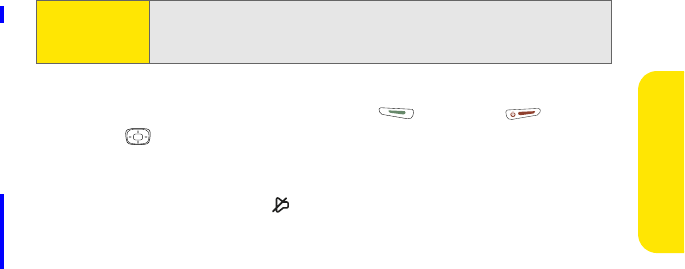
Section 2B: Using Your Device’s Phone Features 63
Phone Features
Silencing the Ring of an Incoming Call
ᮣPress any key on your device except Send , Power/End , or the
5-way .
–or–
To immediately silence all system sounds including the ringer, slide the
Ringer switch to Sound Off (see “Silencing Sounds” on page 284).
If music is playing and a call arrives, the phone rings softly. The music
automatically pauses; it resumes when you hang up or ignore the call.
Tip: Do not press Power/End to ignore a call waiting alert; this hangs up your
active call (the call waiting alert then changes to an incoming call alert).
Use the 5-way method instead.
FINAL DRAFT Palm, Inc. Confidential
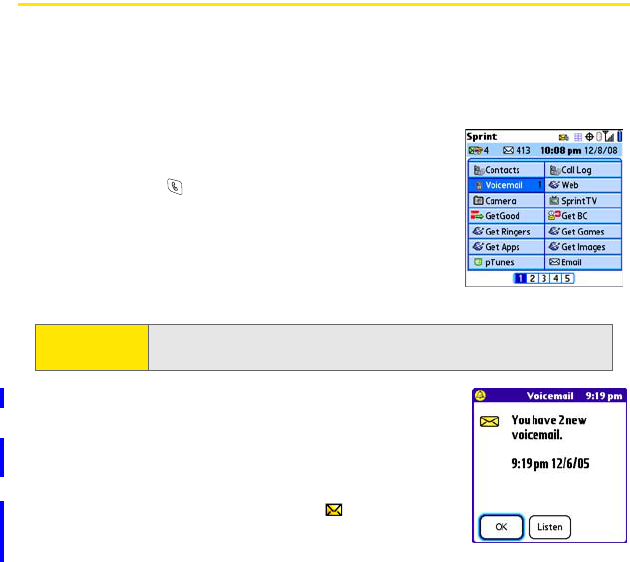
64 Section 2B: Using Your Device’s Phone Features
Using Voicemail
Setting Up Your Voicemail
Your voicemail number is preset when you activate your device. The first time you
call voicemail, you are prompted to enter your voicemail password. If necessary,
please contact Sprint for your password and enter it as prompted.
1. Make sure your phone is turned on (see “Turning
Your Device’s Phone On and Off” on page 55).
2. Press Phone .
3. Select the Voicemail favorite button to dial the
automated voicemail system.
4. Follow the voice prompts to set up your voicemail.
Voicemail Notification
When you have a new voicemail message, you are
notified with an Alert screen. To respond to the Alert
screen, select OK to dismiss the alert or select Listen to
play the message. When you have messages that you
have not listened to, the Voicemail icon also
appears in the title bar at the top of the Main view in
the Phone application.
Tip: You can also press and hold 1 to dial voicemail from the Dial Pad and
Favorites.
FINAL DRAFT Palm, Inc. Confidential

Section 2B: Using Your Device’s Phone Features 65
Phone Features
Retrieving Your Voicemail Messages
1. Press Phone .
2. Press and hold 1 to dial the voicemail system, or select the Voicemail favorite
button.
3. Enter your voicemail password by using the keyboard, or select Extra Digits if
you defined this option (see “Defining Favorite Buttons” on page 78 for
details on defining extra digits). Remember that you do not need to press
Option to enter numbers, an asterisk (*), or a pound sign (#) while on an
active call.
Tip: If the Voicemail icon appears in the title bar of the Main view of the
Phone application, you can select this icon to retrieve your voicemail.
FINAL DRAFT Palm, Inc. Confidential

66 Section 2B: Using Your Device’s Phone Features
Accessing Your Voicemail From Another Phone
1. Dial your wireless phone number.
2. Press when your voicemail answers.
3. Enter your password, and then press .
Displaying Numeric Pages
If an incoming call goes to voicemail, the caller can choose to enter their phone
number as a numeric page instead of leaving a voicemail message. When
someone pages you, the page is displayed on the Alert screen. If there is just one
alert, the icon is a phone with a bubble on it . If there are multiple alerts, the
icon is a messaging icon .
1. From the Alert screen, highlight an item with an alert icon.
2. Select Go To to view the page in the Messaging application. The page
displays the caller’s phone number.
*
#
FINAL DRAFT Palm, Inc. Confidential
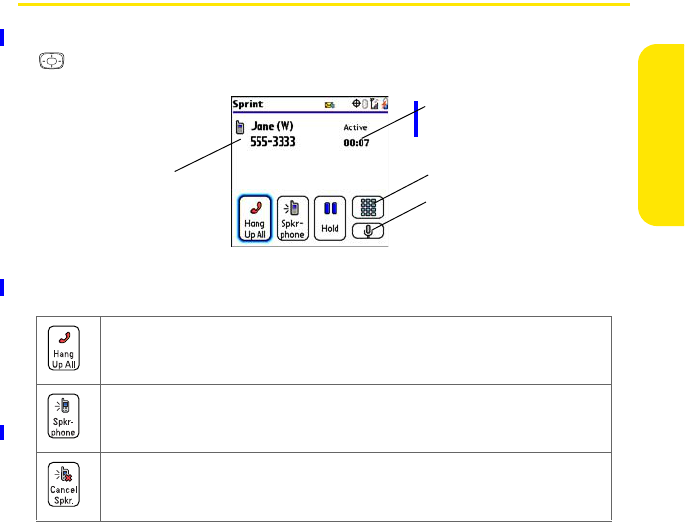
Section 2B: Using Your Device’s Phone Features 67
Phone Features
Managing Active Calls
When you make or receive a call, Active Call view appears. Use the 5-way navigator
to access the onscreen buttons in this view.
The onscreen buttons in Active Call view perform the following functions:
Ends the call immediately. You can also press the headset button (if the headset
is attached).
Turns on the speakerphone. When the speakerphone is on, you can take the
device away from your ear and use other features during a call. For example, you
can check your calendar or look up contact information.
Turns off the speakerphone when it is on.
Caller’s Name
and Number
Current Duration
of Call
Dial Pad
Mute
FINAL DRAFT Palm, Inc. Confidential
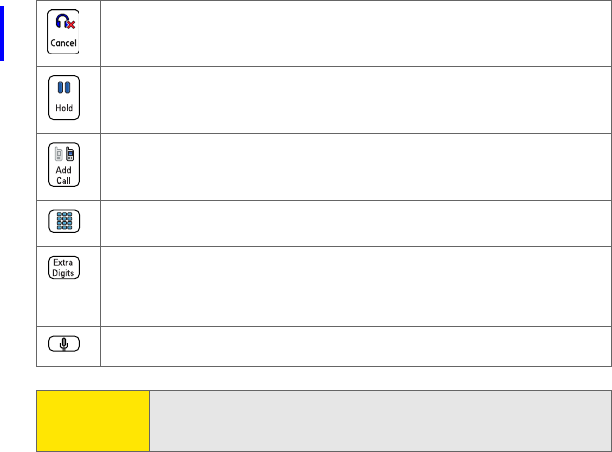
68 Section 2B: Using Your Device’s Phone Features
Replaces the Spkr-phone button when a Bluetooth® hands-free device such as a
headset or car kit is attached. Select this button to transfer the call from the
Bluetooth hands-free device to the built-in earpiece.
Places the current call on hold.
Enables you to place another call while the first call is on hold. For information
on handling a second outgoing call, see “Making a Second Call” on page 71.
Opens the Dial Pad so you can manually dial additional numbers, such as an
extension or a response to a voice prompt.
Dials any extra digits (such as a password or an extension) that you assigned to a
favorite button. This button replaces the Dial Pad button during outgoing calls
to numbers that include predefined extra digits. See “Defining Favorite Buttons”
on page 78 for information on defining extra digits.
Mutes the microphone so that you cannot be heard.
Tip: To avoid accidentally pressing onscreen buttons while holding the device
to your ear, you can disable the screen’s touch-sensitive feature during
active calls (see “Locking Your Screen” on page 299).
FINAL DRAFT Palm, Inc. Confidential
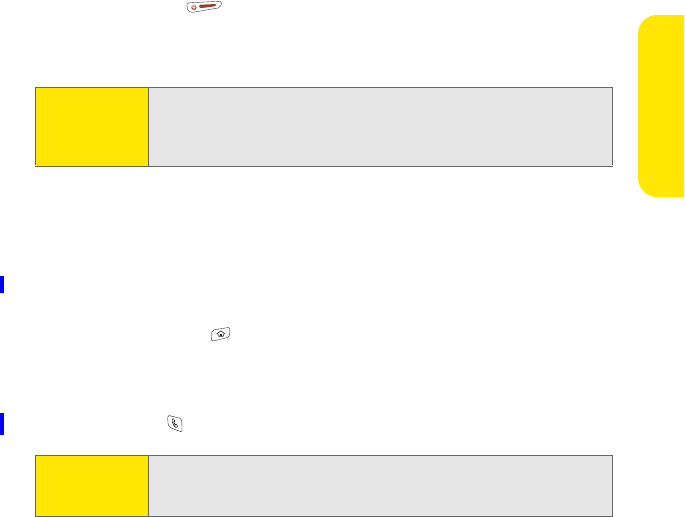
Section 2B: Using Your Device’s Phone Features 69
Phone Features
Ending a Call
Do one of the following to end a call:
ⅷPress Power/End .
ⅷSelect Hang Up All.
ⅷPress the button on the headset (if the headset is attached).
Switching Applications During an Active Call
You can use many other applications on your device while holding a phone
conversation, including the organizer and text messaging features. You cannot,
however, make a data connection while on an active call. This means that you
cannot browse the Web or send and receive email or Picture Mail messages while
on an active call.
1. Go to Applications .
2. Select the icon for the application you want to open.
3. Complete the task in the application.
4. Press Phone to return to Active Call view.
Tip: When a call lasts longer than two minutes, the screen dims. Press any
key except Power/End to wake up the screen, and then press Power/End
to hang up the call. Be careful not to press Power/End to wake up the
screen because this will accidentally end the call.
Tip: If you’d like to continue talking while viewing another application, select
Spkr-phone before you switch to the other application. If you’re using a
headset, you can skip this step.
FINAL DRAFT Palm, Inc. Confidential
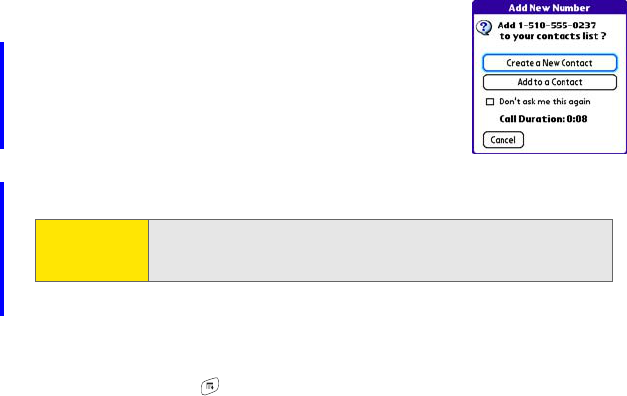
70 Section 2B: Using Your Device’s Phone Features
Saving Phone Numbers
After you complete an outgoing call to a number that is not in your Contacts list,
you are prompted to add the number to your Contacts list. You are also prompted
to add new numbers from incoming calls with caller ID.
ⅷTo create a new contact entry for this number, select
Create a New Contact, and enter the contact’s
information.
ⅷTo add this number to an existing contact entry,
select Add to a Contact, and then select the contact.
The number is pasted into the first available phone
number field for that contact.
ⅷTo decline adding this number, select Cancel.
ⅷTo disable the Add New Number prompt, check the Don’t ask me this again box.
If you don’t add a number right away, follow these steps to add it later:
1. In the Call Log (see “Redialing a Recently Called Number” on page 61),
highlight the number you want to save.
2. Open the menus .
3. Select Add Contact.
4. Enter the information for the entry.
5. Select Done.
Tip: You can re-enable the Add New Number prompt if you’ve disabled it. In
the Phone application, open the menus and select Phone Preferences.
Check the Ask to add unknown phone numbers after calls box.
FINAL DRAFT Palm, Inc. Confidential
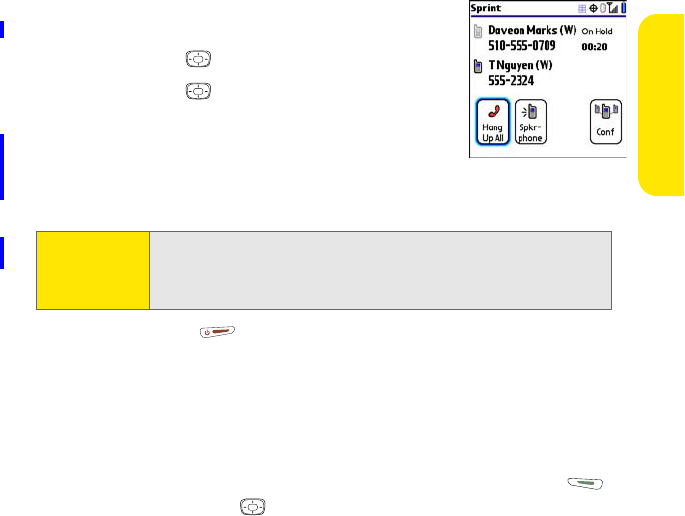
Section 2B: Using Your Device’s Phone Features 71
Phone Features
Making a Second Call
You can make a second call while your first call is still active.
1. Dial the first number and wait until the person
answers.
2. Use the 5-way to select Hold.
3. Use the 5-way to select Add Call.
4. Dial the second number using any of the methods
described in “Making Calls” on page 57.
5. When the Dial another call? prompt appears,
select Yes.
6. Press Power/End to end both calls. To return to the first call, wait for
the second call to hang up.
Answering a Second Call (Call Waiting)
When you are on an active call, you can receive a second call. When the second
call comes in, you hear a call waiting tone and the Call Waiting dialog box appears.
You can do any of the following to handle the second call:
ⅷTo place the current call on hold and answer the new call, press Send or
use the 5-way navigator to select Answer.
Tip: Active Call view now includes two status lines, each representing one of
the calls. You can join the two calls in a conference call by selecting Conf.
or finish the second call and return to the first call, but you cannot
switch between the two calls.
FINAL DRAFT Palm, Inc. Confidential
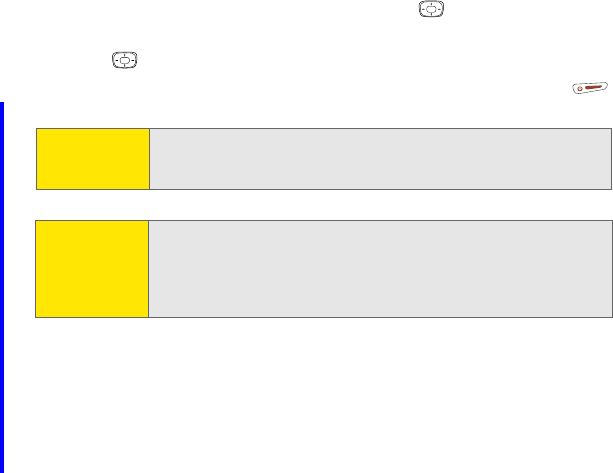
72 Section 2B: Using Your Device’s Phone Features
ⅷTo send the new call to voicemail, use the 5-way to select Ignore.
ⅷTo send the new call to voicemail and send the caller a text message, use the
5-way to select Ignore with Text.
ⅷTo hang up the current call and answer the new call, press Power/End .
Making a Conference Call Using Three-Way Calling
You can join two calls in a conference session by using three-way calling. Normal
airtime rates apply for each of the two calls.
1. When your first call is active, place a second call (see “Making a Second Call”
on page 71). (You cannot initiate a three-way call if the second call is an
incoming call.)
Tip: Once you have answered a second call, to switch back and forth
between the original call and the call you answered, use the 5-way to
select Swap.
Note: When you answer a second call and then select the Hang Up All button,
it ends both calls. In this situation, if the first caller has not yet hung up
the phone, the Nationwide Sprint PCS Network automatically redials
your number from the first caller’s number and you see an incoming call
alert. You can answer to continue your call with the first caller.
FINAL DRAFT Palm, Inc. Confidential
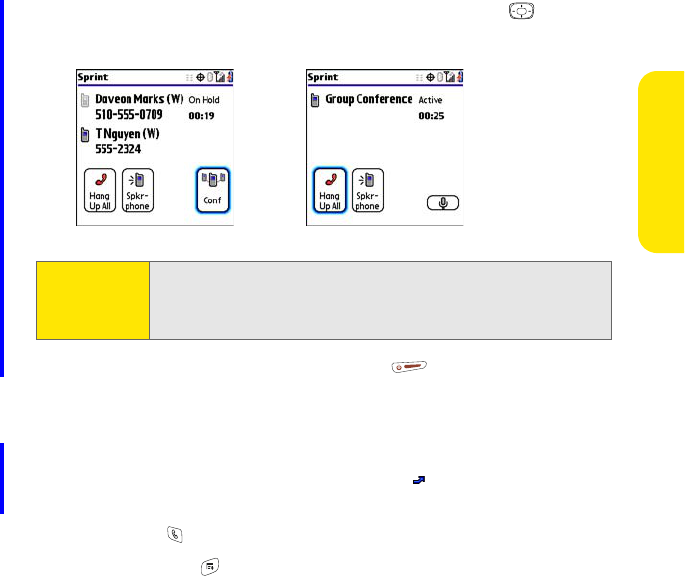
Section 2B: Using Your Device’s Phone Features 73
Phone Features
2. When you’re connected to the second party, use the 5-way to select
Conf to begin your three-way call.
3. To end the three-way call, press Power/End or select Hang Up All.
Call Forwarding
You can forward calls to another number. You can still make calls from your
device while call forwarding is activated. There is an additional per-call charge for
this service. When call forwarding is active, an icon appears in the title bar of
the Phone application’s Main view.
1. Press Phone .
2. Open the menus .
Note: If one of the people you called hangs up, you and the remaining caller
stay connected. The screen does not change to indicate that one of the
callers has hung up. If you initiated the call and are the first to hang up,
all three callers are disconnected.
FINAL DRAFT Palm, Inc. Confidential
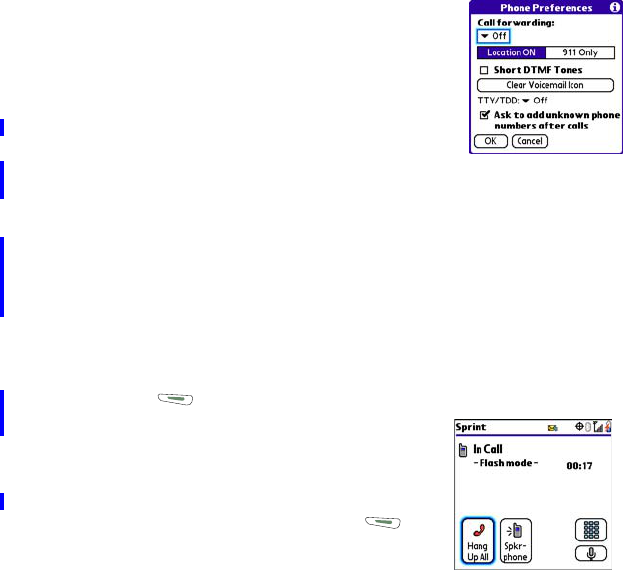
74 Section 2B: Using Your Device’s Phone Features
3. Select Options, and then select Phone Preferences.
4. Select the Call forwarding pick list.
ⅢIf the forwarding number appears in the pick
list, select the number.
ⅢIf the forwarding number does not appear in
the pick list, select Edit numbers, and then select
New. Enter a 10-digit forwarding number
without spaces, and select OK. Then select the
number from the Call forwarding pick list.
5. Select OK.
6. Call your Treo device to confirm that call forwarding is active.
Using Flash Mode During an Active Call
Flash mode provides an alternate way to manage your calls while one or more
calls are active. For example, you can dial another call, swap between active calls,
or join two calls in a conference session with the press of a button while in Flash
mode.
1. Press Send from Active Call view.
2. If the Do you want to switch to Flash mode?
prompt appears, select Yes.
3. While in Flash mode, do any of the following:
ⅢIf you have one active call and you answer
an incoming second call, press Send to
swap between the calls.
FINAL DRAFT Palm, Inc. Confidential
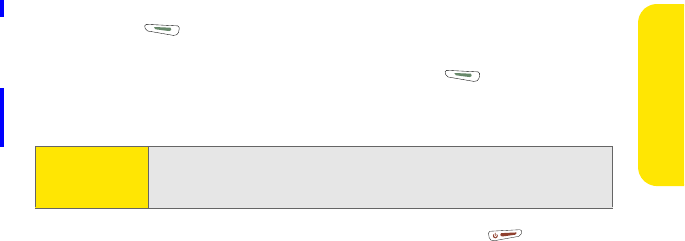
Section 2B: Using Your Device’s Phone Features 75
Phone Features
ⅢIf you have one active call, to make an outgoing second call, dial the
number using any of the methods described in “Making Calls” on
page 57.
ⅢIf you have one active call and you place an outgoing second call, press
Send after establishing a connection with the second party to set
up a conference session using three-way calling.
ⅢIf you have two calls in conference, press Send to hang up one of
the calls; you can then dial another number and include the new caller
in the conference session.
4. To exit Flash mode and end all the calls, press Power/End .
Note: Pressing Send during a conference call usually hangs up the second call.
However, depending on your network connection, you may occasionally
hang up the first call.
FINAL DRAFT Palm, Inc. Confidential
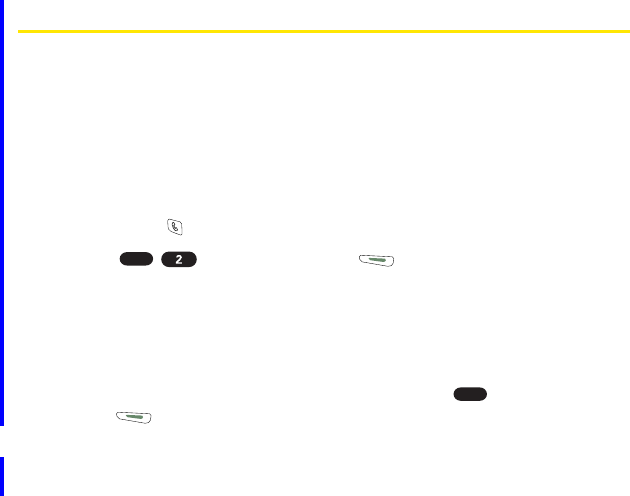
76 Section 2B: Using Your Device’s Phone Features
Using Sprint PCS® Voice Command
If you subscribe to the Sprint PCS® Voice Command service, you can call a number
by just saying a name. (There is a monthly charge for this service.)
To activate Sprint PCS Voice Command, you must speak to a Sprint Customer
Service representative:
1. Make sure your phone is turned on (see “Turning Your Device’s Phone On
and Off” on page 55).
2. Press Phone .
3. Press , and then press Send to contact Sprint Customer
Service and sign up.
Setting Up Your Personal Address Book
To use Sprint PCS Voice Command, you must first set up your personal address
book.
1. From the Main view of the Phone application, press , and then press
Send . Follow the system prompts. (You’ll hear a tone, followed by the
prompt “Ready.”)
2. Say “Add Name” to begin setting up your Personal Address Book, and then
follow the voice prompts.
*
*
FINAL DRAFT Palm, Inc. Confidential

Section 2B: Using Your Device’s Phone Features 77
Phone Features
Making a Call With Sprint PCS Voice Command
1. From the Main view of the Phone application, press , and then press
Send . (You’ll hear a tone followed by the prompt “Ready.”)
2. After the prompt, say “Call” and the name you’ve assigned to the number
you want to call. (Your request will be repeated and you will be asked to
verify it.)
3. Say “Yes” to dial the call. Say “No” to cancel.
*
FINAL DRAFT Palm, Inc. Confidential
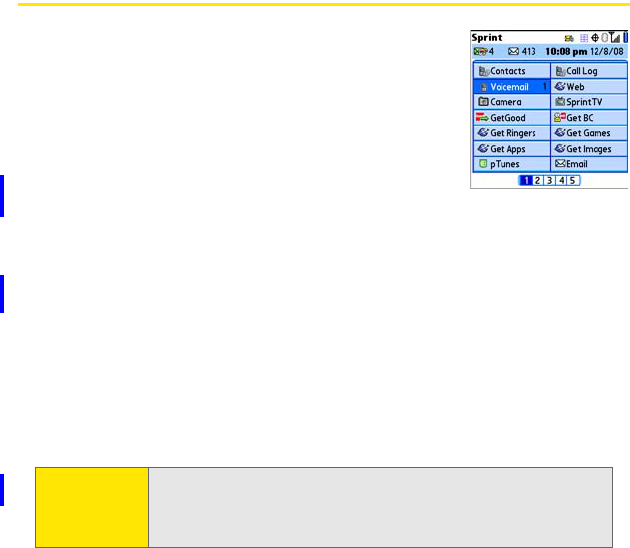
78 Section 2B: Using Your Device’s Phone Features
Defining Favorite Buttons
Your Treo device provides 70 programmable favorite
buttons for quick access to the following common tasks:
ⅷDialing a phone number (speed dial)
ⅷAccessing your Call Log
ⅷAccessing the onscreen Dial Pad
ⅷOpening an application
ⅷAccessing a Web page
ⅷAddressing a text, email, or Picture Mail message
ⅷAccessing voicemail (preset on your Treo device)
Sprint may preset favorite buttons on your device that are customized for their
services. You can customize all favorite buttons except Voicemail—either delete
and reassign existing favorite buttons or create new ones—to perform any of the
supported tasks.
For each favorite button, you can also set up a Quick Key that gives you instant
access to the phone number or corresponding screen. Quick Keys are optional and
can be letters only, except for the Voicemail Quick Key, which is preprogrammed as
1. The letter equivalent for that key is E, so you cannot assign E as a Quick Key to
another favorite button.
Tip: If you’re upgrading from a previous Treo device, your favorites might be
transferred along with your other information. However, you may need
to rearrange the order in which your favorite buttons appear by opening
the Record menu and then selecting Edit Favorites Pages.
FINAL DRAFT Palm, Inc. Confidential
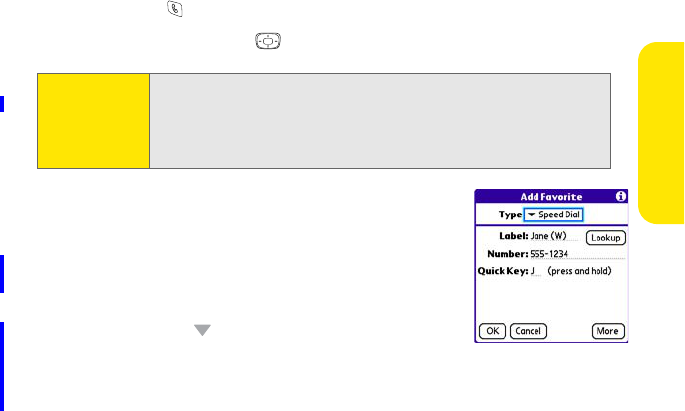
Section 2B: Using Your Device’s Phone Features 79
Phone Features
Creating a Speed-Dial Favorite Button
1. Press Phone .
2. Use the 5-way navigator to select a blank favorite button.
3. Enter a label for the favorite.
ⅢIf the entry is for an existing contact, select
Lookup. Start entering the contact’s last name,
and then select the number you want for the
contact when it appears in the lookup list.
ⅢIf the entry is for a new contact, enter the Label,
press Down , and enter the Number.
4. (Optional) Enter a Quick Key, a letter which you can
press and hold from the Main, Dial Pad, or Favorites view of the Phone
application to dial this speed-dial number.
Tip: If there are no blank favorite buttons on the current Favorites page,
press Right on the 5-way to scroll through the other pages. If you run
out of blank favorite buttons, you can delete some existing favorites to
make room for new ones (see “Editing or Deleting an Existing Favorite
Button” on page 81).
FINAL DRAFT Palm, Inc. Confidential
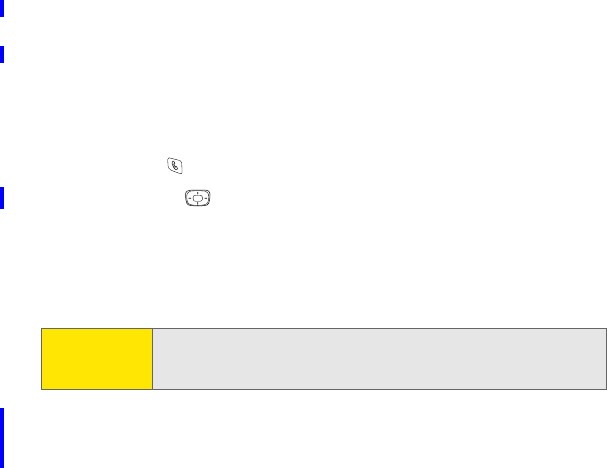
80 Section 2B: Using Your Device’s Phone Features
5. (Optional) Select More, and then select advanced options:
ⅢExtra Digits lets you define additional digits to dial, such as a password
or extension. To enter a one-second pause, insert a comma between
digits. To add a longer pause, enter more commas.
ⅢDial Extra Digits automatically dials predefined extra digits immediately
after dialing the phone number, when checked.
6. Select OK.
Creating Other Types of Favorite Buttons
1. Press Phone .
2. Use the 5-way to select a blank favorite button.
3. Select the Type pick list and select Call Log, Dial Pad, Contacts, Application,
Message, Email, or Web Link.
4. Enter a label for the favorite and enter any other necessary information on
the screen.
5. (Optional) Enter a Quick Key, a letter which you can press and hold from the
Main, Dial Pad, or Favorites view of the Phone application to open the
favorite.
6. Select OK.
Tip: When creating a Message or Email favorite you can enter multiple
addresses; simply separate each address with a comma. This is an easy
way to send messages to a group of people.
FINAL DRAFT Palm, Inc. Confidential
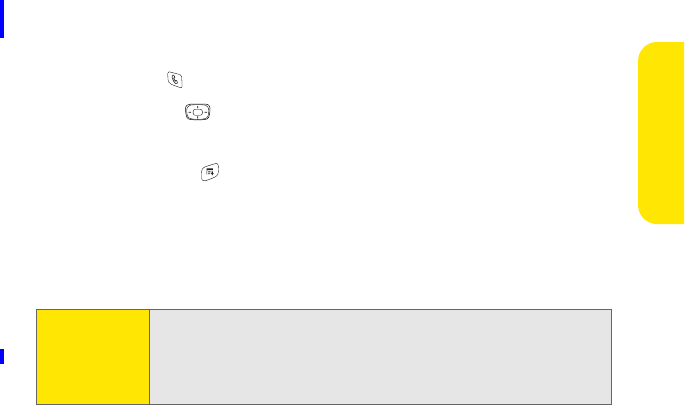
Section 2B: Using Your Device’s Phone Features 81
Phone Features
Editing or Deleting an Existing Favorite Button
You can edit or delete most favorite buttons. You cannot edit or delete the preset
Voicemail button, but you can add extra digits or move the Voicemail button to a
different position.
1. Press Phone .
2. Use the 5-way to access Favorites.
3. Highlight the favorite button you want to edit or delete.
4. Open the menus .
5. Select Edit Favorites Button on the Record menu.
6. To edit the entry, make the desired changes. (For example, you can add a
Quick Key shortcut to any favorite.) To delete the entry, select Delete.
7. Select OK.
Tip: You can also organize your favorite buttons on different pages. Open the
Record menu, and then select Edit Favorites Pages. To arrange your
favorites, drag and drop the buttons into a new slot. To move a favorite
to another page, drag the button onto the page icon at the bottom of
the screen.
FINAL DRAFT Palm, Inc. Confidential
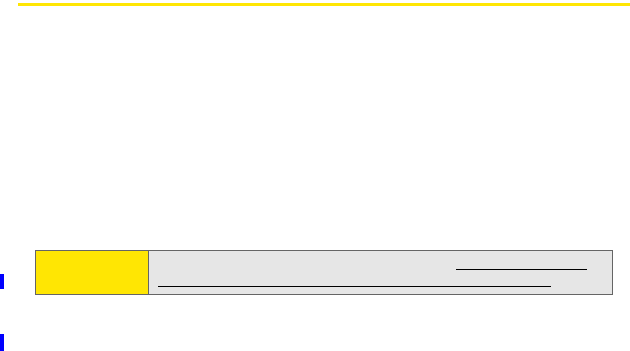
82 Section 2B: Using Your Device’s Phone Features
Using a Phone Headset
You can connect a phone headset for hands-free operation. If you need to use
your device while driving and this is permitted in your area, we recommend using
a phone headset (wired headset included) or a hands-free car kit (sold
separately).
In addition to the stereo headset included with your Treo device, your device is
compatible with the following types of headsets that are sold separately:
ⅷWired headsets with a 2.5mm connector (3-pin or 4-pin)
ⅷWireless headsets and car kits enabled with Bluetooth 1.1 or 1.2 wireless
technology
Check the specifications for your headset or car kit to confirm compatibility.
Please note that you cannot use stereo headphones with Bluetooth wireless
technology to listen to music files.
Note: For a list of compatible hands-free devices, go to www.palm.com/us/
support/bluetooth/treo700p_bluetooth_compatibility.html.
FINAL DRAFT Palm, Inc. Confidential
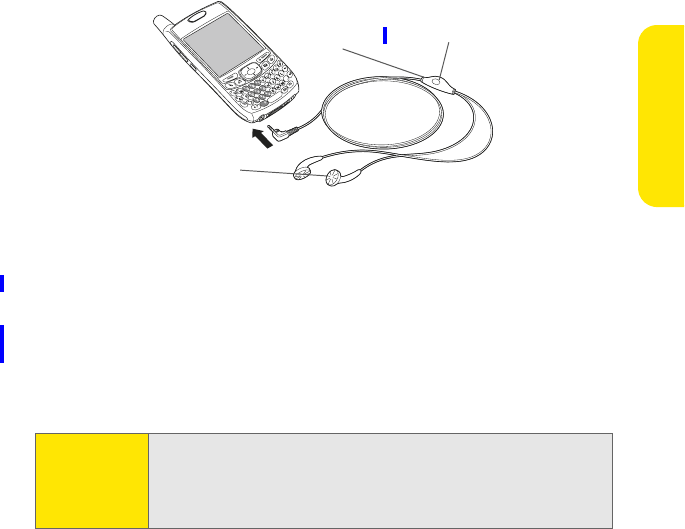
Section 2B: Using Your Device’s Phone Features 83
Phone Features
Using a Wired Headset
When using the headset that is included with your device, you can press the
headset button to perform any of the following tasks:
ⅷAnswer an incoming call or a call waiting call.
ⅷPick up a call that is on hold.
ⅷSwitch between an active call and a call on hold (if the second call is
incoming).
ⅷJoin two calls in a conference (if the second call is outgoing).
ⅷHang up a single call.
Note: The headset designed for Treo™ 180, 270, and 300 devices is not
compatible with your Treo 700P smart device. Standard headsets sold
with other Sprint phones are compatible with your device. If you hear a
headset buzz or experience poor microphone performance, your headset
may be incompatible with your device.
Microphone
Headset
Button
Speaker
FINAL DRAFT Palm, Inc. Confidential
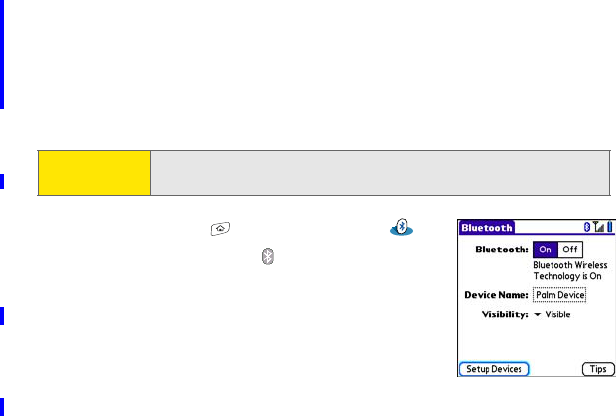
84 Section 2B: Using Your Device’s Phone Features
Connecting to a Bluetooth Hands-Free Device
Once you set up a partnership with a Bluetooth hands-free device such as a
headset or car kit, you can communicate with that device whenever it is powered
on and within range. Bluetooth range is up to 30 feet in optimum environmental
conditions. Performance and range may be affected by physical obstacles, radio
interference from nearby electronic equipment, and other factors.
1. Go to Applications and select Bluetooth ,
or tap the Bluetooth icon in the title bar.
2. Select On.
3. Enter a device name for your Treo device. This is
the name that appears on the other Bluetooth
device’s screen when it connects to your Treo
device.
4. Prepare your hands-free device to accept a connection from another
Bluetooth device. See the documentation that came with your hands-free
device for instructions.
Note: In the documentation for the other device, a partnership might be
referred to by a term such as trusted pair, trusted device, or pairing.
FINAL DRAFT Palm, Inc. Confidential
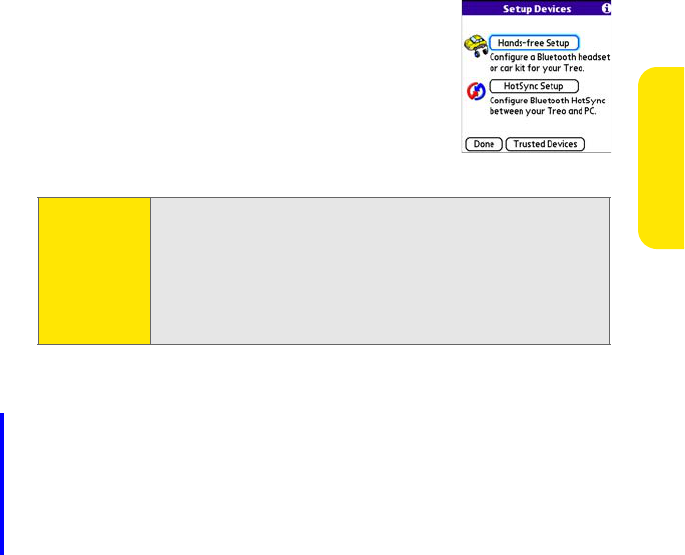
Section 2B: Using Your Device’s Phone Features 85
Phone Features
5. Select Setup Devices.
6. Select Hands-free Setup.
7. Follow the onscreen instructions to create a
partnership with the specific hands-free device.
When prompted, enter a passkey.
8. After you finish setting up the device, select Done to return to Applications
view.
You can now use your Treo device with the Bluetooth hands-free device such as a
headset or car kit.
Using a Bluetooth Hands-Free Device
If your Bluetooth hands-free device is turned on and within range (up to 30 feet
in ideal conditions), the Treo device automatically routes all calls to the hands-
free device instead of to the Treo device’s earpiece. When a call comes in, your
Important: Some hands-free devices may have a built-in passkey; other devices may
provide a screen where you enter the passkey. In either case, you must
use the same passkey on both your Treo device and your hands-free
device. We recommend that you use a passkey of 16 digits, where
possible, to improve the security of your Treo device. The longer the
passkey, the more difficult it is for the passkey to be deciphered. If the
hands-free device has a built-in passkey, see the device’s documentation
for the passkey.
FINAL DRAFT Palm, Inc. Confidential

86 Section 2B: Using Your Device’s Phone Features
device rings and the hands-free device beeps. Even if you answer the call on your
Treo device, the call goes to the hands-free device.
The features available on your hands-free device vary by model. Check the
documentation for your hands-free device for details on the supported features
and how to use those features. Your Treo device can support the following
features, provided that your hands-free device also supports them:
ⅷAnswer an incoming call.
ⅷAnswer a call waiting call.
ⅷSwitch between an active call and a call on hold (if the second call is
incoming).
ⅷHang up a single call.
ⅷTransfer an outgoing call from the Treo device’s earpiece to the hands-free
device.
ⅷIgnore an incoming call.
ⅷRedial the last number you called from the hands-free device.
ⅷView a log of recently received, missed, and dialed calls, and dial numbers for
these calls directly from the hands-free device.
ⅷTransfer speed-dial favorites and Contacts entries containing phone numbers
from your Treo device to the hands-free device phone book, up to the
maximum number of entries allowed in your hands-free device’s phone book.
Tip: Your Treo device transfers speed-dial favorites first, and then contacts in
alphabetical order up to the maximum number of entries allowed in
your hands-free device’s phone book. So if you have important numbers
that you want to show up in your hands-free device’s phone book, be
sure to create speed-dial favorites for them before you transfer the
numbers.
FINAL DRAFT Palm, Inc. Confidential

Section 2B: Using Your Device’s Phone Features 87
Phone Features
Setting Up Your Hands-Free Device to Automatically Answer Calls
You can set your Bluetooth hands-free device to automatically answer incoming
calls, provided that your device supports this feature.
1. Go to Applications and select Prefs .
2. Select Handsfree.
3. Select the Auto answer pick list and select whether you want your hands-
free device to automatically answer incoming calls, and how quickly you
want it to answer.
4. Select Done.
FINAL DRAFT Palm, Inc. Confidential
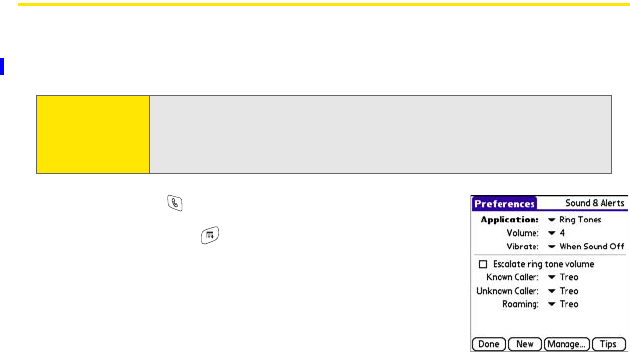
88 Section 2B: Using Your Device’s Phone Features
Customizing Phone Settings
Selecting Ringtones
You can set various tones for various types of incoming phone calls.
1. Press Phone .
2. Open the menus .
3. Select Options, and then select Sound Preferences.
4. Select the Application pick list, and then select Ring
Tones.
5. Select the Volume pick list, and then select the
volume level.
6. Select the Vibrate pick list, and then select when you want the vibrate
option to turn on.
7. (Optional) Check the Escalate ring tone volume box if you want the ring to
play softly and then increase to full volume the longer it rings.
8. Select ringtones from the following pick lists:
ⅢKnown Caller for an incoming call from someone in your Contacts
or Favorites.
Tip: You can download any compatible ringtone directly to your device (see
“Downloading Files From a Web Page” on page 163). You can also
download ringtones to your computer and then email them to your
device.
FINAL DRAFT Palm, Inc. Confidential
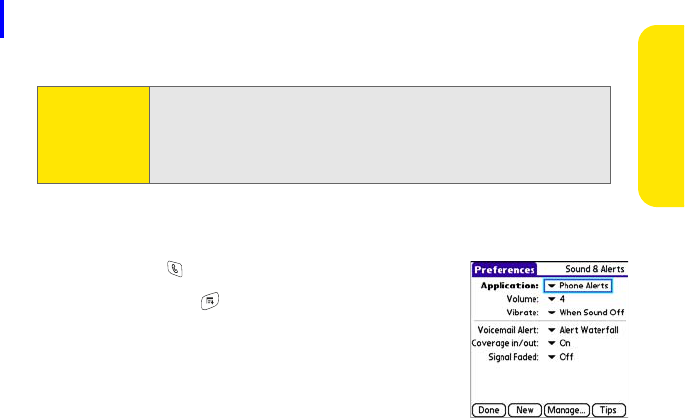
Section 2B: Using Your Device’s Phone Features 89
Phone Features
ⅢUnknown Caller for an incoming call from someone identified by caller
ID who is not in your Contacts or Favorites.
ⅢRoaming for incoming calls when you’re outside the Nationwide Sprint
PCS Network.
9. Select Done.
Selecting Phone Alert Tones
You can set various tones for various types of alerts.
1. Press Phone .
2. Open the menus .
3. Select Options, and then select Sound Preferences.
4. Select the Application pick list, and then select Phone
Alerts.
5. Select the Volume pick list, and then select the
volume level.
6. Select the Vibrate pick list, and then select when you want the vibrate
option to turn on.
Tip: You can also preview, delete, and send sounds on your device. Go to
Applications, select Sound Preferences, and then select Manage. To play
a sound, select it, and then press Center on the 5-way. To delete a sound,
select it, and then press Backspace. To send a sound, select it, and then
select Send.
FINAL DRAFT Palm, Inc. Confidential
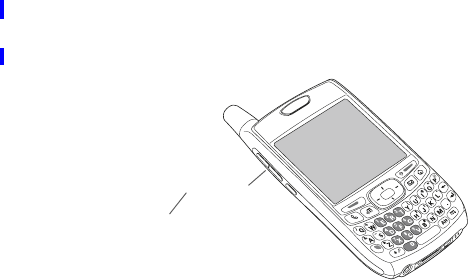
90 Section 2B: Using Your Device’s Phone Features
7. Select alert tones from the following pick lists:
ⅢVoicemail Alert to indicate when a new voicemail message has arrived.
ⅢCoverage in/out to indicate if you’ve moved in or out of a coverage area.
ⅢSignal faded to indicate if the network signal lost strength or
disappeared and a call was dropped.
8. Select Done.
Adjusting Call Volume
ᮣWhile a call is in progress, press the Volume button on the side of your
device to adjust the call volume.
Adjusting Ringer Volume
ᮣWhen you are not on a call, press the Volume button on the side of your
device to adjust the ringer volume, and then press the Side button to
confirm the change.
Volume Button
Side Button
FINAL DRAFT Palm, Inc. Confidential
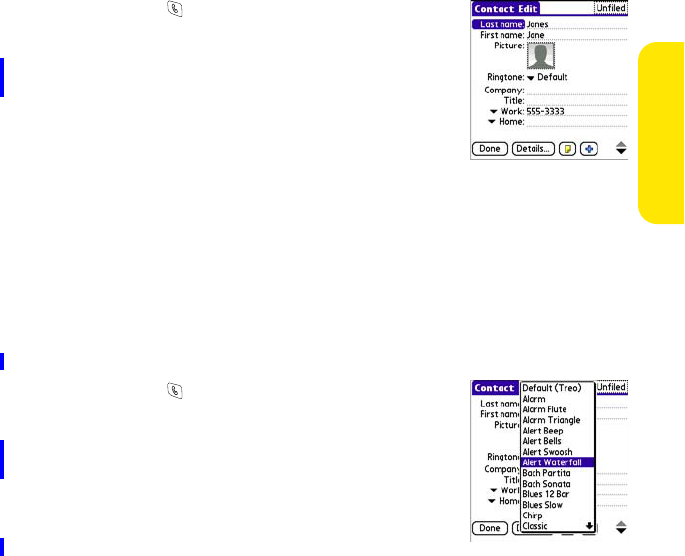
Section 2B: Using Your Device’s Phone Features 91
Phone Features
Assigning a Caller ID Picture
1. Press Phone .
2. Select the Contacts favorite button.
3. Open the contact entry to which you want to give a
caller ID picture, and then select Edit.
4. Select the Picture box and do one of the following:
ⅢSelect Camera to take a picture and add it to this
contact entry when you save the picture (if your
device includes a camera).
ⅢSelect Photos and select an existing picture that you want to assign to
this contact.
5. Select Done.
Assigning a Caller ID Ringtone
Caller ID ringtones can let you know who is calling before you even look at your
device. This is a great way to keep track of calls from important people in your life
and to screen calls you’d prefer not to answer.
1. Press Phone .
2. Select the Contacts favorite button.
3. Open the contact entry to which you want to give a
caller ID ringtone, and then select Edit.
4. Select the Ringtone pick list and select a ringtone for
this contact.
5. Select Done.
FINAL DRAFT Palm, Inc. Confidential
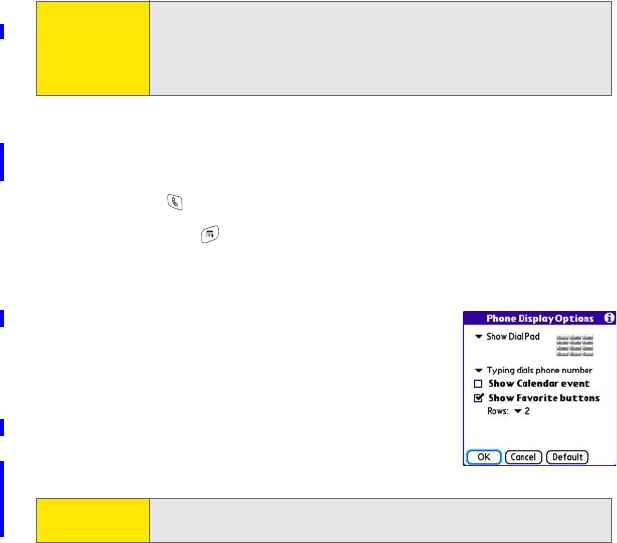
92 Section 2B: Using Your Device’s Phone Features
Customizing the Main View in the Phone Application
Phone Display Options let you customize the appearance and text entry mode of
the Main view in the Phone application.
1. Press Phone .
2. Open the menus .
3. Select Options, and then select Phone Display Options.
4. Set any of the following options:
ⅢShow … sets whether the Dial Pad or
wallpaper appears in the Main view of the
Phone application. If you select Show
Wallpaper, select the thumbnail image and
then select an image to use as wallpaper.
ⅢTyping … sets whether typing enters numbers
in the Dial Pad or starts a contact search.
Tip: You can assign a ringtone to an entire category of contacts. For example,
use a special ringtone for categories such as Family, Work, or Golf
Buddies. Select the category pick list in the upper-right corner, select Edit
Categories, and then select the category. Select the ringtone on the Edit
Category screen.
Tip: If you choose to have typing start a contact search, you need to press
Option to enter a number when dialing from the Dial Pad.
FINAL DRAFT Palm, Inc. Confidential

Section 2B: Using Your Device’s Phone Features 93
Phone Features
ⅢShow Calendar event: Sets whether the current event from the Calendar
application appears in the Main view of the Phone application. When
this option is enabled, you can then select this event to jump to the
Calendar application.
ⅢShow Favorite buttons: Sets whether Favorites appear in the Main view of
the Phone application.
ⅢRows: Sets the number of favorite button rows that appear in the Main
view of the Phone application.
5. Select OK.
Setting Your Dialing Preferences
Dialing preferences let you add a prefix to your phone numbers. For example, you
can automatically dial a 1 before all 10-digit phone numbers you enter from
Contacts. You can also add a different prefix based on the length of the phone
number.
1. Press Phone .
2. Open the menus .
3. Select Options, and then select Dial Preferences.
FINAL DRAFT Palm, Inc. Confidential
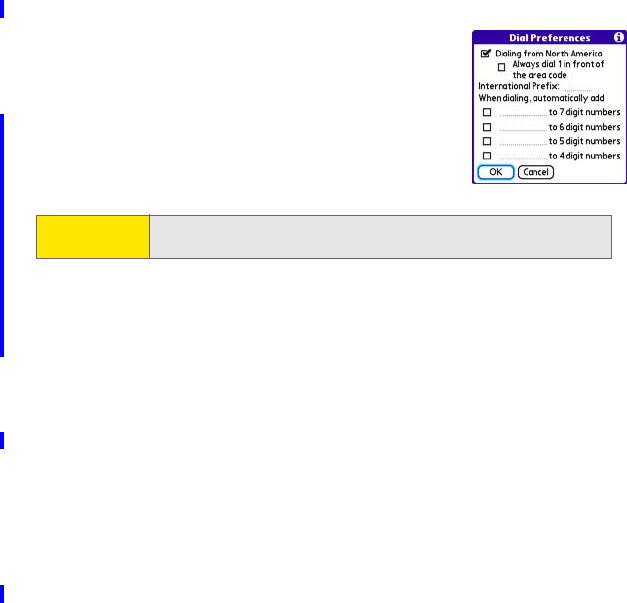
94 Section 2B: Using Your Device’s Phone Features
4. Set any one or more of the following options:
ⅢDialing from North America: Formats phone
numbers using North American conventions
(XXX-XXX-XXXX).
ⅢAlways dial 1 in front of the area code: Adds a 1 in
front of 10-digit phone numbers you dial from
Contacts (see “Dialing by Contact Name” on
page 58). This option is available only when
Dialing from North America is enabled.
ⅢInternational Prefix: Adds the specified prefix in front of international
phone numbers; in the U.S. and Canada, this prefix is 011. When you
dial, the plus symbol (+) preceding the phone number is replaced by this
prefix.
ⅢTo 7 digit numbers: Adds a prefix to 7-digit numbers. For example, enter
your own area code to automatically add your area when you dial local
numbers.
ⅢTo 6/5/4 digit numbers: Adds a prefix to numbers with the specified
number of digits. For example, if all the phone numbers in your office
begin with 555, followed by a 4-digit extension, you can select 4 and
enter 555 as the prefix. When you want to call a colleague, simply enter
the colleague’s 4-digit extension. Your device automatically dials 555
plus the 4-digit extension. You can also create contact entries with just
the extension number and then dial the number from your Contacts list.
5. Select OK.
Tip: A 1 is not automatically entered if you dial using the keyboard or the Dial
Pad.
FINAL DRAFT Palm, Inc. Confidential
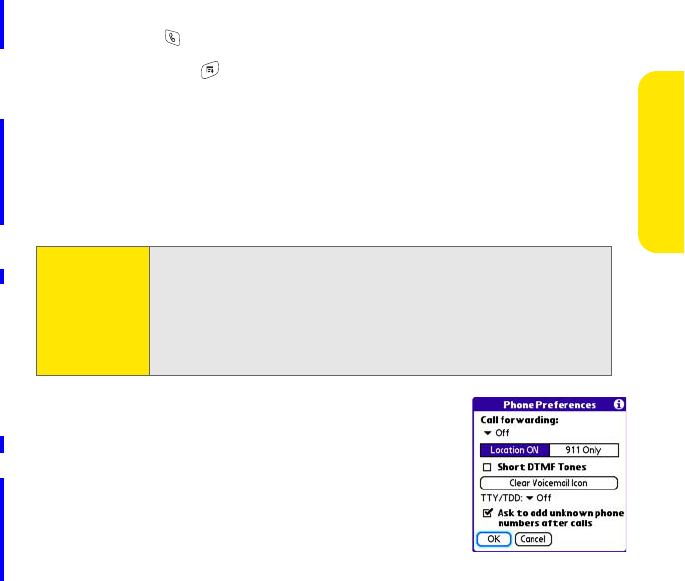
Section 2B: Using Your Device’s Phone Features 95
Phone Features
Setting Phone Preferences
1. Press Phone .
2. Open the menus .
3. Select Options, and then select Phone Preferences.
4. Select any one of more of the following preferences:
ⅢLocation ON allows the Nationwide Sprint PCS Network to determine
your longitude and latitude position at any time in order to provide
location-specific services. 911 Only restricts your location information to
emergency services only.
ⅢShort DTMF Tones lets you choose to send DTMF
tones (a certain type of touch-tone dialing tone)
stored as Extra Digits as rapid tones (see
“Defining Favorite Buttons” on page 78 for
information on defining extra digits).
Note: Your device is equipped with a location feature for use in connection
with location-based services that may be available in the future.
Currently the location information is used to help identify your
longitude and latitude position during an emergency call in areas where
E-911 service is available. For your safety, your location information will
always be provided during a 911 emergency call regardless of whether
you select this setting.
FINAL DRAFT Palm, Inc. Confidential

96 Section 2B: Using Your Device’s Phone Features
ⅢClear Voicemail Icon lets you manually reset the voicemail icon if it
continues to appear in the Phone application title bar even after you
have listened to all your voicemail.
ⅢTTY/TDD enables you to use your device’s phone if you are hearing
impaired. Select Default Mode to send and receive text. Select VCO Mode
(Voice Carry Over) to send voice and receive text. Select HCO Mode
(Hearing Carry Over) to send text and receive voice. See the following
section, “TTY Use With Sprint PCS Service,” for more information.
ⅢAsk to add unknown phone numbers after calls displays a prompt asking
whether you would like to add the unknown phone number to your
Contacts list when you complete a call.
5. Select OK.
TTY Use With Sprint PCS Service
A TTY (also known as a TDD or Text Telephone) is a telecommunications device
that allows people who are deaf or hard of hearing, or who have speech or
language disabilities, to communicate by telephone.
Your device is compatible with select TTY devices. You can connect a TTY/TDD
machine, headset, or hands-free kit to your device through the headset jack while
this mode is enabled. Please check with the manufacturer of your TTY device for
connectivity information and to ensure that the TTY device supports digital
wireless transmission.
Note: Some older answering machine systems may not recognize short tones.
FINAL DRAFT Palm, Inc. Confidential
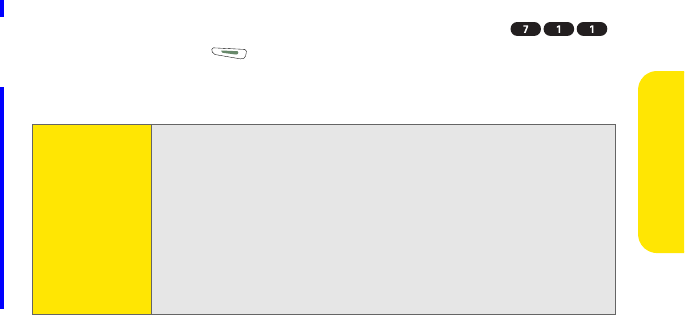
Section 2B: Using Your Device’s Phone Features 97
Phone Features
When establishing your Sprint PCS Service, please call Sprint Customer Service via
the state Telecommunications Relay Service (TRS) by first dialing ,
and then pressing Send . Then provide the state TRS with this number:
866-727-4889.
WARNING 911 Emergency Calling
Sprint recommends that TTY users make emergency calls by other
means, including Telecommunications Relay Services (TRS), analog
cellular, and landline communications. Wireless TTY calls to 911 may be
corrupted when received by public safety answering points (PSAPs),
rendering some communications unintelligible. The problem
encountered appears related to TTY equipment or software used by
PSAPs. This matter has been brought to the attention of the FCC, and the
wireless industry and PSAP community are currently working to resolve
this.
FINAL DRAFT Palm, Inc. Confidential

98 Section 2B: Using Your Device’s Phone Features
Controlling Your Roaming Experience
Your device is digital dual-band, which means you can make and receive calls
while on the Nationwide Sprint PCS Network and you can also roam on other
digital networks where Sprint has implemented roaming agreements with other
carriers.
When you roam outside the Nationwide Sprint PCS Network, the Roaming icon
appears at the top of the screen. Additional charges may apply if you use your
Treo 700P smart device while roaming.
To learn more about roaming, visit www.sprint.com.
Feature Availability
ⅷYou can make and receive calls while roaming.
ⅷYou can access voicemail while roaming.
ⅷOther features that are standard on the Nationwide Sprint PCS Network, such
as call waiting, Sprint PCS Voice Command, and Sprint PCS Vision or Sprint
Power Vision, may be available depending upon your roaming network.
Setting Roaming Preferences
Use Roaming Preferences to set specific options for using your phone while
roaming. For example, you can set options to be notified that you are roaming
before placing a call or making a data connection, so that you are aware that you
might incur extra charges.
1. Press Phone .
2. Open the menus .
FINAL DRAFT Palm, Inc. Confidential
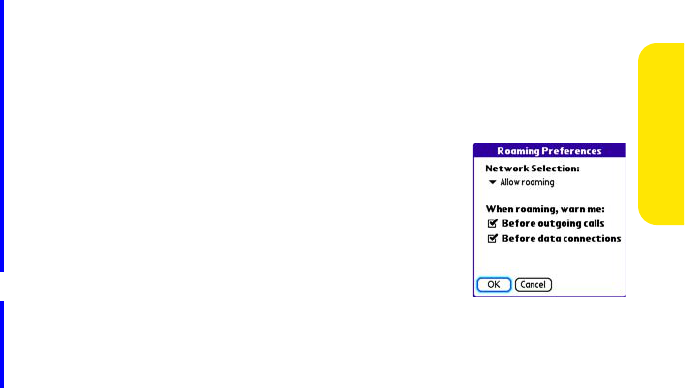
Section 2B: Using Your Device’s Phone Features 99
Phone Features
3. Select Options, and then select Roaming Preferences.
4. Select the Network Selection pick list and select the networks with which
you want to allow your phone to make a connection:
ⅢAllow roaming enables your phone to determine the best network—
either home or roaming—with which to connect.
ⅢHome networks only allows your phone to connect only to your home
networks.
ⅢRoaming networks only allows your phone to
connect to roaming networks only.
5. Check the boxes to enable either or both of the
following roaming warning options:
ⅢBefore outgoing calls causes an alert to appear,
warning you that you are on a roaming network
when you attempt to dial an outgoing call.
ⅢBefore data connections causes an alert to
appear, warning you that you are on a roaming network when you
attempt to make a data connection, for example, to browse the Web.
6. Select OK.
FINAL DRAFT Palm, Inc. Confidential
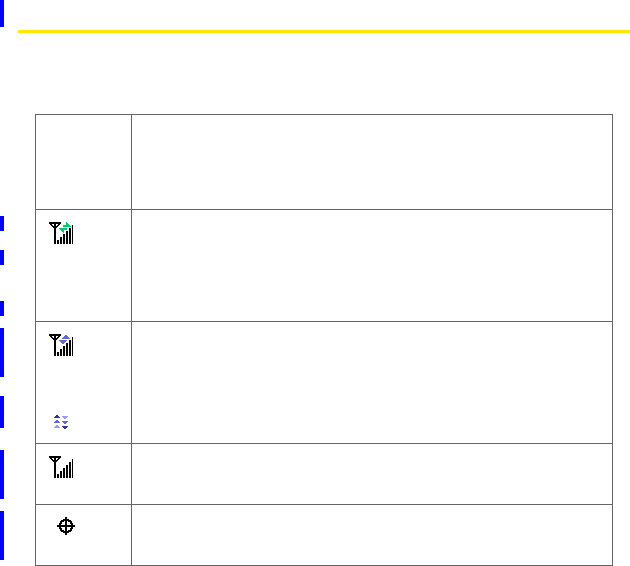
100 Section 2B: Using Your Device’s Phone Features
Checking Signal Strength and Phone Status
You can monitor the status of your device’s signal strength and several other
items, using icons in the title bar of the Phone application.
Sprint Your phone is on and you’re inside the Nationwide Sprint PCS Network. If
you are outside a coverage area, No Service or Roaming appears instead.
No Service means that there is no coverage at all and Roaming means
that another wireless service provider’s network is available. When
you turn off your phone, Phone Off appears.
Your phone is on and is connected to the Sprint PCS Vision® (1xRTT) data
network. When the arrows are green, data is being transferred (for
example, when you are opening a Web page) and you cannot receive
calls. When the arrows are gray, you are connected to the network but
data is not currently being transferred (for example, when you are
viewing a Web page that is completely open), and you can receive calls.
or
Your phone is on and is connected to the high-speed Sprint Power Vision
data network. When the triangles are blue, data is being transferred (for
example, when you are opening a Web page); when the triangles are gray,
you are connected to the network but data is not currently being
transferred (for example, when you are viewing a Web page that is
completely open). In either state, you can receive incoming calls.
Your phone is on and you are within range of a Sprint PCS Vision or high-
speed Sprint Power Vision data network, but you do not have an active
data connection and can receive calls.
The Location ON option has been selected. The icon appears with a red
slash when the 911 only option has been selected. See “Setting Phone
Preferences” on page 95 for information.
FINAL DRAFT Palm, Inc. Confidential
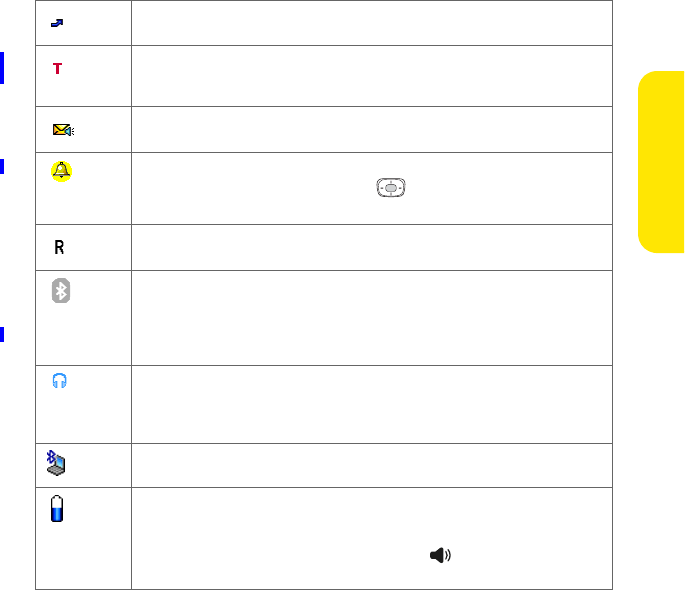
Section 2B: Using Your Device’s Phone Features 101
Phone Features
Appears when call forwarding is active.
TTY/TDD mode is active. Use this mode to communicate by telephone if
you are deaf or hard of hearing or if you have speech or language
disabilities.
You have new voicemail messages. You can select this icon to retrieve
your messages.
You have a new alert, such as a Calendar alarm or a new text message. To
view the alert, press and hold Center or select the icon. See
“Viewing and Using the Alert Screen” on page 103 for more information.
Roaming is active.
Bluetooth® wireless technology is off. The icon appears in blue when
Bluetooth wireless technology is on and appears in reverse blue when
your device is communicating with other devices using Bluetooth
wireless technology. To quickly access the Bluetooth Preferences screen,
tap the Bluetooth icon.
Your device is connected to a headset that is enabled with Bluetooth
wireless technology. This icon replaces the Bluetooth icon; it appears in
light blue when you are not on an active call and in dark blue when you
are on an active call.
Replaces the Bluetooth icon when a dial-up networking connection using
Bluetooth wireless technology is active.
Your battery is partially drained. When the battery drains to 20% of its
capacity, the icon changes from blue to red. At 10% of its capacity, you
begin to receive warning messages, and at 5% of its capacity, the device
beeps (if the Ringer switch is in the Sound On position) and the icon
changes from red to clear.
FINAL DRAFT Palm, Inc. Confidential
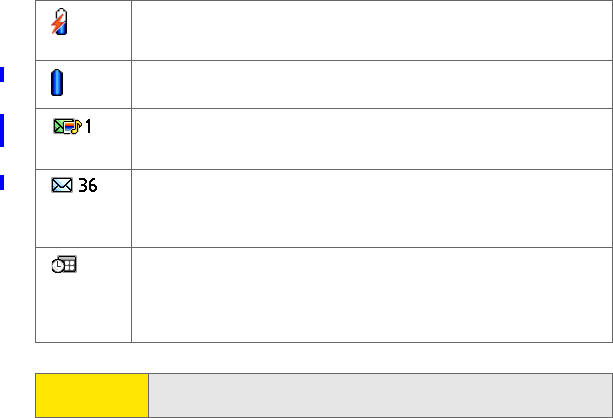
102 Section 2B: Using Your Device’s Phone Features
Your battery is charging. The lightning bolt turns from red to green when
the battery is fully charged and your device remains connected to the AC
charger.
Your battery is fully charged, and your device is not connected to the
charger.
You have new text or Picture Mail messages. The number next to the icon
indicates the number of unread messages in your Inbox. Select this icon
to view your messages.
You have new email messages. The number next to the icon indicates the
number of unread messages in your Inbox; if you have set up multiple
email accounts on your device, the number reflects the account that was
most recently accessed. Select this icon to view your messages.
Displays the current (or next) event from the Calendar application. If you
have an event conflict during the current time period, a red bar appears
next to the event description. To jump to the current event in the
Calendar application, select the Calendar status line (see “Displaying Your
Calendar” on page 224 for details).
Tip: To display the remaining battery power, tap the battery icon at the top of
the screen.
FINAL DRAFT Palm, Inc. Confidential
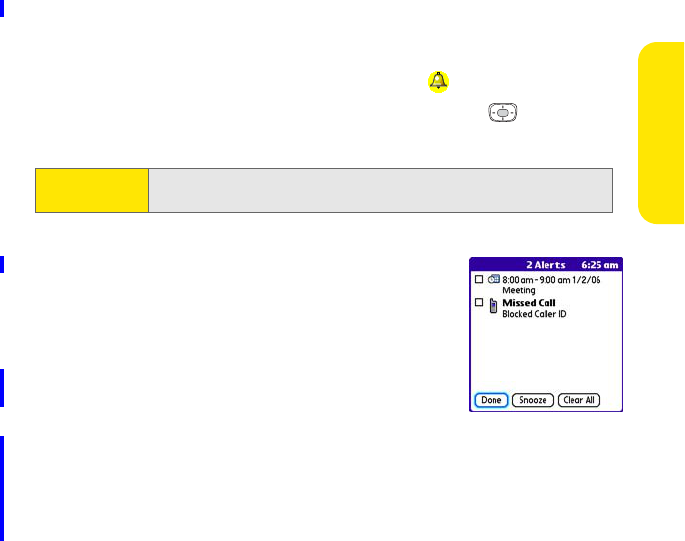
Section 2B: Using Your Device’s Phone Features 103
Phone Features
Viewing and Using the Alert Screen
The Alert screen on your device shows information about incoming items such as
new email messages and Calendar events. The Alert screen also notifies you if you
miss a phone call.
ᮣTo view the Alert screen, select the blinking bell when it appears in the
upper-left corner of any screen, or press and hold Center when the
blinking bell appears.
You can do any of the following:
ⅷCheck the box to clear an alert from the list.
ⅷSelect the alert to open the corresponding application
and view the alert item (message, event, missed call,
and so on).
ⅷSelect Done to close the Alert screen and return to
whatever you were doing on your device before you
opened the Alert screen. The bell continues to blink in
the upper-left corner of the screen.
ⅷSelect Snooze to temporarily close the Alert screen and return to whatever you
were doing on your device before you opened the Alert screen. The screen
reappears every five minutes until you select one of the other options.
ⅷSelect Clear All to delete all alerts on the Alert screen.
Note: Your device’s indicator light blinks green when you have a new alert. This
way, you can be aware of new alerts even if the screen is off.
FINAL DRAFT Palm, Inc. Confidential
104 Section 2B: Using Your Device’s Phone Features
FINAL DRAFT Palm, Inc. Confidential
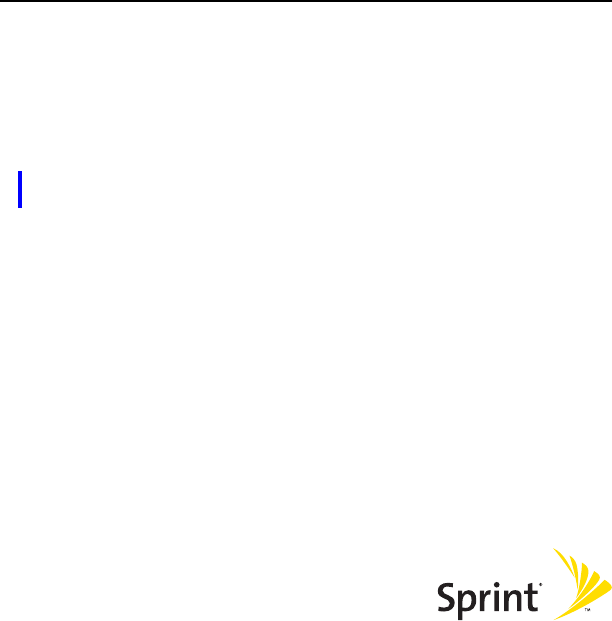
Section 3
Using Sprint PCS Vision® and Other
Wireless Connections
FINAL DRAFT Palm, Inc. Confidential
106
FINAL DRAFT Palm, Inc. Confidential

Section 3A: Sprint PCS Vision®—The Basics 107
Sprint PCS Vision
Section 3A
Sprint PCS Vision®—The Basics
In This Section
ࡗGetting Started With Sprint PCS Vision
ࡗSprint Power Vision Features
ࡗAccessing Sprint PCS Vision
FINAL DRAFT Palm, Inc. Confidential
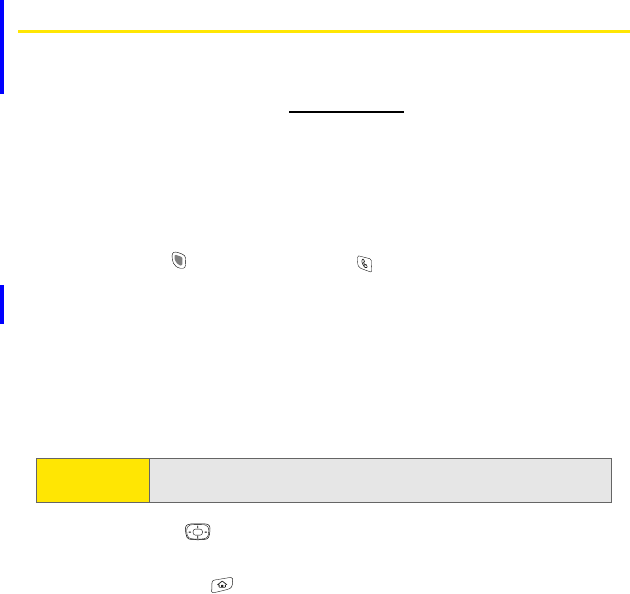
108 Section 3A: Sprint PCS Vision®—The Basics
Getting Started With Sprint PCS Vision
Sprint PCS Vision provides wireless access to the Internet anywhere on the
Nationwide Sprint PCS® Network. To sign up for Sprint PCS Vision services or to
access complete instructions, visit www.sprint.com. For information on charges
associated with features that use a Sprint PCS Vision connection, refer to your
Sprint PCS Service Plan.
Enabling Sprint PCS Vision
1. Make sure your device’s phone is turned on, as described in “Turning Your
Device’s Phone On and Off” on page 55.
2. Press Option , and then press Phone .
3. When the Connect to the Internet dialog box appears, select Yes to open your
device’s Web browser and make a Sprint PCS Vision connection.
ⅢIf you have not already done so, select Now when the Preparing Vision
Services dialog box appears. This initiates a one-time process to
configure your Sprint PCS Vision services. At the end of this two-minute
process, your device connects to the Sprint PCS Vision home page.
ⅢIf you want to cancel the connection, select No.
4. Use the 5-way to scroll around and select from a variety of online
services.
5. Go to Applications to exit the browser and end your session.
Tip: To bypass the Connect to the Internet dialog box in the future, check the
Don’t ask me again box.
FINAL DRAFT Palm, Inc. Confidential
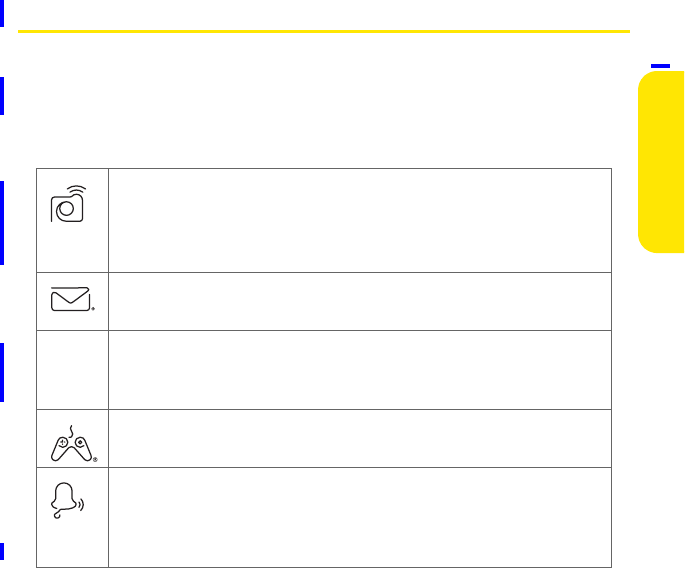
Section 3A: Sprint PCS Vision®—The Basics 109
Sprint PCS Vision
Sprint Power Vision Features
With Sprint PCS Vision services, you have access to additional features, better
performance, faster Web connections, and a wider variety of online services.
Features such as Web access, graphically enriched games, and sending/receiving
digital images are available on your Treo™ 700P smart device through the
Nationwide Sprint PCS Network.
Sprint PCS® Picture Mail
Instantly shoot, share, and print sharp, high-resolution digital
pictures, and take and send short video clips with your device.
(Camera devices only.)
Messaging
Send and receive email, text, and multimedia messages, or chat.
SprintTVSM
Watch live Mobile Digital TV (MDTV) on the go with full-motion
video and vivid sound.
Games
Play exciting games with full-color graphics, sound, and vibration.
Ringers
Personalize your Treo 700P smart device by downloading ringtones.
You can use Sound preferences to assign these tones to different
applications and to assign a tone to a specific contact.
FINAL DRAFT Palm, Inc. Confidential

110 Section 3A: Sprint PCS Vision®—The Basics
Screen Savers
Download unique images to use as wallpaper, or make it easy to
tell who’s calling by assigning specific images to entries in your
contacts list.
Web
Experience full-color graphic versions of popular Web sites.
On Demand
Set and then receive customized, up-to-date information on sports,
weather, news, money, and more, on demand—the way you want it.
Sprint PCS Business ConnectionSM
Obtain secure, real-time access to your Microsoft Outlook or Lotus
Notes company email, calendar, business directory, and personal
contacts.
FINAL DRAFT Palm, Inc. Confidential

Section 3A: Sprint PCS Vision®—The Basics 111
Sprint PCS Vision
Accessing Sprint PCS Vision
Once your device is activated, you are signed in and ready to connect to
Sprint PCS Vision services at any time.
Sprint PCS Vision User Name
Your Sprint PCS Vision User Name is automatically assigned to you. Your user
name, which resembles an email address (for example, name@sprint.com), is
used with Sprint PCS Mail and Messaging services. Remember, with Sprint PCS
Business Connection, you can use virtually any email address (see “Sprint PCS
Business ConnectionSM Personal Edition” on page 142). Your Sprint PCS Vision User
Name is simply an additional address that identifies your Sprint PCS Account.
When your device is enabled with Sprint PCS Vision services, your user name
automatically appears on the Phone Info screen.
To find your user name:
1. Press Phone .
2. Open the menus .
3. Select Options, and then select Phone Info.
FINAL DRAFT Palm, Inc. Confidential

112 Section 3A: Sprint PCS Vision®—The Basics
Sprint PCS Vision Symbols on Your Screen
When you are connected to Sprint PCS Vision services, a data connection icon
appears at the top of the Main view in the Phone application. See “Checking
Signal Strength and Phone Status” on page 100 for a description of the various
data connection icons.
Sprint PCS Vision Billing Information
See your service plan for details on Sprint PCS Vision billing.
FINAL DRAFT Palm, Inc. Confidential

Section 3B: Sprint Power Vision 113
Sprint Power Vision
Section 3B
Sprint Power VisionSM
In This Section
ࡗGetting to Know Sprint Power Vision
ࡗPersonalizing Your Service With On Demand
ࡗUsing Your Device’s Phone as a Modem
FINAL DRAFT Palm, Inc. Confidential
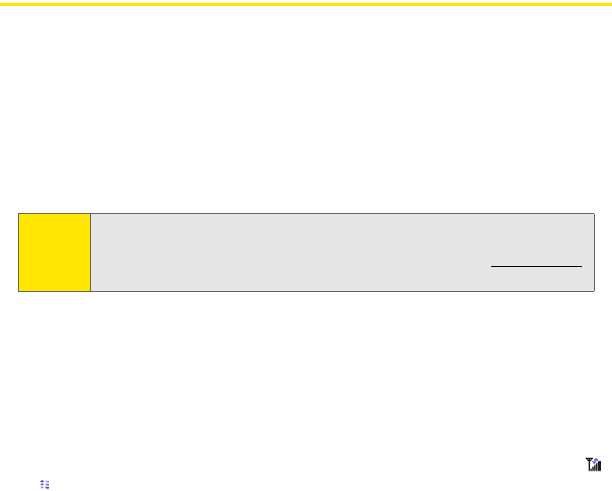
114 Section 3B: Sprint Power Vision
Getting to Know Sprint Power Vision
Sprint Power Vision combines unmatched visual and sound clarity with
broadband-like speeds on your wireless phone. Utilizing the fastest commercially
available wireless network technology (1xEV-DO) and leveraging continued
investment in handset and application development, Sprint Power Vision offers
the ultimate in wireless entertainment, real imaging solutions, instant
communication, and personalized information at broadband-like speeds. Your
Treo 700P smart device is equipped with the latest in multimedia, imaging, and
processing technology, and offers exclusive services, such as On Demand.
Enabling Sprint Power Vision
Since Sprint Power Vision is an enhancement to your device’s Sprint PCS Vision®
capabilities, you don’t need to take any extra action to make Sprint Power Vision
available. As long as your device’s Sprint PCS Vision setting is enabled (see
“Enabling Sprint PCS Vision” on page 108), your device is ready to access Sprint
Power Vision services where available.
When your device has a Sprint Power Vision connection, the status indicator (
or ) is displayed on the screen. (For details, see “Checking Signal Strength and
Phone Status” on page 100.)
Note: The Treo 700P smart device’s data services work anywhere on the Nationwide
Sprint PCS® Network. These services perform at enhanced speeds with
improved quality in areas with high-speed data coverage. Go to www.sprint.com
or see our coverage map for details and more information.
FINAL DRAFT Palm, Inc. Confidential
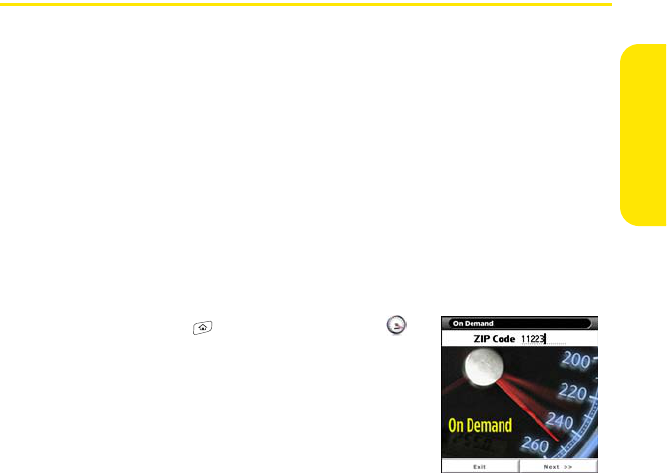
Section 3B: Sprint Power Vision 115
Sprint Power Vision
Personalizing Your Service With On Demand
With Sprint Power Vision’s exclusive On Demand feature, you can personalize
your device’s data services to suit your needs. The On Demand feature makes it
easier than ever to retrieve the most popular Web information and categories
instantly. On Demand uses the ZIP code you provide to customize the content you
receive, so you can get the information you want, when you want it.
On Demand acts like a computer browser’s customized home page, displaying a
variety of top categories such as News, Sports, Weather, Money, Movies, and
more. This information is updated throughout the day, so you’ll always be up-to-
date. In addition to presenting a number of fixed categories, On Demand also
offers optional categories (for an additional monthly charge) that allow faster
access to even more information.
Initializing Your On Demand Service
1. Go to Applications and select On Demand .
2. Enter your preferred ZIP code and select Next.
(The On Demand service will customize itself to
your selected location, and the On Demand menu
screen will be displayed.)
FINAL DRAFT Palm, Inc. Confidential

116 Section 3B: Sprint Power Vision
Accessing On Demand Information
Finding the information you’re looking for with On Demand is as easy as
navigating a Web browser on your computer. (The following examples illustrate
how to access News and Movies information.)
To Access News Information Using On Demand:
1. Go to Applications and select On Demand .
(The On Demand menu screen will be displayed.)
2. From the On Demand menu screen, highlight Late
Breaking News & Photos, and then press Center
.
3. Depending on which category you select, you
will see a menu with additional options (for this
example, you would be able to select from such
subcategories as “Top Stories,” “USA News,” “World News,” and “Politics”).
4. Select a subcategory, and then highlight an article you would like to view
and press Center . (The article will be displayed.)
5. Navigate the content as follows:
ⅢPress Up or Down . to scroll through the article.
ⅢIf there is a link to a related article or picture, press Left to select the
link.
ⅢPress Right to open menus that allow you to return to the main menu
or select other navigation options.
FINAL DRAFT Palm, Inc. Confidential

Section 3B: Sprint Power Vision 117
Sprint Power Vision
To Access Movies Information Using On Demand:
1. Go to Applications and select On Demand . (The On Demand menu
screen will be displayed.)
2. From the On Demand menu screen, highlight Movies and press Center .
(A list of current movie titles will be displayed.)
3. Highlight a movie title and and press Center .
4. From the Movie Title display, select an option and follow the onscreen
instructions. Options available may include:
ⅢDate to select a date for the movie.
ⅢDetails to view the movie’s details, which may include cast, running
time, plot synopsis, MPAA rating, reviews, and so on.
Ⅲ<theater listing> to view the movie’s showtimes at a number of selected
movie theaters in your area. Follow the onscreen instructions to
purchase will-call tickets (may not be available for all theaters or for all
showtimes).
Additional fixed On Demand categories such as Money (which features a
customizable stock ticker [delayed 20 minutes]), Weather, and Sports (which
allows you to select your top teams), along with optional categories such as Maps
and TV Guide, bring the information you want right to your screen – all without
having to go through a traditional Web search.
FINAL DRAFT Palm, Inc. Confidential

118 Section 3B: Sprint Power Vision
Using Your Device’s Phone as a Modem
Your device’s data capabilities enable you to use your device’s phone as a modem
for your laptop computer anywhere on the Sprint advanced wireless high-speed
data network. You'll be able to send and receive email, browse the Internet, and
access your company’s network anywhere on the Nationwide Sprint PCS
Network.
Setting Up a Data Connection With Your Computer
In order to use your phone as a modem, you’ll first need to load the Sprint PCS®
Connection Manager software on your computer, and then use the sync cable to
connect your device to your computer.
To set up your phone-to-computer data connection:
1. Insert the Palm Software Installation CD that came with your device into
your computer’s CD drive and select the link to download and install the
Sprint PCS Connection Manager software and drivers.
2. Once the software has been fully installed, connect your device to your
computer using the sync cable. (Your computer will detect the connection
and an icon will be displayed in the taskbar in the lower-right corner of your
computer screen.)
3. Launch the Sprint PCS Connection Manager software, select a profile, and
click Connect.
Note: To use this service, you are required to sign up on a Sprint Power Vision with
Phone as Modem plan. Go to www.sprint.com or visit a Sprint Store for Phone as
Modem plan details and more information.
FINAL DRAFT Palm, Inc. Confidential

Section 3B: Sprint Power Vision 119
Sprint Power Vision
4. Once the connection is established, launch an Internet session, check your
email, or do anything else you would do using a traditional Internet
connection.
5. When you’re ready to terminate the Internet connection, double-click the
Sprint PCS Connection Manager icon in the system tray, and then click
Disconnect to end the session.
Note: While your data connection is active, you can receive incoming calls; however,
placing an outgoing call during a data session terminates the data connection.
Sprint PCS Vision services are available on the Nationwide Sprint PCS Network.
Sprint Power Vision services work anywhere on the Nationwide Sprint PCS
Network, but broadband-like download speeds are available only in areas with
high-speed data coverage.
FINAL DRAFT Palm, Inc. Confidential
120 Section 3B: Sprint Power Vision
FINAL DRAFT Palm, Inc. Confidential

Section 3C: Using Email 121
Email
Section 3C
Using Email
In This Section
ࡗWhat Email Applications Can I Use on My Smart Device?
ࡗThe VersaMail Application
ࡗSprint PCS Business ConnectionSM Personal Edition
ࡗUsing GoodLink™ Applications Software
FINAL DRAFT Palm, Inc. Confidential
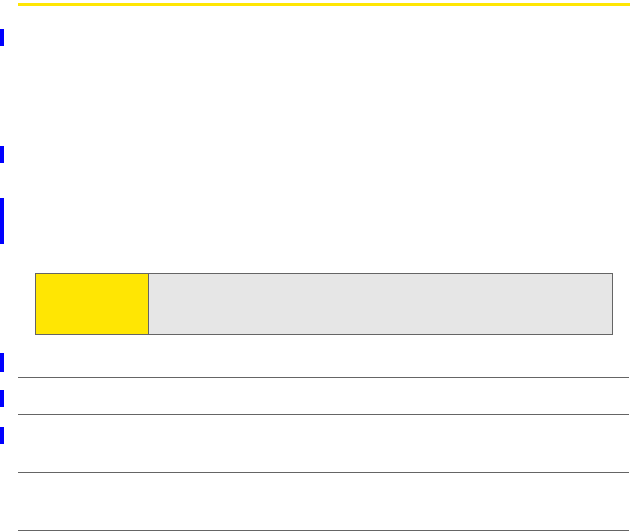
122 Section 3C: Using Email
What Email Applications Can I Use on My Smart Device?
If you’ve activated Sprint PCS Vision®, you’re ready to set up an email application
on your Treo™ 700P smart device. You can use the email application with your
Sprint email account, as well as with other email accounts, such as Yahoo! or
Earthlink. You can also use the email application with a corporate account.
Your device includes three email application options:
ⅷThe VersaMail® application
ⅷSprint PCS Business ConnectionSM Personal Edition
ⅷGoodLink™
You can also access Web-based email from your device’s Web browser.
Which Application Should I Use?
0
Note: An email application is not an email provider. It works with an account
from a provider—your Sprint account, for example—or a corporate
account to transfer messages to your device.
I want to … Use this application …
Check free Web mail, such as Hotmail, Gmail, or
Yahoo!
Web browser
Check fee-based Internet mail, such as Yahoo! Mail
Plus
VersaMail
FINAL DRAFT Palm, Inc. Confidential

Section 3C: Using Email 123
Email
I want to … Use this application …
Sync my email and organizer information with my
company’s Exchange server
VersaMail, Business
Connection, GoodLink
Sync my email with my company’s Domino server VersaMail, Business
Connection
Access email from one to three email accounts VersaMail, Business
Connection
Access email from four to eight email accounts VersaMail
Use the Advanced Encryption Standard (AES) while
sending and receiving messages
GoodLink
FINAL DRAFT Palm, Inc. Confidential
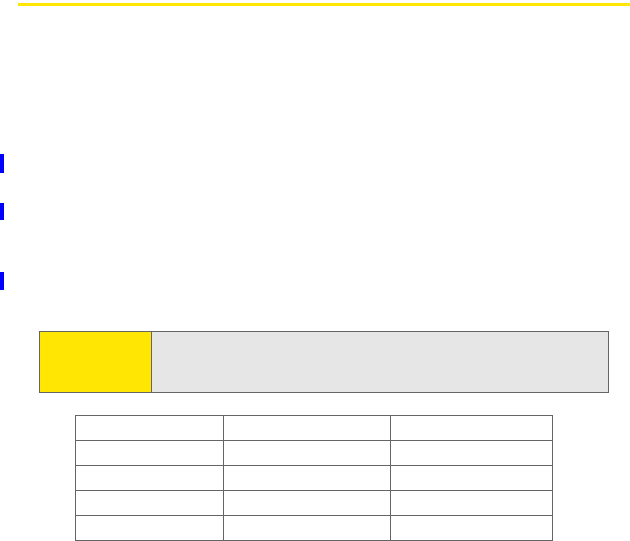
124 Section 3C: Using Email
The VersaMail Application
Before you can use VersaMail, you need to enter your email account settings. If
you have multiple email accounts, you must enter settings for each account.
After you enter your email account settings, see the User Guide for the VersaMail
Application on the Palm Software Installation CD for information on sending and
receiving messages and customizing your VersaMail settings.
How Do I Get Started?
1. If you’re entering settings for an email account on a Microsoft Exchange
ActiveSync® server, a Lotus Notes server, or a Microsoft MAPI server, see the
User Guide for the VersaMail Application on the Palm Software Installation
CD for setup steps.
2. If your email provider is listed in the following table, skip to “Setting Up
VersaMail to Work With Common Providers” on page 125.
0
Tip: Your email provider is the service you use to send and receive email.
Your email provider’s name appears between the @ symbol and the dot
symbol in your email address.
AOL Comcast RCN
Apple.Mac CompuServe SBC/PacBell
AT&T Global Covad SBC/Prodigy
AT&T Worldnet EarthLink Speakeasy
Bell South Gmail Verizon DSL
FINAL DRAFT Palm, Inc. Confidential
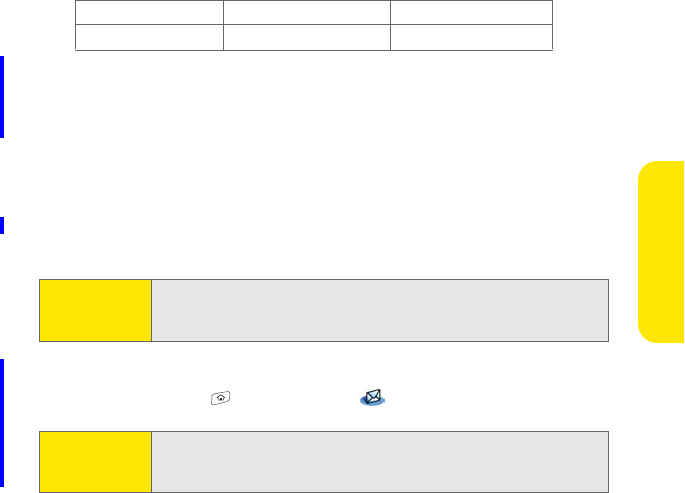
Section 3C: Using Email 125
Email
3. If your email provider’s name is not listed, you need to obtain the following
information from your system administrator or ISP, and then skip to
“Setting Up VersaMail to Work With Other Providers” on page 126.
ⅢMail protocol: POP or IMAP
ⅢIncoming and outgoing mail server names, such as mail.myisp.com
ⅢIncoming and outgoing mail server port numbers, such as 110
(incoming POP), 143 (incoming IMAP), or 25 (outgoing POP or IMAP)
Ⅲ(If necessary) Security settings: APOP, ESMTP, SSL
Setting Up VersaMail to Work With Common Providers
1. Go to Applications and select Email .
Cablevision Mail.com Yahoo!
Charter NetZero
Note: The correct protocol, server, and security settings are required for
VersaMail to be able to send and receive email for your account. Your
email provider can easily provide these settings.
Tip: The first time you set up VersaMail, you are asked if you want to
continue with account setup after you open the application. Select
Continue and go to step 3.
FINAL DRAFT Palm, Inc. Confidential
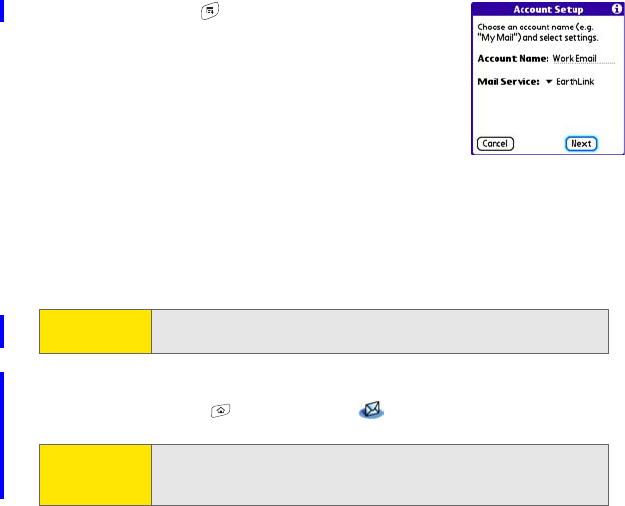
126 Section 3C: Using Email
2. Open the menus , select Accounts, select Account
Setup, and then select New.
3. In the Account Name field, enter a descriptive name,
such as Work Email.
4. Select the Mail Service pick list, and then select your
email provider, such as Earthlink. Select Next.
5. Enter the username for your email account. Your
username appears before the @ symbol in your
email address.
6. Select the Password box, enter your email account password, select OK, and
then select Next.
7. Select Next, and then select Done.
Setting Up VersaMail to Work With Other Providers
1. Go to Applications and select Email .
Tip: To set more options for incoming and outgoing messages, select
Advanced on the Account setup complete screen.
Tip: The first time you set up VersaMail, you are asked if you want to
continue with account setup after you open the application. Select
Continue and go to step 3.
FINAL DRAFT Palm, Inc. Confidential
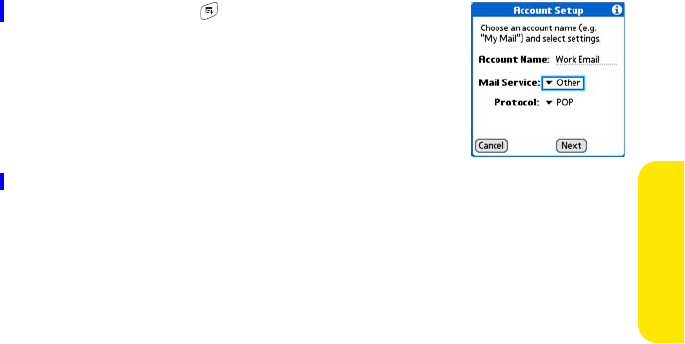
Section 3C: Using Email 127
Email
2. Open the menus , select Accounts, select Account
Setup, and then select New.
3. In the Account Name field, enter a descriptive
name, such as Work Email.
4. Select the Mail Service pick list, and then select
Other.
5. Select the Protocol pick list, and then select POP or
IMAP (based on the information you obtained from
your system administrator or ISP). Select Next.
6. Enter the username for your email account. Your username appears before
the @ symbol in your email address.
7. Select the Password box, enter your email account password, select OK, and
then select Next.
8. Enter your email address and the names of the incoming and outgoing mail
servers, and then select Next.
9. If your system administrator or ISP provided port numbers or security
settings, select Advanced, and then enter those settings.
10. Select Done.
FINAL DRAFT Palm, Inc. Confidential
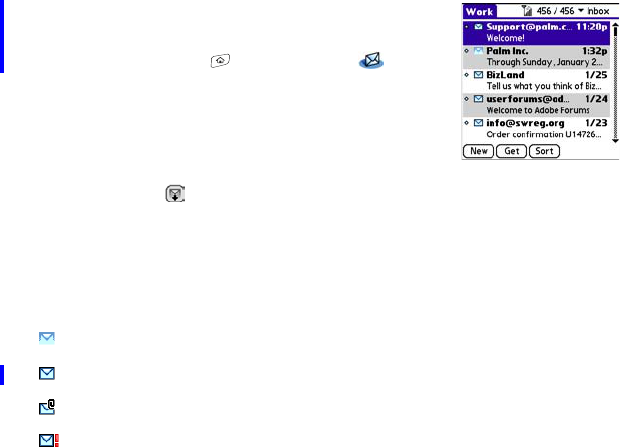
128 Section 3C: Using Email
Receiving and Viewing Messages
1. Make sure your phone is turned on (see “Turning
Your Device’s Phone On and Off” on page 55).
2. Go to Applications and select Email .
3. From any mailbox, select Get or Get & Send.
4. From the Inbox, select the message you want
to view.
5. If a large incoming message is truncated,
select More .
6. Select Done.
Managing Your Messages
The status icons that appear next to each message in your Inbox indicate the
following:
Only the subject header information is downloaded.
Part or all of the message text is downloaded.
The message includes an attachment.
This message is high priority.
You can rearrange the VersaMail list to make it easier to find and view messages.
ⅷIn the Inbox, select Sort, and then select one of the following: By Subject, By
Sender, By Size, or By Date.
FINAL DRAFT Palm, Inc. Confidential
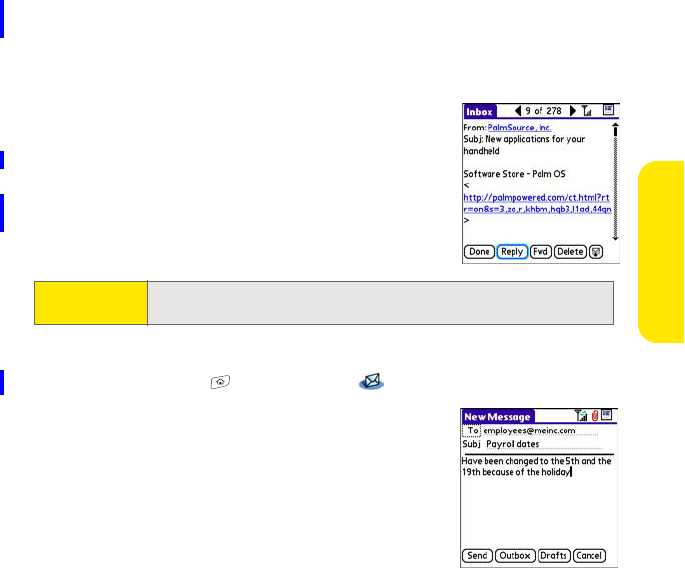
Section 3C: Using Email 129
Email
ⅷTo quickly switch between folders (for example, the Inbox folder and the Sent
folder), select the folder pick list at the top of the screen and select the desired
folder.
Replying to Messages
1. From the Inbox or another folder, open the
message to which you want to respond.
2. From Message view, select Reply. (Select whether
to reply to just the sender or reply to both the
sender and all other addressees on the
message.)
3. Enter your reply, and then select Send.
Creating and Sending Messages
1. Go to Applications and select Email .
2. From the Inbox, select New.
3. Begin entering the addressee’s email address,
first name, or last name. (If the information
matches one or more entries in Contacts,
VersaMail displays the matching contacts. To
accept a suggestion, select the correct contact.
To send to a different address, keep entering the
email address or name.)
Tip: When you respond to messages, you can select whether to include the
original text (see “Setting Email Preferences” on page 136).
FINAL DRAFT Palm, Inc. Confidential

130 Section 3C: Using Email
4. Enter the subject and message text. (To move between fields, press Up or
Down .)
5. Select one of the following buttons:
ⅢSend connects and sends all messages immediately. (If you select Send
and the message cannot be sent for any reason, the message is stored in
your Outbox. VersaMail makes up to five attempts to automatically
send the message; if automatic send is not successful, an alert message
appears and you must try to manually send the message again.)
ⅢOutbox puts the message in the Outbox to send later.
ⅢDrafts saves the message so that you can continue working on it at
another time.
Tip: To send a copy or blind copy, select Cc or Bcc, select those lines, and enter
the address(es) in those fields. See “Setting Email Preferences” on
page 136 for details on displaying the Bcc field. For multiple recipients in
any field, enter a semicolon and then a space before entering the next
recipient name or address.
Tip: You can mark outgoing messages as high priority. Open the Options
menu and select Set Priority To High.
Tip: If you are composing a message and need to switch to another
application—for example, to answer a phone call—when you return to
the VersaMail application, you are returned to the new message screen.
FINAL DRAFT Palm, Inc. Confidential
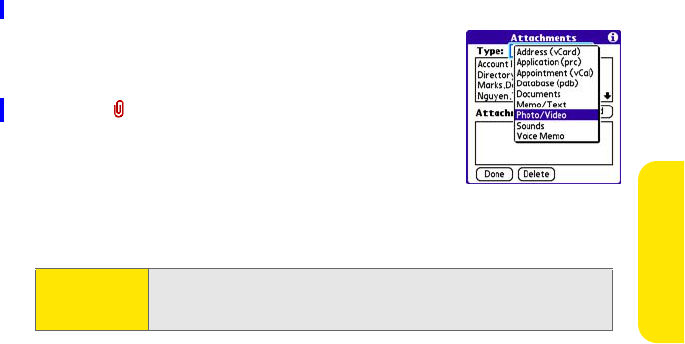
Section 3C: Using Email 131
Email
Attaching Pictures and Videos
1. Create the message to which you want to attach
the picture or video.
2. On the New Message screen, select the paper clip
icon in the upper-right corner of the screen.
3. Select Photo/Video from the Type pick list.
4. On the Select Media screen, select the Album pick
list to go to the album containing the picture or
video you want, and then check the box to the left of the picture or video.
5. Select Done.
Tip: Repeat steps 3 and 4 to attach more than one picture or video to a
message. To remove an attachment, select the file in the Attachments
box, and then select Delete.
FINAL DRAFT Palm, Inc. Confidential

132 Section 3C: Using Email
Attaching Voice Memos
1. Create the message to which you want to attach the voice memo.
2. On the New Message screen, select the paper clip icon in the upper-right
corner of the screen.
3. Select Voice Memo or Voice Memo (wav) from the Type pick list.
4. Select the voice memo you want, and then select OK. If you selected Voice
Memo (wav), select the voice memo you want in the Type box, and then
select Add.
5. Select Done.
Attaching Word, Excel, and PowerPoint Files
1. Create the message to which you want to attach the item.
2. On the New Message screen, select the paper clip icon in the upper-right
corner of the screen.
3. Select Documents from the Type pick list.
4. Select the file you want on the Documents screen.
5. Select Done.
Tip: Repeat steps 3 and 4 to attach more than one file to a message. To
remove an attachment, select the file in the Attachments box, and then
select Delete.
FINAL DRAFT Palm, Inc. Confidential
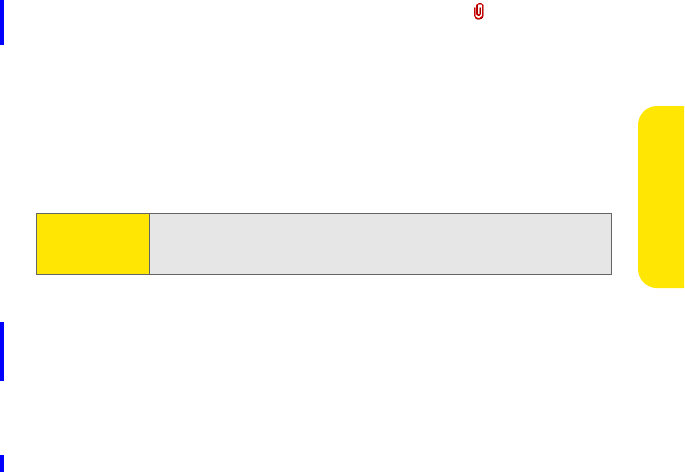
Section 3C: Using Email 133
Email
Attaching Other Types of Files
1. Create the message to which you want to attach the item.
2. On the New Message screen, select the paper clip icon in the upper-right
corner of the screen.
3. Select the type of file to attach—for example, Address, Appointment, or
Memo/Text—from the Type pick list. To attach a ringtone, select Sounds.
4. Select the file you want from the list in the Type box, and then select Add. If
you selected Sounds, select the ringtone from the Manage Sound list, and
then select Insert.
5. Select Done.
Viewing Attachments
You can open a number of attachment types (for example, Microsoft Word, Excel,
and PowerPoint files; PDF files; sound files; and photos) with the built-in
software on your device.
1. From any folder, open the message with the attachment you want to view.
(Messages with downloaded attachments are indicated by a paper clip icon
to the left of the message icon.)
Tip: Repeat steps 2 and 3 to attach more than one file to a message. To
remove an attachment, select the file in the Attachments box, and then
select Delete.
FINAL DRAFT Palm, Inc. Confidential
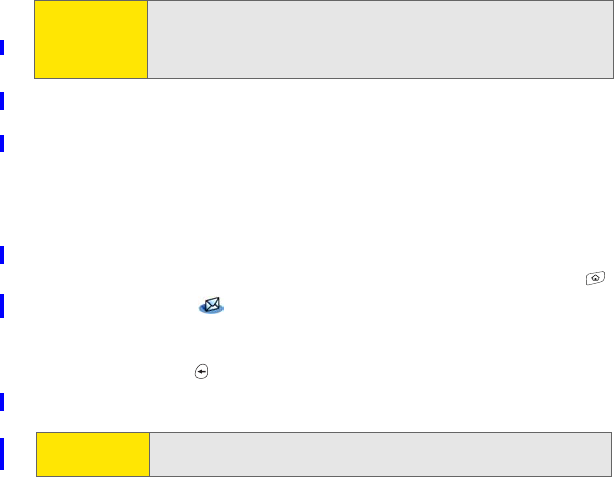
134 Section 3C: Using Email
2. Select the attachment name to view it in the default viewer on your device.
–or–
Select the folder icon to the left of the attachment name to open a menu of
tasks you can do with the attachment, including View, Install, or Unzip,
depending on the attachment file type; Save to save the attachment to your
device or to an expansion card; or Select Viewer to select the application you
want to use to view the attachment.
3. When you have finished with the attachment, select Done to return to the
Attachments dialog box. (If there is no Done button, go to Applications
and select Email to return to the Inbox of the account you were using.)
Deleting a Single Message in Message View
1. Press Backspace to delete a message while it is still open.
2. Select OK to confirm the deletion.
Note: If an attachment is not downloaded because it is larger than your
maximum message size, the paper clip icon does not appear, and the
attachment is not displayed at the bottom of the message screen. Select
More to download and display any attachments.
Tip: To delete a single message, you can also highlight it, press Right on the
5-way, and then select Delete.
FINAL DRAFT Palm, Inc. Confidential
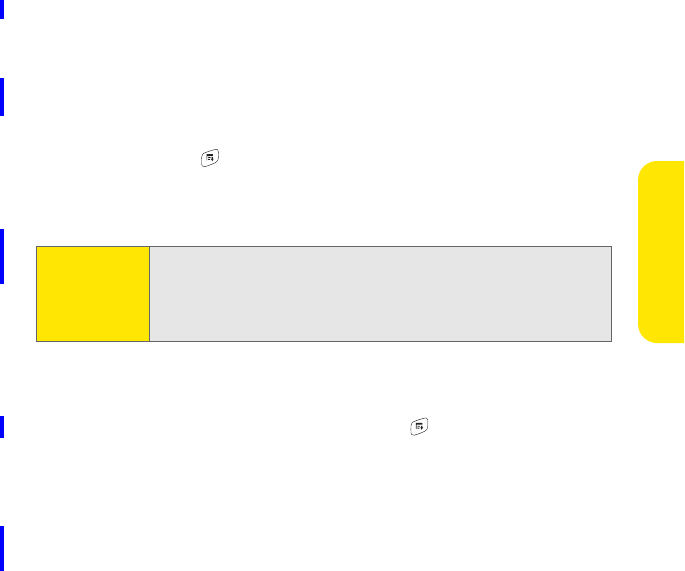
Section 3C: Using Email 135
Email
Deleting Messages From the Inbox
When you delete a message from the Inbox, it moves to the Trash folder.
1. Select the bullet next to the icon of each message that you want to delete.
To select adjacent messages, drag the stylus so that it touches the bullet to
the left of each message. Lift the stylus and drag it again to select more
adjacent messages.
2. Open the menus .
3. Select Delete on the Message menu.
4. If a confirmation message appears, select OK to confirm deletion.
Deleting Messages by Date
You can quickly delete a group of messages by selecting a range of dates.
1. From the Inbox or any folder, open the menus .
2. Select Delete Old on the Message menu.
3. Select the folder and a date range for the messages you want to delete.
4. Select OK. (If a confirmation dialog box appears, select OK to confirm
deletion.)
Tip: When you delete a message in Message view, by default you return to
the Inbox. You can change the setting so that you go to the next
message instead. From the Options menu, select Preferences, select
Deletion, and then select Go to Next Message from the After deleting a
message pick list.
FINAL DRAFT Palm, Inc. Confidential
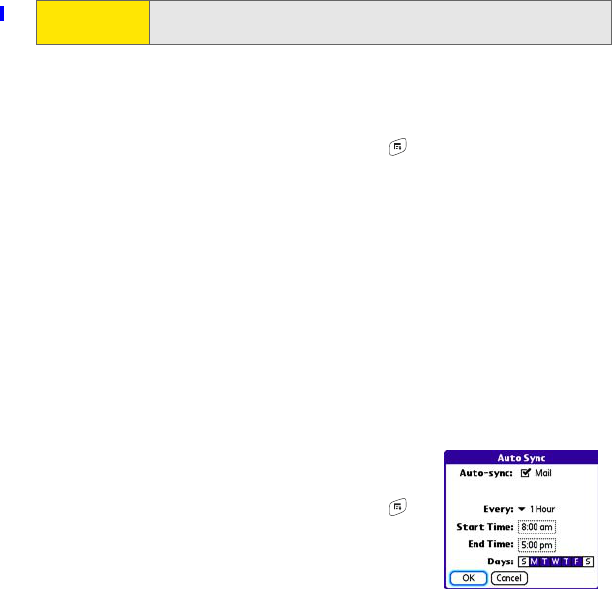
136 Section 3C: Using Email
Switching Between Accounts
You can switch between different email accounts—for example, between your
work and your personal account.
1. From any mailbox screen, open the menus .
2. Select Accounts, and then select an account.
Setting Email Preferences
You can customize the VersaMail settings for each individual email account on
your Treo device. The preferences you set apply only to the email account you are
currently viewing. If you have multiple accounts, configure each account
separately.
You can customize the display of your mailbox screens, how and when to get new
messages, alert sounds, reply options, and more. For complete instructions on
customizing your email settings, see the User Guide for the VersaMail Application
on the Palm Software Installation CD.
Downloading New Email Messages Automatically
You can set up VersaMail to automatically download
new email messages to your device.
1. From any mailbox screen, open the menus .
2. Select Options, and then select Preferences.
3. Select Auto Sync.
Tip: To empty (or purge) the Trash folder, open the Message menu and select
Empty Trash.
FINAL DRAFT Palm, Inc. Confidential

Section 3C: Using Email 137
Email
4. Check the Mail box next to the Auto-sync option.
5. Select the Every pick list and select the time interval, from 5 minutes to 12
hours. (If you set a more frequent interval, you may need to recharge your
device’s battery more often.)
6. Select the Start Time and End Time boxes, and then select the hour, the
minute, and AM or PM to enter the time for the first and last Auto Sync to
take place. Select OK.
7. Select the days you want the schedule to be active. You can choose any
number of days, but you can set up only one schedule for each email
account.
8. Select OK, and then select Get or Get & Send. (Doing this ensures that only
new messages are retrieved during your next Auto Sync retrieval.)
Playing Sounds When New Email Arrives
When new email messages arrive, an alert appears on the Alert screen (see
“Viewing and Using the Alert Screen” on page 103 for information). In addition,
when you schedule Auto Sync for a given account, you can choose a sound—such
as a bird, a phone, or an alarm—to let you know when new email arrives.
1. From any mailbox screen, open the menus .
2. Select Options, and then select Preferences.
3. Select Alerts.
4. Check the Alert me of new mail box.
5. Select the Alert Sound pick list, and then select a sound. The device plays a
brief demo of the sound.
FINAL DRAFT Palm, Inc. Confidential
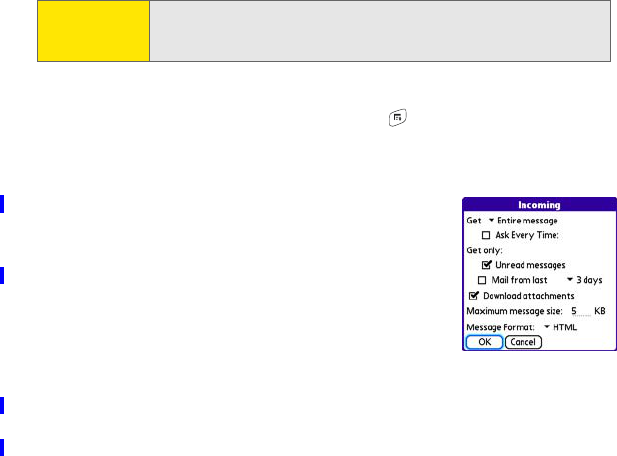
138 Section 3C: Using Email
6. Select OK.
Setting Options for Receiving Messages
1. From any mailbox screen, open the menus .
2. Select Options, and then select Preferences.
3. Select Incoming.
4. Set any of the following preferences:
ⅢGet indicates whether to get message
subjects only or entire messages.
ⅢAsk Every Time indicates whether you want
to see a dialog box for choosing subjects
only or entire messages each time you
retrieve email. If the box is unchecked,
messages are retrieved according to the
option you select in the Get pick list.
ⅢUnread messages downloads only unread mail to your device (IMAP
accounts only). If you don’t choose this option and you select Get & Send,
all your messages on your provider’s mail server are downloaded to your
Inbox, including messages you have already read.
Note: To receive notifications of successful Auto Sync retrievals only, uncheck
the Alert me of failures box. Leave the box checked if you want to receive
notifications of both successful and failed Auto Sync retrievals.
FINAL DRAFT Palm, Inc. Confidential

Section 3C: Using Email 139
Email
ⅢMail from last gets messages sent within the number of days you specify
(default is 3).
ⅢDownload attachments allows files attached to email to be
automatically downloaded to your device. Attachments that exceed the
maximum message size cannot be downloaded.
ⅢMaximum message size sets the maximum size limit, in kilobytes (KB),
for how much of an incoming email message is downloaded. The
maximum size of an incoming message is 5KB by default (that is, the
first 5KB of all incoming email messages is downloaded), but you can
enter any size up to 2,048KB (approximately 2 megabytes, or 2MB),
including attachments.
ⅢMessage Format sets the format in which you retrieve messages. If you
choose HTML, any messages sent in HTML format appear with basic
HTML formatting intact. Other messages appear as plain text. If you
choose Text, all messages appear as plain text, regardless of the format
in which they were sent.
Note: The POP protocol does not support retrieval of unread mail only from
the server. If you have a POP email account, the Unread messages box
does not appear on the Incoming preferences screen, and VersaMail
downloads all messages regardless of whether you have read them.
Note: The maximum message size that you can retrieve is 60KB for the body
text and approximately 5MB of total data for any attachments. To view
a message whose total size is greater than the maximum message size
you select but is less than 5MB, you need to select More on the message
screen to fully download the message.
FINAL DRAFT Palm, Inc. Confidential

140 Section 3C: Using Email
5. Select OK.
Attaching a Signature to a Message
You can attach a personal signature, with information such as your company's
address and its fax and telephone numbers, to the bottom of all messages you
send.
1. From any mailbox screen, open the menus .
2. Select Options, and then select Preferences.
3. Select Signature.
4. Check the Attach Signature box.
5. Enter your signature information, and then select OK.
Note: VersaMail sends all messages as plain text only, with all HTML tags
stripped, even if you are forwarding or replying to a message that was
originally received as HTML.
FINAL DRAFT Palm, Inc. Confidential

Section 3C: Using Email 141
Email
Getting Messages From Your Corporate Microsoft Exchange Server Onto Your
Device
Microsoft Exchange ActiveSync works with the VersaMail, Calendar, and Contacts
applications on your device to directly access corporate groupware information
on a Microsoft Exchange 2003 server. You can wirelessly synchronize information
in these applications on the server from your device without using a desktop
computer.
A Microsoft Exchange ActiveSync account interacts with your desktop software as
follows:
ⅷMicrosoft Outlook: Information in Calendar, Contacts, and VersaMail on your
device syncs with the server; it does not sync directly with Outlook on your
desktop. However, if the server syncs with Outlook on your desktop, any
information you enter in these applications on your device also appears in
Outlook after the next server sync.
ⅷPalm® Desktop software: Information in Calendar, Contacts, and VersaMail on
your device does not sync with and does not appear in Palm® Desktop
software on your computer.
Information in other applications on your device, such as Tasks and Memos,
continues to sync with and appear in the desktop software on your computer
(Outlook or Palm Desktop).
For complete information on using a Microsoft Exchange ActiveSync account, see
the User Guide for the VersaMail Application on the Palm Software Installation CD.
FINAL DRAFT Palm, Inc. Confidential
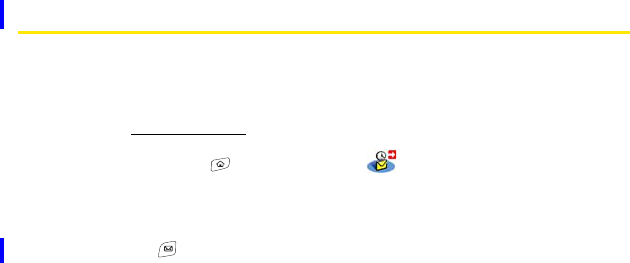
142 Section 3C: Using Email
Sprint PCS Business ConnectionSM Personal Edition
You can install the optional Sprint PCS Business Connection application for secure,
real-time access to your Microsoft Outlook or Lotus Notes company email,
calendar, business directory, and personal contacts. For more information and to
sign up, visit www.sprint.com.
1. Go to Applications and select Get BC .
2. Follow the onscreen instructions to download and install the software.
After you install the Sprint PCS Business Connection application on your device,
press Messaging to open the application.
FINAL DRAFT Palm, Inc. Confidential

Section 3C: Using Email 143
Email
Using GoodLink™ Applications Software
You can install the optional GoodLink Applications software for secure, real-time
access to your Microsoft Outlook email, calendar, contacts, tasks, and notes.
GoodLink Applications software offers real-time push synchronization of email
and personal information; as messages are received on the server, they are
automatically downloaded to your device. The GoodLink Applications software
also offers attachment viewing through the Documents application on your
device and integration with your corporate Global Address List (GAL).
For more information and to sign up, visit www.good.com.
1. Go to Applications and select Get Good .
2. Follow the onscreen instructions to download and install the software.
After you install the GoodLink Applications software on your device, press
Messaging to open the software.
FINAL DRAFT Palm, Inc. Confidential
144 Section 3C: Using Email
FINAL DRAFT Palm, Inc. Confidential

Section 3D: Messaging 145
Messaging
Section 3D
Messaging
In This Section
ࡗCreating and Sending Messages
ࡗReceiving Messages
ࡗUsing Messaging to Chat
ࡗManaging Your Messages
ࡗCustomizing Your Messaging Settings
ࡗUsing Online Services
FINAL DRAFT Palm, Inc. Confidential
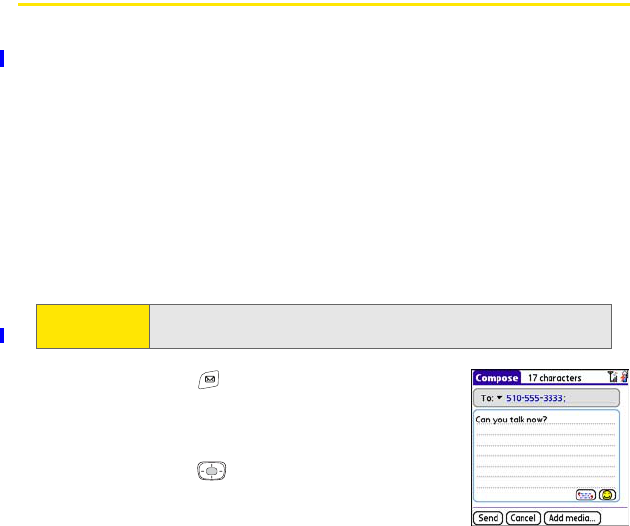
146 Section 3D: Messaging
Creating and Sending Messages
You can exchange brief text messages with other wireless phones that have text
messaging capability. You can also send Sprint PCS® Picture Mail messages
(including images, videos, voice memos, and text) to other users. Both text
messages and Sprint PCS Picture Mail messages can also be sent to email
addresses. Before you use your Treo™ 700P smart device to send or receive
messages, please verify pricing and availability with Sprint.
Before you use Messaging, make sure your phone is turned on, as described in
“Turning Your Device’s Phone On and Off” on page 55.
Creating and Sending a Text Message
You can exchange text messages of up to 160 characters. Messages with more
than 160 characters are automatically split into several messages.
1. Press Messaging .
2. Select New.
3. Select the To field to address the message:
ⅢPress Center . If the recipient’s name
appears in the list of recent addresses, select it
from the list.
Note: If you send a text message to an email address, the email address is
deducted from the 160-character count.
FINAL DRAFT Palm, Inc. Confidential
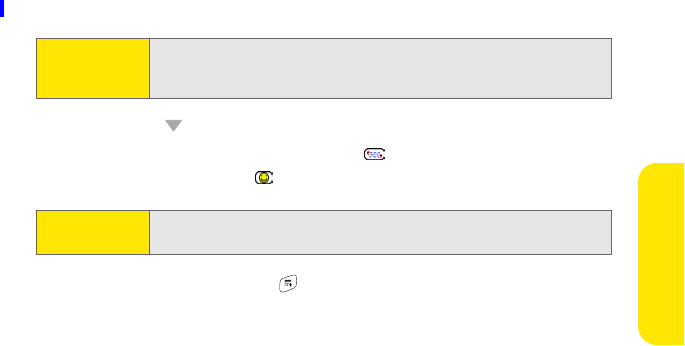
Section 3D: Messaging 147
Messaging
ⅢIf the recipient is in your Contacts list, enter the first initial and last name
(no spaces), and then select the recipient’s phone number or email
address, depending on where you want to send the message.
ⅢIf the recipient’s name isn’t in the list of recent addresses or your
Contacts list, enter the phone number or email address.
4. Press Down to jump to the body of the message.
5. Enter your message or select QuickText to insert predefined phrases. To
insert emoticons, select .
6. (Optional) Open the menus , and then select High Priority or Normal
Priority on the Compose menu to set an urgency level for the message.
7. Select Send.
If you are out of a coverage area or if your device is off, outgoing messages go into
the Outbox folder. When you return to a coverage area, your pending messages
are sent automatically and are transferred to the Sent folder.
Tip: If you see numbers when you expect to see letters (or the other way
around), you need to turn Option Lock on by pressing Option twice or
turn it off by pressing Option once.
Tip: Some symbols can’t be used in text messages. The Messaging
application automatically replaces invalid characters.
FINAL DRAFT Palm, Inc. Confidential

148 Section 3D: Messaging
Creating and Sending a Sprint PCS Picture Mail Message
Sprint PCS Picture Mail messages consist of pictures, videos, text, and sounds.
You can include pictures and videos you captured with the built-in camera (if
included) as well as any of the following items:
ⅷQCELP sound clips as voice memos
ⅷPictures
ⅷVideos
ⅷText messages
ⅷVoice memos
The first time you share a picture or video, you are prompted to establish a
Sprint PCS Picture Mail account and password. Enter a four- to eight-digit,
alphanumeric password and press Center . Once you receive confirmation,
you can continue to send or upload pictures and videos.
1. Press Messaging .
2. Select New.
3. Select the To field to address the message:
ⅢPress Center . If the recipient’s name appears in the list of recent
addresses, select it from the list.
Note: For information about the terms of your Sprint PCS Picture Mail service,
please visit http://pictures.sprintpcs.com/tos.do.
FINAL DRAFT Palm, Inc. Confidential
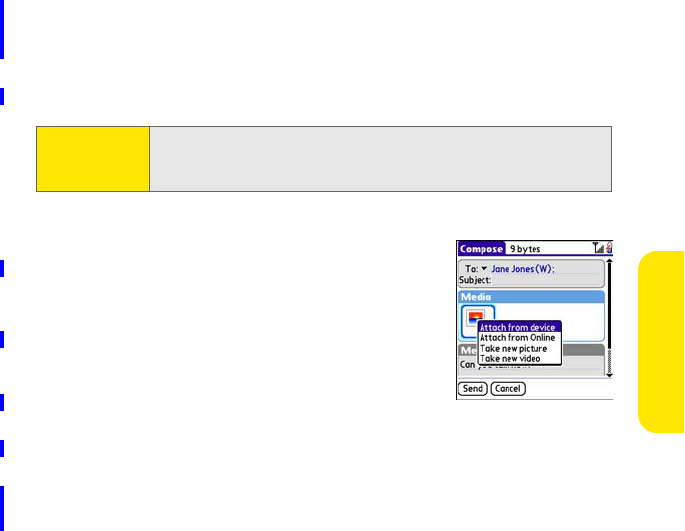
Section 3D: Messaging 149
Messaging
ⅢIf the recipient is in your Contacts list, enter the first initial and last name
(no spaces), and then select the recipient’s phone number or email
address, depending on where you want to send the message.
ⅢIf the recipient’s name is not in the list of recent addresses or your
Contacts list, enter the mobile number or email address.
4. Select Add media.
5. Select the Media icon and select one of the
following:
ⅢAttach from device lets you attach a picture or
video from your device.
ⅢAttach from Online lets you attach a picture or
video from your online album. See “Using
Your Online Album” on page 200 for
information.
ⅢTake new picture prompts you to take a new picture with the built-in
camera and attach it to the message.
ⅢTake new video prompts you to capture a new video with the built-in
camcorder and attach it to the message.
6. (Optional) Repeat step 5 for each item you want to attach.
Tip: You may need to press Option to enter letters or numbers. The Option
Lock setting defaults to the setting you used the last time you addressed
a message.
FINAL DRAFT Palm, Inc. Confidential

150 Section 3D: Messaging
7. Enter your message or select QuickText to insert predefined phrases. To
insert emoticons, select .
8. Select Send.
Your device uploads the pictures or videos to the Sprint PCS Picture Mail Web site
(www.sprint.com/picturemail), creates a private Guest Book for the recipient on
the Sprint PCS Picture Mail Web site, and sends your message to the recipient.
The recipient can then use a Web browser to access this private Guest Book to
view the pictures or videos and to enter comments. You can view the comments
later from the Sprint PCS Picture Mail Web site.
If you are outside a coverage area or if your phone is off, outgoing messages go
into the Drafts folder. When you return to a coverage area, you can open the
message in the Drafts folder and send it.
Messaging Tips
ⅷYou can address messages to multiple recipients by separating the addresses
with a comma.
ⅷWhen entering message text, you can insert emotive symbols by pressing and
holding Center and selecting emoticons, or insert predefined QuickText
phrases by selecting QuickText and then selecting a phrase. To add a new
phrase, select Edit QuickText from the list.
ⅷNot all the symbols that are available on your device can be used in your
messages. The Messaging application automatically replaces invalid
characters before it sends messages.
ⅷYou can send and receive text messages (but not Picture Mail messages) even
while you are on a phone call. This is easiest when using the hands-free
headset or speakerphone.
FINAL DRAFT Palm, Inc. Confidential
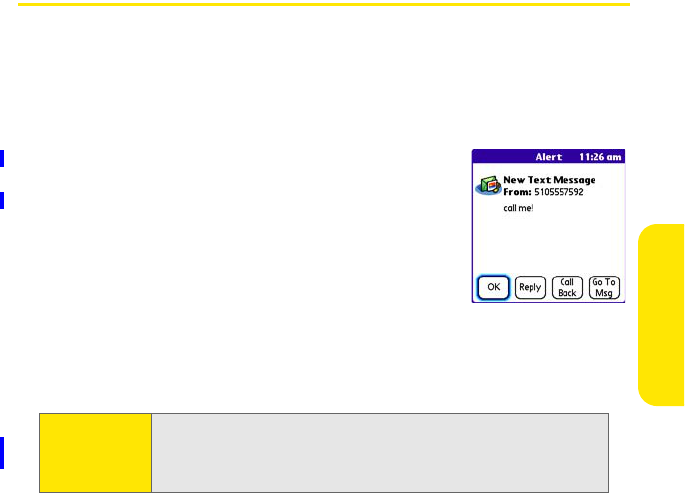
Section 3D: Messaging 151
Messaging
Receiving Messages
When your phone is on and is in an area of wireless coverage, you automatically
receive new text messages. You can also configure your device to notify you when
a message arrives (see “Selecting Messaging Alert Tones” on page 157).
The new message alert may include any of the following buttons:
ⅷOK dismisses the alert and places the message in your Inbox.
ⅷReply opens Chat view, where you can reply with a text
message. To send a multimedia message reply, select
Add from Chat view.
ⅷCall Back dials the sender’s phone number.
ⅷGo To Msg opens the message so you can view its full
contents.
ⅷGo To opens the message so you can view its full
contents in your online Sprint PCS Picture Mail
account. See “Working With Your Online Picture Mail Album” on page 201 for
details.
ⅷDelete deletes the received message directly from the message alert.
Tip: If you have multiple alerts, the Alert screen displays all your pending
alerts. Select an alert to jump to that item, or check the box to clear that
alert. To view all your pending alerts from any screen on your device,
press and hold Center on the 5-way.
FINAL DRAFT Palm, Inc. Confidential
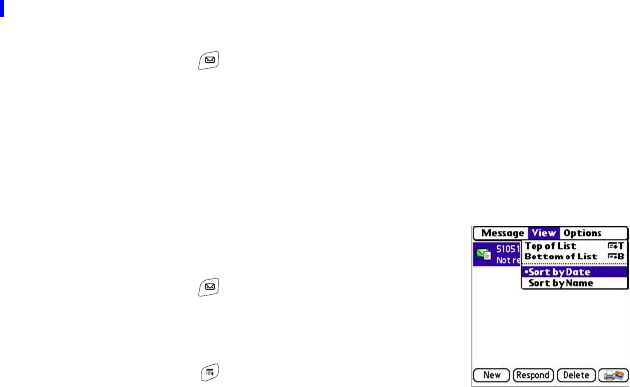
152 Section 3D: Messaging
Using Links in Messages
When you receive a message that contains a telephone number, email address, or
URL, you can dial the number, send an email message, or go directly to the Web
page.
1. Press Messaging .
2. Select the message that contains the link you want to use.
3. Select the phone number, email address, or URL (appears as underlined blue
text).
Your device automatically opens the appropriate application from the link.
Arranging Your Messages
You can rearrange the messages in any folder by using the
Sort command.
1. Press Messaging .
2. Select the folder list in the title bar, and then select
the folder you want to sort.
3. Open the menus .
4. Select View, and then select Sort by Name or Sort by
Date.
FINAL DRAFT Palm, Inc. Confidential

Section 3D: Messaging 153
Messaging
Deleting Messages
You can delete several messages at once from any folder by using the Purge
command.
1. Press Messaging .
2. Select the folder list in the title bar, and then select the folder that contains
the messages you want to delete.
3. Open the menus .
4. Select Purge from the Message menu.
5. Select the Purge pick list, and then select an option.
6. Select OK.
FINAL DRAFT Palm, Inc. Confidential
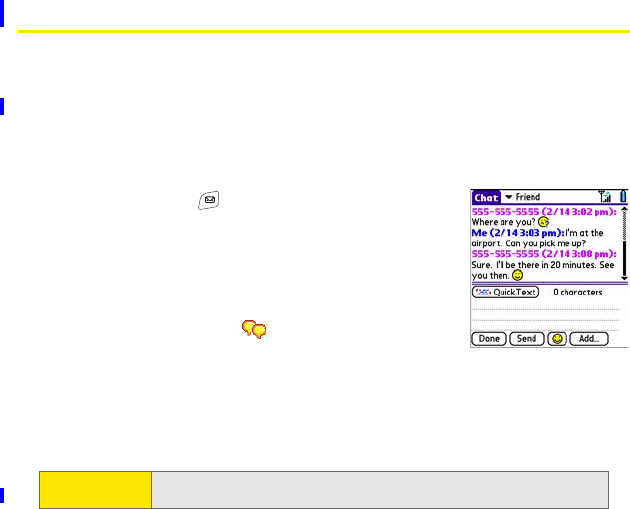
154 Section 3D: Messaging
Using Messaging to Chat
When you exchange more than one message with a single contact, the messages
you exchange with that person are grouped into a chat session. When you select
a chat session from your message list, the upper part of Chat view displays all text
messages you’ve exchanged with this contact, and the lower part provides an
entry area. You can carry on multiple chats at the same time and easily switch
between them, using the pick list at the top of the screen.
1. Press Messaging .
2. Do one of the following:
ⅢTo start a new chat, select a message and
reply to it.
ⅢTo continue an existing chat, select a message
with the chat icon .
3. Enter your message.
4. Select Send.
To find a chat you had with someone, open your Messaging Inbox and select a chat
session.
Tip: To add pictures, sounds, or videos to your message, select Add.
FINAL DRAFT Palm, Inc. Confidential

Section 3D: Messaging 155
Messaging
Managing Your Messages
The message descriptions in the Inbox, Outbox, and Sent folders show the
message status:
ⅷUnread messages appear in bold.
ⅷRead messages appear in plain text.
ⅷUrgent messages appear with a red exclamation point (!).
The following icons show the message type and additional status information:
A text message
A multimedia message
A voicemail page
A chat session
An incoming message with an error
An outgoing message with an error
FINAL DRAFT Palm, Inc. Confidential
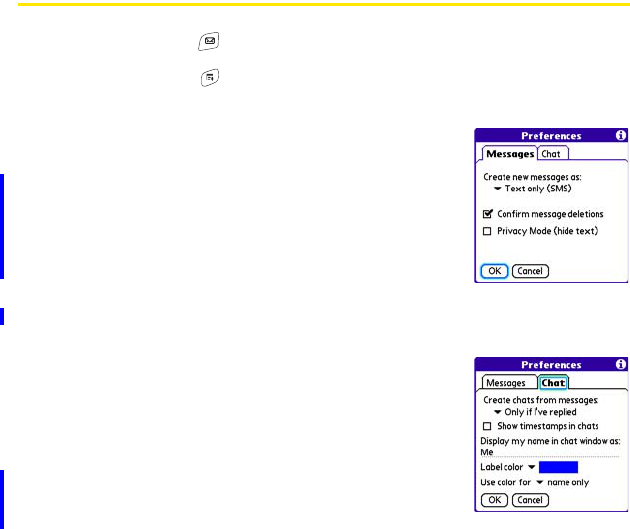
156 Section 3D: Messaging
Customizing Your Messaging Settings
1. Press Messaging .
2. Open the menus .
3. Select Options, and then select Preferences.
4. On the Messages tab, set any of the following
preferences for your individual messages:
ⅢCreate new messages as indicates whether you
default to a text message or a Sprint PCS
Picture Mail message when you create a new
message.
ⅢConfirm message deletions indicates whether
deletion confirmation prompts appear.
ⅢPrivacy Mode (hide text) indicates whether the body text appears in the
alert when you receive a new message.
5. Select the Chat tab and set any of the following
preferences for chat sessions:
ⅢCreate chats from messages indicates when you
want to group text messages from the same
person into a chat.
ⅢShow timestamps in chats displays next to each
message the local date and time the message
was sent.
FINAL DRAFT Palm, Inc. Confidential
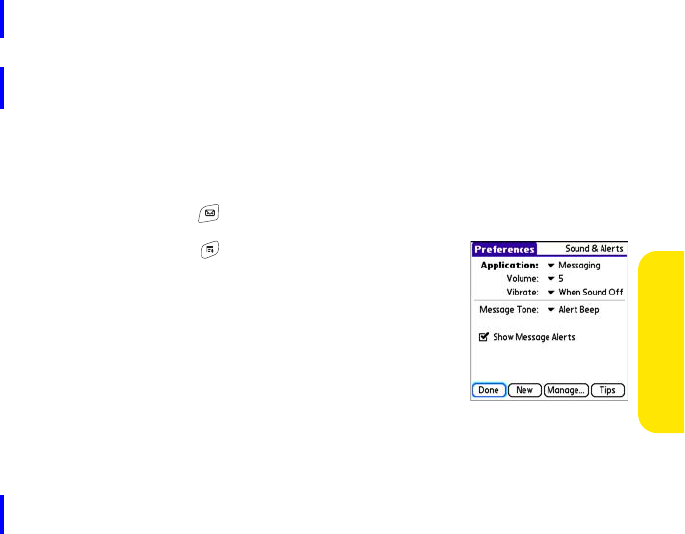
Section 3D: Messaging 157
Messaging
ⅢDisplay my name in chat window as indicates the text label for your
messages in Chat view.
ⅢLabel color sets a color to differentiate your messages from the sender’s
messages in Chat view.
ⅢUse color for indicates whether both your name and message appear in a
different color, or only your name.
6. Select OK.
Selecting Messaging Alert Tones
1. Press Messaging .
2. Open the menus .
3. Select Options, and then select Alerts.
4. Select the Application pick list, and then select
Messaging.
5. Select the Volume pick list, and then select the
volume level.
6. Select the Vibrate pick list, and then select when
you want the vibrate option to turn on.
7. Select the Message Tone pick list, and then select a tone for incoming
message alerts.
8. Check the Show Message Alerts box if you want to see an onscreen alert
when a new message arrives.
9. Select Done.
FINAL DRAFT Palm, Inc. Confidential
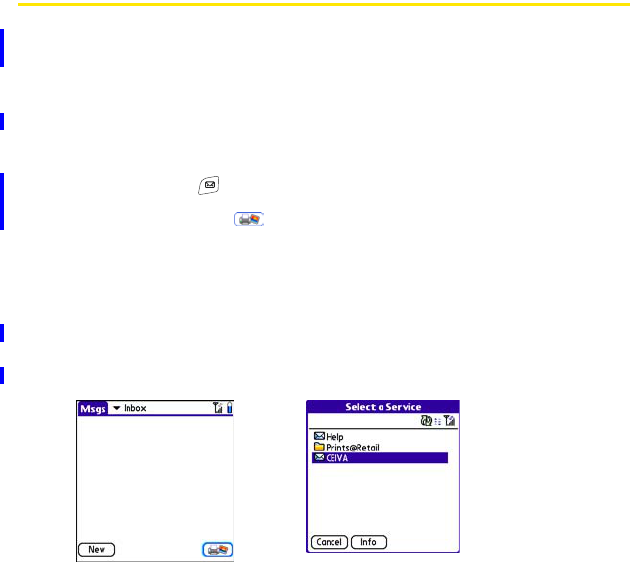
158 Section 3D: Messaging
Using Online Services
Sprint PCS Picture Mail Online Services let you access printing and other services
for photos and videos when you compose and send a Picture Mail message from
your Treo device. For example, if you send a message containing a picture, you can
select an online printing service, which will print and deliver a copy of the picture
to you. Additional fees may be required to use Online Services.
Accessing Online Services
1. Press Messaging .
2. Select Online Services in the lower-right corner of the screen.
3. If prompted, enter or create a password.
4. If the Welcome! screen appears, select Continue.
5. Select the service you want to use.
6. Create your Picture Mail message as described in “Creating and Sending a
Sprint PCS Picture Mail Message” on page 148. The media you include with
the message is sent to the service you select for processing.
FINAL DRAFT Palm, Inc. Confidential

Section 3E: Browsing the Web 159
Browsing the Web
Section 3E
Browsing the Web
In This Section
ࡗViewing a Web Page
ࡗWorking With Web Pages
ࡗWorking With Bookmarks and Saved Pages
ࡗCustomizing Your Web Browser Settings
The Web browser on your Treo™ 700P smart device provides quick and easy access
to Web pages. You can view most of the sites you use on your computer, including
those with security and advanced features such as JavaScript and frames. To
browse the Web, you must activate Sprint PCS Vision® data services. See
“Enabling Sprint PCS Vision” on page 108.
FINAL DRAFT Palm, Inc. Confidential
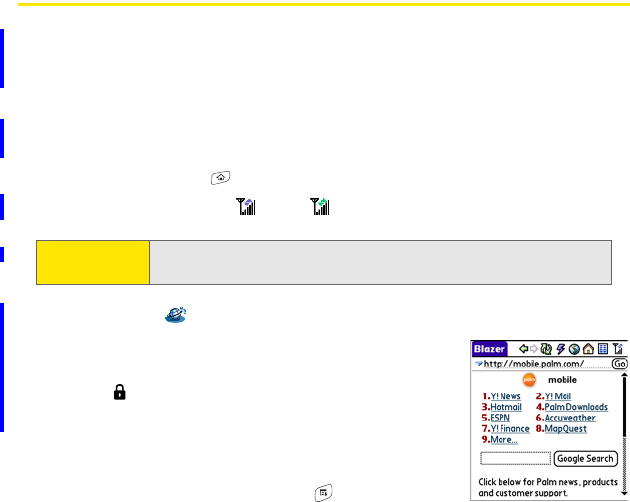
160 Section 3E: Browsing the Web
Viewing a Web Page
The Web browser uses patent-pending technology to optimize Web pages for
your device. By default, the browser reformats Web pages into a single column
and resizes images on your screen. That way, you can see most of the content
without scrolling left or right.
1. Make sure your phone is turned on (see “Turning Your Device’s Phone On
and Off” on page 55).
2. Go to Applications and confirm that data services are available. You
should see either the or the icon.
3. Select Web .
4. Enter a Web page address (URL) in the address bar
and select Go. If you browse to a secure Web page, a
lock appears in the address bar.
5. Do any of the following to navigate within the Web
page:
ⅢView a page in wide layout format (as on your
computer): Open the menus , select Options,
and then select Wide Page Mode.
Note: If you do not see either of the above icons, data services are not available
in your current location and you cannot connect to the Internet.
FINAL DRAFT Palm, Inc. Confidential
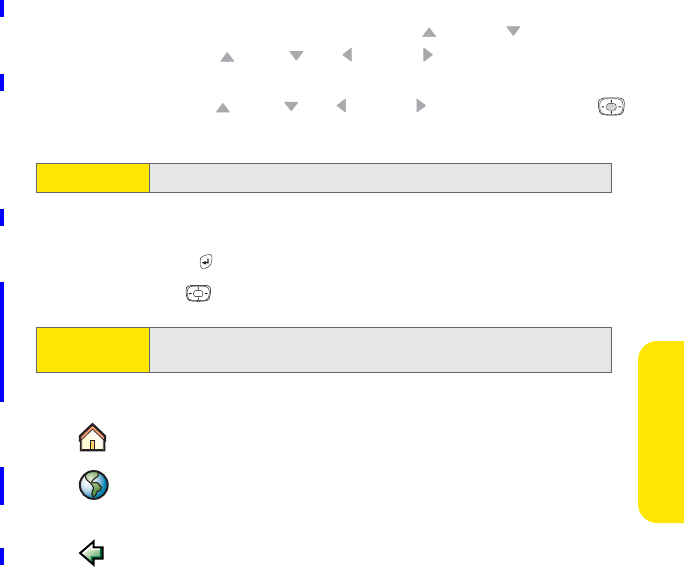
Section 3E: Browsing the Web 161
Browsing the Web
ⅢScroll through the page: In Optimized Mode (the default format, which is
optimized for your device screen), press Up or Down . In Wide Page
Mode, press Up , Down , Left , or Right to scroll in all directions.
ⅢFollow a link to another Web page: In Optimized Mode, highlight the link
by pressing Up , Down , Left , or Right , and then press Center
to go to the selected page.
ⅢSubmit a form: Enter the information and then select the onscreen
button to submit the form. If the form doesn’t have an onscreen button,
press Return .
6. Use the 5-way to access any of the following icons in the title bar:
Tip: In Wide Page Mode, use the stylus to tap a link.
Tip: To quickly jump to the title bar from anywhere on a Web page, press
Space to go to the address bar, and then press Up on the 5-way.
Goes to your home page.
Opens a dialog box where you can enter a Web address
you want to go to or view a list of recently viewed Web
pages.
Goes to the previous Web page.
FINAL DRAFT Palm, Inc. Confidential

162 Section 3E: Browsing the Web
Goes to the next Web page.
Refreshes the page with the latest content from the
Internet.
Opens a list where you can select Fast Mode (no images or
style sheets) or Normal Mode (with images and style
sheets).
Tip: The navigation bar shows status information while a page is loading.
You don’t have to wait for a page to fully load to navigate within the
page or to select a link to another page. However, if you select a link
while a page is loading and you receive a message saying that JavaScript
is not ready, wait for the page to finish loading and then select the link
again.
FINAL DRAFT Palm, Inc. Confidential

Section 3E: Browsing the Web 163
Browsing the Web
Working With Web Pages
Downloading Files From a Web Page
The Web browser lets you download files that are recognized by one of the
applications on your device. When you download a file, you can open it in the
application that recognizes the file. For example, if you download a picture, you
can view it later in the Pics&Videos application. If a file is not recognized by any of
the applications on your device, you can download the file to an expansion card,
but you cannot open it on your device.
You can download files such as new applications, and choose to play or save
music and video files in many popular formats—provided that the Web site
permits the downloading of files.
1. Go to the page that contains the link to the file you want to download.
2. Press Left or Right to highlight the link to the file, and then press
Center .
Item Supported File Types
Pictures JPEG, BMP, WBMP, GIF, animated GIF
Videos MP4, 3G2, ASF, WMV
Ringtones MIDI, QCELP, MP3, AAC, AAC+
Music MP3, WMA
FINAL DRAFT Palm, Inc. Confidential
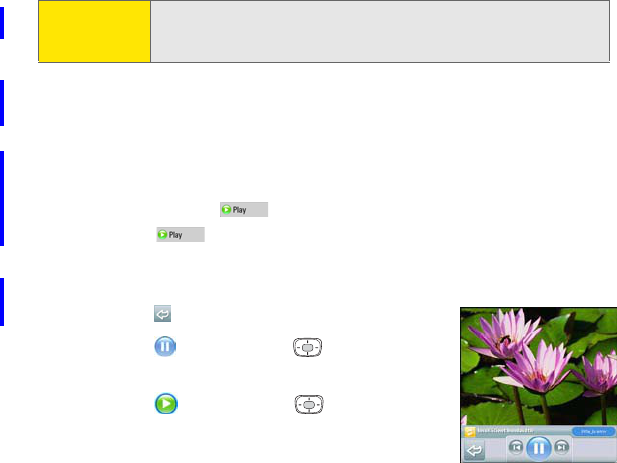
164 Section 3E: Browsing the Web
3. If prompted, select what you want to do with the file: Play, Save To Device, or
Save To Card.
4. Select Yes.
Streaming Files From a Web Page
The Web browser lets you stream files that are recognized by one of the
applications on your device. For example, you can choose to play music and video
files in many popular formats, such as MP3, WMA, and WMV.
1. When the Web browser recognizes streamed content on a Web page, it
displays a Play icon . To view or listen to the streamed content,
select Play .
2. Once streaming begins, playback starts automatically. Use the following
controls when viewing or listening:
ⅢSelect to return to the original Web page.
ⅢSelect or press Center to pause
playback.
ⅢSelect or press Center to resume
playback after pausing.
ⅢA few seconds after playback begins, the
toolbar is hidden and you can view the
Tip: You can also save an image from a Web page by tapping and holding it
with the stylus. In addition, you can access software and other
downloads using the Downloads bookmark.
FINAL DRAFT Palm, Inc. Confidential
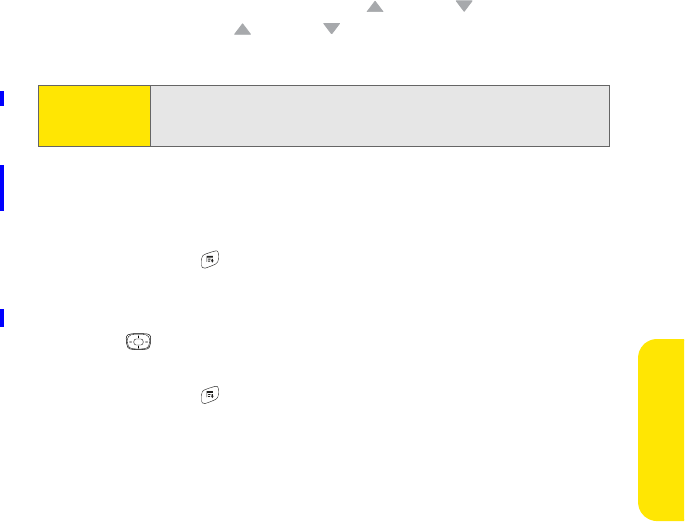
Section 3E: Browsing the Web 165
Browsing the Web
content on the full screen. Press Up or Down to display the
toolbar; press Up or Down again to hide the toolbar again.
ⅢPress the Volume button on the side of your device to adjust the volume.
Copying Text From a Web Page
You can copy text from a Web page and paste it into other applications.
1. Use the stylus to highlight the text you want to copy.
2. Open the menus .
3. Select Edit, and then select Copy.
4. Go to the application in which you want to paste the text, and then use the
5-way or the stylus to position the cursor where you want to paste the
text.
5. Open the menus .
6. Select Edit, and then select Paste.
Note: If the Web browser recognizes streamed content that is not supported
by any application on your device, a “Media type not supported”
message appears.
FINAL DRAFT Palm, Inc. Confidential
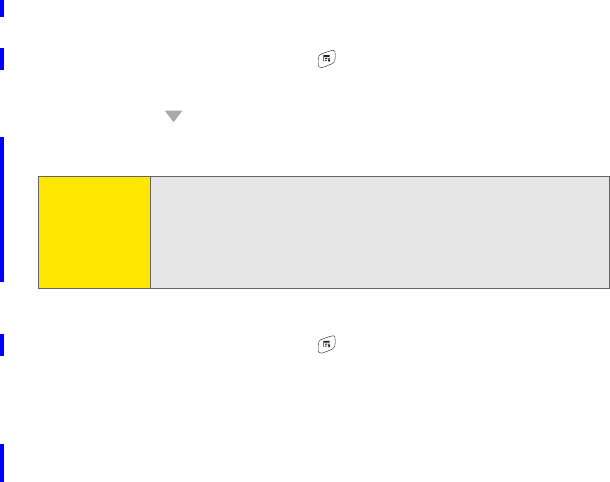
166 Section 3E: Browsing the Web
Returning to Recently Viewed Pages
The History list stores the addresses of the last one hundred pages you visited.
Items in the History list are sorted chronologically.
1. From Page view, open the menus .
2. Select History from the Page menu.
3. Press Down to navigate through the list.
4. Select the Web page you want to load.
Finding Text on a Web Page
1. From Page view, open the menus .
2. Select Find Text on Page on the Page menu.
3. Enter the text you want to find.
4. Check or uncheck the Wrap Search box to indicate whether you want the
search to wrap from the end of the page to the beginning when the search
reaches the end of the page.
5. Select Find to start the search.
Tip: To clear all items from the History list, select Clear All. To bookmark any
page on the list, highlight the page and then select Bookmark. If you
clear all History list items, the Web browser does not suggest any entries
when you begin entering a Web address, even if you have the Auto-
complete feature turned on (see “Customizing Your Web Browser
Settings” on page 170 for information on Auto-complete).
FINAL DRAFT Palm, Inc. Confidential
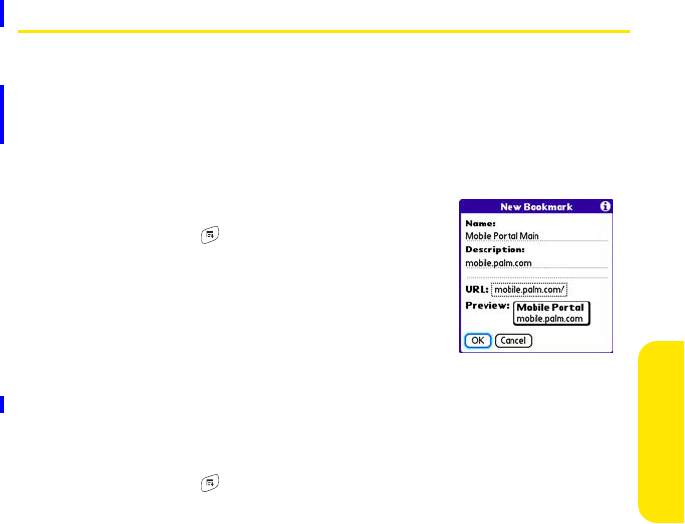
Section 3E: Browsing the Web 167
Browsing the Web
Working With Bookmarks and Saved Pages
Creating a Bookmark
With bookmarks, you can quickly access a Web page without entering the
address every time. The Web browser can store up to one hundred bookmarks or
saved pages, allowing you to open your favorite Web pages quickly. Note that a
bookmark is different from a favorite button (see “Defining Favorite Buttons” on
page 78).
1. Go to the page you want to bookmark.
2. Open the menus .
3. Select Add Bookmark from the Page menu.
4. (Optional) Change the entries in the Name and
Description fields.
5. Select OK, and then select OK again.
Saving a Page
You can use the Web browser to save a page for offline viewing, so that you don’t
need an Internet connection to view it later.
1. Go to the page you want to save.
2. Open the menus .
3. Select Save Page from the Page menu.
4. Select OK, and then select OK again.
FINAL DRAFT Palm, Inc. Confidential
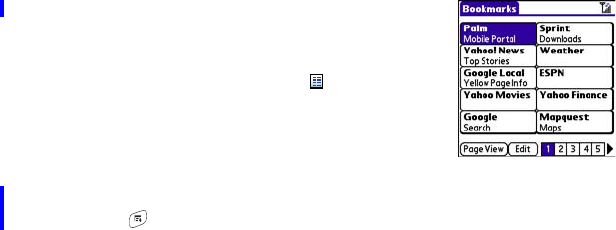
168 Section 3E: Browsing the Web
Viewing Bookmarks or Saved Pages
Bookmarks and saved pages appear in Bookmarks view.
Saved pages are indicated by a small triangle in the
upper-right corner of the bookmark.
1. Select the Bookmarks view icon .
2. Select the bookmark or saved page you want to
view.
Editing or Deleting a Bookmark or Saved Page
1. From Bookmarks view, open the
menus .
2. Select Edit Bookmarks from the Bookmarks menu.
3. Select the bookmark or saved page you want to edit or delete.
4. Enter the desired changes.
5. Select OK.
FINAL DRAFT Palm, Inc. Confidential
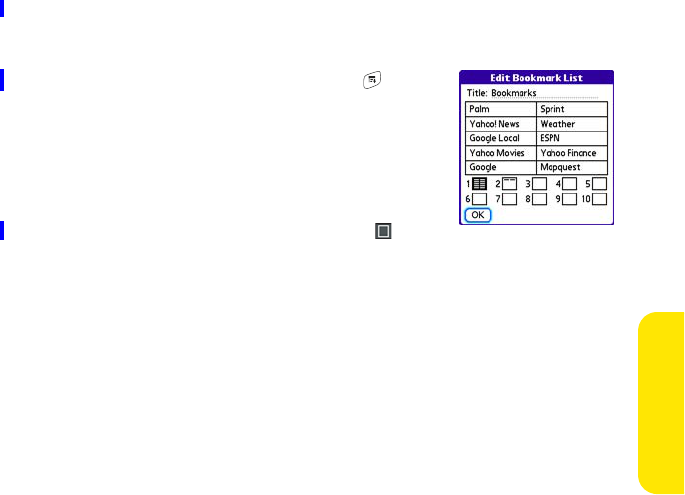
Section 3E: Browsing the Web 169
Browsing the Web
Arranging Bookmarks and Saved Pages
Bookmarks view includes ten pages of bookmarks, so that you can arrange
bookmarks and saved pages in a logical fashion. For example, you can store travel
links on one page, stock links on another, and business links on a third page.
1. From Bookmarks view, open the menus .
2. Select Edit Bookmarks on the Bookmarks menu.
3. Enter a title for this page of bookmarks.
4. Use the stylus to drag and drop a bookmark into
another slot on the current page of bookmarks.
To move a bookmark to a different page, drag
and drop it onto the Bookmark Page icon .
5. Select OK.
FINAL DRAFT Palm, Inc. Confidential
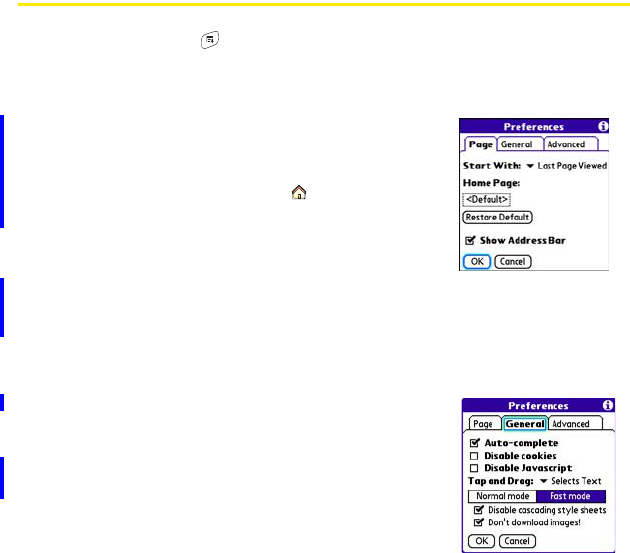
170 Section 3E: Browsing the Web
Customizing Your Web Browser Settings
1. Open the menus .
2. Select Options, and then select Preferences.
3. Select Page and set any of the following preferences:
ⅢStart With indicates which view is displayed
every time you open the Web browser.
ⅢHome Page indicates which Web page
appears when you select .
ⅢRestore Default resets the home page to the
original Sprint PCS Vision home page if you
changed it.
ⅢShow Address Bar indicates whether the Web
address appears in Page view. When the address bar is visible, you can
select the pick list next to it to go to a previously viewed page or enter a
URL directly from Page view.
4. Select General and set any of the following preferences:
ⅢAuto-complete indicates whether the Web
browser suggests text, based on your
previous entries, when you enter
information.
ⅢDisable cookies indicates whether Web sites
can store personalized information on your
Treo device. Some sites do not work properly
if you select this option.
FINAL DRAFT Palm, Inc. Confidential
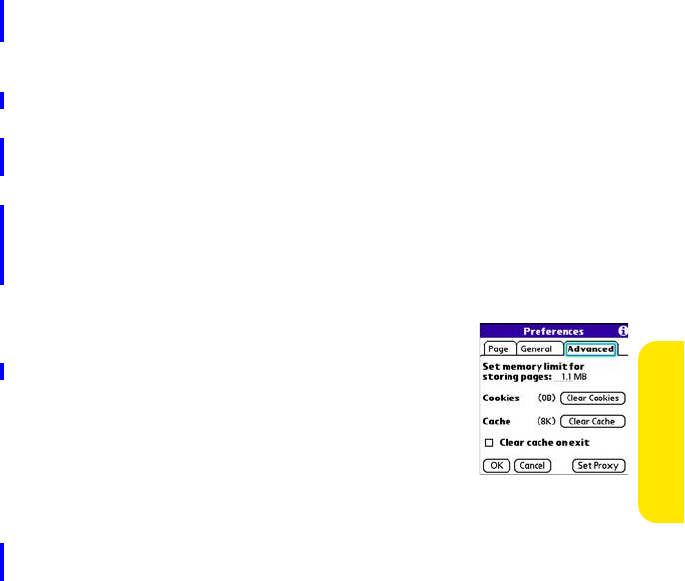
Section 3E: Browsing the Web 171
Browsing the Web
ⅢDisable Javascript bypasses JavaScript elements on the Web pages you view.
ⅢTap and Drag indicates whether dragging the stylus selects text or scrolls
through the content of the page.
ⅢNormal mode/Fast mode indicates whether you want to hide selected
items so that Web pages load faster. When you select Fast Mode, you can
set the following options:
ࡗDisable cascading style sheets indicates whether style sheets are
applied when you load a Web page. When style sheets are disabled,
pages download faster, but you may lose some of the formatting.
ࡗDon’t download images! indicates whether images appear when you
load a Web page. If you select not to view images, you can still see
any image by tapping and holding the placeholder box on the Web
page with the stylus.
5. Select Advanced and set any of the following preferences:
ⅢSet memory limit for storing pages sets the
amount of memory used for your cache. Pages
are cached so that they load faster the next
time you view them.
ⅢCookies indicates how much memory is being
used by cookies. To free up this memory, select
Clear Cookies.
ⅢCache indicates how much memory is being
used by your cache to store recent pages and history. To free up this
memory, select Clear Cache.
ⅢClear cache on exit indicates whether the cache clears each time you exit
the Web browser.
FINAL DRAFT Palm, Inc. Confidential

172 Section 3E: Browsing the Web
ⅢSet Proxy sets up a proxy server to access the Internet. If your connection
requires a proxy server, please contact your Internet service provider or
IT administrator for this information.
6. Select OK.
Note: Setting a proxy server may prevent you from accessing some Sprint PCS
Vision Web pages.
FINAL DRAFT Palm, Inc. Confidential

Section 3F: Using Bluetooth® Wireless Technology and Dial-Up Networking 173
Bluetooth/DUN
Section 3F
Using Bluetooth® Wireless Technology and
Dial-Up Networking
In This Section
ࡗConnecting to Devices With Bluetooth® Wireless Technology
ࡗUsing Your Device as a Wireless Modem
FINAL DRAFT Palm, Inc. Confidential

174 Section 3F: Using Bluetooth® Wireless Technology and Dial-Up Networking
Connecting to Devices With Bluetooth®
Wireless Technology
With your Treo™ 700P smart device’s built-in Bluetooth® wireless technology, you
can connect to a number of devices enabled with Bluetooth wireless technology,
such as a headset, car kit, printer, or GPS receiver, as well as to other phones and
handhelds that are enabled with Bluetooth wireless technology. When you
connect to another device, you create a partnership (also referred to by terms
such as trusted pair, trusted device, or pairing) with that device. If your computer
is enabled with Bluetooth wireless technology, you can also synchronize
wirelessly or use your phone as a wireless modem.
You can create a list of Bluetooth devices that you trust to communicate with
your Treo device. When communicating with trusted devices, your Treo device
skips the discovery process and creates a secure link as long as the device is
within range. Bluetooth range is up to 30 feet in ideal conditions. Performance
and range are affected by physical obstacles, radio interference from nearby
electronic equipment, and other factors.
When you configure a headset (see “Connecting to a Bluetooth Hands-Free
Device” on page 84), the headset is automatically added to your trusted device
list. Follow the steps in this section to add other devices to your trusted device
list, such as your computer or GPS device enabled with Bluetooth technology.
Entering Basic Bluetooth Settings
To use your Treo device’s Bluetooth functionality, you need to turn the Bluetooth
feature on, and you may need to make your device either temporarily or
permanently visible. You can also enter a name for your device.
FINAL DRAFT Palm, Inc. Confidential
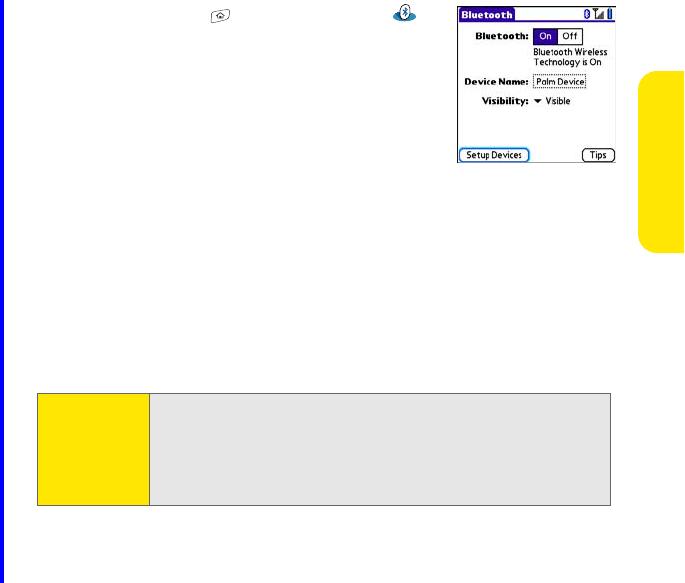
Section 3F: Using Bluetooth® Wireless Technology and Dial-Up Networking 175
Bluetooth/DUN
1. Go to Applications and select Bluetooth .
2. Select On.
3. Enter a device name for your Treo device. (This is
the name that appears on the other Bluetooth
device’s screen when it connects to your Treo
device. You need to enter a device name only
once.)
4. Select the Visibility pick list and select one of the
following:
ⅢVisible enables Bluetooth devices that are not on your Trusted Device list
to request a connection with your device. Your device remains
accessible to other devices until you turn this option off.
ⅢTempora ry enables Bluetooth devices that are not on your Trusted Device
list to request a connection with your device during the next two
minutes. Your device reverts to the Hidden setting and becomes
inaccessible to other devices after two minutes.
ⅢHidden allows only devices with which you have previously formed a
partnership to request a connection with your Treo device. New devices
cannot request a connection.
Important: For your Treo device to be visible to other Bluetooth devices, the
Bluetooth setting must be set to On, and visibility must be set to Visible
or Temporary. Your Treo device screen does not need to be turned on. If
you are requesting a connection with another device, or if you are
accepting a request from a trusted device, your Treo device can be set to
any of the Visibility options.
FINAL DRAFT Palm, Inc. Confidential
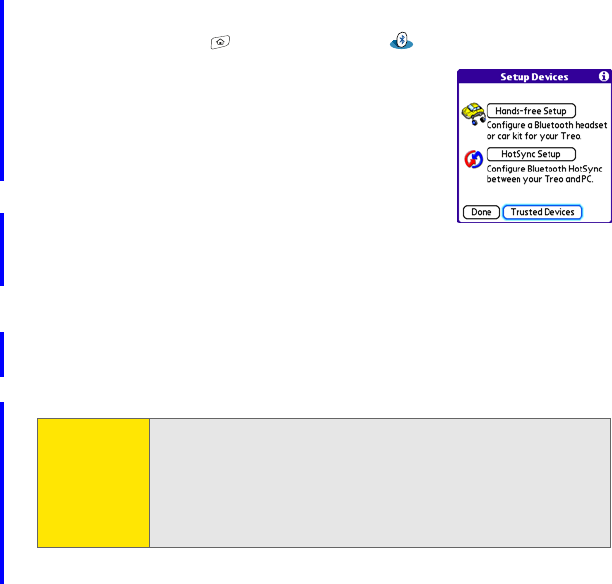
176 Section 3F: Using Bluetooth® Wireless Technology and Dial-Up Networking
Requesting a Connection With Another Bluetooth Device
1. Go to Applications and select Bluetooth .
2. If you have not already done so, enter the basic
Bluetooth settings as described in “Entering
Basic Bluetooth Settings” on page 174.
3. Select Setup Devices.
4. Select Trusted Devices.
5. Select Add Device. The Discovery icon appears,
indicating that the discovery process is active.
6. Select the Show pick list and select Nearby devices.
7. If the device you want to add doesn’t appear in the discovery results list,
make sure that the other device is ready to receive a connection request (see
the device’s documentation), and then select Find More on your Treo device
to search again.
8. Enter the same passkey on your Treo device and on the Bluetooth device,
and then select OK.
9. Select Done.
Important: Some Bluetooth devices, such as headsets and GPS receivers, may have a
built-in passkey; other devices may provide a screen where you enter the
passkey. We recommend that you use a passkey of 16 digits, where
possible, to improve the security of your Treo device. The longer the
passkey, the more difficult it is for the passkey to be deciphered. If the
Bluetooth device has a built-in passkey, see the device’s documentation
for the passkey.
FINAL DRAFT Palm, Inc. Confidential

Section 3F: Using Bluetooth® Wireless Technology and Dial-Up Networking 177
Bluetooth/DUN
Accepting a Connection From Another Bluetooth Device
1. To prepare your Treo device to be able to accept a connection from a
requesting device, enter the basic Bluetooth settings as described in
“Entering Basic Bluetooth Settings” on page 174.
2. Enter the same passkey on your Treo device and on the Bluetooth device.
3. Select OK.
Important: Some Bluetooth devices, such as headsets and GPS receivers, may have a
built-in passkey; other devices may provide a screen where you enter the
passkey. We recommend that you use a passkey of 16 digits, where
possible, to improve the security of your Treo device. The longer the
passkey, the more difficult it is for the passkey to be deciphered. If the
Bluetooth device has a built-in passkey, see the device’s documentation
for the passkey.
Note: Make sure you close the Bluetooth application after you set up devices
and partnerships.
FINAL DRAFT Palm, Inc. Confidential

178 Section 3F: Using Bluetooth® Wireless Technology and Dial-Up Networking
Using Your Device as a Wireless Modem
Dial-up networking (DUN) is the feature that converts the phone on your Treo
device into a modem so that you can access the Internet from your computer. You
can set up DUN in one of two ways:
ⅷIf you have signed up on a Sprint Power Vision with Phone as Modem plan,
you can use the Sprint Connection Manager software on your computer and
connect your Treo device to your computer using the USB sync cable; see
“Using Your Device’s Phone as a Modem” on page 118 for information.
ⅷIf your computer is enabled with Bluetooth wireless technology, you can set
up your Treo device as a wireless modem using the built-in Bluetooth
technology.
This section describes the process of setting up your device as a wireless modem
using the built-in Bluetooth technology.
Creating a DUN Connection Using Bluetooth Technology
To configure DUN using Bluetooth technology, complete the following
procedures:
ⅷ“Creating a Partnership Between Your Device and Your Computer” on
page 179.
ⅷ“Setting Up Your Computer for a Bluetooth DUN Connection” on page 180.
ⅷ“Accessing the Internet Using a Bluetooth DUN Connection” on page 180.
FINAL DRAFT Palm, Inc. Confidential
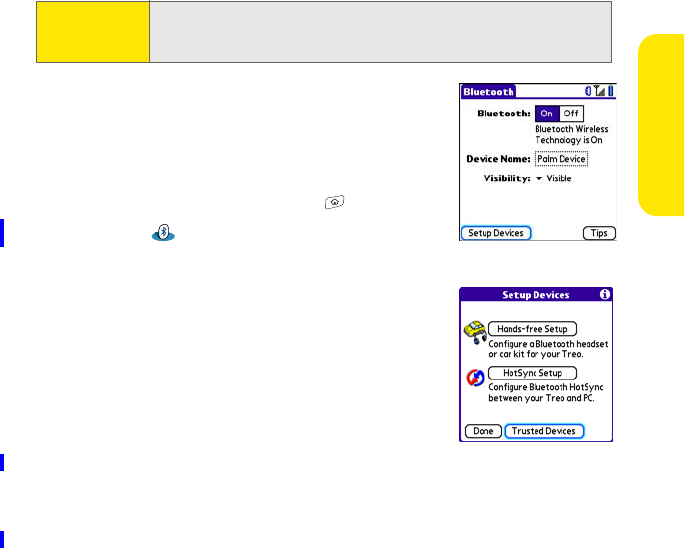
Section 3F: Using Bluetooth® Wireless Technology and Dial-Up Networking 179
Bluetooth/DUN
Creating a Partnership Between Your Device and Your Computer
1. Make sure that your computer’s Bluetooth
setting is on and that your computer is ready to
create a Bluetooth partnership. Check the
documentation that came with your computer to
find and change these settings.
2. On your device, go to Applications and select
Bluetooth .
3. Select On if it is not selected, and then select Setup Devices.
4. Select Trusted Devices.
5. Select Add Device. The discovery icon appears,
indicating that the discovery process is active.
6. Select your computer from the Trusted Devices
list, and then select OK.
7. Enter a passkey on the Bluetooth Security screen,
and then select OK. The passkey can be any
number of up to 16 characters.
8. Enter the same passkey number on your computer when prompted.
9. Select Done, and then select Done again to return to the Bluetooth screen.
Note: If your computer is not enabled with Bluetooth wireless technology, you
may be able to purchase a wireless Bluetooth adapter accessory for your
computer.
FINAL DRAFT Palm, Inc. Confidential

180 Section 3F: Using Bluetooth® Wireless Technology and Dial-Up Networking
Setting Up Your Computer for a Bluetooth DUN Connection
Dial-up networking must be enabled or installed on your computer. Follow the
instructions from the manufacturer of your Bluetooth adapter to enable DUN.
Your wireless service provider may provide customized software programs that
walk you through the DUN setup process. Check with your wireless service
provider to see if such a program is available.
Accessing the Internet Using a Bluetooth DUN Connection
The steps for accessing the Internet on your computer may vary depending on
your operating system and how Bluetooth wireless technology is set up on your
computer—for example, if it is built in versus if you are using a wireless
Bluetooth adapter. If the following procedure does not work with your computer,
check your computer’s documentation for how to set up Bluetooth technology to
access the Internet using a DUN connection.
Before you begin, verify that DUN is enabled on both your computer and your
device.
Note: You must enter the same passkey on your device and your computer. We
recommend that you use a passkey of 16 digits, where possible, to
improve the security of your Treo device. The longer the passkey, the
more difficult it is for the passkey to be deciphered.
Note: You may need to use a virtual private network (VPN) to access corporate
email. Check with your system administrator for more information.
FINAL DRAFT Palm, Inc. Confidential
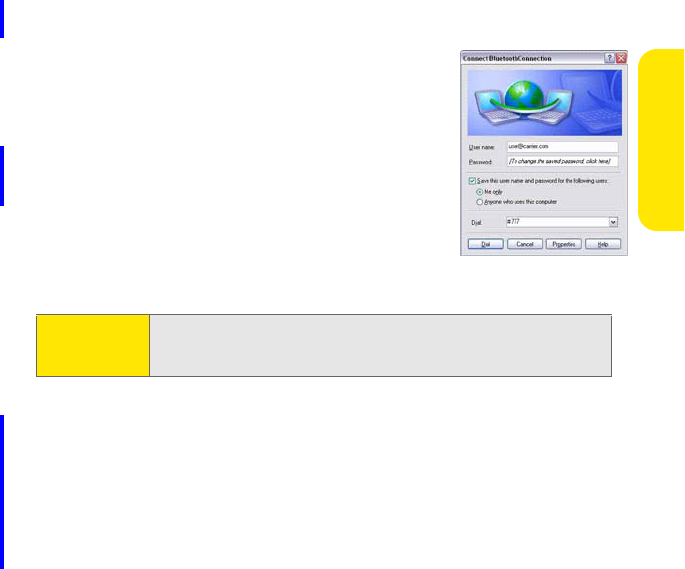
Section 3F: Using Bluetooth® Wireless Technology and Dial-Up Networking 181
Bluetooth/DUN
1. Open the Bluetooth screen on your computer and look for the option for
paired devices. Check your computer’s documentation for how to open this
screen and for the name of the paired devices option.
2. Double-click the icon or option representing your
device. Your computer connects to your device and
shows that DUN services are available.
3. Double-click the DUN icon.
4. Enter the following in the Dial field: #777. You do
not need to enter anything in the User Name or
Password field.
5. Click Dial. Once the connection is successfully
established, you can browse the Internet on your
computer or download your email.
To verify that you are connected, look for a network connection icon in the
taskbar at the bottom of your computer screen. To check the status of the
connection, right-click the Bluetooth network icon.
Tip: You may be asked if you want to remember this dial text for this
connection. We recommend that you choose to remember the dial text
to avoid errors and the inconvenience of entering it for every session.
FINAL DRAFT Palm, Inc. Confidential

182 Section 3F: Using Bluetooth® Wireless Technology and Dial-Up Networking
Terminating a Bluetooth DUN Internet Session
ᮣOn your computer, right-click the icon or option representing your device,
and then click Disconnect.
Note: When a Bluetooth DUN connection is active, you cannot form a
partnership with another device or discover another device. You also
cannot send or receive information wirelessly directly from your device,
browse the Web, or send or receive email messages, and any scheduled
automatic email retrievals do not take place. Incoming calls are
automatically sent to voicemail. You can make outgoing calls, but the
DUN session will be terminated when you place the call.
FINAL DRAFT Palm, Inc. Confidential
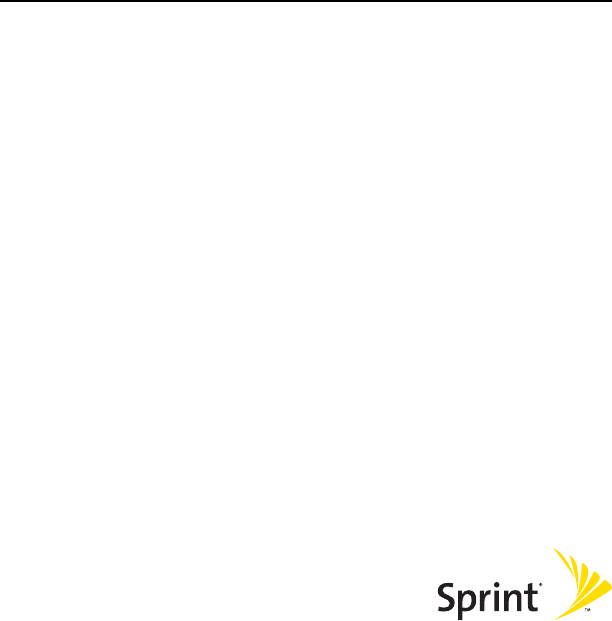
Section 4
Your Portable Media Device
FINAL DRAFT Palm, Inc. Confidential
184
FINAL DRAFT Palm, Inc. Confidential

Section 4A: Working With Your Pictures and Videos 185
Pictures & Videos
Section 4A
Working With Your Pictures and Videos
In This Section
ࡗTaking Pictures and Videos
ࡗCustomizing Your Camera Settings
ࡗViewing Pictures and Videos
ࡗOrganizing Pictures and Videos
ࡗUsing Your Online Album
ࡗViewing Pictures and Videos on Your Computer
FINAL DRAFT Palm, Inc. Confidential

186 Section 4A: Working With Your Pictures and Videos
Taking Pictures and Videos
The camera version of the Treo™ 700P smart device comes with an easy-to-use,
built-in, 1.3-megapixel camera with 2x digital zoom. You can use the camera to
take and view pictures and videos and send them to your friends and family. To
add a personal touch to your device, use your pictures as your wallpaper in the
Main view of the Phone application, and as caller ID images.
If your Treo device doesn’t have a built-in camera, the sections in this chapter
about taking photos and videos don’t apply to you. But you can still receive and
view photos and videos, send photos and videos to other people as attachments
or as Sprint PCS® Picture Mail, and use photos to personalize your device (such as
wallpaper or photo caller ID; see “Assigning a Caller ID Picture” on page 91 for
details).
You can also upload pictures and videos to albums on the Sprint PCS Picture Mail
Web site (www.sprint.com/picturemail), move them to an expansion card, and
copy them to your Windows computer by synchronizing your device with your
computer.
Additional fees may apply for Sprint PCS Picture Mail service. Contact Sprint for
additional information.
Note: The camera defaults to 1.3 megapixel (1280 x 1024) resolution. The
camera also supports VGA (640 x 480) and QVGA (320 x 240) resolution.
The camcorder defaults to CIF (352 x 288) resolution and also supports
QCIF (176 x 144) resolution. See “Customizing Your Camera Settings” on
page 191 for information on accessing camera and camcorder settings.
FINAL DRAFT Palm, Inc. Confidential
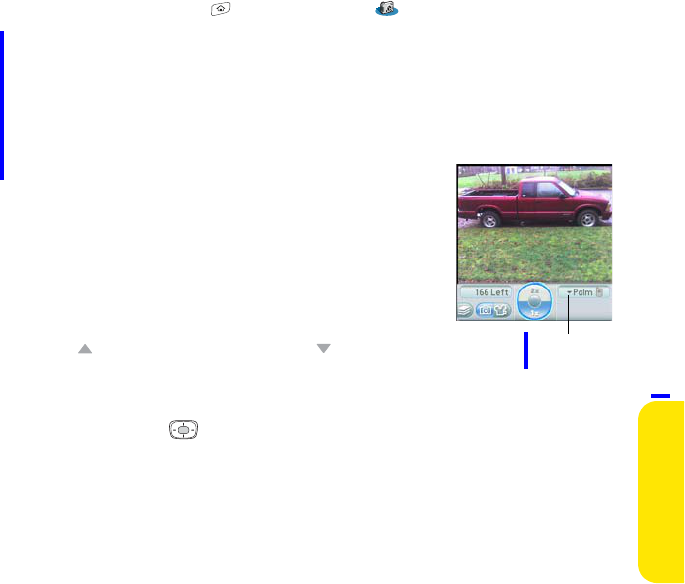
Section 4A: Working With Your Pictures and Videos 187
Pictures & Videos
Taking a Picture
1. Go to Applications and select Camera .
2. By default, the Camera application stores pictures you take in the Palm
album on your device. If you have an expansion card inserted in your
device’s expansion card slot, the Camera application creates a Palm album
on the card and stores pictures there by default. To store the picture in a
different location, select the album pick list in the lower-right corner of the
screen, and then do one of the following:
ⅢSelect <Album name> to store the picture in
the selected album. The storage location is
based on the location of the album (device or
expansion card).
ⅢSelect New Albums to open a dialog box where
you can enter an album name and select the
storage location (device or expansion card).
3. (Optional) Adjust the zoom setting by pressing Up
to select 2x or pressing Down to select 1x.
4. Point the lens on the back of your device at the
subject you want to photograph.
5. Press Center to take the picture.
Album
Pick List
FINAL DRAFT Palm, Inc. Confidential
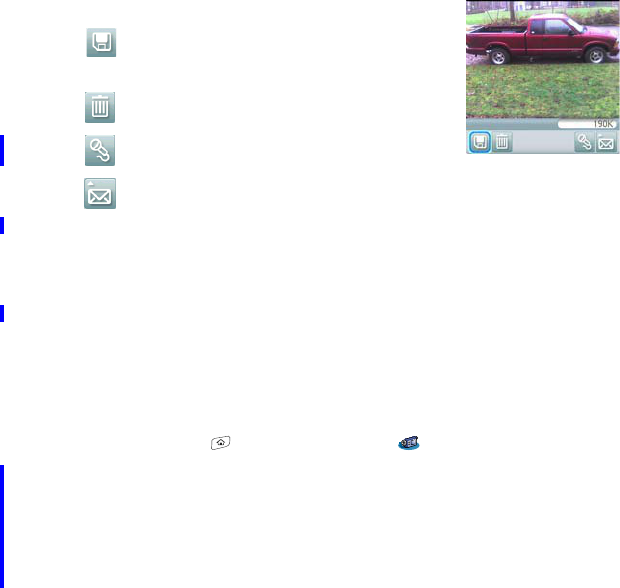
188 Section 4A: Working With Your Pictures and Videos
6. Select one of the following buttons:
Saves the picture in the location you selected
in step 2.
Deletes the picture.
Lets you add a voice caption.
Opens a list of options for sending the picture:
ⅢSelect Send with PictureMail to send the picture as part of a Picture Mail
message (see “Creating and Sending a Sprint PCS Picture Mail Message”
on page 148).
ⅢSelect Send with Online Services to send the picture using one of the
available Sprint PCS Vision® Online Services (see “Using Online Services”
on page 158).
ⅢSelect Upload to Online Albums to upload the picture to your online
album (see “Using Your Online Album” on page 200).
Recording a Video
1. Go to Applications and select Camcorder .
2. By default, the Camcorder application stores videos you record in the Palm
album on your device. If you have an expansion card inserted in your
device’s expansion card slot, the Camcorder application creates a Palm
album on the card and stores videos there by default. To store the video in a
different location, select the album pick list in the lower-right corner of the
screen, and then do one of the following:
FINAL DRAFT Palm, Inc. Confidential
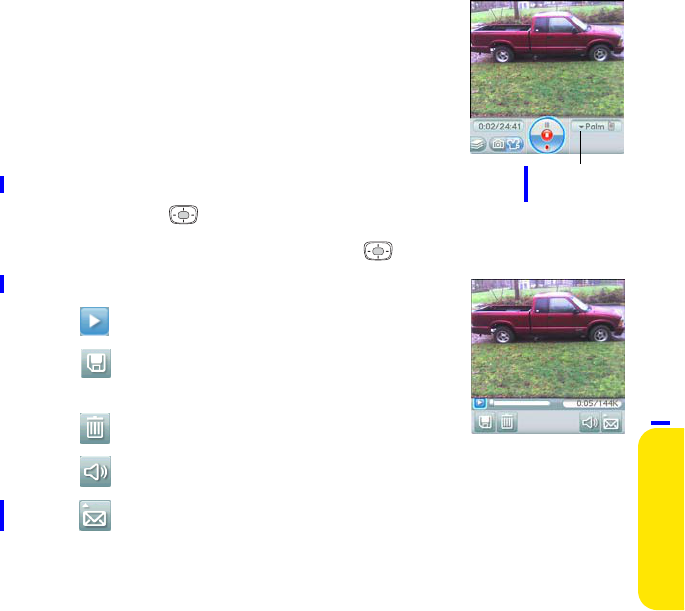
Section 4A: Working With Your Pictures and Videos 189
Pictures & Videos
ⅢSelect <Album name> to store the video in the
selected album. The storage location is based
on the location of the album (device or
expansion card).
ⅢSelect New Albums to open a dialog box where
you can enter an album name and select the
storage location (device or expansion card).
3. Adjust the position of your device until you see
the subject you want to record on the screen.
4. Press Center to start recording.
5. After you finish recording, press Center again to stop.
6. Select one of the following buttons:
Begins playback.
Saves the video in the location you selected
in step 2.
Deletes the video.
Opens a dialog box where you can adjust the volume during playback.
Opens a list of options for sending the video:
Album
Pick List
FINAL DRAFT Palm, Inc. Confidential

190 Section 4A: Working With Your Pictures and Videos
ⅢSelect Send with PictureMail to send the video as part of a Picture Mail
message (see “Creating and Sending a Sprint PCS Picture Mail Message”
on page 148).
ⅢSelect Send with Online Services to send the video using one of the
available Sprint PCS Vision Online Services (see “Using Online Services”
on page 158).
ⅢSelect Upload to Online Albums to upload the video to your online album
(see “Using Your Online Album” on page 200).
Note: The video recording screen displays the approximate recording time you
have left, based on the space available on your device or expansion card.
Actual recording time may vary depending on how fast you are moving,
how many colors you are recording, and so on.
FINAL DRAFT Palm, Inc. Confidential
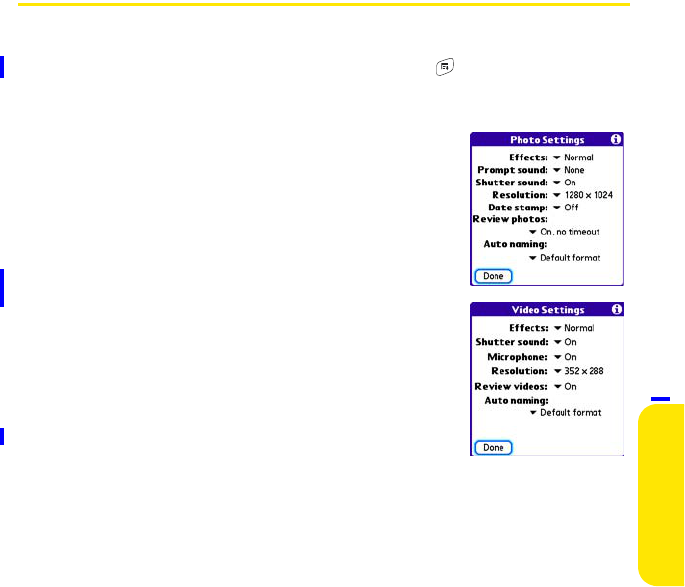
Section 4A: Working With Your Pictures and Videos 191
Pictures & Videos
Customizing Your Camera Settings
You can customize the built-in camera’s settings for your Treo device.
1. From Camera or Camcorder view, open the menus . If you are in Camera
view, the Photo Settings screen appears. If you are in Camcorder view, the
Video Settings screen appears.
2. Adjust any of the following settings:
ⅢEffects sets the color palette for the current
picture or video. You can’t change an item’s
palette after you take the picture or video.
ⅢPrompt sound (Pictures only) sets the sound that
plays before you take the picture.
ⅢShutter sound indicates whether a sound is
played when you take a picture.
ⅢMicrophone (Videos only) turns the microphone
on and off so that you can record videos with or
without sound.
ⅢResolution sets the default size for newly
captured pictures or videos.
ⅢDate stamp (Photos only) indicates whether the
date the picture is taken appears on your
pictures.
FINAL DRAFT Palm, Inc. Confidential

192 Section 4A: Working With Your Pictures and Videos
ⅢReview photos/videos indicates whether you can review pictures or
videos before saving them and how quickly they are automatically
saved.
ⅢAuto naming assigns a name to a series of pictures to be captured, such
as Seattle001, Seattle002, and so on.
3. Select Done.
FINAL DRAFT Palm, Inc. Confidential
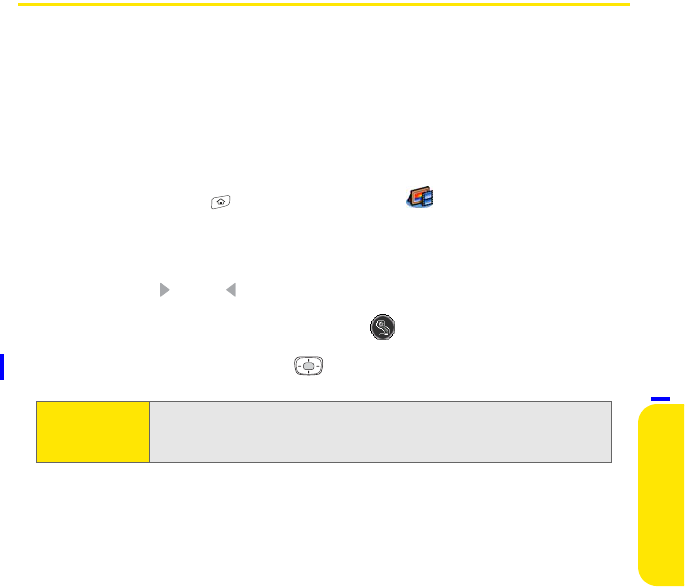
Section 4A: Working With Your Pictures and Videos 193
Pictures & Videos
Viewing Pictures and Videos
Viewing a Picture
In addition to viewing the pictures you capture with the built-in camera, you can
view pictures captured on many popular digital cameras or downloaded from the
Internet. Your device supports the following picture formats:
1. Go to Applications and select Pics&Videos .
2. Select the album that contains the picture you want to see.
3. Select the picture you want to view.
4. Press Right or Left to scroll to the next item in the album.
5. If the picture has a voice caption, select to hear it.
6. Tap the photo or press Center to return to Thumbnail view.
ⅷJPG ⅷBMP
ⅷTIF ⅷGIF
Tip: You can also send a photo or video from Thumbnail view. Select the
photo or video, select the Send icon in the lower-right corner of the
screen, and then select the sending option you want.
FINAL DRAFT Palm, Inc. Confidential
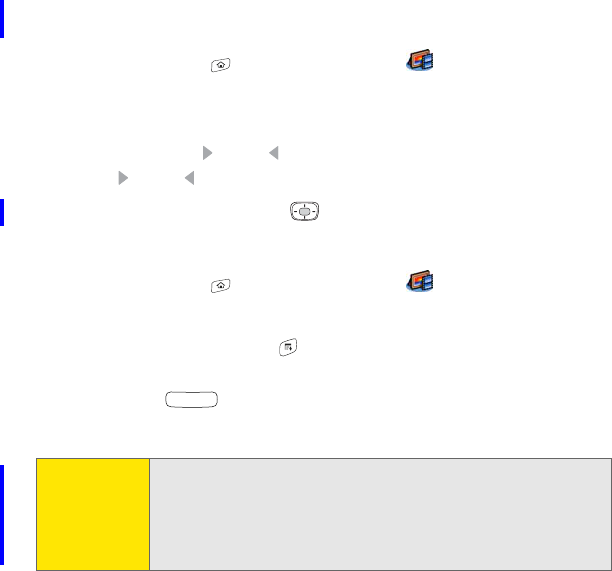
194 Section 4A: Working With Your Pictures and Videos
Viewing a Video
In addition to viewing the videos you capture with the built-in camcorder, you
can view videos captured on many popular digital video cameras.
1. Go to Applications and select Pics&Videos .
2. Select the album that contains the video you want to see.
3. Select the video you want to view. Playback begins automatically.
4. Hold down Right or Left to seek within the current video, or press
Right or Left to scroll to the next item in the album.
5. Tap the video or press Center to return to Thumbnail view.
Viewing a Slide Show
1. Go to Applications and select Pics&Videos .
2. Highlight or select the album you want to view.
3. (Optional) Open the menus , select Options, and then select Auto-hide
Toolbar On.
4. Press Space to start the slide show.
5. Tap the screen to return to the previous view.
Tip: To set slide show options such as background music and transitions,
open the Album menu and select Slideshow Setting. Keep in mind that
background music overrides audio captions when you’re running a slide
show. Background music for a slide show also overrides any music that is
playing using the Pocket Tunes™ application on your device if you start a
slide show.
FINAL DRAFT Palm, Inc. Confidential
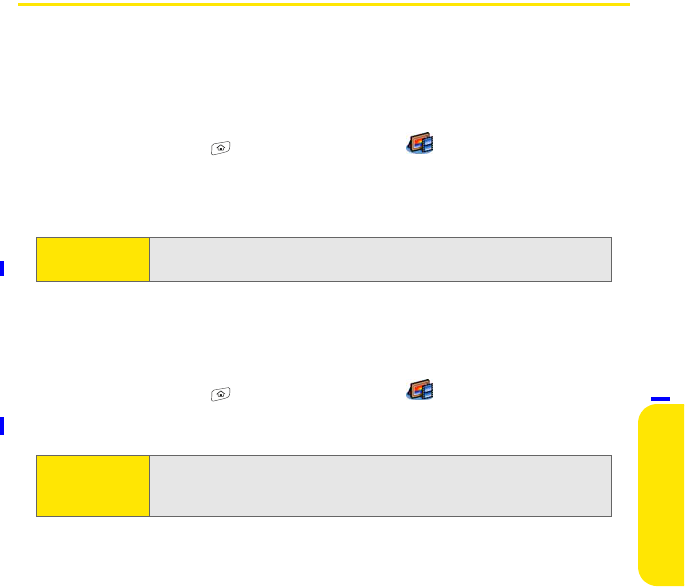
Section 4A: Working With Your Pictures and Videos 195
Pictures & Videos
Organizing Pictures and Videos
After you take pictures and record videos, you can organize them into albums on
your device or use your online album (see “Using Your Online Album” on
page 200).
Creating Albums on Your Device
1. Go to Applications and select Pics&Videos .
2. Select Create New Album.
3. Enter an album name, and then select OK.
Arranging Albums
After you create an album, you can add items to or remove items from that
album.
1. Go to Applications and select Pics&Videos .
2. Select the album you want to organize.
Tip: If you have an expansion card inserted into your device’s expansion card
slot, you can choose to create the album on the card.
Tip: From Thumbnail view, select the List/Thumbnail icon to the right of the
Camera icon in the lower-left corner of the screen to display the list of
albums.
FINAL DRAFT Palm, Inc. Confidential
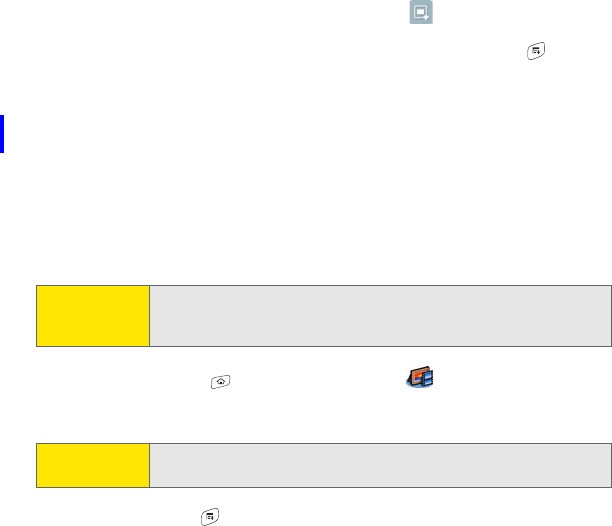
196 Section 4A: Working With Your Pictures and Videos
3. To add pictures or videos to an album, select .
To remove pictures or videos from an album, open the menus , select
Album, and then select Remove from album.
4. Select the pictures or videos to add or remove, or select Select All to add or
remove the entire album. (A plus sign [+] indicates that you want to add the
item; an X indicates that you want to remove the item.)
5. Select Add or Remove.
Copying Pictures and Videos
You can copy pictures and videos into another album. You can also copy pictures
and videos between your device and an expansion card.
1. Go to Applications and select Pics&Videos .
2. Select the album that contains the picture(s) or video(s) you want to copy.
3. Open the menus .
4. Select Copy to from the Photo (or Video) menu.
Tip: Install the Palm® Files application from the Palm Software Installation
CD to easily browse and manage pictures and videos on an expansion
card.
Tip: From Camera view or Camcorder view, select the icon in the lower-left
corner of the screen to display the list of albums.
FINAL DRAFT Palm, Inc. Confidential
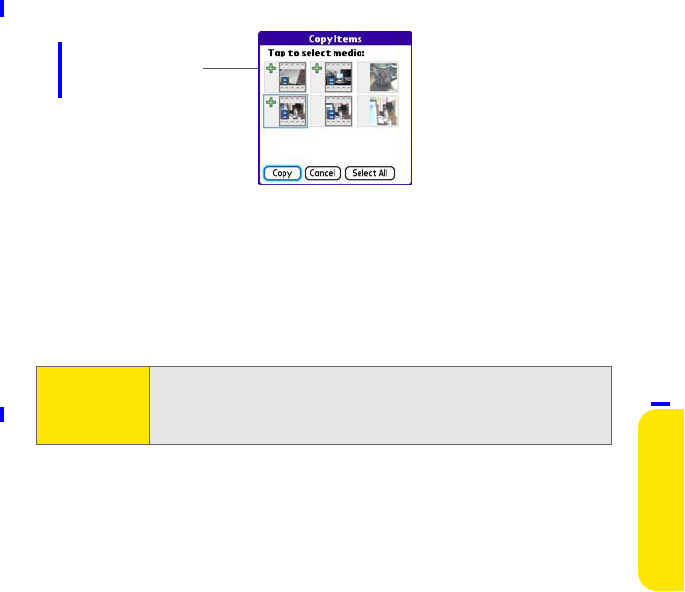
Section 4A: Working With Your Pictures and Videos 197
Pictures & Videos
5. Select the pictures or videos to copy, or select Select All to copy the entire
album. (A plus sign [+] appears next to selected items.)
6. Select Copy.
7. Select the Copy items to pick list and select whether you want to copy the
selected items to your device or to an expansion card.
8. Select the Into album pick list and select the album you want to copy the
selected items to.
9. Select Copy.
Tip: You can also move pictures and videos between albums. Open the Photo
(or Video) menu and select Move to. The remaining steps are the same
as those for copying pictures, but the command names display Move
instead of Copy.
Plus Sign (+)
Indicates That an
Item Is Selected
FINAL DRAFT Palm, Inc. Confidential
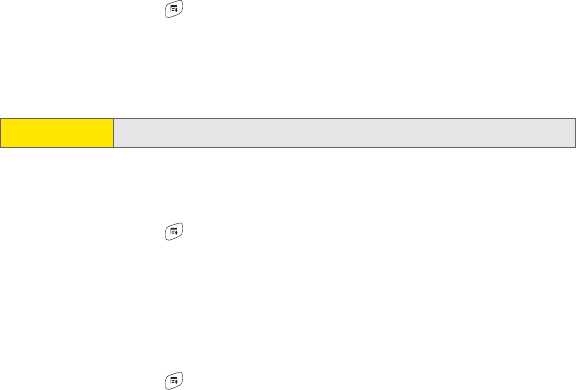
198 Section 4A: Working With Your Pictures and Videos
Saving a Picture as Wallpaper
You can select a picture to use as wallpaper for the Main view in the
Phone application.
1. Open the picture you want to save as wallpaper.
2. Open the menus .
3. Select Options, and then select Save as Wallpaper.
4. When the confirmation message appears, confirm by selecting Yes, or
decline by selecting No.
Adding a Picture to a Contact Entry
1. Open the picture you want to add to a contact.
2. Open the menus .
3. Select Options, and then select Save as Contact.
4. Select the contact you want to add this picture to.
Rotating a Picture
1. Open the picture you want to rotate.
2. Open the menus .
3. Select Rotate from the Photo menu.
4. Select the orientation.
Tip: Press Phone to view the new wallpaper in the Phone application.
FINAL DRAFT Palm, Inc. Confidential
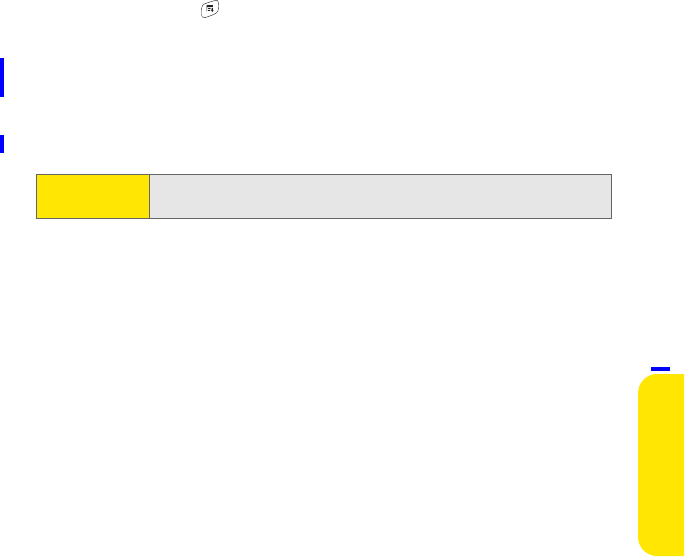
Section 4A: Working With Your Pictures and Videos 199
Pictures & Videos
Deleting a Picture or Video
1. Open the album that contains the picture(s) or video(s) you want to delete.
2. Open the menus .
3. Select Delete from the Photo (or Video) menu.
4. Select the pictures or videos that you want to delete, or select Select All to
delete the entire album. (An X appears next to the selected items.)
5. Select Delete.
6. Select Delete to confirm the deletion.
Tip: You can also highlight a picture or video in Thumbnail view, and then
press Backspace on your device keyboard to delete the highlighted item.
FINAL DRAFT Palm, Inc. Confidential
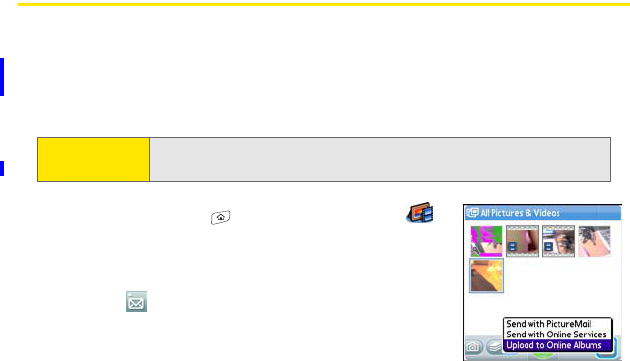
200 Section 4A: Working With Your Pictures and Videos
Using Your Online Album
Uploading Pictures to Your Online Album
Your Sprint PCS Picture Mail account includes an online album on the Sprint PCS
Picture Mail Web site. You can use your online album to store and view pictures
from your device or from a computer with Internet access.
1. Go to Applications and select Pics&Videos .
2. Select the album that contains the picture(s) or
video(s) you want to upload.
3. Select , and then select Upload to Online
Albums.
4. Select the picture(s) or video(s) you want to
upload.
5. Select Upload.
Note: If you have not previously accessed your onlne album or used Sprint PCS
Picture Mail Online Services, you are prompted to create a password.
FINAL DRAFT Palm, Inc. Confidential
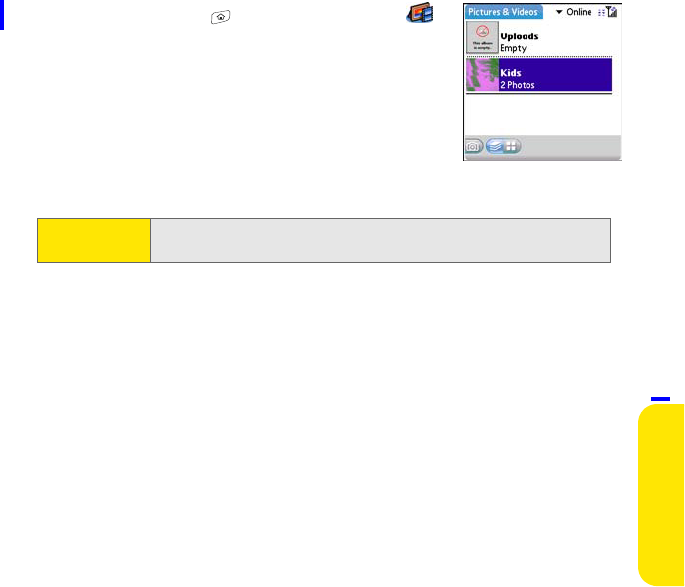
Section 4A: Working With Your Pictures and Videos 201
Pictures & Videos
Working With Your Online Picture Mail Album
1. Go to Applications and select Pics&Videos .
2. Select the album pick list in the upper-right corner
of the screen, and then select Online.
3. Select the online album containing the items you
want to view.
4. Follow the steps described in “Viewing a Picture”
or “Viewing a Video” on page 194 to view a
picture or video.
Tip: You can also download and play videos from your online album, and you
can listen to voice captions that are attached to pictures, too.
FINAL DRAFT Palm, Inc. Confidential
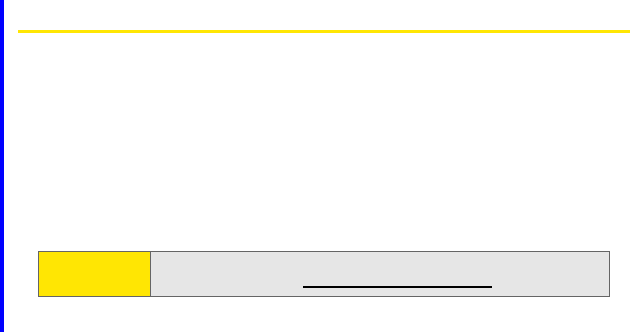
202 Section 4A: Working With Your Pictures and Videos
Viewing Pictures and Videos on Your Computer
When you synchronize your smart device, your pictures and videos are copied to
your desktop computer. You can view pictures in JPEG format and videos in
MPEG-4 format (.3G2 file extension). You can email them to friends using your
desktop email application.
On a Windows computer, you can view and edit synchronized pictures and videos
in the Palm Media desktop application. Open Palm®Desktop software and click
the Media icon. You can refer to the Palm Desktop Online Help for information
about using the Palm Media desktop application.
Tip: You can also view, download, and manage your pictures and videos
from your computer at www.sprint.com/picturemail.
FINAL DRAFT Palm, Inc. Confidential

Section 4B: Listening to Music 203
Music
Section 4B
Listening to Music
In This Section
ࡗSetting Up Windows Media Player for MP3
ࡗTransferring MP3 Files From Your Computer
ࡗTransferring Music From a CD to Your Device
ࡗListening to Music on Your Treo Device
You can listen to music through the speaker on the back of your Treo™ 700P smart
device, or through the included stereo headphones. To listen to music on your
device, you need to convert the music files into MP3 format using Windows
Media Player (Windows computers) or iTunes (Mac computers), and then transfer
the music files to your device or to an expansion card. After you transfer the
music files, you can play them using the Pocket Tunes™ application on your
device.
Important: Mac users must transfer music files to an expansion card.
FINAL DRAFT Palm, Inc. Confidential
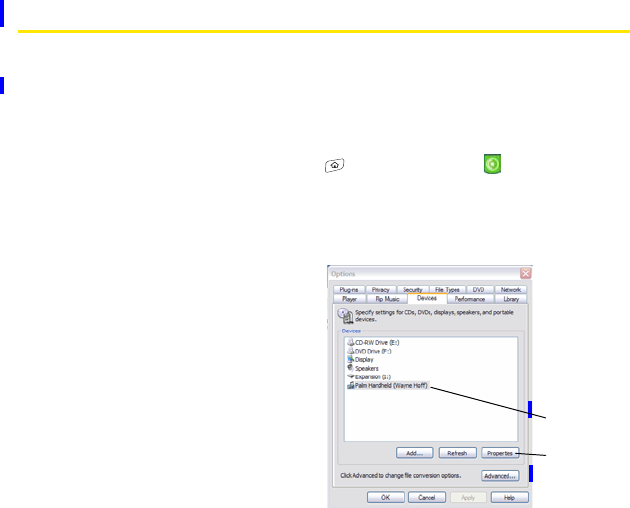
204 Section 4B: Listening to Music
Setting Up Windows Media Player for MP3
On a Windows computer, you need to set Windows Media Player settings to save
your music files in MP3 format in order for the files to be compatible with Pocket
Tunes.
1. Connect your device to your computer with the sync cable.
2. On your device, go to Applications and select pTunes .
3. On your computer, open Windows Media Player, and then click the full-screen
icon in the upper-right corner to maximize the window.
4. Click Tools, and then click Options.
5. Click the Rip Music tab, click the
Format pick list, and then select
mp3. Click OK.
6. Click Tools, and then click
Options.
7. Click the Devices tab, select
your Treo device from the
Devices list, and then click
Properties.Click
Properties
Select Your
Device
FINAL DRAFT Palm, Inc. Confidential
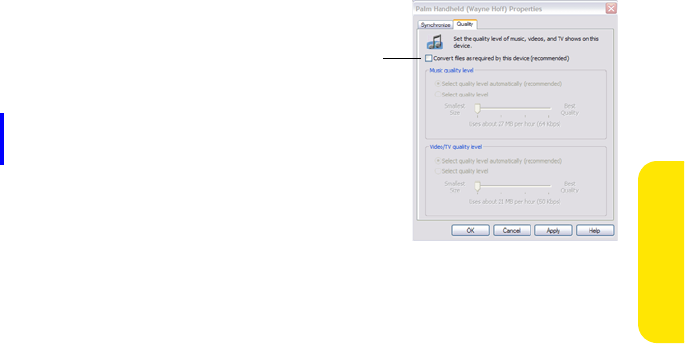
Section 4B: Listening to Music 205
Music
8. Click the Quality tab and
uncheck the Convert files as
required by this handheld
(recommended) box. Click Apply.
9. Click OK, and then click OK
again.
Setting Up iTunes for MP3
On a Mac, use iTunes (included with
OS X) to convert music from a CD to
MP3 format. For more information on
using the iTunes software, see the
documentation that came with your
Mac.
1. On your Mac, open iTunes.
2. Select Preferences.
3. Click the Advanced button at the top of the window, and then click
Importing.
4. Click the Import Using pop-up menu and select MP3 Encoder.
5. (Optional) Click the Setting pop-up menu and select Good Quality.
Uncheck
Box
FINAL DRAFT Palm, Inc. Confidential
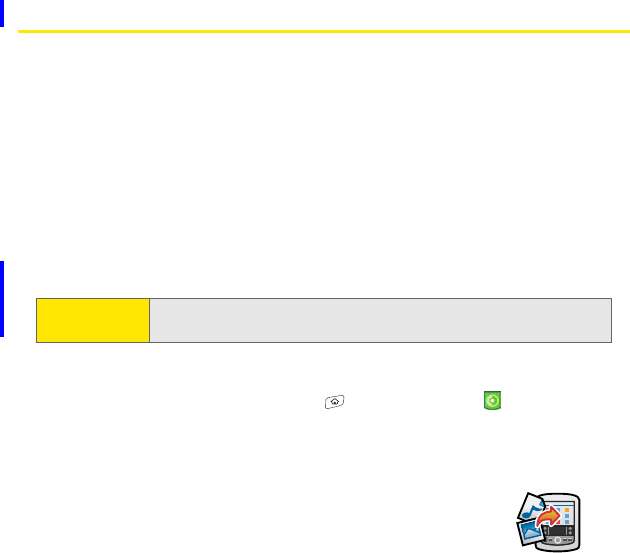
206 Section 4B: Listening to Music
Transferring MP3 Files From Your Computer
The Pocket Tunes software that comes with your device is compatible with the
popular MP3 audio file format. If your MP3 files are already on your computer’s
hard drive, you need to transfer them to your device to listen to them on your
device.
If an expansion card is inserted into the device, on a Windows computer,
Windows Media Player copies the MP3 files to the expansion card. If you don't
have an expansion card inserted, the MP3 files are copied to device memory.
If you are transferring MP3 files from a Mac computer, you must insert an
expansion card into the device. You cannot transfer MP3 files to device memory
from a Mac.
1. Connect your Treo device to your computer with the USB sync cable.
2. On your device, go to Applications and select pTunes .
3. If you are transferring from a Mac computer, insert an expansion card into
your device. This step is optional for Windows users.
4. Do one of the following:
ⅢWindows. Open Windows Media Player on your
computer. Select the Sync tab, and then select
Palm Handheld from the drop-down list. Select
Important: You must synchronize your device with your computer at least once
before you can transfer MP3 files from your computer.
FINAL DRAFT Palm, Inc. Confidential

Section 4B: Listening to Music 207
Music
Start Sync. The files are transferred to your device or to an expansion
card automatically; do not press the sync button on the sync cable.
ⅢMac. Drag and drop the MP3 files onto the Send To Handheld droplet in
the Palm folder. Select your device name (username), the file name, and
the destination (card). Click OK. Synchronize your device with your
computer. Be patient; transferring music to an expansion card can take
several minutes.
Tip: You can also use a card reader accessory (sold separately) to transfer
MP3 files from your computer to your expansion card. Create a “Music”
folder in the root directory of the card, and store your MP3 files in this
folder.
FINAL DRAFT Palm, Inc. Confidential

208 Section 4B: Listening to Music
Transferring Music From a CD to Your Device
If your songs are on a CD and you want to listen to them on your device, you need
to convert them to MP3 format on your computer before you transfer the files to
your device.
On a Windows computer:
1. Open the Windows Media Player application.
2. Insert the music CD into your computer’s CD drive.
3. Select the Rip tab.
4. Select the tracks you want to rip from the CD.
5. Select Rip Music.
6. Transfer the MP3 files to your device as described in “Transferring MP3 Files
From Your Computer” on page 206.
On a Mac computer:
1. Open iTunes.
2. Insert the music CD into your computer’s CD drive.
3. Check the boxes next to the tracks that you want to convert to MP3.
4. Click the Import button in the upper-right corner of the iTunes window.
5. After the songs are imported, click the Eject Disk button in the lower-right
corner of the iTunes window.
6. Transfer the MP3 files to your device as described in “Transferring MP3 Files
From Your Computer” on page 206.
FINAL DRAFT Palm, Inc. Confidential
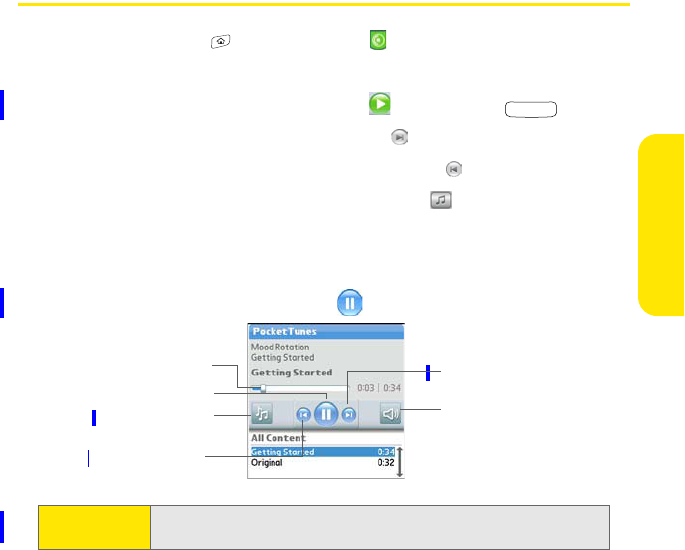
Section 4B: Listening to Music 209
Music
Listening to Music on Your Treo Device
1. Go to Applications and select pTunes .
2. Do any of the following:
ⅢTo play the current song, select Play or press Space .
ⅢTo play the next song, select Next Song .
ⅢTo play the previous song, select Previous Song .
ⅢTo play a different song, select Choose Songs and select a
song from the list.
ⅢTo adjust the volume during playback, press the Volume button on the
side of your device.
ⅢTo pause playback, select Pause .
Tip: You can also use the 5-way to navigate among songs, pause and resume
playback, and adjust the volume during playback.
Previous Song
Next Song
Volume
Choose Songs
Progress Indicator
Play/Pause
FINAL DRAFT Palm, Inc. Confidential
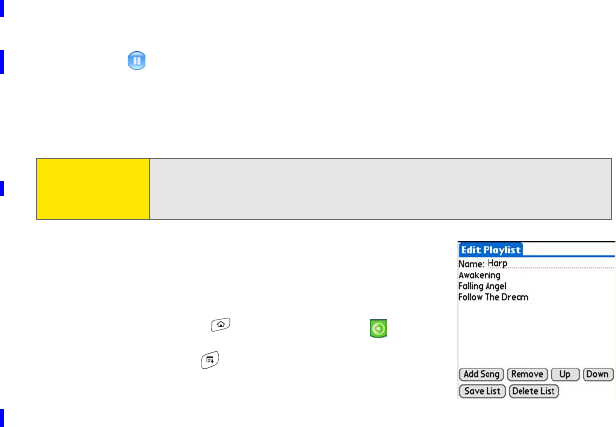
210 Section 4B: Listening to Music
Pocket Tunes continues playing until it reaches the end of your list or until you
select Pause . Music continues to play even if you switch to another application
or turn off your screen. If you want to stop playing music when you exit Pocket
Tunes, open the Background Prefs menu, uncheck the Enable Background Playback
box, and then select OK.
Creating a Playlist
If you want to play a group of songs in a particular
order, you can create a playlist.
1. Go to Applications and select pTunes .
2. Open the menus .
3. Select Actions, and then select Manage Playlists.
4. Select New, and then enter a name for the
playlist.
5. Select Add Song. Select the songs you want to include on the playlist.
6. Select Save List.
To play songs from a playlist, open Pocket Tunes, select Choose Songs, and then
select Playlists. Select the playlist you want to play, and then select All.
Tip: If you don’t hear anything when you play a song, make sure the Ringer
switch is set to Sound On. See “Silencing Sounds” on page 284 for more
information.
FINAL DRAFT Palm, Inc. Confidential
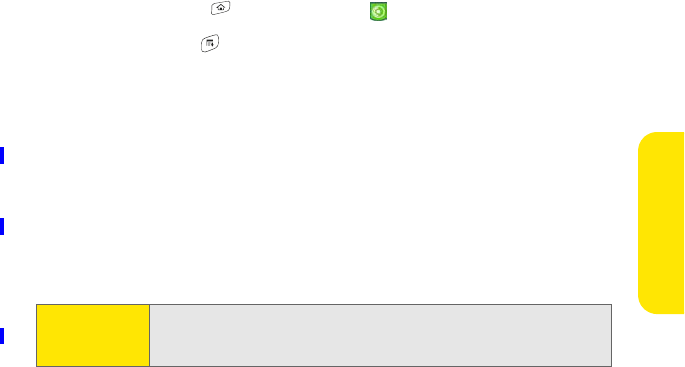
Section 4B: Listening to Music 211
Music
Editing a Playlist
1. Go to Applications and select pTunes .
2. Open the menus .
3. Select Actions, and then select Manage Playlists.
4. Highlight the playlist you want to edit, and then select Edit.
5. Do any of the following:
ⅢTo delete a song from the playlist, select the song and then
select Remove.
ⅢTo add a song, select Add Song, check a song’s box, and then select Done.
ⅢTo move a song up or down one slot, select a song and then select the
up or down arrow.
6. Select Save List.
Tip: To delete a playlist, select Playlists, select Manage Playlists from the
Actions menu, select the playlist, and then select Delete List. Select Yes to
confirm the deletion.
FINAL DRAFT Palm, Inc. Confidential
212 Section 4B: Listening to Music
FINAL DRAFT Palm, Inc. Confidential

Section 4C: Watching Sprint TVSM 213
Sprint TV
Section 4C
Watching Sprint TVSM
In This Section
ࡗAccessing Streamed Media
ࡗViewing Streamed Media
FINAL DRAFT Palm, Inc. Confidential
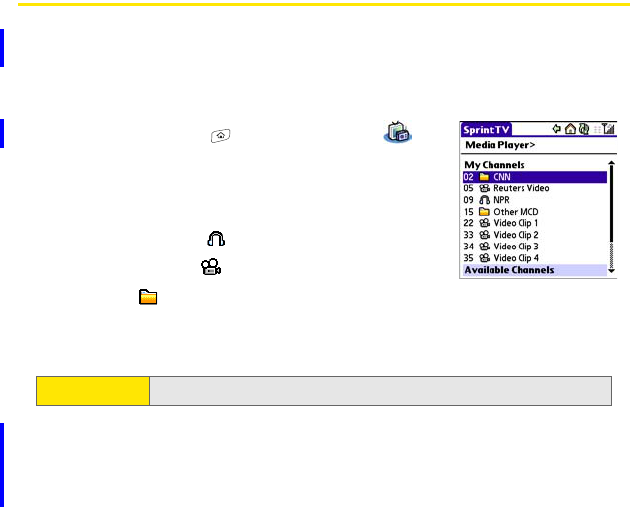
214 Section 4C: Watching Sprint TVSM
Accessing Streamed Media
The Sprint TV application enables you to view streamed audio and video media
from various channels on your Treo™ 700P smart device. You can choose from a
list of provided channels, or purchase additional channels so that you can
download and view the programs you want.
1. Go to Applications and select Sprint TV .
2. Select one of the following on the Channel Listing
screen:
ⅢTo stream audio or video content, select a
channel. The icon indicates audio
content; the icon indicates video content.
The icon indicates that the channel
contains multiple content items. Select the channel to view all items.
ⅢTo go back one channel screen, select Back.
ⅢTo go back to the main channel list, select Home.
ⅢTo view information about the selected channel or program, select Info.
Select Done on the Info screen when you have finished viewing the
information.
Note: The Back option does not appear on the default channel screen.
FINAL DRAFT Palm, Inc. Confidential
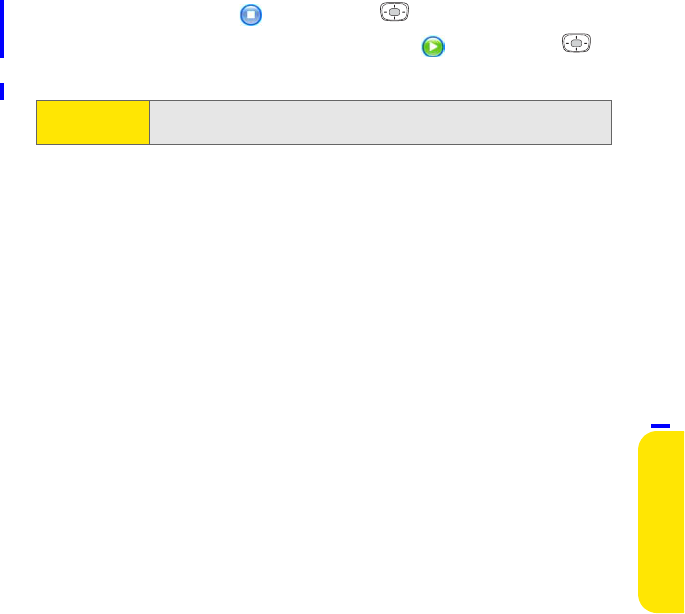
Section 4C: Watching Sprint TVSM 215
Sprint TV
3. (Optional) Select Stop or press Center to pause the connection to
the server before streaming begins. Select Play or press Center
again to resume streaming.
Tip: From a channel or folder screen, you can also use the keyboard to enter a
channel number, and then select OK to go to that channel.
FINAL DRAFT Palm, Inc. Confidential
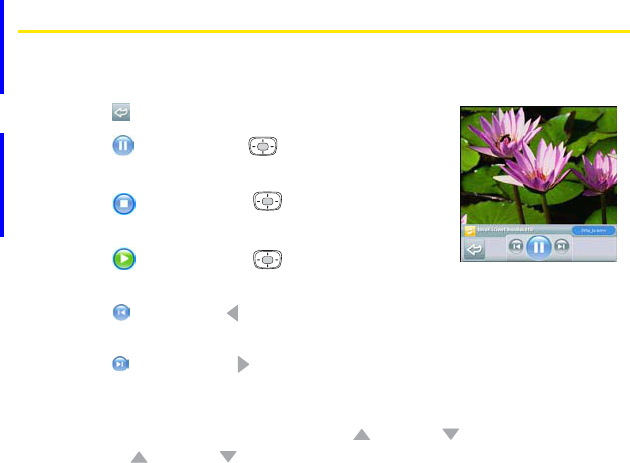
216 Section 4C: Watching Sprint TVSM
Viewing Streamed Media
Once you connect to the server, playback begins immediately. Use the following
controls when viewing or listening to streaming media:
ⅷSelect to return to the channel list.
ⅷSelect or press Center to pause playback of
nonlive content such as videos on demand.
ⅷSelect or press Center to stop playback of
live content.
ⅷSelect or press Center to resume playback
after pausing.
ⅷSelect or press Left to view the channel list with the first channel
highlighted.
ⅷSelect or press Right to view the channel list with the last channel
highlighted.
ⅷA few seconds after playback begins, the toolbar is hidden and you can view
the content on the full screen. Press Up or Down to display the toolbar;
press Up or Down again to hide the toolbar again.
ⅷPress the Volume button on the side of your device to adjust the volume.
FINAL DRAFT Palm, Inc. Confidential

Section 5
Your Mobile Organizer
FINAL DRAFT Palm, Inc. Confidential
218
FINAL DRAFT Palm, Inc. Confidential

Section 5A: Using Your Device’s Organizer Features 219
Organizer Features
Section 5A
Using Your Device’s Organizer Features
In This Section
ࡗContacts
ࡗCalendar
ࡗTasks
ࡗMemos
FINAL DRAFT Palm, Inc. Confidential
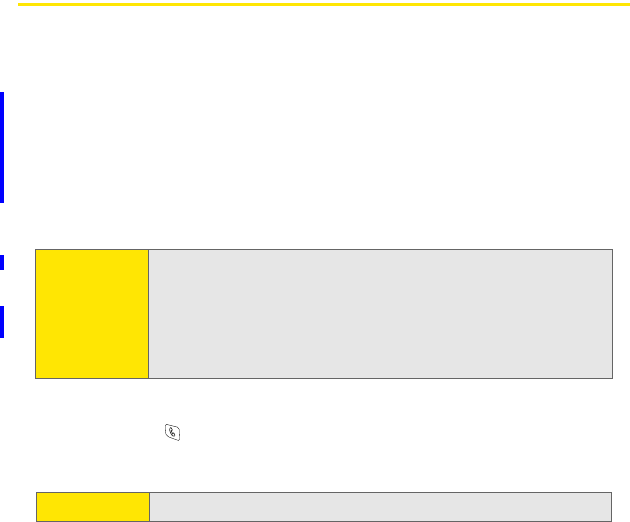
220 Section 5A: Using Your Device’s Organizer Features
Contacts
Contacts is where you enter information about people you know. You can access
this information from the Phone application to dial phone numbers and create
favorites, and from the Messaging and email applications to send messages.
When you create a contact, you can also assign a caller ID picture or ringtone to
that contact, so that you know when that person is calling.
If you have several contacts to enter, it’s more efficient to use Palm® Desktop
software or Microsoft Outlook on your computer and then synchronize
information between your Treo™ 700P smart device and your computer. For more
information, see “Synchronizing Information—The Basics” on page 33.
Adding a Contact
1. Press Phone .
2. Select the Contacts favorite button.
Note: If you use Microsoft Exchange ActiveSync®, your contacts information (as
well as email and calendar information) synchronizes directly with your
company’s Exchange server. You retrieve contacts (and email and
calendar) updates from the server; they are not updated when you
synchronize directly with your computer. See “Getting Messages From
Your Corporate Microsoft Exchange Server Onto Your Device” on
page 141.
Tip: You can also open Contacts from Applications view.
FINAL DRAFT Palm, Inc. Confidential
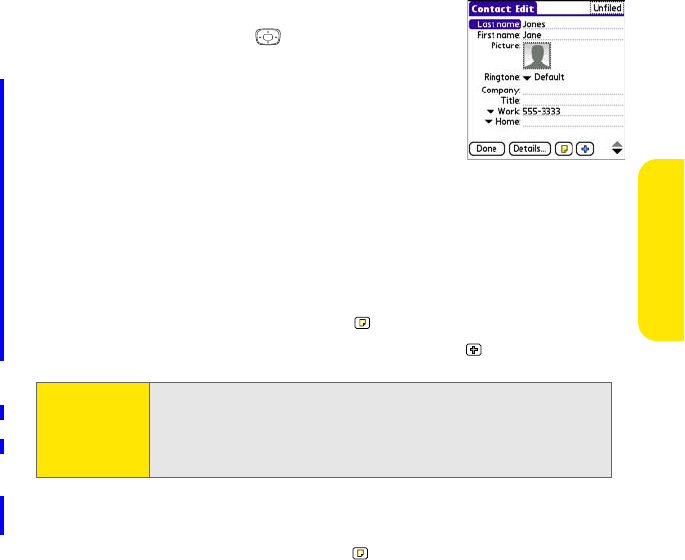
Section 5A: Using Your Device’s Organizer Features 221
Organizer Features
3. Select New Contact.
4. Use the 5-way navigator to move between
fields as you enter information.
5. (Optional) Do any of the following:
ⅢAdd a caller ID photo: Select the Picture box, and
then do one of the following:
ࡗSelect Camera to take a picture and add it to
this contact when you save the picture.
ࡗSelect Photos to add an existing picture to this contact.
ⅢAdd a caller ID ringtone: Select the Ringtone pick list and select a ringtone
from the list to give incoming calls from this contact a distinctive ring.
ⅢPlace the entry in a category or mark it private: Select Details (see “Working
With Private Entries” on page 302 for more information).
ⅢAdd a note to an entry: Select Note .
ⅢDisplay additional fields for this contact: Select Plus .
6. To place the entry in a category or mark it private, select Details (see
“Working With Private Entries” on page 302 for more information).
7. To add a note to an entry, select Note .
Tip: You can assign a ringtone to an entire category of contacts. For example,
use a special ringtone for categories such as Family, Work, or Golf
Buddies. Select the category pick list in the upper-right corner, select Edit
Categories, and then select the category. Select a ringtone on the Edit
Category screen.
FINAL DRAFT Palm, Inc. Confidential
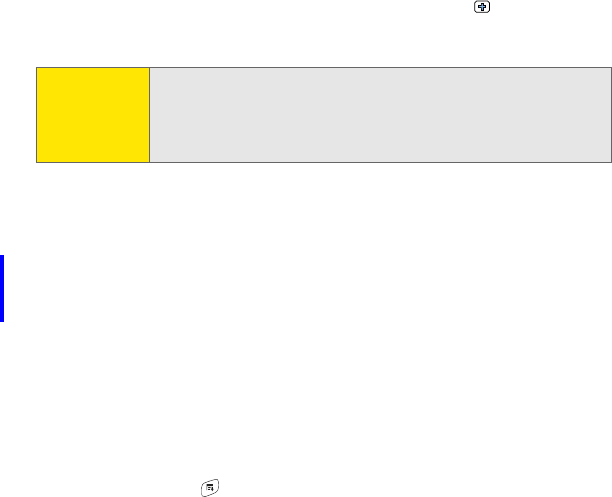
222 Section 5A: Using Your Device’s Organizer Features
8. To display additional fields for this contact, select Plus .
9. After you enter all the information, select Done.
Viewing or Changing Contact Information
1. In the Contacts list, begin entering one of the following for the contact you
want to view or edit:
ⅢFirst name (JOH for John).
ⅢLast name (SMI for Smith).
ⅢFirst initial and last name (JSM for John Smith).
2. Select the name of the entry you want to open.
3. Select Edit.
4. Make changes to the entry as necessary, and then select Done.
Deleting a Contact
1. Open the contact you want to delete.
2. Open the menus .
3. Select Delete Contact on the Record menu.
4. Select OK.
Tip: If you make an outgoing call or receive an incoming call that has caller ID
and the phone number is not associated with a contact in your Contacts
list, you can either create a new contact for that number or add the
number to an existing contact. See “Saving Phone Numbers” on page 70
for details.
FINAL DRAFT Palm, Inc. Confidential

Section 5A: Using Your Device’s Organizer Features 223
Organizer Features
Defining Your Business Card
1. Create a new contact with your own business card information.
2. Open the contact entry containing your business information.
3. Open the menus .
4. Select Select Business Card on the Record menu.
After you define your business card, you can beam it to other Palm OS® devices. In
Contacts or in any Phone view, open the menus and select Beam Business Card
on the Record menu.
FINAL DRAFT Palm, Inc. Confidential
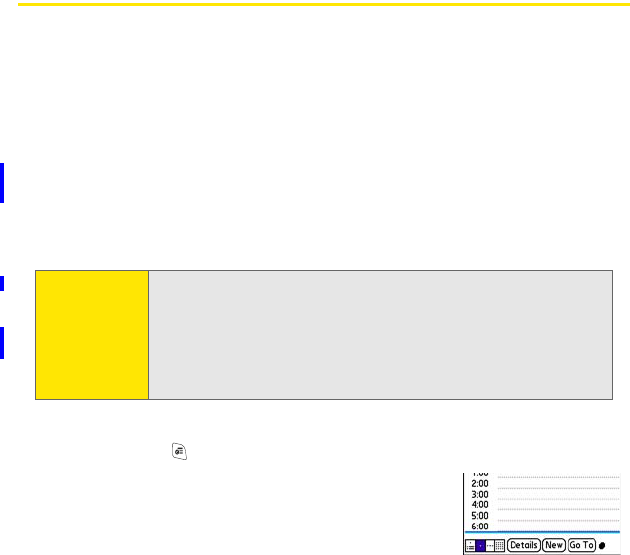
224 Section 5A: Using Your Device’s Organizer Features
Calendar
Calendar is a powerful organizer application that helps you manage your
schedule. You can view your calendar by day, week, or month, or as an agenda list
that combines your list of tasks and email notifications with your appointments.
Schedule repeating meetings or block out a vacation by creating one event set to
repeat at an interval you specify. Color-code your appointments by category and
add notes with helpful information.
If you have several appointments to enter, it’s more efficient to use Palm Desktop
software or Microsoft Outlook on your computer and then synchronize
information between the Treo 700P smart device and your computer. For more
information, see “Synchronizing Information—The Basics” on page 33.
Displaying Your Calendar
ⅷPress Calendar repeatedly to cycle through the various views:
ⅢAgenda View shows your daily schedule and
any items on your Tasks list that are overdue or
Note: If you use Microsoft Exchange ActiveSync®, your calendar information
(as well as email and contacts information) synchronizes directly with
your company’s Exchange server. You retrieve calendar (and email and
contacts) updates from the server; they are not updated when you
synchronize directly with your computer. See “Getting Messages From
Your Corporate Microsoft Exchange Server Onto Your Device” on
page 141.
FINAL DRAFT Palm, Inc. Confidential

Section 5A: Using Your Device’s Organizer Features 225
Organizer Features
due today. If there’s room, Agenda view also shows your schedule for the
next dates that have events scheduled.
ⅢDay View shows your daily schedule one day at a time.
ⅢWeek View shows your schedule for an entire week. The time frames are
based on the Start Time and End Time settings in Calendar Preferences.
ⅢMonth View shows your schedule for a whole month.
ⅷFrom any Calendar view, open the Options menu and select Year View to view a
calendar for an entire year.
ⅷFrom any Calendar view (except Agenda view), use the 5-way navigator or
stylus to move to another day, week, month, or year (based on the
current view).
ⅷFrom any Calendar view (except Agenda view), select Go To, and then select a
date from the calendar.
Tip: You can customize your phone to display the most current Calendar
event on the Main view in the Phone application. Press Phone, open the
Options menu, and then select Phone Display Options. Check the Show
Calendar event box.
FINAL DRAFT Palm, Inc. Confidential
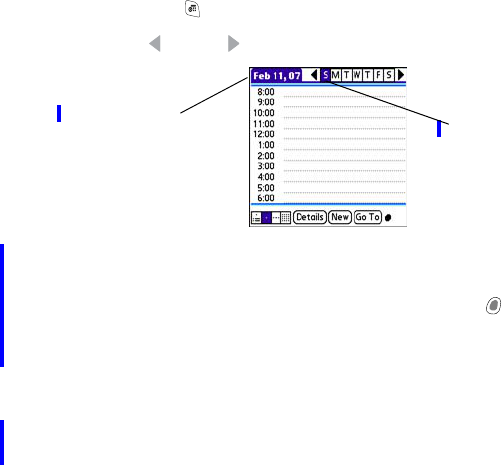
226 Section 5A: Using Your Device’s Organizer Features
Creating an Event
1. Press Calendar until Day view appears.
2. Press Left or Right to select the desired day.
3. Select New.
4. Using the keyboard, enter a starting hour and minute for the event. (For
example, enter 545 for 5:45. Remember to press Option before entering
numbers.)
5. Select the End Time box, and then select the ending hour and minute for the
event.
6. (Optional) To assign a time zone to the event, select the Time Zone pick list
and select a city in the time zone you want.
7. Select OK.
8. Enter a description for the event.
Selected Date Selected Day
FINAL DRAFT Palm, Inc. Confidential

Section 5A: Using Your Device’s Organizer Features 227
Organizer Features
Time Zones and Events
Here are some important points to keep in mind when assigning a time zone to
an event:
ⅷPalm Desktop software does not recognize time zones. If you sync with
Palm Desktop software, you can add time zones to your events, but the start
and end times do not change in Palm Desktop if you go to a different time
zone.
ⅷIf you use Microsoft Outlook, you can use the time zone feature, but you must
install the conduit that came with your Treo 700P smart device (that is, you
must install the desktop software from the Palm Software Installation CD and
select to sync with Outlook) or a subsequent update on all the computers you
synchronize your device with. Chapura PocketMirror and other earlier
Microsoft Outlook conduits do not support time zones.
ⅷTo automatically assign a time zone to your events, open the Options menu,
select Preferences, and check the New events use time zones box. All your new
events will be assigned to your local time zone, and you can change this
setting for individual events. In addition, if you sync with Outlook and you
select the time zone option on the Calendar conduit sync screen, then time
zones will sync for any new events you create in Outlook. Time zone settings
are not added to any events that you created before you set these time zone
settings.
ⅷIf you want your events with time zones to stay at the same time in Calendar,
regardless of the time zone you are in, uncheck the Get time zone from mobile
network box on the Date & Time Preferences screen. If the box is checked, the
event time shifts if you travel to a different time zone. See “Setting the Date
and Time” on page 294 for information.
FINAL DRAFT Palm, Inc. Confidential
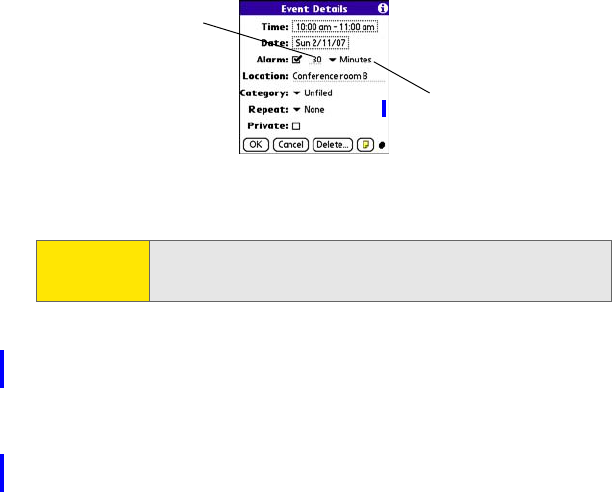
228 Section 5A: Using Your Device’s Organizer Features
Adding an Alarm to an Event
1. In Calendar, select the event.
2. Select Details.
3. Check the Alarm box, and then select the number of minutes, hours, or days
before the event you would like to receive the alarm.
4. Select OK.
When an alarm goes off, an alert is also displayed on the Alert screen. Select an
alert’s description to jump to that item, or check the box to clear that alert. See
“Viewing and Using the Alert Screen” on page 103 for more information.
Creating an Untimed Event
An untimed event is an event that does not occur at a particular time of day—for
example, a holiday or anniversary.
Note: The alarm for untimed events (see “Creating an Untimed Event” on
page 228) is defined by minutes, days, or hours before midnight of the
date of the event.
Number of Time
Units
Type of Time Units
FINAL DRAFT Palm, Inc. Confidential
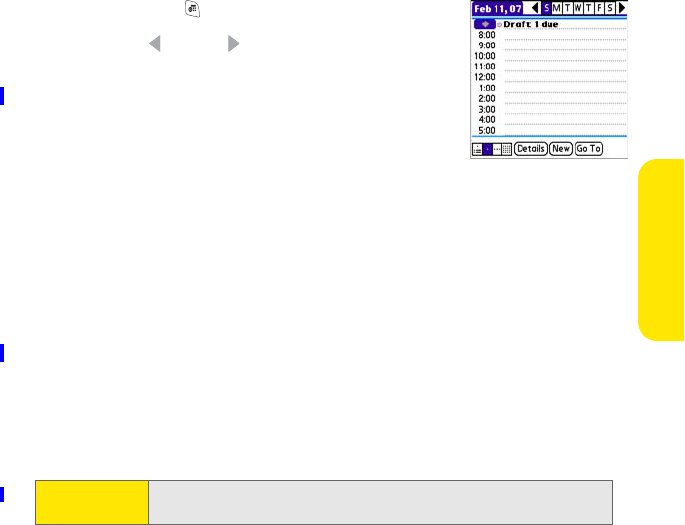
Section 5A: Using Your Device’s Organizer Features 229
Organizer Features
1. Press Calendar until you are in Day view.
2. Press Left or Right to go to the date of the
event.
3. Make sure that no times are highlighted.
4. Enter a description for the event. A diamond
appears next to the description of an untimed
event.
Scheduling a Repeating Event
1. Create an event, and then select it.
2. Select Details.
3. Select the Repeat pick list, and then select a repeat interval. (If the interval
you need doesn’t appear on the list, select Other to define a custom
interval.)
4. For weekly events, select the day(s) the event is repeated; for monthly
events, select Day or Date to indicate the repeating method.
5. If the event has an ending date, select the End on pick list, select Choose
Date, and then select the ending date.
6. Select OK.
Tip: To enter a birthday or anniversary, add the information to the person’s
Contacts entry and it automatically appears in your Calendar.
FINAL DRAFT Palm, Inc. Confidential
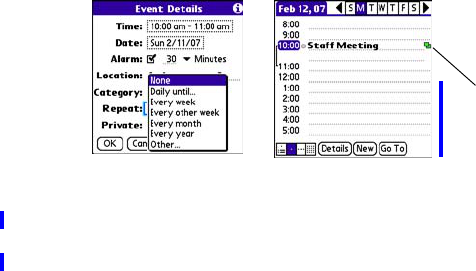
230 Section 5A: Using Your Device’s Organizer Features
Color-Coding Your Schedule
Use color-coding to quickly spot various types of events. For example, make your
appointments with family green, coworkers blue, and friends red. Follow these
steps to create a category and assign it a color code:
1. From Day view, select the event description or select an empty time slot.
2. Select Details.
3. Select the Category pick list, and then select Edit Categories.
4. Do one of the following:
ⅢTo create a new category, select New and then enter a category name.
ⅢTo add a color to an existing category, select a category, and then select
Edit.
5. Select the color you want to give this category, and then select OK.
6. (Optional) Repeat steps 4 and 5 to add or edit more categories.
7. Select OK two more times.
Now that the category is set up, you can assign a specific event to this category.
See the next section for details.
This Icon
Indicates a
Repeating
Event
FINAL DRAFT Palm, Inc. Confidential
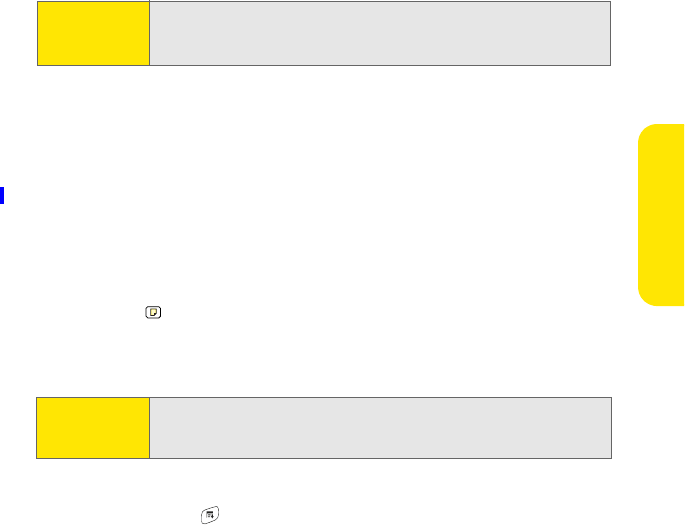
Section 5A: Using Your Device’s Organizer Features 231
Organizer Features
Editing or Deleting an Event
1. Select the event you want to edit or delete.
2. Select Details.
3. In addition to the settings covered earlier in this chapter, you can also
change any of the following settings:
ⅢDate and Time display when the event takes place. Change these
settings to reschedule the event.
ⅢLocation provides space for you to enter a description of where the event
takes place.
ⅢCategory sets the color-coded category for this event.
ⅢNote provides space for you to enter additional text.
ⅢDelete removes the event from your Calendar.
4. Select OK.
Customizing Display Options for Your Calendar
1. Open the menus .
2. Select Options, and then select Display Options.
Tip: To save memory, you can purge your old events. Open the Record menu
and select Purge. Select the Delete events older than pick list and select
a timeframe. Select OK.
Tip: If you synchronize with Microsoft Outlook and your events include other
people, a With field appears in the Details dialog box and your attendee
information appears in this field after you synchronize.
FINAL DRAFT Palm, Inc. Confidential
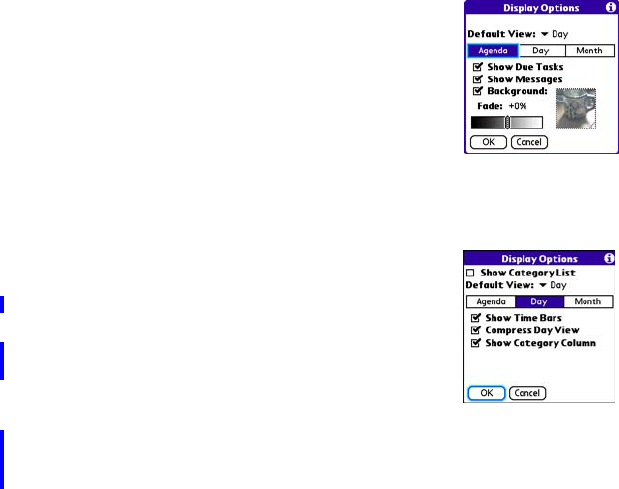
232 Section 5A: Using Your Device’s Organizer Features
3. Select the Default View pick list, and then select the view you want to see
when you open Calendar.
4. Select the Agenda box and set any of the
following Agenda view options:
ⅢShow Due Tasks displays tasks that are due
today and tasks that are overdue.
ⅢShow Messages displays the number of read
and unread email messages.
ⅢBackground displays a favorite picture as the
Agenda view background. Check the
Background box, select the picture thumbnail, and then select a picture.
Adjust the fade setting so that the text is easy to read against the
picture.
5. Select the Day box and set any of the following
Day view options:
ⅢShow Category List displays the category
pick list.
ⅢShow Time Bars activates the time bars that
appear in Day view. The time bars show the
duration of an event and illustrate event
conflicts.
ⅢCompress Day View controls how times appear in Day view. When
Compress Day View is unchecked, all time slots are displayed on the
screen. When it is checked, start and end times are displayed for each
event, but blank time slots toward the bottom of the screen disappear
to minimize scrolling.
FINAL DRAFT Palm, Inc. Confidential
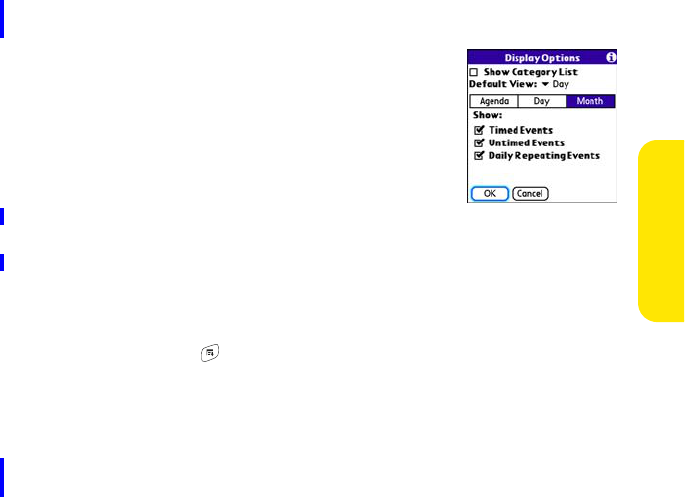
Section 5A: Using Your Device’s Organizer Features 233
Organizer Features
ⅢShow Category Column displays the color-coded category marker
between the time and the description to indicate which category the
event is filed under.
6. Select the Month box and set any of the
following Month view options:
ⅢShow Category List displays the category
pick list.
ⅢTimed Events displays events that are
scheduled for a specific time.
ⅢUntimed Events displays events that are
scheduled for a specific date but not a
specific time.
ⅢDaily Repeating Events displays events that are repeated every day.
7. Select OK.
Selecting Alarm Tones
1. Open the menus .
2. Select Options, and then select Sound Preferences.
3. Select the Application pick list, and then select Calendar.
4. Select the Volume pick list, and then select the volume level.
5. Select the Vibrate pick list, and then select how you want your device to
vibrate for an event alarm.
FINAL DRAFT Palm, Inc. Confidential
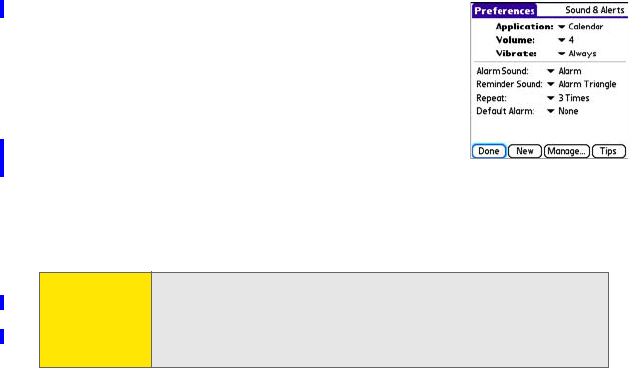
234 Section 5A: Using Your Device’s Organizer Features
6. Select any of the following:
ⅢAlarm Sound sets the tone played the first time
your alarm goes off.
ⅢReminder Sound sets the tone played if an alarm
is not acknowledged and the alarm repeats
itself.
ⅢRepeat indicates how many times the alarm
repeats itself if it is not acknowledged.
ⅢDefault Alarm sets the default number of minutes, hours, or days before
an event that the alarm goes off.
7. Select Done.
Tip: You can also preview, delete, and send sounds that you use as alarms.
From the Sounds & Alerts Preferences screen, select Manage. To play a
sound, select it and press Center on the 5-way. To delete a sound, select
it and press Backspace, and to send a sound, select it and then select
Send.
FINAL DRAFT Palm, Inc. Confidential
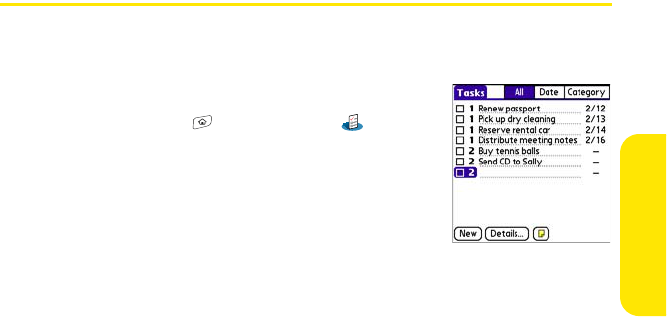
Section 5A: Using Your Device’s Organizer Features 235
Organizer Features
Tasks
You can use the Tasks application to keep track of tasks you need to complete and
to keep a record of completed tasks.
Adding a Task
1. Go to Applications and select Tasks .
2. Select New to create a new task.
3. Enter a description of the task. (The text can be
longer than one line.)
Setting Task Priority, Due Date, and Other Details
The Details dialog box enables you to assign a priority level, due date, category,
privacy flag, and note to each task.
1. Select the task to which you want to assign details.
2. Select Details.
3. Set any of the following:
ⅢPriority sets the Priority number for this task (1 is most important). You
can arrange your tasks based on the importance of each task.
ⅢCategory assigns the task to a specific category.
ⅢDue Date sets the due date for the task. Select the Due Date pick list and
select a due date.
ⅢAlarm sets an alarm for this task.
FINAL DRAFT Palm, Inc. Confidential
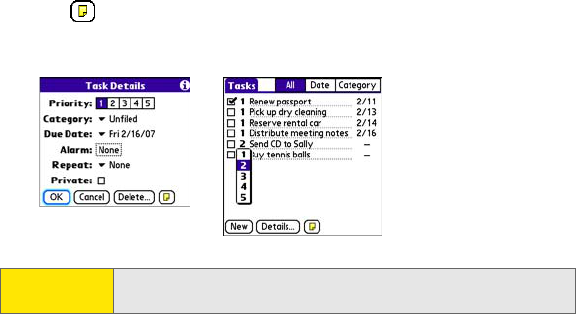
236 Section 5A: Using Your Device’s Organizer Features
ⅢRepeat indicates whether the task occurs at regular intervals and how
often it repeats. When you check off a repeating task, the next instance
of this task automatically appears in your task list.
ⅢPrivate indicates whether the task is private. Check this box to mark this
task private. See “Working With Private Entries” on page 302 for
additional information.
Ⅲ stores additional text you want to associate with the task.
4. Select OK.
Tip: You can also set the priority by tapping the Priority number next to a
task in the Tasks list and then selecting a priority level from the list.
FINAL DRAFT Palm, Inc. Confidential
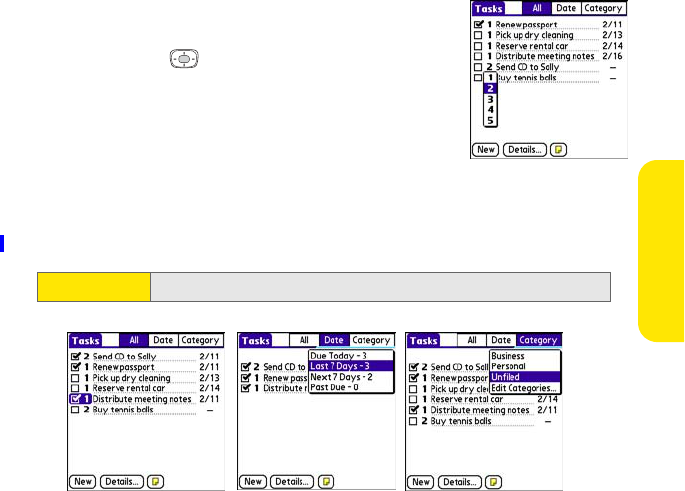
Section 5A: Using Your Device’s Organizer Features 237
Organizer Features
Checking Off a Task
ᮣSelect the task you want to check off, and then
press Center .
Organizing Your Tasks
In the Tasks list, select one of these options:
ⅷAll displays all your tasks.
ⅷDate displays tasks that are due in a specific time
frame. You can select Due Today, Last 7 Days, Next 7 Days, or Past Due.
ⅷCategory displays tasks that are assigned to the selected category. Select the
Category pick list to select a different category.
Tip: Overdue tasks have an exclamation point (!) next to the due date.
FINAL DRAFT Palm, Inc. Confidential

238 Section 5A: Using Your Device’s Organizer Features
Deleting a Task
1. Select the task you want to delete.
2. Open the menus .
3. Select Delete Task on the Record menu.
4. Select OK.
Customizing Tasks
The Tasks Preferences screen enables you to control the appearance of the Tasks
list screen.
1. In the Tasks list screen, open the menus .
2. Select Options, and then select Preferences.
3. Set any of the following preferences:
ⅢSort by indicates the order in which your tasks
appear in the list.
ⅢShow Completed Tasks displays tasks that you’ve
checked off.
ⅢRecord Completion Date replaces the due date
with the completion date when you check off a
task.
ⅢShow Due Dates displays task due dates and inserts an exclamation
point (!) next to overdue tasks.
Tip: To save memory, you can purge all completed tasks. Open the Record
menu, select Purge, and then select OK.
FINAL DRAFT Palm, Inc. Confidential

Section 5A: Using Your Device’s Organizer Features 239
Organizer Features
ⅢShow Priorities displays the priority setting for each task.
ⅢShow Categories displays the category for each task.
ⅢAlarm Sound sets the sound for the alarms you assign to your tasks.
4. Select OK.
FINAL DRAFT Palm, Inc. Confidential
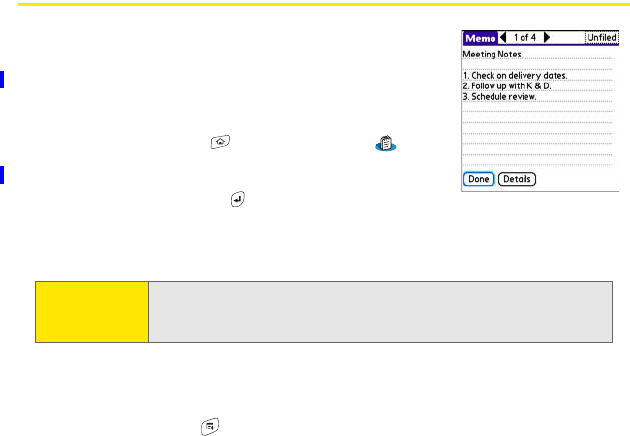
240 Section 5A: Using Your Device’s Organizer Features
Memos
Memos are a great way to store notes on your Treo
device. Each memo can include 4,096 characters
of text.
Creating a Memo
1. Go to Applications and select Memos .
2. Enter the text that you want to appear in the
memo. (Press Return to move down to new
lines in the memo.)
3. Select Done.
Deleting a Memo
1. Select the memo you want to delete.
2. Open the menus .
3. Select Delete Memo on the Record menu.
4. Select OK.
Tip: You can assign categories to your memos. Open the memo you want to
change, select the category pick list at the top of the screen, and then
select a category.
FINAL DRAFT Palm, Inc. Confidential

Section 5B: Increasing Your Productivity 241
Productivity
Section 5B
Increasing Your Productivity
In This Section
ࡗUsing the Documents Application to Work With Your Office Files
ࡗVoice Memo
ࡗWorld Clock
ࡗCalculator
FINAL DRAFT Palm, Inc. Confidential
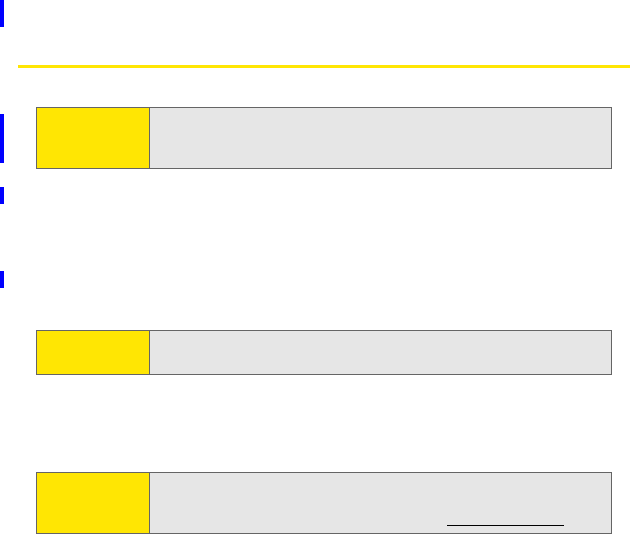
242 Section 5B: Increasing Your Productivity
Using the Documents Application to Work With Your
Office Files
With the Documents application, you can take your important office information
with you. You can carry, create, view, and edit Microsoft Word and Excel files
directly on your device. You can also view, carry, and manage PowerPoint and PDF
files. For example, you can open email attachments, files you download with the
Web browser, and files stored on an expansion card—as long as the files are in a
supported format.
If you install the Documents To Go desktop software (from the Palm Software
Installation CD), you can use Documents To Go to transfer files to your device
when you synchronize.
Tip: The Palm Software Installation CD includes the Documents To Go®
desktop software. On your device, the companion applications for
Documents To Go is named Documents.
Tip: Install the Palm® Files application from the Palm Software Installation
CD to easily browse and manage files on an expansion card.
Note: For complete information on the Documents To Go application, install it
from the Palm Software Installation CD, click the Documents To Go icon
on your computer, and then click Help; or go to www.dataviz.com.
FINAL DRAFT Palm, Inc. Confidential
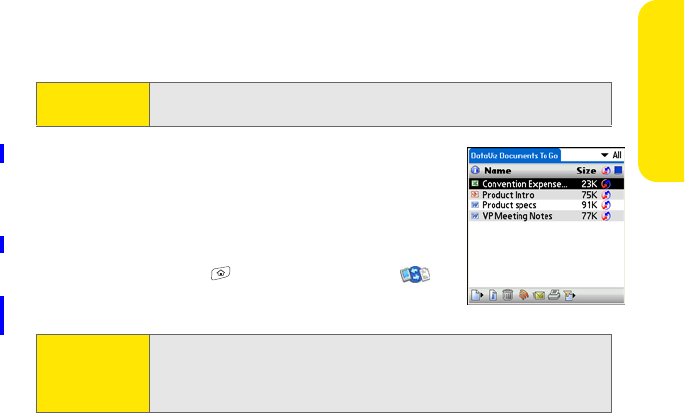
Section 5B: Increasing Your Productivity 243
Productivity
Here are a few more examples of what you can do with Documents:
ⅷSend and receive email attachments in Word, Excel, PowerPoint, and Acrobat
file formats (DOC, XLS, PPT, and PDF).
ⅷView Word, Excel, PowerPoint, and Acrobat files (DOC, XLS, PPT, and PDF).
ⅷCreate or edit a Word-compatible document or Excel-compatible spreadsheet
on your device, and then save it in the native DOC or XLS format.
ⅷCreate a PowerPoint presentation on your computer, use the Documents To Go
desktop application to optimize the file for your device, and then sync the file
onto your device. View or edit the file on your device, and then sync again to
transfer the changes to the original PowerPoint file on your computer.
Opening a Document
In the Documents application, you can open and view
any Word, Excel, PowerPoint, or Acrobat (PDF) file on
your device or on an expansion card that is inserted into
the expansion card slot.
1. Go to Applications and select Documents .
2. Select the document you want from the list.
Note: The Documents application does not support some editing functions,
such as multiple font sizes and spell check.
Tip: When you are working on a file on your device, save it to your device or
your expansion card by opening the menus, selecting Save As from the
File menu, and then selecting the location where you want to save the
file.
FINAL DRAFT Palm, Inc. Confidential

244 Section 5B: Increasing Your Productivity
Voice Memo
Voice Memo provides a place for you to record and play back notes and other
important thoughts directly on your device.
Creating a Voice Memo
1. Press and hold the Side button on your device. Face your device and begin
speaking.
2. After you finish recording, release the Side button. The memo is
automatically saved to your device.
3. (Optional) Enter a title for the memo.
Note: Your recording pauses automatically when you receive a call. If you
answer the call, recording stops and saves the voice memo. If you
have not finished recording, rerecord your memo after hanging up
from the call. If you ignore the call, press Record to resume recording.
Tip: Alternately, open the Voice Memo application, press the Side button to
begin recording, and then press it again when you have finished
recording. If you are recording a long voice memo, you can begin
recording by opening Voice Memo and selecting New. Using this
method, you can press and hold Center on the 5-way to pause recording,
and release Center to resume recording.
FINAL DRAFT Palm, Inc. Confidential
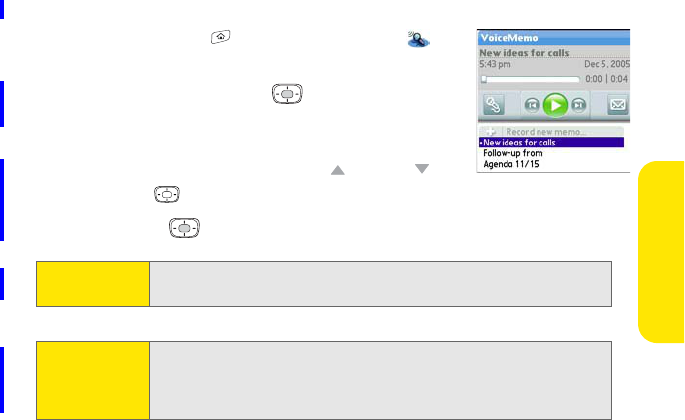
Section 5B: Increasing Your Productivity 245
Productivity
Listening to a Voice Memo
1. Go to Applications and select Voice Memo .
2. In the Voice Memo list, navigate to the voice memo
title and then press Center to select it. The voice
memo begins to play.
3. To set the volume level, press the Volume button on
the side of your device or press Up or Down on
the 5-way .
4. Press Center to pause or stop playback.
Note: To change a voice memo title, open the Voice Memo menu and select
Rename Memo.
Tip: You can send a voice memo in an email message (see “Attaching Voice
Memos” on page 132). You can also use Bluetooth wireless technology
to send a voice memo to a nearby Bluetooth device (see “Sending Entries
Over a Bluetooth® Wireless Connection” on page 261).
FINAL DRAFT Palm, Inc. Confidential
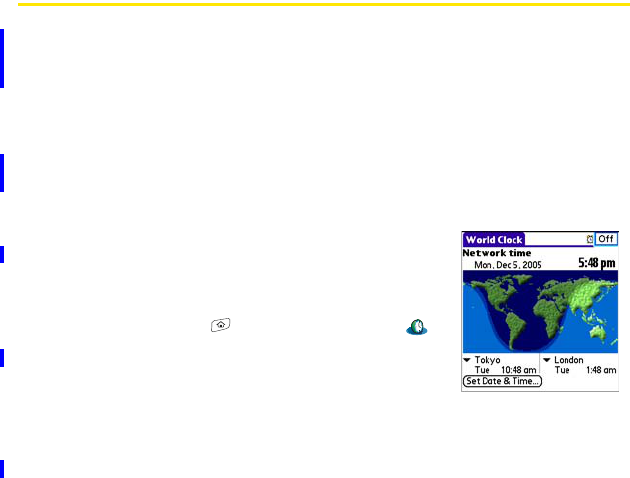
246 Section 5B: Increasing Your Productivity
World Clock
World Clock displays the day and time in three cities anywhere around the globe.
Whether you’re traveling or staying at home, it’s easy to keep track of the best
times to reach your business associates, friends, and family in faraway places.
Setting Cities
World Clock shows the system date and time above the world map. If you
selected the option to get the date and time from the mobile network (see “Set-
ting the Date and Time” on page 294), the Nationwide Sprint PCS® Network auto-
matically updates the time display to match the local time when you travel.
Below the world map you can view the time in two
other cities. If you travel a lot, you may want to select
your home city as one of these two cities, so that you
always know what time it is at home.
1. Go to Applications and select World Clock .
2. Select a city pick list, and then select a city in the
same time zone.
Adding Cities
If the city you want to display is not in the predefined list, you can add it.
1. Select a city pick list, and then select Edit List.
2. Select Add.
3. Select a location in the same time zone as the city you want to add, and
then select OK.
FINAL DRAFT Palm, Inc. Confidential

Section 5B: Increasing Your Productivity 247
Productivity
4. Enter the name of the city.
5. Select Location, select Map, select the location of the city, and then
select OK.
6. If the city is not on Daylight Saving Time, uncheck this box. If Daylight
Saving Time is observed, enter Start and End dates.
7. Select OK.
Setting an Alarm
The next time you travel, don’t rely on a hotel alarm clock to get you to that
important meeting; use your device instead. World Clock includes a built-in alarm
feature that you can use as a travel alarm.
1. Select Off in the upper-right corner.
2. Select the time you want the alarm to sound.
3. Select OK.
World Clock Tips
ⅷRun your stylus over the map to see the time in other cities.
ⅷThe shadow over the map represents nighttime moving across the globe.
Tip: Make sure the Ringer switch is set to Sound On, so that you can hear the
alarm.
Tip: To customize the alarm sound and volume, open the Options menu and
select Alarm Preferences.
FINAL DRAFT Palm, Inc. Confidential
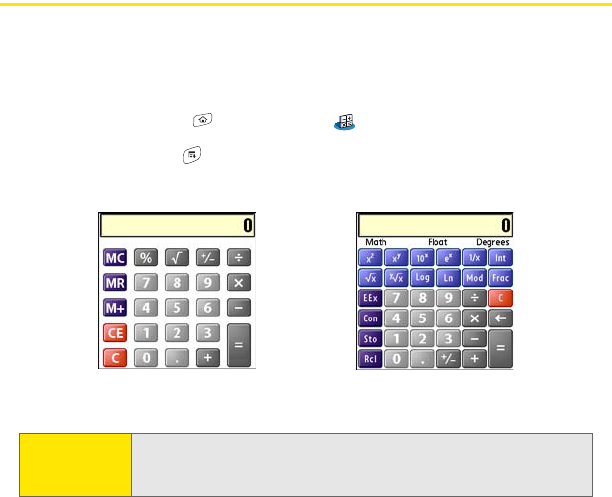
248 Section 5B: Increasing Your Productivity
Calculator
The Calculator application includes a basic calculator, plus an advanced calculator
with scientific, financial, and conversion functions
Switching Between Basic and Advanced Calculator Modes
1. Go to Applications and select Calc .
2. Open the menus .
3. Select Options, and then select Advanced Mode or Basic Mode.
Tip: In Basic Mode, you can also press Right on the 5-way to switch to
Advanced Mode. In Advanced Mode, press Right on the 5-way to cycle
between functions, and press Left on the 5-way to return to Basic Mode.
Basic Mode Advanced Mode
FINAL DRAFT Palm, Inc. Confidential

Section 5B: Increasing Your Productivity 249
Productivity
Selecting Functions in Advanced Calculator Mode
1. Switch to Advanced Calculator Mode (see the preceding procedure).
2. Open the menus .
3. Select Options, and then select the function you want to use:
ⅢMath provides advanced mathematical functions such as exponents,
roots, and logarithms.
ⅢTrig provides trigonometric functions such as sine, cosine, tangent,
and variants.
ⅢFinance provides financial calculator functions such as APR and
amortization.
ⅢLogic displays hexadecimal characters on the keypad, plus logic
functions such as And, Not, Or, and Xor.
ⅢStatistics provides statistical functions such as sum, factorial, and
random number generator.
ⅢWeight/Temp provides weight and temperature conversions for metric
and English values.
ⅢLength provides length conversions for metric and English values.
ⅢArea provides area conversions for metric, traditional, and
English values.
ⅢVolume provides volume conversions for metric and English values.
4. Open the menus .
5. Select Pref, and then select the decimal display format: Float, Fixed (x), Sci (x),
or Eng (x).
FINAL DRAFT Palm, Inc. Confidential

250 Section 5B: Increasing Your Productivity
6. Open the menus .
7. Select Pref, and then select the number display format: Degrees, Radians,
or Grads.
Storing and Recalling Numbers in Advanced Mode
ᮣTo store a number in one of ten memory slots, select Sto.
ᮣTo recall a stored number, select Rcl.
Tip: To access a list of mathematical constants, such as Avogadro’s number
or the speed of light, select Con.
FINAL DRAFT Palm, Inc. Confidential
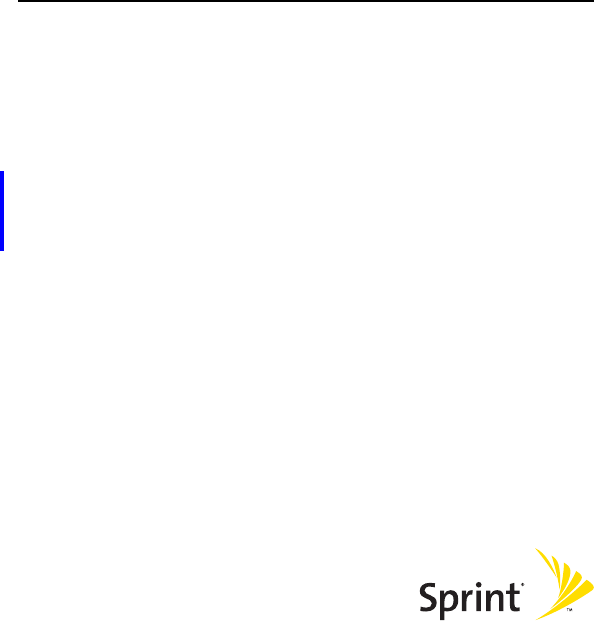
Section 6
Managing Your Information
and Settings
FINAL DRAFT Palm, Inc. Confidential
252
FINAL DRAFT Palm, Inc. Confidential

Section 6A: Managing Files and Applications 253
Managing Files
Section 6A
Managing Files and Applications
In This Section
ࡗUsing Find
ࡗInstalling Applications
ࡗRemoving Applications
ࡗViewing Application Information
ࡗSending Information Using Bluetooth® Wireless Technology
ࡗBeaming Information
ࡗSynchronizing Information—Advanced
ࡗUsing Expansion Cards
FINAL DRAFT Palm, Inc. Confidential
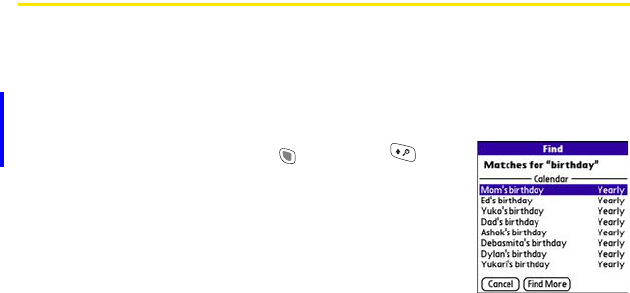
254 Section 6A: Managing Files and Applications
Using Find
The Find feature locates any text in the built-in applications and databases and in
some third-party applications. The Find feature searches for the group of
characters you specify, including characters that are part of a word. Find is not
case-sensitive, and it locates any word that begins with the text you enter. For
example, entering plan finds planet but not airplane.
1. On any screen press Option + Shift/Find
to open the Find dialog box.
2. Enter the text you want to find.
3. Select OK to start the search.
4. In the search results, select the text you want to
review, or select Find More to continue the search.
FINAL DRAFT Palm, Inc. Confidential

Section 6A: Managing Files and Applications 255
Managing Files
Installing Applications
Your Treo™ 700P smart device comes with several built-in and ready-to-use
applications. You can also install additional applications, such as business
software, games, and more. The Palm Software Installation CD includes several
bonus software applications, and you can purchase other third-party Palm OS®
applications as well. To learn about applications you can add to your device, go to
www.palm.com/mytreo700pSprint.
The instructions in this section tell you how to install basic PRC (Palm OS
application) and PDB (Palm OS database) files on your Treo device. Some Palm OS
software uses an installer or wizard to guide you through the process. For details,
consult the documentation that came with the software.
Installing Bonus Software From the CD
The Palm Software Installation CD includes several bonus software applications
that you can install on your device. You can install these applications when you
install the desktop software, or you can install them later.
1. Insert the Palm Software Installation CD into the CD drive on your
computer.
2. Click Install bonus software.
3. Click the name of the application you want to install.
4. Click Install (on the right side of the screen).
5. (Optional) Repeat steps 3 and 4 to install additional applications.
6. Synchronize your device with your computer to install the application(s) on
your device.
FINAL DRAFT Palm, Inc. Confidential

256 Section 6A: Managing Files and Applications
Installing Applications From the Internet
You can use the Web browser on your device to install Palm OS files (PRC or PDB)
directly from the Internet. When you wirelessly download a PRC or PDB file, it is
automatically installed on your device. If a file is compressed (ZIP or SIT files), you
need to download it to your computer and expand the file before installing it on
your device.
1. Open the Web browser (see “Viewing a Web Page” on page 160).
2. Go to the page that contains the link to the application you want to
download.
3. Press Left or Right to highlight the link to the file, and then press
Center to initiate the download process.
4. Follow the onscreen instructions to accept and install the application.
Installing Applications From a Computer
To install an application from a computer, you must first install Palm®Desktop
software from the Palm Software Installation CD that came with your Treo 700P
smart device.
When you download an application to your computer, it is probably in a
compressed format such as a ZIP or SIT file. If the file is compressed, you need to
use a decompression utility on your computer, such as WinZip or Allume StuffIt
Expander, before you install the application on your device.
FINAL DRAFT Palm, Inc. Confidential
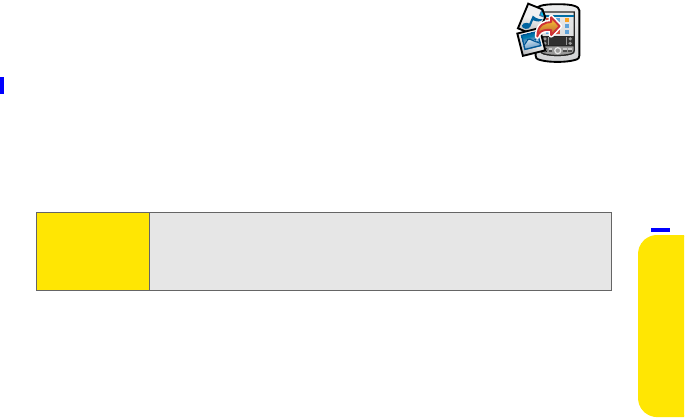
Section 6A: Managing Files and Applications 257
Managing Files
1. On a Windows computer, drag and drop the
application file(s) onto the Palm™ Quick Install icon
on the Windows desktop.
On a Mac computer, drag and drop the application
file(s) onto the Send To Handheld droplet in the Palm
folder.
2. Select your device name from the User list, and then click OK.
3. Synchronize your device with your computer to install the application(s) on
your device.
Getting Help With Third-Party Applications
If you encounter a problem with a third-party application (such as an error
message), contact the application’s author or vendor. For general troubleshooting
of third-party applications, see “Third-Party Applications” on page 347.
Tip: You can open a window that lets you select whether to install files on
your device or on an expansion card. On a Windows computer, double-
click the Palm Quick Install icon. On a Mac computer, open the HotSync
menu and select Install Handheld files.
FINAL DRAFT Palm, Inc. Confidential
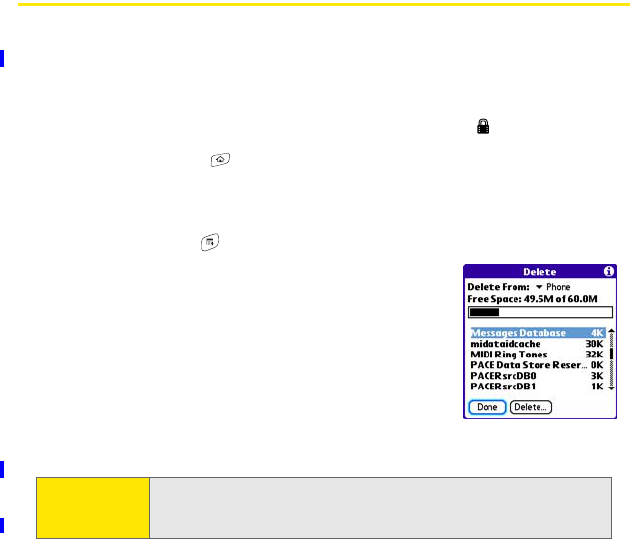
258 Section 6A: Managing Files and Applications
Removing Applications
If you decide that you no longer need an application or you want to free up
memory, you can remove applications from your device or from an expansion
card. You can remove only applications, patches, and extensions that you install;
you cannot remove the built-in applications that reside in the ROM portion of
your Treo device. These applications appear with a lock icon next to them.
1. Go to Applications .
2. If you want to remove an application from an expansion card, insert the
card into your device.
3. Open the menus .
4. Select Delete on the App menu.
5. Select the Delete From pick list and select the
location of the application you want to remove:
Phone or Card.
6. Select the application that you want to remove.
7. Select Delete.
8. Synchronize to remove the application from the
Backup folder on your computer.
Tip: Applications deleted from your device are kept on your computer in the
Archive folder of your user folder. If you’re having trouble locating your
user folder, see “I Can’t Find My User Folder” on page 322.
FINAL DRAFT Palm, Inc. Confidential

Section 6A: Managing Files and Applications 259
Managing Files
Manually Deleting Applications From Your Computer
If an application you delete reappears on your device, you may need to manually
delete it from your computer.
1. Locate your Backup folder on your computer.
ⅢWindows: C:\Program Files\Palm\<Device Name>.
ⅢMac: Mac HD\Applications\Palm\Users\<Device Name>.
ⅢIf you upgraded from a previous version of Palm Desktop, your backup
folder may be located in the palmOne or Handspring folder.
2. If you find a PRC or PDB file for the application you just removed, delete the
file from the Backup folder.
3. Delete the file from your device again.
FINAL DRAFT Palm, Inc. Confidential
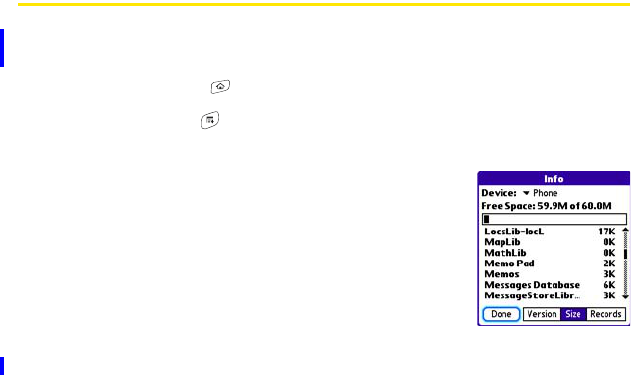
260 Section 6A: Managing Files and Applications
Viewing Application Information
The Info screens display basic statistics about the applications on your
Treo device.
1. Go to Applications .
2. Open the menus .
3. Select Info on the App menu.
4. At the bottom of the screen, select the type of
information you want to view:
ⅢVersion displays the version numbers of your
applications.
ⅢSize displays the size (in kilobytes) of your
applications and information.
ⅢRecords displays the number of entries in your
applications.
5. Scroll to the application you want to see information about.
6. Select Done.
FINAL DRAFT Palm, Inc. Confidential

Section 6A: Managing Files and Applications 261
Managing Files
Sending Information Using Bluetooth® Wireless
Technology
Sending Entries Over a Bluetooth® Wireless Connection
In most applications you can send an individual entry or item such as a contact or
a picture. You can also send all the entries in a category, such as all contacts in the
Business category.
1. Go to Applications and select Bluetooth .
2. Select Bluetooth On.
3. Go to Applications and open the application containing the information
you want to send.
4. Select the entry or category you want to send.
5. Open the menus .
6. Select Send from the leftmost menu.
7. Select Bluetooth, and then select OK.
8. Select the receiving device(s) on the Discovery Results screen, and then
select OK.
Sending an Application Over a Bluetooth Wireless Connection
1. Go to Applications and select Bluetooth .
2. Select Bluetooth On.
3. Go to Applications .
FINAL DRAFT Palm, Inc. Confidential

262 Section 6A: Managing Files and Applications
4. Open the menus .
5. Select Send from the App menu.
6. Select the Send From pick list and select whether the application you want
to send is located on your device or on an expansion card.
7. Select the application you want to transfer. You cannot send an item that
has a lock next to it.
8. Select Send.
9. Select Bluetooth, and then select OK.
10. Select the receiving device(s) on the Discovery Results screen, and then
select OK.
Receiving Information Over a Bluetooth Wireless Connection
1. Go to Applications and select Bluetooth .
2. Select Bluetooth On.
3. Select the Visibility pick list and select one of the following:
ⅢVisible: Enables Bluetooth devices that are not on your Trusted Device list
to request a connection with your device. Your device remains
accessible to other devices until you turn this option off.
ⅢTempora ry: Enables Bluetooth devices that are not on your Trusted Device
list to request a connection with your device during the next two
minutes. Your device reverts to the Hidden setting and becomes
inaccessible to other devices after two minutes.
FINAL DRAFT Palm, Inc. Confidential
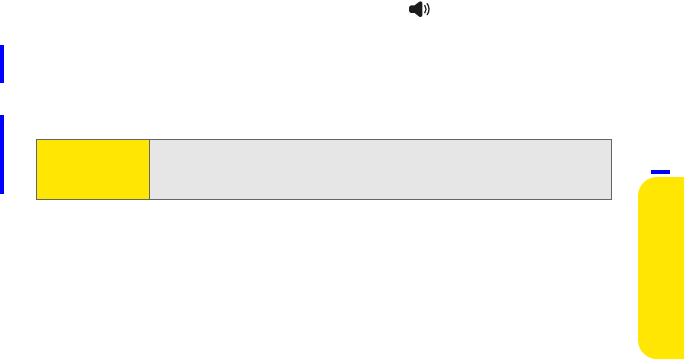
Section 6A: Managing Files and Applications 263
Managing Files
4. Use the other device to discover your Treo device and send information to it:
ⅢSee the other device’s documentation to learn how to discover and send
information over a Bluetooth wireless connection.
ⅢIf the Ringer switch is set to the Sound On position, your Treo device
beeps to notify you of the connection and then prompts you to accept
the information. Select a category or expansion card to file the item. If
you don’t select a category, the item goes into the Unfiled category.
5. Select Yes to receive the information or No to refuse it.
Tip: As a security measure, your Treo device does not accept any information
unless you select Yes to receive the information. To protect your
information, do not accept any information from an unknown sender.
FINAL DRAFT Palm, Inc. Confidential
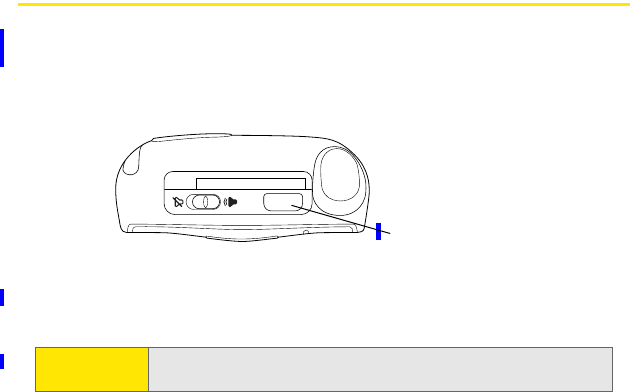
264 Section 6A: Managing Files and Applications
Beaming Information
Your Treo 700P smart device is equipped with an IR (infrared) port that enables
you to beam information to another Palm OS device with an IR port. The IR port is
located on the top of your device, between the Ringer switch and the antenna,
behind the small dark shield.
For best results, the path between the two devices must be clear of obstacles, and
both devices must be kept stationary. If you have difficulty beaming, shorten the
distance and avoid bright sunlight.
Beaming an Entry
You can beam an individual entry or item such as a contact or a picture. You can
also beam all the entries in the selected category, such as all the contacts in the
Business or Family category.
Tip: If you beam a bookmark or a saved page from the Web browser, it beams
the URL, not the contents of that page.
IR Port
FINAL DRAFT Palm, Inc. Confidential
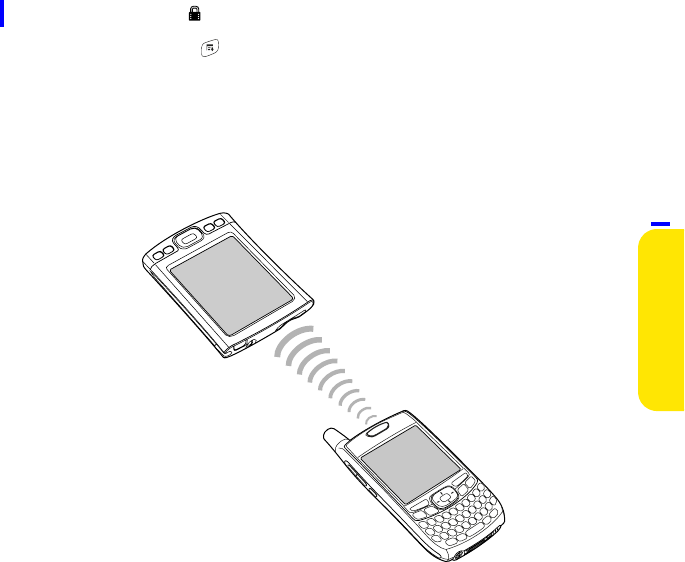
Section 6A: Managing Files and Applications 265
Managing Files
1. Select the entry or category you want to beam. (You cannot beam an item
that has a lock next to it.)
2. Open the menus .
3. Select one of the following on the Record menu:
ⅢBeam sends an individual entry.
ⅢBeam Category sends all entries in the current category.
4. When the Beam Status dialog box appears, point the IR port on your Treo
device directly at the IR port of the receiving device.
FINAL DRAFT Palm, Inc. Confidential
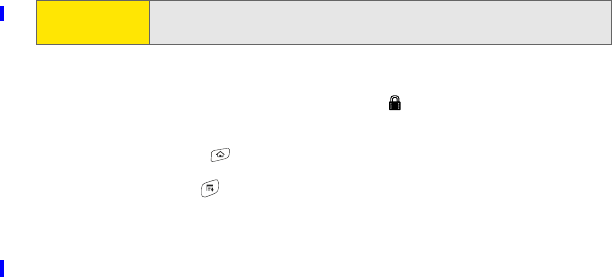
266 Section 6A: Managing Files and Applications
5. Wait for the Beam Status dialog box to indicate that the transfer is complete
before you continue using your Treo device.
Beaming an Application
Not all applications can be beamed. A lock icon appears on the Beam screen
next to applications that cannot be beamed.
1. Go to Applications .
2. Open the menus .
3. Select Beam on the App menu.
4. Select the Beam From pick list and select whether the application you want
to beam is located on your Treo device or on an expansion card.
5. Select the application you want to transfer, and then select Beam.
6. When the Beam Status dialog box appears, point the IR port on your Treo
device directly at the IR port of the receiving device.
7. Wait for the Beam Status dialog box to indicate that the transfer is complete
before you continue using your Treo device.
Tip: You can beam your business card. From the Main view in the Phone
application, open the menus, and then press M.
FINAL DRAFT Palm, Inc. Confidential

Section 6A: Managing Files and Applications 267
Managing Files
Receiving Beamed Information
1. Turn on your screen.
2. Select the beam command on the transmitting device.
3. Point the IR port on your Treo device directly at the IR port of the
transmitting device to open the Beam Status dialog box.
4. When the Beam Status dialog box appears, select a category or expansion
card. (If you don’t select a category, the item goes in the Unfiled category.)
5. Select Yes to receive the information or No to refuse it.
FINAL DRAFT Palm, Inc. Confidential
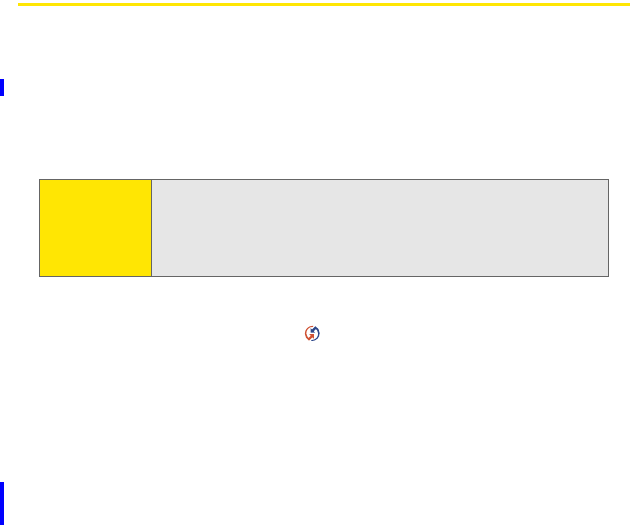
268 Section 6A: Managing Files and Applications
Synchronizing Information—Advanced
Changing Which Applications Sync
By default, information from Calendar, Contacts, Memos, Pics&Videos, and Tasks
is updated each time you synchronize your device with Palm Desktop software or
Microsoft Outlook. You can change which applications synchronize. For example,
if you don’t use the Memos application and you want to speed up
synchronization, you can turn off synchronization for Memos.
On a Windows computer:
1. Click the HotSync manager icon in the taskbar in the lower-right corner of
your screen.
2. Select Custom.
3. Select your device name from the drop-down list at the top of the screen.
4. Select the application for which you want to turn synchronization on or off,
and then click Change.
5. Do one of the following:
ⅢSelect Synchronize the files to turn on synchronization for an application.
Tip: Windows If you set up your device to sync with Outlook, see the
online Outlook synchronization Help to learn how to change which
applications synchronize. Click the HotSync manager icon in the taskbar
in the lower-right corner of your computer screen, and then select
Custom to view the list of applications that sync with Outlook.
FINAL DRAFT Palm, Inc. Confidential
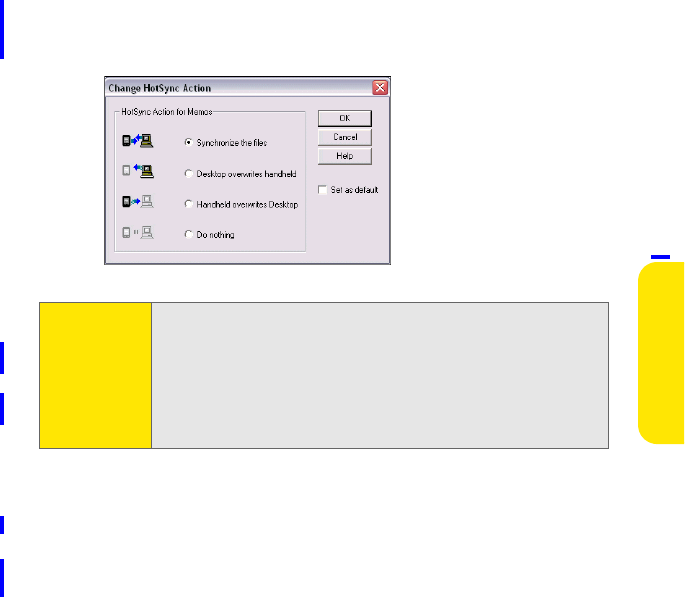
Section 6A: Managing Files and Applications 269
Managing Files
ⅢSelect Do nothing to turn off synchronization for an application that
currently synchronizes (for example, to turn off synchronization for
Memos if you do not use that application).
6. (Optional) Repeat steps 4 and 5 for each application for which you want to
turn synchronization on or off.
7. (Optional) To keep this synchronization setting on an ongoing basis, check
the Set as default box. If you do not check this box, the option you select
applies only the next time you synchronize. Thereafter, information is
updated according to the default setting for that application.
Tip: Select one of the two overwrite options if you want the information in
one location (device or computer) to completely replace the
information in the other location for that application. For example, if
the Calendar information on your device is accurate but the information
on your computer has become corrupted, select Handheld overwrites
desktop for the Calendar application to have your device information
replace your computer information. Note that “handheld” refers to your
device and “desktop” refers to your computer.
FINAL DRAFT Palm, Inc. Confidential
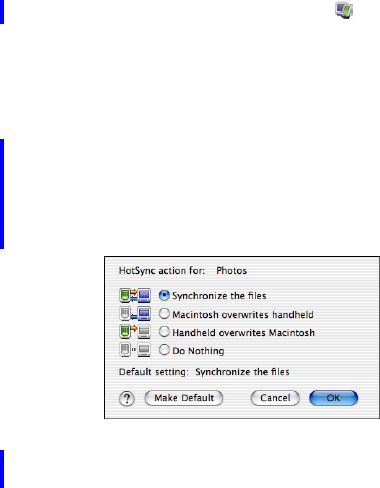
270 Section 6A: Managing Files and Applications
8. Click OK, and then click Done.
On a Mac computer:
1. Double-click the Palm Desktop icon in the Palm folder.
2. From the HotSync menu, select Conduit Settings.
3. From the User pop-up menu, select your device name.
4. Select the application for which you want to turn synchronization on or off,
and then click Conduit Settings.
5. Do one of the following:
ⅢSelect Synchronize the files to turn on synchronization for an application.
ⅢSelect Do nothing to turn off synchronization for an application that
currently synchronizes (for example, to turn off synchronization for
Memos if you do not use that application).
FINAL DRAFT Palm, Inc. Confidential

Section 6A: Managing Files and Applications 271
Managing Files
6. (Optional) Repeat steps 4 and 5 for each application for which you want to
turn synchronization on or off.
7. (Optional) To keep this synchronization setting on an ongoing basis, click
Make Default. If you do not select this button, the option you select applies
only the next time you synchronize. Thereafter, information is updated
according to the default setting for the application.
8. Click OK, and then close the Conduit Settings screen.
Setting Up a Bluetooth Connection for Synchronization
If your computer is enabled with Bluetooth wireless technology, you can
synchronize wirelessly over a Bluetooth connection. When you synchronize using
your device’s Bluetooth wireless feature, you don’t need your cable. This is
especially useful if you travel with a laptop enabled with Bluetooth wireless
technology.
Tip: Select one of the two overwrite options if you want the information in
one location (device or computer) to completely replace the
information in the other location for that application. For example, if
the Calendar information on your device is accurate but the information
on your computer has become corrupted, select Handheld overwrites
Macintosh for the Calendar application to have your device information
replace your computer information. Note that “handheld” refers to your
device.
FINAL DRAFT Palm, Inc. Confidential
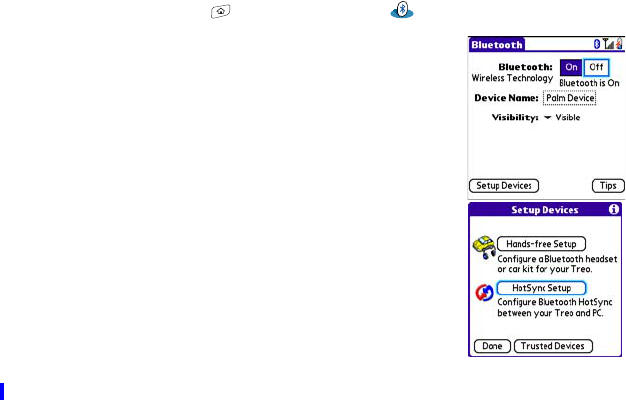
272 Section 6A: Managing Files and Applications
1. Go to Applications and select Bluetooth .
2. Select On.
3. Enter a device name for your Treo device. This is the
name that appears on the other Bluetooth device’s
screen when it connects to your Treo device.
4. Select Setup Devices.
5. Select HotSync Setup.
6. Follow the onscreen instructions to create a
partnership between your Treo device and your
computer. In some cases you may need to perform
setup steps on your computer before you can
complete this step. Check your computer’s
documentation for specific setup instructions.
7. After you finish the HotSync Setup, select Done to
return to Applications view.
You’re now ready to sync your Treo device with your Bluetooth computer.
FINAL DRAFT Palm, Inc. Confidential
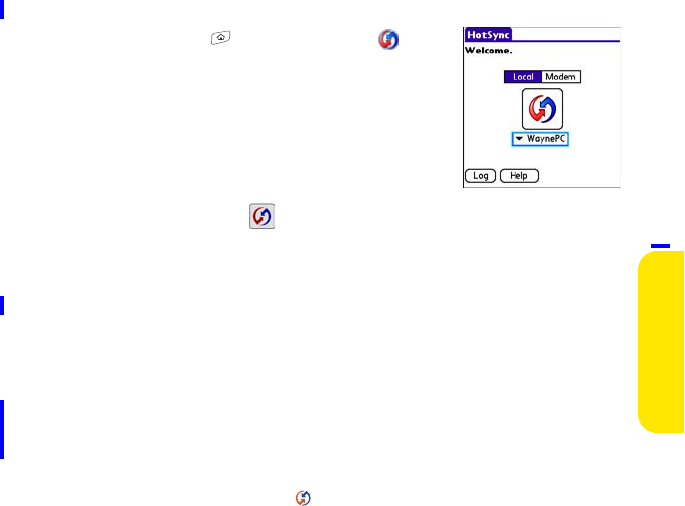
Section 6A: Managing Files and Applications 273
Managing Files
Synchronizing Over a Bluetooth Connection
1. Go to Applications and select HotSync .
2. Select Local.
3. Select the pick list below the HotSync icon, and
then select the name of the PC you set up for
Bluetooth synchronization (see “Setting Up a
Bluetooth Connection for Synchronization” on
page 271).
4. Select the HotSync icon on your device.
When synchronization is complete, a message appears at the top of your device
screen. Be patient; synchronization may take a few minutes.
Synchronizing Over an Infrared Connection
When you synchronize using your device’s IR port, you don’t need your cable. This
is especially useful if you travel with an IR-enabled laptop.
Your computer must include the following:
ⅷYour computer must have an enabled IR port and driver, or an IR device that is
attached to it. Check your computer’s documentation to see if the computer
supports IR communication.
ⅷHotSync manager must be active. On a Windows computer, you know HotSync
manager is active when its icon appears in the lower-right corner of your
screen.
FINAL DRAFT Palm, Inc. Confidential
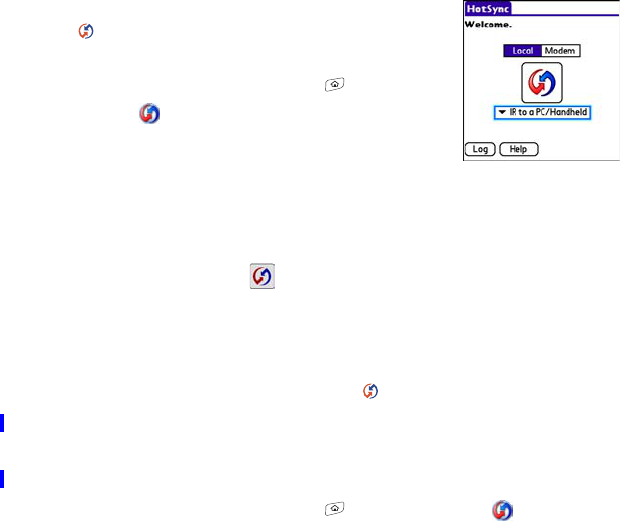
274 Section 6A: Managing Files and Applications
On a Windows computer:
1. On your computer, click the HotSync manager icon
in the taskbar in the lower-right corner of your
screen. Make sure that Infrared is selected.
2. On your device, go to Applications and select
HotSync .
3. Select Local.
4. Select the pick list below the HotSync icon and
select IR to a PC/Handheld.
5. Position the IR port of your device within a few inches of the IR port of your
computer.
6. Select the HotSync icon on your device.
When synchronization is complete, a message appears at the top of your device
screen. Be patient; synchronization may take a few minutes.
On a Mac computer:
1. Double-click the HotSync manager icon in the Palm folder.
2. From the HotSync Controls tab, select Enabled.
3. Click the Connection Settings tab, and then check the On box next to IR port.
4. Close the HotSync Software Setup screen.
5. On your device, go to Applications and select HotSync .
6. Select Local.
FINAL DRAFT Palm, Inc. Confidential
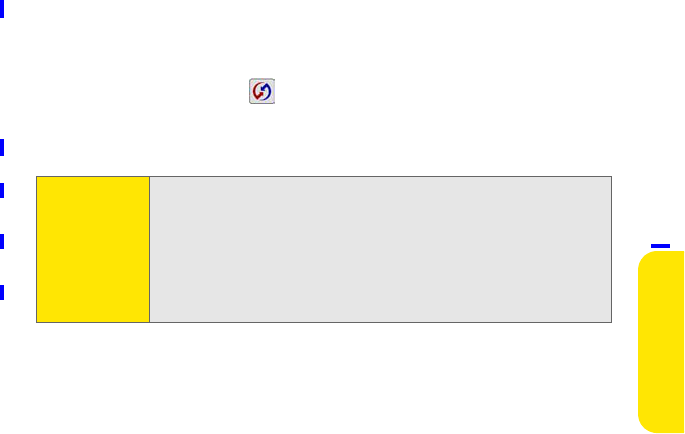
Section 6A: Managing Files and Applications 275
Managing Files
7. Select the pick list below the HotSync icon, and select IR to a PC/Handheld.
8. Position the IR port of your device within a few inches of the IR port of your
computer.
9. Select the HotSync icon on your device.
When synchronization is complete, a message appears at the top of your device
screen. Be patient; synchronization may take a few minutes.
Note: If you use Microsoft Exchange ActiveSync®, your email, contacts, and
calendar information synchronize directly with your company’s
Exchange server. This information synchronizes wirelessly with the
server; it is not updated when you synchronize directly with your
computer. See “Getting Messages From Your Corporate Microsoft
Exchange Server Onto Your Device” on page 141. Your tasks and memos
continue to synchronize with Palm Desktop software or Microsoft
Outlook, depending on which desktop application you use.
FINAL DRAFT Palm, Inc. Confidential

276 Section 6A: Managing Files and Applications
Using Expansion Cards
The expansion slot on your Treo device enables you to add SD cards and
MultiMediaCard cards to extend the storage capacity of your device. For example,
SD cards and MultiMediaCard cards can store the following:
ⅷPictures
ⅷMP3 audio files
ⅷEmail attachments
ⅷGames
ⅷeBooks
ⅷMicrosoft Office files
ⅷAdobe Acrobat files
ⅷApplications
ⅷDatabases
Your Treo device is also compatible with SDIO cards, which let you add
accessories, such as a presentation module, to your device.
Although expansion cards are sold separately, your device includes a dummy,
nonfunctional card inside the expansion slot to keep out dust and other debris.
When you’re not using an expansion card, reinsert the dummy card to keep the
expansion card slot clean.
Tip: SD cards are faster than MultiMediaCard cards for reading and writing
information.
FINAL DRAFT Palm, Inc. Confidential
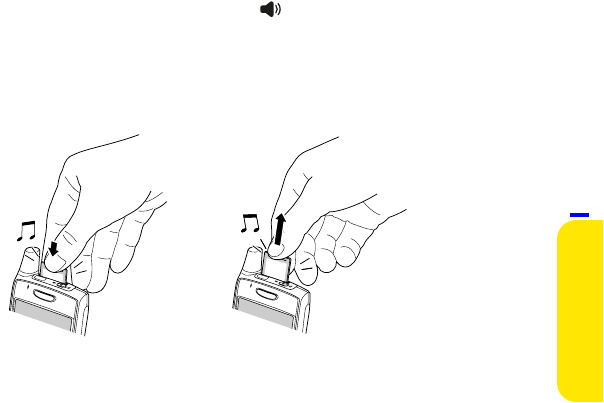
Section 6A: Managing Files and Applications 277
Managing Files
Inserting and Removing Expansion Cards
If the Ringer switch is set to the Sound On position, you hear a confirmation
tone when you insert or remove an expansion card.
1. Press down and release the dummy card.
2. After you feel the expansion slot eject the dummy card, remove the card
from the expansion slot.
3. Hold your device with the screen facing you, and hold the card with the
label facing you. (The notch on the card should be in the lower-left corner
next to the antenna.)
FINAL DRAFT Palm, Inc. Confidential
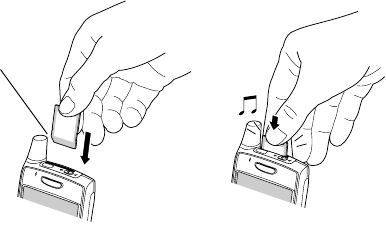
278 Section 6A: Managing Files and Applications
4. Insert the card into the expansion slot until you feel the card lock into place.
Notch
FINAL DRAFT Palm, Inc. Confidential
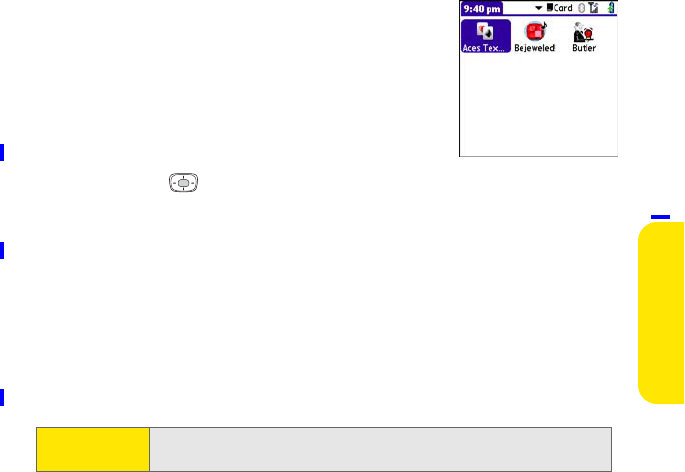
Section 6A: Managing Files and Applications 279
Managing Files
Opening Applications on an Expansion Card
After you insert an expansion card into the expansion
card slot, you can open any of the applications stored
on the expansion card.
1. Insert the expansion card into the expansion
slot. Applications view automatically appears.
2. Select the icon for the application you want
to open.
3. Press Center to open the application.
Accessing Items Stored on an Expansion Card
When an expansion card contains items such as pictures or songs, you can access
those items directly from the card.
1. Insert the expansion card into the expansion card slot. Applications view
automatically appears.
2. Select the category pick list in the title bar, and then select All.
3. Select the icon for the application in which you want to open the item. For
example, to view a picture, select Pics&Videos.
Tip: Install the Palm® Files application from the Palm Software Installation
CD to easily browse and manage files on an expansion card.
FINAL DRAFT Palm, Inc. Confidential
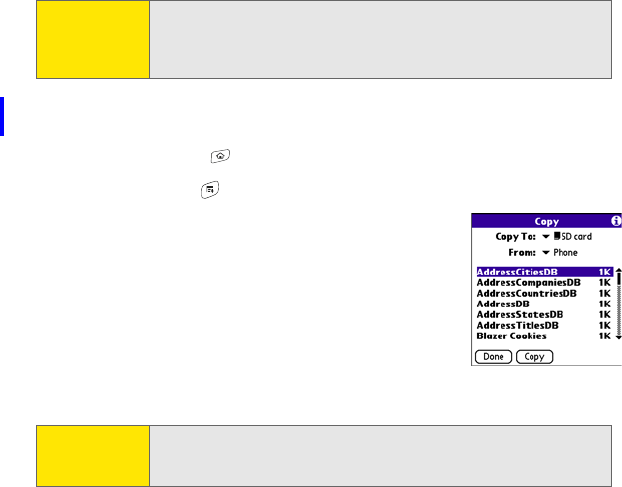
280 Section 6A: Managing Files and Applications
Copying Applications Between an Expansion Card and Your Device
You can copy applications between your Treo device and your expansion card.
1. Make sure the card is not write-protected. (For details, see the instructions
that came with your card.)
2. Go to Applications .
3. Open the menus .
4. Select Copy on the App menu.
5. Select the Copy To pick list and select the
destination: <card name> or Phone.
6. Select the From pick list and select the location
of the application you want to copy: <card name>
or Phone.
7. Highlight the application you want to copy.
8. Select Copy.
Tip: Before you copy an application to an expansion card, make sure that it is
compatible with Palm OS software version 5.4.5 or later. Some
applications do not work with expansion cards and do not allow you to
store files in a location that is separate from the application.
Tip: You can install an application directly to an expansion card instead of
copying it from your device’s main memory. See “Installing Applications”
on page 255 for details.
FINAL DRAFT Palm, Inc. Confidential
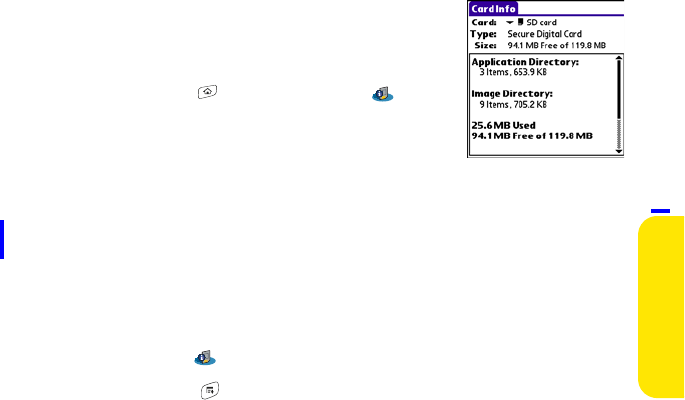
Section 6A: Managing Files and Applications 281
Managing Files
Viewing Expansion Card Information
The Card Info application displays general information
about the expansion card that is currently in the
expansion slot, and it enables you to rename and
format a card.
ⅷGo to Applications and select Card Info .
Renaming an Expansion Card
If you change the contents of an expansion card, you
may at some point want to rename the card to better
match its contents.
1. Make sure the card is not write-protected. (For details, see the instructions
that came with your card.)
2. Insert the expansion card into the expansion slot. Applications view
automatically appears.
3. Select the category pick list at the top of the screen, and then select All.
4. Select Card Info .
5. Open the menus .
6. Select Rename Card on the Card menu.
7. Enter a new name for the card.
8. Select OK.
FINAL DRAFT Palm, Inc. Confidential

282 Section 6A: Managing Files and Applications
Formatting an Expansion Card
Formatting an expansion card is similar to formatting a disk on a computer.
When you format an expansion card, you erase all the information stored on the
card and return it to a blank state.
1. Make sure the card is not write-protected. (For details, see the instructions
that came with your card.)
2. Insert the card into the expansion slot. Applications view
automatically appears.
3. Select the category pick list at the top of the screen, and then select All.
4. Select Card Info .
5. Open the menus .
6. Select Format Card on the Card menu.
7. Enter a new name for the card.
8. Select OK.
FINAL DRAFT Palm, Inc. Confidential

Section 6B: Customizing Your Device 283
Customizing
Section 6B
Customizing Your Device
In This Section
ࡗSetting System Sounds
ࡗAdjusting the Display and Appearance
ࡗChanging the Applications Settings
ࡗCustomizing Device Buttons
ࡗSetting the Date and Time
ࡗOptimizing Power Settings
ࡗLocking Your Device and Information
ࡗUsing Connection Settings
ࡗPurchasing Accessories for Your Device
FINAL DRAFT Palm, Inc. Confidential
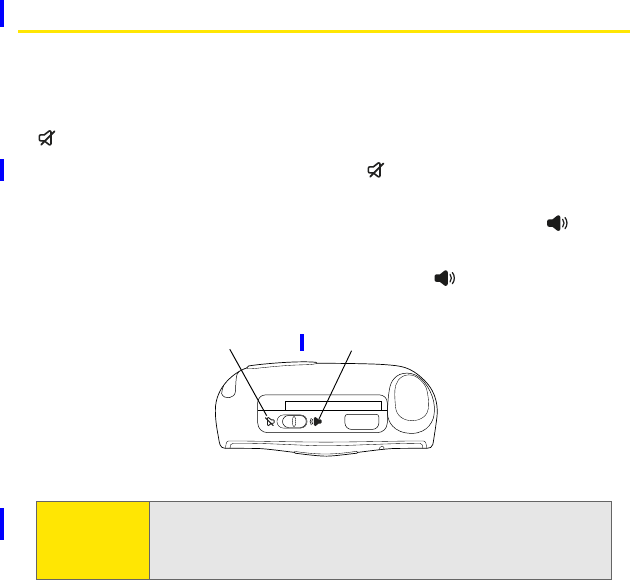
284 Section 6B: Customizing Your Device
Setting System Sounds
Silencing Sounds
You can immediately silence all alerts, ringtones, music that plays through the
built-in speaker, and system sounds by sliding the Ringer switch to the Sound Off
position. This does not, however, mute the audio during a phone call.
1. Slide the Ringer switch to the Sound Off position. Your device vibrates
once to let you know that you’ve turned sounds off.
2. To hear all sounds again, slide the Ringer switch to the Sound On
position.
When you slide the Ringer switch back to the Sound On position, it restores the
previous sound settings.
Tip: Your device includes a silent alarm that can vibrate even when the Ringer
switch is set to Sound Off. For information on setting the vibrate option,
see the section on setting alert tones in the chapters that describe the
individual applications.
Sound On
Sound Off
FINAL DRAFT Palm, Inc. Confidential
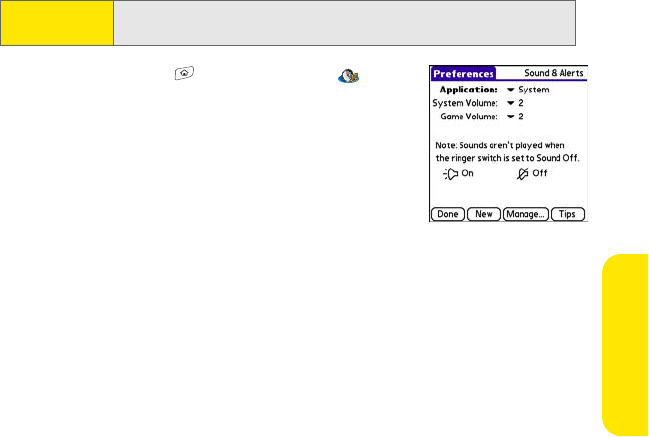
Section 6B: Customizing Your Device 285
Customizing
Setting System Volume Levels
You can set the volume level for system sounds, such as the tone that plays when
you synchronize.
1. Go to Applications and select Sounds .
2. Select the Application pick list, and then select
System.
3. Select the System Volume and Game Volume pick
lists, and then select the volume levels.
4. Select Done.
Tip: If the Ringer switch is set to the Sound Off position, the ringer setting
overrides the sound settings and all sounds are turned off.
FINAL DRAFT Palm, Inc. Confidential
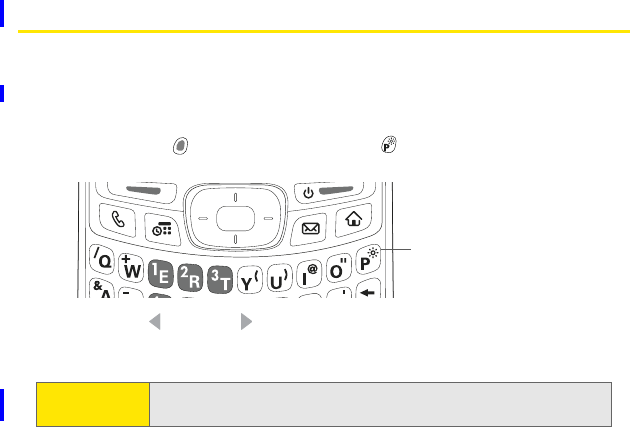
286 Section 6B: Customizing Your Device
Adjusting the Display and Appearance
Adjusting the Brightness
Depending on the lighting conditions in which you’re using your device, you may
need to adjust the brightness of the screen and keyboard backlight.
1. Press Option , and then press Backlight .
2. Press Left and Right to adjust the brightness.
3. Select Done.
Tip: To automatically set the brightness to the low setting, press Option, and
then press Menu.
Backlight
FINAL DRAFT Palm, Inc. Confidential
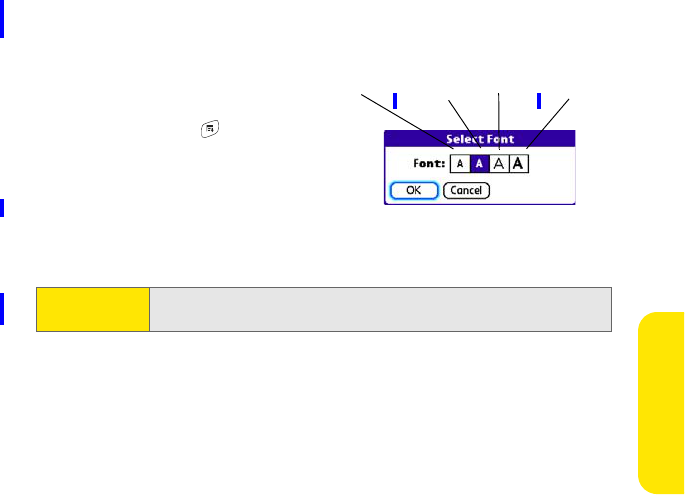
Section 6B: Customizing Your Device 287
Customizing
Changing the Screen Font
You can change the screen font in Calendar, Contacts, Memos, Messaging, Tasks,
and the Web browser. The font styles may vary between applications, and some
applications may offer fewer choices.
1. Open the application in which
you want to change the font.
2. Open the menus .
3. Select Options, and then
select Font.
4. Select a font style. (In the Web
browser, select the Font size pick list and select Large or Small.)
5. Select OK.
Tip: You can also change the text size in the VersaMail® application. See the
User Guide for the VersaMail Application.
Small Large Large
Bold
Small
Bold
FINAL DRAFT Palm, Inc. Confidential

288 Section 6B: Customizing Your Device
Setting Display Formats
Formats Preferences enable you to select number conventions based on
geographic regions. For example, in the United Kingdom, time often is expressed
using a 24-hour clock. In the United States, time is expressed using a 12-hour
clock with an AM or PM suffix. Many of the built-in applications on your Treo™
700P smart device use the Formats Preferences settings.
1. Go to Applications and select Prefs .
2. Select Formats.
3. Set any of the following preferences:
ⅢPreset to sets the standard number
conventions for your country. When you
select a country, the other Formats
Preferences are automatically set to that
country’s conventions. You can also edit each
option individually.
ⅢTime sets the time format. Select HH:MM to display a 24-hour clock.
ⅢDate sets the date format.
ⅢWeek starts sets the first day of the week (usually Sunday or Monday).
ⅢNumbers sets the format for numbers with decimal points and commas.
4. Select Done.
FINAL DRAFT Palm, Inc. Confidential
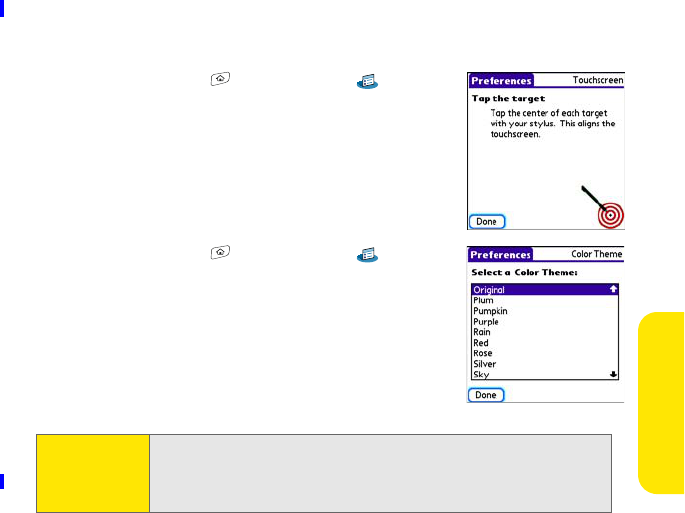
Section 6B: Customizing Your Device 289
Customizing
Aligning the Screen
Occasionally, your device screen may need to be readjusted. If this occurs, you
may see the wrong feature being activated when you tap the screen. To fix the
problem, you can realign the screen any time.
1. Go to Applications and select Prefs .
2. Select Touchscreen.
3. Follow the onscreen instructions to tap the screen
where indicated.
4. Select Done.
Changing the System Color Scheme
1. Go to Applications and select Prefs .
2. Select Color Theme.
3. Select a color scheme from the list.
4. Select Done.
Tip: You can also set the wallpaper for the Main view in the Phone
application (see “Customizing the Main View in the Phone Application”
on page 92) and the background for Agenda view in Calendar (see
“Customizing Display Options for Your Calendar” on page 231).
FINAL DRAFT Palm, Inc. Confidential
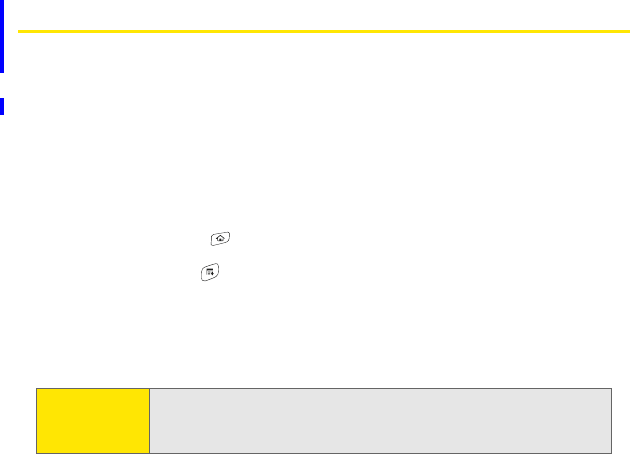
290 Section 6B: Customizing Your Device
Changing the Applications Settings
You can change the Applications settings on your device so that you can easily
access the applications you use most often. You can arrange and display your
applications by category, reassign the buttons on your device, and select default
applications for specific tasks.
Arranging Applications by Category
You can assign an application to a category and then display a specific category of
applications in Applications view.
1. Go to Applications .
2. Open the menus .
3. Select Category on the App menu.
4. Select the pick list next to each application and select a category.
5. Select Done.
Tip: To create a new category, select the category pick list and select Edit
Categories. Select New, and then enter the category name. Select OK to
close the dialog box, and then select OK again.
FINAL DRAFT Palm, Inc. Confidential

Section 6B: Customizing Your Device 291
Customizing
Displaying Applications by Category
Do one of the following:
ⅷPress Applications repeatedly to cycle through all your categories.
ⅷSelect the category pick list at the top of the screen and select the category
you want to display. Select All to display all of your applications.
Selecting the Applications Display
By default, Applications view displays each application as an icon. As an
alternative, you can view a list of applications. The list view is particularly useful
when you have so many applications in a category that the applications fill up
more than one screen.
1. Go to Applications .
2. Open the menus .
3. Select Options, and then select Preferences.
4. Select the View By pick list, and then select List.
5. Select OK.
FINAL DRAFT Palm, Inc. Confidential
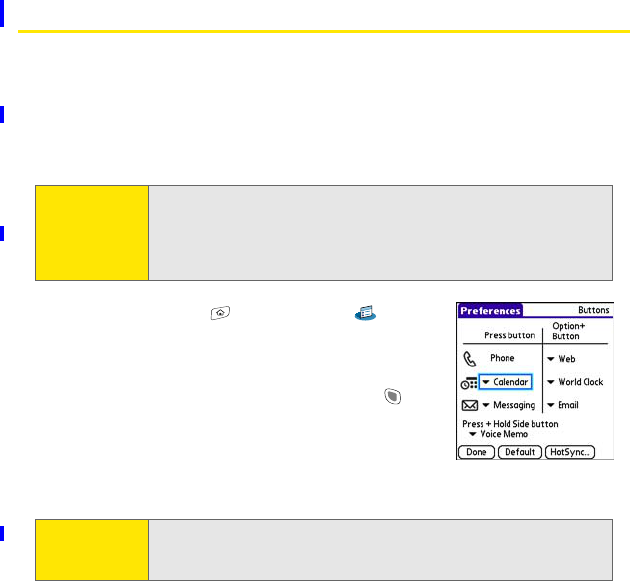
292 Section 6B: Customizing Your Device
Customizing Device Buttons
Reassigning Buttons
With Buttons Preferences you can select which applications are associated with
the quick buttons and the Side button on your device. You can assign a primary
and secondary application to each of the three quick buttons that open an
application.
1. Go to Applications and select Prefs .
2. Select Buttons.
3. Select the pick list next to the icon of the button
you want to reassign, or select the Option +
Button combination you want to reassign, or
select the Press + Hold Side button pick list, and
then select an application.
4. Select Done.
Tip: We recommend that you keep the primary button assignments on the
factory settings until you become comfortable with the features of your
device. If you do change the primary button assignments, remember
that the instructions in this guide and in the other help features refer to
the original button settings.
Tip: You can also select HotSync to choose an application to open with the
sync button on the sync cable. To restore all of the buttons and key
combinations to their factory settings, select Default.
FINAL DRAFT Palm, Inc. Confidential
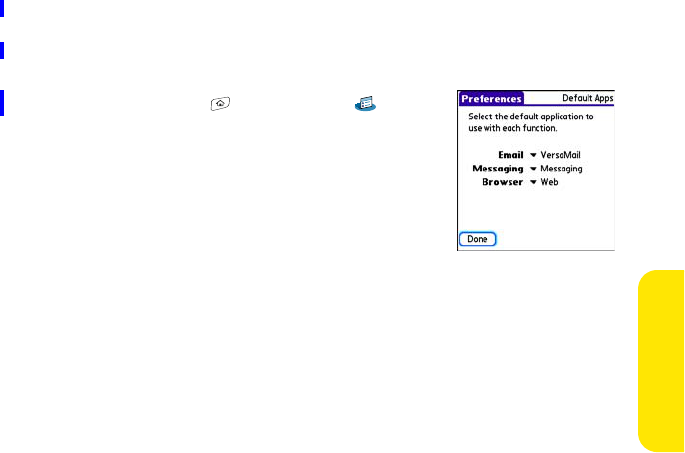
Section 6B: Customizing Your Device 293
Customizing
Changing Default Applications
Sometimes one application looks for another application to handle information
(for example, a mail application might open a browser when you select a link in
an email message). Your device comes with a set of predefined applications to
handle email, messaging, and browser requests from other applications. If you
have more than one application to handle these requests on your device, you can
specify which application you want to use for each function.
1. Go to Applications and select Prefs .
2. Select Default apps.
3. Select each pick list, and then select the
application you want to associate with that
function.
4. Select Done.
FINAL DRAFT Palm, Inc. Confidential
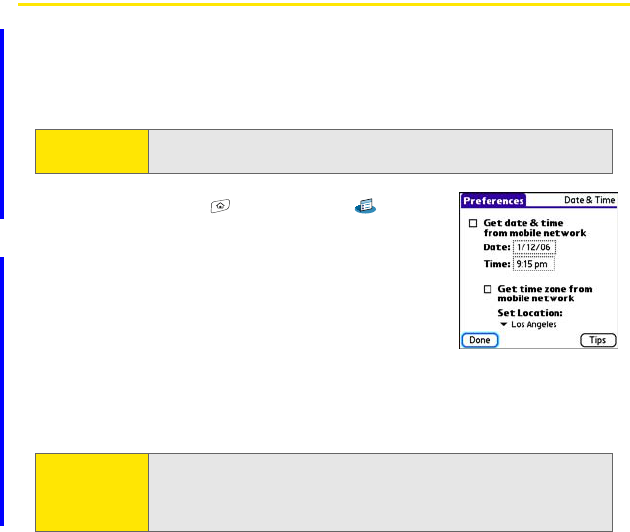
294 Section 6B: Customizing Your Device
Setting the Date and Time
By default, your device synchronizes the date, time, and time zone with the
Nationwide Sprint PCS® Network when your device is on and you are inside a
coverage area. Date & Time Preferences let you manually set the date, time, and
time zone for your device.
1. Go to Applications and select Prefs .
2. Select Date & Time.
3. To manually set the date and time, uncheck the
Get date & time from mobile network box. Select
the Date field and select the date, and then select
the Time field and select the time.
4. To manually set the time zone, uncheck the Get
time zone from mobile network box. If you uncheck the Get date & time box,
the Get time zone box is unchecked by default. Select the Set Location pick
list, and then select a city in your time zone.
Note: You can also add time zones to events you create in Calendar. See
“Creating an Event” on page 226 for information.
Note: If you uncheck the Get date & time box, the Get time zone box is disabled
and you cannot have the Nationwide Sprint PCS Network automatically
set the time zone. However, you can choose to have the network set the
date and time while you manually set the time zone.
FINAL DRAFT Palm, Inc. Confidential

Section 6B: Customizing Your Device 295
Customizing
5. Select OK, and then select Done.
Note: If a city in the same time zone is not on the list, select Edit List, select Add,
select a city in your time zone, and then select OK. If necessary, modify
any of the settings in the Edit Location dialog box, and then select OK.
FINAL DRAFT Palm, Inc. Confidential
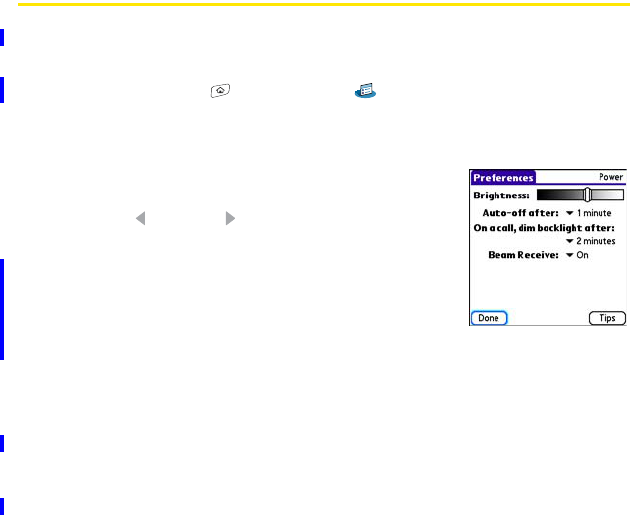
296 Section 6B: Customizing Your Device
Optimizing Power Settings
Power Preferences enable you to adjust settings to maximize your device’s battery
performance.
1. Go to Applications and select Prefs .
2. Select Power.
3. Set any of the following preferences:
ⅢBrightness sets the intensity of the screen and
keyboard backlights. Drag the slider or press
Left and Right to adjust the brightness
level.
ⅢAuto-off after indicates how long your screen
stays on during a period of inactivity. When
there is no interaction with the keyboard or
screen for the specified time period, your
screen turns off automatically.
ⅢOn a call, dim backlight after indicates how long the backlight stays on at
normal intensity during a phone call. After the specified time period, the
backlight dims to conserve power during a long phone call.
ⅢBeam Receive indicates whether your Treo device is ready to receive
information over an infrared beam. If you leave this option off, you must
return to this screen to turn on this option the next time you want to
receive beamed information.
4. Select Done.
FINAL DRAFT Palm, Inc. Confidential

Section 6B: Customizing Your Device 297
Customizing
Locking Your Device and Information
Your Treo device includes several features that help protect your device
from inadvertent use and keep your information private. You can lock any of the
following features on your device:
ⅷKeyboard (Keyguard): You can use the Keyguard feature to disable the keyboard
and all buttons in case they are accidentally pressed in your bag or pocket.
ⅷScreen: You can disable the screen’s touch-sensitive feature during an active
call or call alert.
ⅷPhone (Phone Lock): You can use the Phone Lock features to set your phone to
require a password before a call is made. The built-in security software lets
you call emergency services even if your phone is locked.
ⅷDevice: You can set your device to require a password for you to see any
information on the device.
ⅷEntries: You can mask or hide entries marked as private and set your device to
require a password for viewing them.
Locking Your Keyboard (Keyguard)
The Keyguard feature locks the keyboard so buttons aren’t accidentally pressed or
items on the screen aren’t activated while your device is in a pocket or bag.
By default, Keyguard turns on whenever the screen is off. Each time you wake up
the screen, you must turn off Keyguard to unlock the keyboard and use your
device.
FINAL DRAFT Palm, Inc. Confidential
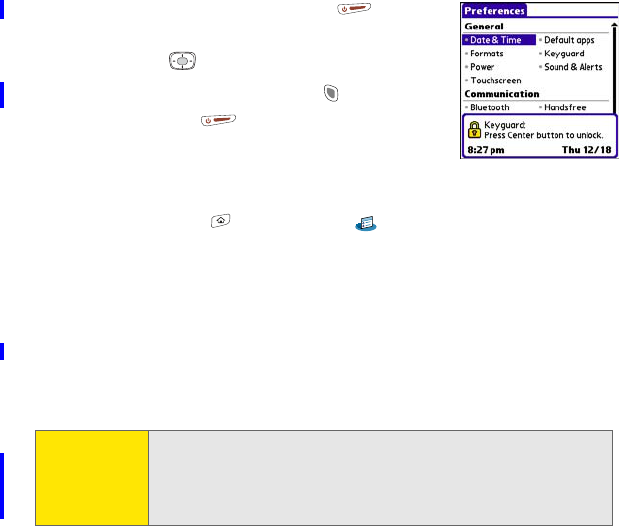
298 Section 6B: Customizing Your Device
To tur n off Keyguard, do the following:
1. If the screen is off, press Power/End to wake
up the screen.
2. Press Center to turn off Keyguard.
ᮣTo turn on Keyguard, press Option and then
press Power/End .
You can change how quickly Keyguard turns on, or you
can disable the feature altogether. To change the
Keyguard settings, do the following:
1. Go to Applications and select Prefs .
2. Select Keyguard.
3. Select the Auto-Keyguard pick list, and then do one of the following:
ⅢSelect how quickly you want Keyguard to turn on:When power is turned
off, 5 seconds after power off, or 30 seconds after power off.
ⅢSelect Disabled to completely disable the Keyguard feature until you turn
it on again.
4. Select Done.
Note: If you disabled Keyguard, you can turn Keyguard on manually by pressing
Option + Power/End when the screen is on. If you use this method,
Keyguard stays on only until you press Center to turn it off; it does not
come back on. To permanently re-enable Keyguard, follow the preceding
procedure and select one of the options from the Auto-Keyguard list.
FINAL DRAFT Palm, Inc. Confidential

Section 6B: Customizing Your Device 299
Customizing
Locking Your Screen
You can set your device to automatically lock the screen’s touch-sensitive features
in certain situations.
1. Go to Applications and select Prefs .
2. Select Keyguard.
3. Check one or both of the following boxes:
ⅢIncoming calls received: Disables the screen when the phone rings. You
must use the 5-way to select the onscreen Answer and Ignore
buttons, or press Send to answer the call or Power/End to
ignore the call.
ⅢOn a call: Disables the screen after you answer a call. You must use the
5-way to select the onscreen buttons during the call. Use this
setting to avoid accidentally pressing onscreen buttons while you’re
holding your device near your ear to speak.
4. Select Done.
Locking Your Phone (Phone Lock)
You can lock your phone to prevent unauthorized calls and use of other wireless
features. When your phone is locked, you must enter the correct code to unlock it.
You can still call emergency services when your phone is locked, however.
1. Press Phone .
2. Open the menus .
3. Select Options, and then select Phone Lock.
FINAL DRAFT Palm, Inc. Confidential

300 Section 6B: Customizing Your Device
4. (Optional) Select Advanced, enter up to three numbers that you can dial
when your phone is locked, and then select OK. You do not need to enter
911 as one of the three numbers, because this number is always available.
5. Select one of the following Phone Lock options:
ⅢOn phone power off locks your phone each time you turn it off. When this
setting is active, you must enter your lock code each time you turn your
phone on again.
ⅢImmediately locks your phone when you select OK. The next time you
dial a number, you must enter your lock code to unlock your phone.
After that, you can continue to make calls without entering your lock
code, unless you select one of the phone lock options.
6. When prompted, enter the lock code, and then select OK. (Unless you
changed your lock code, it is the last four digits of your phone number.)
7. If you want to change the lock code, select Change Lock Code, enter a new
lock code, and then select OK. Repeat this step to verify the new lock code.
8. Select OK. If you selected Immediately in step 5, your phone locks right away.
If you selected On phone power off, your phone locks the next time you press
and hold Power/End to turn off your phone.
To disable the current Phone Lock settings:
1. Press Phone .
2. Open the menus .
3. Select Options, and then select Phone Lock.
4. Uncheck the On phone power off box and enter your lock code to change this
setting.
5. Select OK twice.
FINAL DRAFT Palm, Inc. Confidential
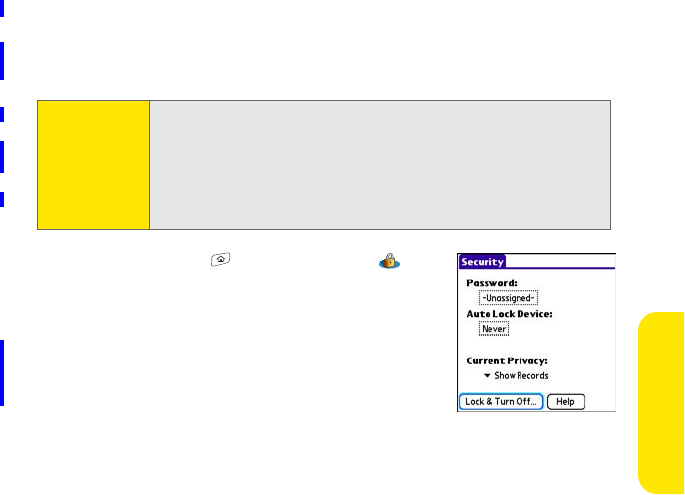
Section 6B: Customizing Your Device 301
Customizing
Locking Your Device
To protect your personal information, you can lock the device so that you need to
enter your password to access any of your information or use any features of your
device, including the phone. You can still call emergency services when your
device is locked.
1. Go to Applications and select Security .
2. Select the Password box.
3. Assign a password and a password hint.
4. Select the Auto Lock Device box.
5. When prompted, enter your password, and then
select OK.
Important: If you lock your device, you must enter the exact password to unlock it. If
you forget the password, you need to perform a hard reset to resume
using your device (see “Hard Reset” on page 315). Performing a hard
reset deletes all the entries in your device. However, you can restore all
previously synchronized information the next time you synchronize your
device with your computer (see “Synchronizing Information—The
Basics” on page 33).
FINAL DRAFT Palm, Inc. Confidential
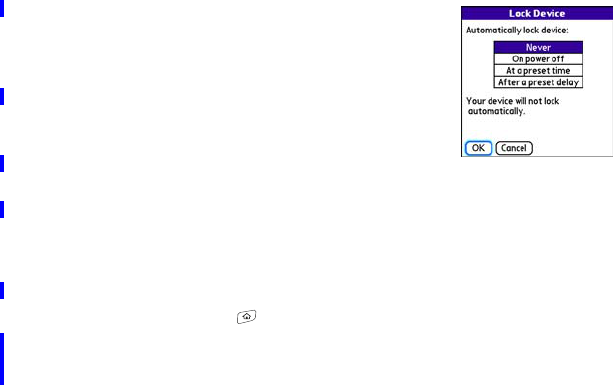
302 Section 6B: Customizing Your Device
6. Select one of the following options:
ⅢNever prevents your device from locking
automatically. You can still lock your system
manually by selecting Lock & Turn Off and
then selecting Off & Lock.
ⅢOn power off locks your device when you
turn off the screen, or when it shuts off with
the Auto-off feature.
ⅢAt a preset time locks your device at a specific
time of day.
ⅢAfter a preset delay locks your device after a period of inactivity.
7. Select OK.
8. Do one of the following:
ⅢSelect Lock & Turn Off to lock your device immediately.
ⅢPress Applications to accept your settings and continue using your
device.
Working With Private Entries
In most applications, you can mark individual entries as private. All private entries
remain visible and accessible until you select the Security setting. You have two
Security setting options:
ⅷHide Records prevents private entries from appearing anywhere in the
application.
ⅷMask Records replaces private entries with a visual placeholder where the
entry would normally appear.
FINAL DRAFT Palm, Inc. Confidential

Section 6B: Customizing Your Device 303
Customizing
After you enable the mask or hide settings, any entries marked as private are
immediately hidden or masked. If you define a password, you must enter it to
display private entries. If you do not define a password, you (or anyone else) can
reveal private entries without a password.
1. Display the entry that you want to mark private.
2. Select Details.
3. Check the Private box.
4. Select OK.
Hiding or Masking All Private Entries
1. Make sure the entries you want to hide or mask are marked private, as
described in the preceding procedure.
2. Go to Applications and select Security .
3. Select the Current Privacy pick list, and then select either Hide Records or
Mask Records.
4. If prompted for your password, enter it and select OK.
Viewing All Private Entries
You can reveal all of the entries you’ve hidden or masked.
1. Go to Applications and select Security .
2. Select the Current Privacy pick list, and then select Show Records.
3. If prompted for your password, enter it and then select OK.
FINAL DRAFT Palm, Inc. Confidential

304 Section 6B: Customizing Your Device
Viewing Private Entries in a Specific Application
1. Open the application that contains the private entries you want to see.
2. Open the menus .
3. Select Options, and then select Security.
4. Select the Current Privacy pick list, and then select Show Records.
5. Select OK.
6. If prompted for your password, enter it and then select OK.
Security and Palm® Desktop Software (Windows)
The Windows version of Palm® Desktop software observes the security password
for your Treo device. If you forget your password, you cannot view your
information in Palm Desktop. If your device is unlocked, you can change your
password on your device, but all entries marked as private are deleted. You can
restore your private entries the next time you sync.
Follow these steps to recover a lost password:
1. Go to Applications and select Security .
2. Select the Password box.
3. Select the Lost Password box.
4. Select Yes.
FINAL DRAFT Palm, Inc. Confidential

Section 6B: Customizing Your Device 305
Customizing
Entering Owner Information
You can use Owner Preferences to record information that you want to associate
with your Treo device, such as your name, company name, and home phone
number. If you lock your device (see “Locking Your Device” on page 301), the
Owner Preferences information appears on the screen that requests your
password to unlock it, and you must also enter your password to change the
Owner Preferences information.
1. Go to Applications and select Prefs .
2. Select Owner.
3. If you assigned a password with the Security
application, select Unlock, enter your password,
and then select OK.
4. Enter the text that you want to appear on the
Owner Preferences screen.
5. Select Done.
FINAL DRAFT Palm, Inc. Confidential
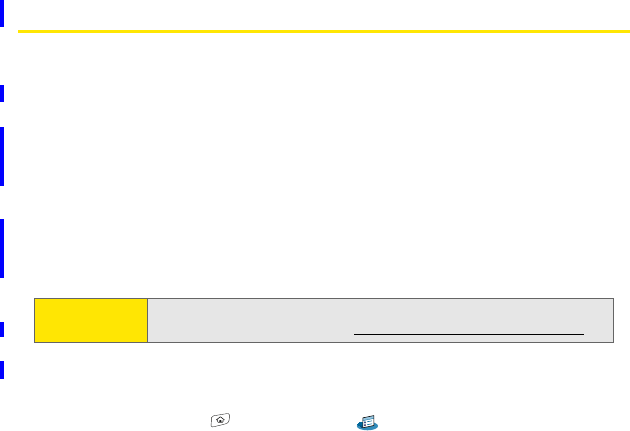
306 Section 6B: Customizing Your Device
Using Connection Settings
Connecting to a Virtual Private Network
If you want to use your Treo device to access your corporate email account or
other files on your corporate server, you may need to set up a virtual private
network (VPN) on your device. A VPN enables you to log in to your corporate
server through the company’s firewall (security layer). You need a VPN on your
device if your device and your company’s server are located on opposite sides of
the firewall.
Check with your company’s system administrator to see if a VPN is required for
accessing the corporate server. If a VPN is necessary, you must purchase and
install a third-party VPN client on your device to use this feature.
1. Install your third-party VPN client. See “Installing Applications” on page 255
for details.
2. Go to Applications and select Prefs .
3. Select VPN.
4. Enter the settings provided by your corporate system administrator.
Note: For information about third-party VPN client software, see the Palm
Software Installation CD or visit www.palm.com/mytreo700pSprint.
FINAL DRAFT Palm, Inc. Confidential

Section 6B: Customizing Your Device 307
Customizing
Purchasing Accessories for Your Device
These and other accessories are available from your local Sprint® Store or at
www.palm.com. For more information, you can also call the Sprint PCS® Accessory
Hotline at 800-974-2221 or visit www.sprint.com. Next day delivery is available in
select areas.
ⅷVehicle Power Charger
Charges your device in your vehicle using the car lighter socket.
ⅷReplacement Battery
Serves as a backup battery if your primary battery becomes drained, is
charging, or has reached the end of its useful life.
ⅷUSB Sync Cable
Provides an extra cable (your device comes with one USB sync cable).
ⅷUSB Docking Cradle
Provides a convenient and elegant desktop solution for synchronizing
information, charging your device with any USB-enabled PC or Mac computer,
and charging a second battery.
ⅷExtra AC Charger
Provides an extra 100 - 240 volt AC charger for your device.
ⅷInternational Travel Adapters
Provides snap-on adapters for continental Europe, the United Kingdom, and
Australia. For use with the Extra AC Charger only.
ⅷLeather Side Case With Belt Clip
Clips to your belt or bag for quick access and protection for your device.
ⅷStylus
Provides a replacement or spare stylus for your device.
FINAL DRAFT Palm, Inc. Confidential
308 Section 6B: Customizing Your Device
FINAL DRAFT Palm, Inc. Confidential
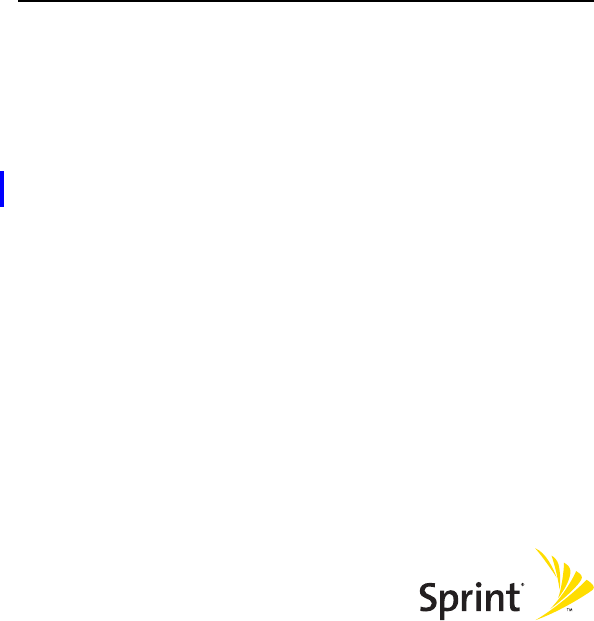
Section 7
Resources
FINAL DRAFT Palm, Inc. Confidential
310
FINAL DRAFT Palm, Inc. Confidential

Section 7A: Help 311
Help
Section 7A
Help
In This Section
ࡗTrouble Upgrading?
ࡗResetting Your Treo 700P Smart Device
ࡗReplacing the Battery
ࡗTroubleshooting
ࡗMaking Room on Your Treo 700P Smart Device
ࡗThird-Party Applications
ࡗErrors
ࡗWhere to Learn More
FINAL DRAFT Palm, Inc. Confidential

312 Section 7A: Help
Trouble Upgrading?
If you experience problems with your Treo™ 700P smart device after performing
the upgrade steps described in “Upgrading From Another Palm OS® Device” on
page 27, you may have incompatible applications or settings that were not
quarantined during the installation process. These files reside in the Backup
subfolder of your user folder. Incompatible applications or settings can lead to
numerous issues, including system resets and freezes. If you experience problems
after upgrading, follow these steps to correct the problem:
1. Locate your user folder on your computer:
ⅢWindows: If your device name is one word, your user folder name is the
first six characters of your device name. If your device name is two
words, your user folder name consists of the first six characters of the
second word of your device name, followed by the first letter of the first
word. For example, if your device name is John Smith, your user folder is
named SmithJ. Your user folder is usually located inside one of the
following folders:
C:\Program Files\Palm\
C:\Program Files\palmOne\
C:\Program Files\Handspring\
ⅢMac: Your user folder name is the same as your device name and is
usually found in this location:
<Mac hard drive> : Users : <Your Mac username> : Documents: Palm :
Users.
2. Make a copy of your user folder and store it in a safe place.
ⅢWindows: Copy the folder, and then paste it to your Windows desktop.
FINAL DRAFT Palm, Inc. Confidential

Section 7A: Help 313
Help
ⅢMac: Select the folder, press and hold the Option key, and then drag the
folder to your Mac desktop.
3. Confirm that the copy of your user folder includes a subfolder named
Backup, and that all the files in the original Backup subfolder are also in the
copy of the Backup subfolder.
4. Delete all files from the original Backup subfolder.
5. Perform a hard reset on your device. See “Resetting Your Treo 700P Smart
Device” on page 314 for instructions.
6. Sync your Treo 700P smart device with your new desktop software; be sure
to select your existing device name from the User list.
7. Reinstall third-party applications from the copy of your Backup subfolder
(see “Installing Applications” on page 255 for instructions). We recommend
that you install one application at a time to help you identify the
application that caused the problem. We also recommend that you do not
install any applications that do any of the following:
ⅢModify phone functions, such as ringtones, dialing, or caller ID.
ⅢReplace organizer applications, such as Contacts or Calendar.
ⅢSet data connection features, such as activating or ending data
connections.
ⅢProvide Web-clipping applications or files, such as PQA files.
ⅢProvide instant messaging features.
If you want to continue using these types of applications, please contact the
third-party developer for software updates and information about compatibility
with your Treo 700P smart device.
FINAL DRAFT Palm, Inc. Confidential
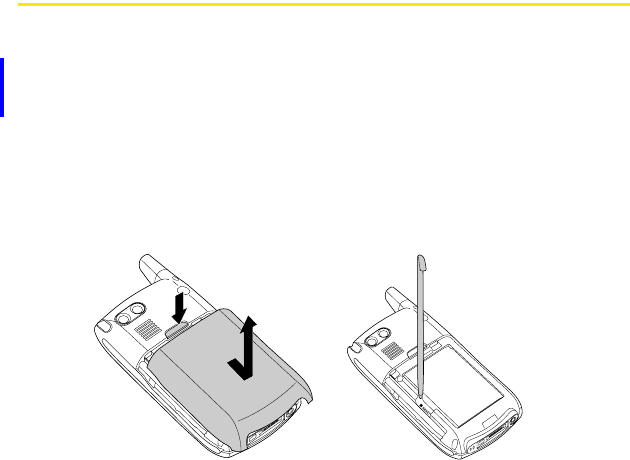
314 Section 7A: Help
Resetting Your Treo 700P Smart Device
Soft Reset
Performing a soft reset is similar to restarting a computer. If your Treo 700P smart
device is not responding or you’re having trouble synchronizing with your
computer, a soft reset may help. All your information is retained when you
perform a soft reset.
1. Press the Battery Door Release button and slide the battery door downward
to remove it from your Treo 700P smart device.
2. Use the tip of the stylus to gently press the reset button on the back of your
Treo 700P smart device.
FINAL DRAFT Palm, Inc. Confidential
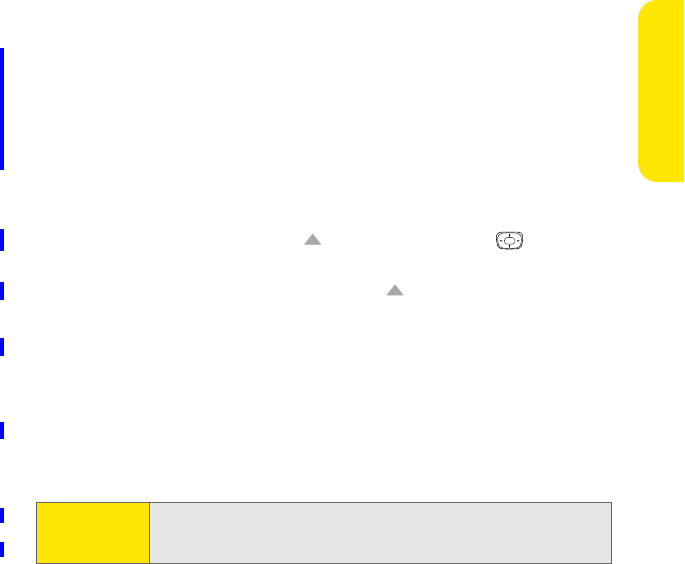
Section 7A: Help 315
Help
System Reset
A system reset, also called a safe or warm reset, can be useful if your device loops
or freezes during a soft reset. Performing a system reset allows you to get out of
the loop and restores limited functionality to your device in order to uninstall a
third-party application that’s causing the problem. Note that after a system reset,
you must perform a soft reset to restore full functionality, including the wireless
features, to your device.
1. Press the Battery Door Release button and slide the battery door downward
to remove it from your Treo 700P smart device.
2. While pressing and holding Up on the 5-way navigator , use the tip of
the stylus to gently press the reset button on the back of your device.
3. When the logo screen appears, release Up .
4. Delete the third-party application that you suspect is causing the problem.
5. Perform a soft reset.
Hard Reset
A hard reset erases all information and third-party software on your Treo 700P
smart device. Never perform a hard reset without first trying a soft and a system reset.
You can restore previously synchronized information the next time you
synchronize.
Note: Your device might not re-establish a Sprint PCS Vision® session after a
hard reset. To manually establish a new Sprint PCS Vision session, open
the Web browser to access a Web site.
FINAL DRAFT Palm, Inc. Confidential
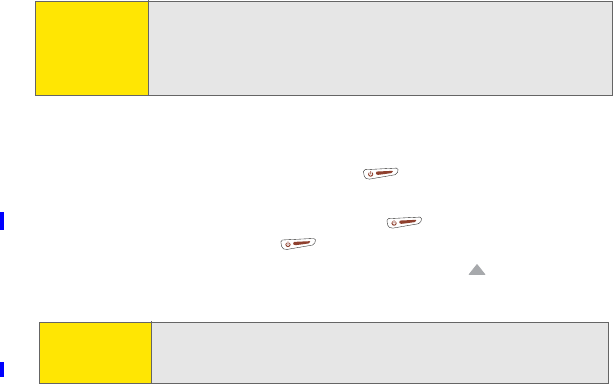
316 Section 7A: Help
A hard reset can tell you if a problem stems from your Treo 700P smart device or
from an application installed on it. If you do not experience the problem after you
perform a hard reset, the problem is related to software you installed. See “Third-
Party Applications” on page 347 for suggestions on diagnosing third-party
software issues.
1. Press the Battery Door Release button and slide the battery door downward
to remove it from your Treo 700P smart device.
2. While pressing and holding Power/End , use the tip of the stylus to
gently press the reset button on the back of your Treo 700P smart device.
3. Continue pressing and holding Power/End . When the logo screen
appears, release Power/End .
4. When the “Erase all data?” prompt appears, press Up to confirm the
hard reset.
Note: Some third-party applications do not create a backup on your computer
when you synchronize. If you perform a hard reset, you may lose data in
these applications and you will need to reinstall these applications after
the hard reset. Please contact the developer to find out which
information is backed up during synchronization.
Note: If you do not see the “Erase all data?” message, the hard reset was not
performed. Please retry the above steps, making sure to hold Power/
End until the logo screen appears.
FINAL DRAFT Palm, Inc. Confidential
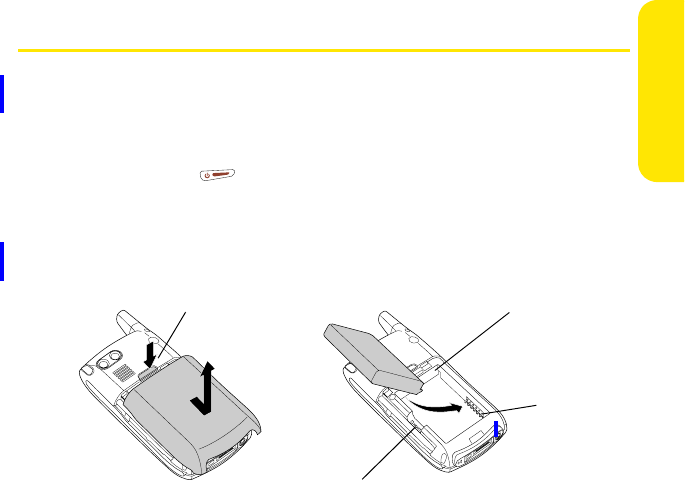
Section 7A: Help 317
Help
Replacing the Battery
Your Treo 700P smart device comes with a replaceable battery. Be sure to use a
battery that is approved by Sprint and that is compatible with your device. Failure
to use the proper battery may result in a risk of personal injury or product
damage, and it will void your device warranty.
1. Press Power/End to turn off the screen.
2. Press the Battery Door Release button and slide the battery door downward
to remove it from your Treo 700P smart device.
3. Place a finger in the notch next to the battery and lift the battery up at a
45-degree angle to remove it from the compartment.
4. Align the metal contacts on the new battery with the contacts inside the
battery compartment.
Battery Door
Release
Notch
Battery
Contacts
Device
Contacts
FINAL DRAFT Palm, Inc. Confidential
318 Section 7A: Help
5. Insert the battery into the compartment at a 45-degree angle, pressing it
into place. Slide the battery door onto the back of the device until it clicks
into place.
6. Connect your device to the charger or sync cable.
7. Wait for your Treo 700P smart device to turn on, and then enable the
network time or set the date and time when prompted.
FINAL DRAFT Palm, Inc. Confidential
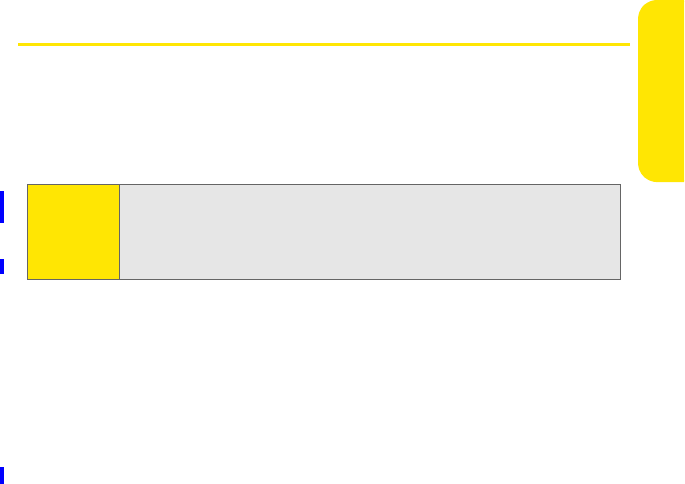
Section 7A: Help 319
Help
Troubleshooting
Desktop Software Installation
If you are having trouble installing the desktop software, you may have the
wrong version of the software or some of your computer’s resources may be
unavailable. Follow these steps to retry the installation:
1. Make sure your computer profile includes administrator rights to install
software. In large organizations, these are usually granted by the system
administrator.
2. Restart your computer.
3. Quit any active applications, including virus scanners and Internet security
applications.
4. Make sure you’re installing the software from the Palm Software
Installation CD that came with your new Treo 700P smart device. (Other
versions of the desktop software may not work with this device.)
5. Insert the Palm Software Installation CD to restart the installation.
Note: The Palm Software Installation CD installs software that enables you to
synchronize using Palm® Desktop software or Microsoft Outlook for Windows.
If you want to synchronize using a different personal information manager
(PIM), you must install a third-party solution. Contact the PIM’s author or
vendor to learn whether desktop software is available for your new Treo device.
FINAL DRAFT Palm, Inc. Confidential

320 Section 7A: Help
Screen
The Screen Appears Blank
1. When a call lasts longer than the limit specified in Power Preferences, the
screen dims automatically. In certain lighting conditions, the screen may
appear blank when this occurs. Press any key except Power/End to
restore the screen to normal brightness. (Pressing Power/End hangs
up the call.)
2. When a period of inactivity lasts longer than the limit specified in Power
Preferences, the screen turns off. Press and release Power/End to wake
up the screen.
3. Look closely at the screen. If you can see a dim image, try adjusting the
screen brightness (see “Adjusting the Brightness” on page 286).
4. If the screen is still blank, perform a soft reset (see “Soft Reset” on
page 314).
5. If the problem persists, connect the Treo 700P smart device to the AC
charger (see “Charging the Battery” on page 13) and perform a soft reset
again.
6. If that doesn’t work, perform a hard reset (see “Hard Reset” on page 315).
Important: Always use the same language for your Treo device, your operating system, and
your desktop software. Otherwise, you may lose information or have difficulty
with synchronization. Support is not provided for mismatched language
setups.
FINAL DRAFT Palm, Inc. Confidential
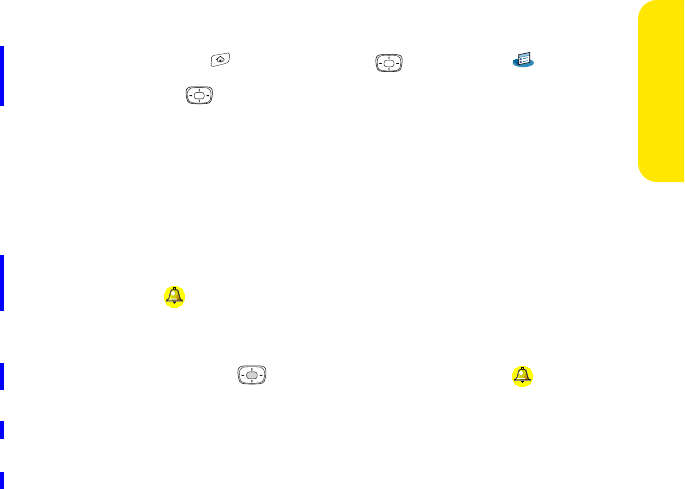
Section 7A: Help 321
Help
The Screen Doesn’t Respond Accurately to Taps or It Activates Wrong Features
1. Go to Applications and use the 5-way to select Prefs .
2. Use the 5-way to select Touchscreen.
3. Follow the onscreen instructions to align the screen.
4. Select Done.
5. If the problem persists, check for material trapped between the screen and
the edge of the device.
6. If you’re using a screen protector, make sure that it is properly installed.
There’s a Blinking Bell at the Upper-Left Corner of the Screen
The blinking bell in the upper-left corner of the screen is the Alert Manager
symbol. It appears when you have alarms or messages that you haven't
acknowledged.
1. Press and hold Center or tap the Alert Manager symbol with your
stylus.
2. When the list of pending alerts appears, do either of the following:
ⅢSelect the alert text to view the item and keep it in the list.
ⅢCheck the box next to an alert to clear it from the list, and then
select Done.
Synchronization
Synchronization backs up the information from your device onto your computer
and vice versa. If you ever need to perform a hard reset or otherwise need to erase
FINAL DRAFT Palm, Inc. Confidential

322 Section 7A: Help
all your information on your device, you can synchronize your device with your
computer to restore the information. Similarly, if your computer crashes and your
Palm® Desktop software information is damaged, you can recover your
information by synchronizing with your device. To make sure you always have an
up-to-date backup of your information, synchronize frequently.
This section describes synchronization between your Treo device and a desktop
computer running Palm Desktop software. You can also synchronize the
information on your device using third-party applications. See the separate
documentation for other applications for information on features and
configuration.
Before you attempt to synchronize, make sure you’ve installed the desktop
synchronization software from the Palm Software Installation CD.
I Can’t Find My User Folder
Windows: If your device name is one word, your user folder name is the first six
characters of your device name. If your device name is two words, your user folder
name consists of the first six characters of the second word of your device name
followed by the first letter of the first word. For example, if your device name is
John Smith, your user folder is named SmithJ. Your user folder is usually located
inside one of the following folders:
C:\Program Files\Palm\
C:\Program Files\palmOne\
C:\Program Files\Handspring\
Mac: Your user folder name is the same as your device name and is usually found
in this location: <Mac hard drive> : Users : <Your Mac username> : Documents :
Palm : Users.
FINAL DRAFT Palm, Inc. Confidential
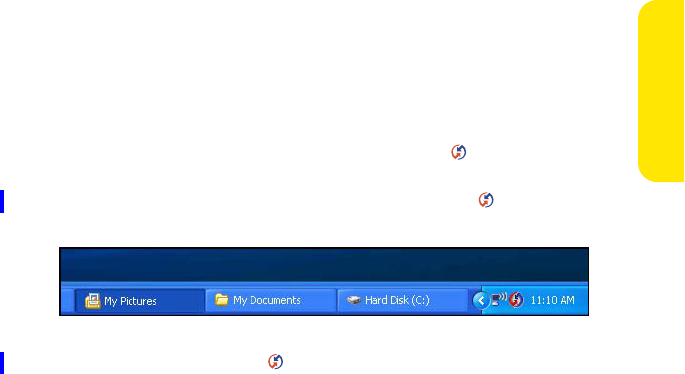
Section 7A: Help 323
Help
Palm Desktop Software Does Not Respond to a Synchronization Attempt
1. Make sure that the USB sync cable is securely connected to the USB port on
your computer and on the bottom of your device (see “Connecting Your Treo
Device to Your Computer” on page 32).
2. Make sure that HotSync manager is running:
ⅢWindows: Right-click the HotSync manager icon in the taskbar in the
lower-right corner of your computer screen and make sure Local USB is
checked. If you don’t see the HotSync manager icon , click Start, select
Programs, select Palm, and then select HotSync Manager.
ⅢMac: Find the Palm folder on your Mac hard drive. Double-click the
HotSync manager icon in the Palm folder. In the Connection Settings
panel, set Local Setup Port to Palm USB.
3. Synchronize. If the synchronization is successful, you do not need to
complete the remaining steps.
4. Perform a soft reset (see “Soft Reset” on page 314).
5. Synchronize. If the synchronization is successful, you do not need to
complete the remaining steps.
6. If problems persist and you’re synchronizing through a USB hub, try
connecting the sync cable to a different USB port, or directly to your
computer’s built-in USB port.
FINAL DRAFT Palm, Inc. Confidential
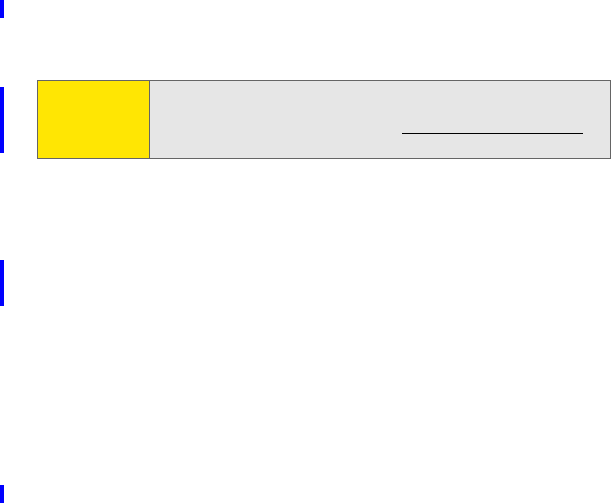
324 Section 7A: Help
7. Synchronize. If the synchronization is successful, you do not need to
complete the remaining steps.
8. (Windows only) Uninstall Palm Desktop software. Click Start, select Settings,
select Control Panel, select Add or Remove Programs, select Palm Desktop
software, and then click Change/Remove.
9. Reboot your computer.
10. Reinstall the synchronization software from the Palm Software Installation
CD that came with your device.
Synchronization Starts But Stops Without Finishing
If you upgraded from a previous Palm OS® device or received a system error, such
as Sys0505, there may be conflicts with software on your device.
1. Locate your Backup folder and rename the folder (for example, BackupOld).
Note that “Palm” in the following locations might be “Handspring” or
“palmOne,” based on the device you’re upgrading from:
ⅢWindows: C:\Program Files\Palm\<device name>
ⅢMac: Mac HD\Applications\Palm\Users\<device name>
2. Synchronize.
3. Manually reinstall any third-party applications you want on your device.
If necessary, use the items in the old Backup folder you renamed.
Note: Palm Desktop software for Mac computers does not provide an
automated uninstall option. For information on uninstalling
Palm Desktop software on a Mac, go to www.palm.com/us/support or
contact Palm Technical Support for Mac computers.
FINAL DRAFT Palm, Inc. Confidential
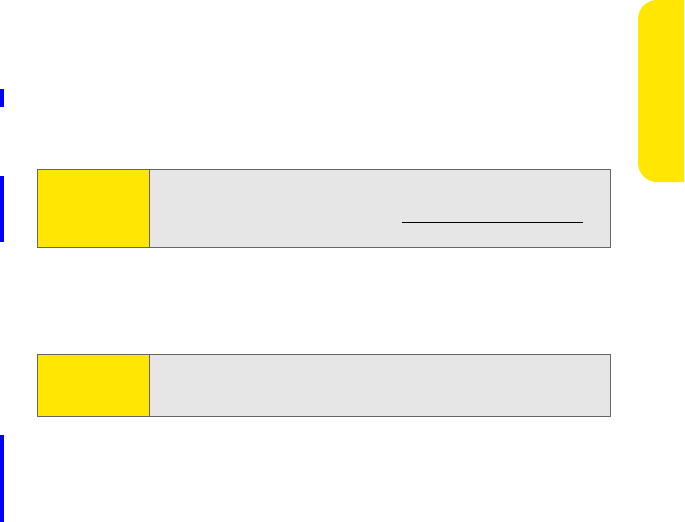
Section 7A: Help 325
Help
4. (Windows only) If the Windows New Hardware Wizard appears, the
synchronization process may be timing out before the wizard completes its
job. Follow all instructions in the New Hardware Wizard, and then sync again.
5. (Windows only) Uninstall Palm Desktop software. Click Start, select Settings,
select Control Panel, select Add or Remove Programs, select Palm Desktop
software, and then click Change/Remove.
6. Reboot your computer.
7. Reinstall the synchronization software from the Palm Software Installation
CD that came with your device.
Synchronization Finishes But Information Does Not Appear Where It Should
1. Make sure you’re synchronizing with the intended desktop personal
information manager (PIM). The Palm Software Installation CD enables you
to choose whether you want to synchronize with Palm Desktop software or
Microsoft Outlook for Windows. Reinsert the installation CD and select
“Change your synchronization method” if necessary. If you use a different
PIM, you need to install third-party software to synchronize. For more
information, consult the company that makes the PIM.
Note: Palm Desktop software for Mac computers does not provide an
automated uninstall option. For information on uninstalling
Palm Desktop software on a Mac, go to www.palm.com/us/support or
contact Palm Technical Support for Mac computers.
Tip: The HotSync Log can tell you when and why synchronization stopped.
Right-click the HotSync manager icon in the taskbar in the lower-right
corner of your computer screen, and then select View Log.
FINAL DRAFT Palm, Inc. Confidential

326 Section 7A: Help
2. If multiple Palm OS devices are synchronizing with your computer, make
sure you are synchronizing with the correct device name. If information is
not appearing in Palm Desktop, make sure the correct device name is
selected in the User list on the toolbar of Palm Desktop.
3. Open HotSync manager on your computer, and make sure the necessary
conduits are set to Synchronize the files.
4. (Windows only) Uninstall Palm Desktop software. Click Start, select Settings,
select Control Panel, select Add or Remove Programs, select Palm Desktop
software, and then click Change/Remove.
5. Reboot your computer.
6. Reinstall Palm Desktop software from the Palm Software Installation CD
that came with your device.
7. If you’re using Microsoft Outlook, consider the following:
ⅢWith the included software, you can synchronize your Treo 700P smart
device with the Contacts, Calendar, Tasks, and Notes folders on your
computer. If you want to synchronize your information with a global
Exchange Address Book, you must copy the addresses to your local
Contacts list in Outlook (right-click the addresses, and then select Add to
Personal Address Book).
ⅢOutlook subfolders and public folders are not accessible with the
included software. You may want to use a third-party solution instead.
Note: Palm Desktop software for Mac computers does not provide an
automated uninstall option. For information on uninstalling
Palm Desktop software on a Mac, go to www.palm.com/us/support or
contact Palm Technical Support for Mac computers.
FINAL DRAFT Palm, Inc. Confidential

Section 7A: Help 327
Help
ⅢIf you’re trying to synchronize offline, be sure to set your Outlook
Calendar, Contacts, Notes, and Tasks to be available offline.
I Have Duplicate Entries in Microsoft Outlook After I Synchronize
1. Open Microsoft Outlook and delete the duplicate entries.
2. On your computer, go to the application with duplicate entries and
manually enter any information you’ve added to your device since the last
time you synchronized.
3. Click the HotSync manager icon in the taskbar, and select Custom.
4. Select an application that has duplicate entries that also has Outlook in its
name.
5. Click Change.
6. Select Desktop overwrites handheld, and then click OK.
7. If more than one application has duplicate entries, then repeat steps 4
through 6 for each application with duplicates.
8. Click Done.
9. Synchronize your device and your computer.
Tip: For more information on Outlook conduits, click the HotSync manager
icon in the taskbar, select Custom, select an application with Outlook in
its name, and then select Help.
FINAL DRAFT Palm, Inc. Confidential

328 Section 7A: Help
My Appointments Show Up in the Wrong Time Slot After I Sync
If you create an appointment in the wrong time zone (for example, your desktop
was set to the wrong time zone), it shows up in the wrong time zone on your
device after you sync. To be safe, enable local network time (see “Setting the Date
and Time” on page 294) and avoid assigning time zones to your appointments
(see “Creating an Event” on page 226).
If you’re using Microsoft Outlook:
1. Make sure that you installed the Microsoft Outlook conduit that came
with your Treo 700P smart device. If you're not sure whether this software is
installed, reinstall it.
2. Open Microsoft Outlook and correct the wrong entries.
3. On your computer, manually enter any Calendar information you added to
your device since the last time you synchronized.
4. Click the HotSync manager icon in the taskbar, and select Custom.
5. Select an application that has both Calendar and Outlook in its name.
6. Click Change.
7. Select Desktop overwrites handheld, and then click OK.
8. Synchronize your device and your computer.
9. Repeat steps 7 through 9 to open the Calendar Change HotSync Action
dialog box.
10. Select Synchronize the files, and then click OK.
FINAL DRAFT Palm, Inc. Confidential

Section 7A: Help 329
Help
If you’re using Palm Desktop software:
1. On your device, press Calendar .
2. Open the menus .
3. Select Options, and then select Preferences.
4. Uncheck the New events use time zones box (if it's checked).
5. On your computer, open Palm Desktop software and correct the wrong
entries.
6. On your computer, manually enter any Calendar information you added to
your device since the last time you synchronized.
7. Click the HotSync manager icon in the taskbar, and select Custom.
8. Select an application that has both Calendar and Outlook in its name.
9. Click Change.
10. Select Desktop overwrites handheld, and then click OK.
11. Synchronize your device and your computer.
12. Repeat steps 4 through 6 to open the Calendar Change HotSync Action dialog
box.
13. Select Synchronize the files, and then click OK.
To avoid this problem in the future, do not assign time zones to your events.
Palm Desktop software does not support time zones.
FINAL DRAFT Palm, Inc. Confidential

330 Section 7A: Help
Phone
Signal Strength Is Weak
Become familiar with low coverage areas where you live, commute, work, and
play. Then you will know when to expect signal strength issues.
ⅷIf you’re standing, move about 10 feet in any direction.
ⅷIn a building, move near a window. Open any metal blinds.
ⅷIn a building, move outdoors or to a more open area.
ⅷOutdoors, move away from large buildings, trees, or electrical wires.
ⅷIn a vehicle, move your Treo device so that it’s level with a window.
My Treo Device Won’t Connect to the Mobile Network
ⅷTry the suggestions in the preceding section for weak signals.
ⅷTurn off your phone and turn it on again (see “Turning Your Device’s Phone On
and Off” on page 55).
ⅷPerform a soft reset (see “Soft Reset” on page 314).
ⅷIf you have an active DUN session (that is, you are using your device’s phone
as a modem), terminate the session (see “Using Your Device’s Phone as a
Modem” on page 118 or “Using Your Device as a Wireless Modem” on
page 173).
The Other Person Hears an Echo
ⅷTry decreasing the volume on your Treo device to avoid coupling or feedback
on the other person’s end. This applies to both the speakerphone and the
earpiece.
FINAL DRAFT Palm, Inc. Confidential

Section 7A: Help 331
Help
ⅷPosition the earpiece closer to your ear to prevent sound leaking back into the
microphone. Keep your hand away from the microphone hole, which is on the
bottom right side of the phone.
ⅷIf you’re using the speakerphone feature with your device lying on a flat
surface, try turning the device face down (screen facing the surface).
I Hear My Own Voice Echo
Ask the person on the other end of the call to turn down the volume on his or her
phone or to hold the phone closer to his or her ear.
My Voice Is Too Quiet on the Other End
ⅷBe sure to position the bottom of the Treo device, or the hands-free
microphone, close to your mouth.
ⅷCheck the signal-strength indicator. If the signal is weak, try to find an area
with better coverage.
I Hear Static or Interference
Check the signal-strength indicator. If the signal is weak, try to find an area with
better coverage.
If you’re using a hands-free device enabled with Bluetooth® wireless technology,
try the following:
ⅷMove your Treo device closer to the hands-free device. Audio quality degrades
as the distance between your Treo device and hands-free device increases.
The effective range for a hands-free device varies among manufacturers.
ⅷConfirm that no obstructions, including your body, are between the Treo
device and your hands-free device. For example, move your Treo device to the
same side of your body as your hands-free device.
FINAL DRAFT Palm, Inc. Confidential

332 Section 7A: Help
My Device Hangs Up When I Hold It to My Ear
You may be accidentally pressing the onscreen Hang Up All button with your
cheek. Try holding the device so that your face doesn’t press against the screen. If
this is not convenient, you may want to disable the screen’s touch-sensitive
feature during active calls (see “Locking Your Screen” on page 299).
My Device Seems to Turn Off by Itself
If a system error and reset occur, the Treo device automatically turns the phone
on if it was on before the reset. However, if the device can’t determine if your
phone was on before the reset, the phone does not automatically turn on (see
“Turning Your Device’s Phone On and Off” on page 55). If the problem persists
and you’re using third-party applications, see “Third-Party Applications” on
page 347 for additional suggestions.
My Device Makes or Answers Calls When It’s in a Bag or Pocket
Items in your bag or pocket may be pressing the onscreen Answer button or
otherwise activating screen items. If this happens, be sure to press
Power/End to turn off the screen before placing it in your briefcase or
pocket. You may also want to disable the screen’s touch-sensitive feature during
incoming calls (see “Locking Your Screen” on page 299).
If you are using a Bluetooth hands-free device with your Treo device, you may
have turned the auto-answer feature on in Handsfree Preferences. For information,
see “Setting Up Your Hands-Free Device to Automatically Answer Calls” on
page 87.
FINAL DRAFT Palm, Inc. Confidential
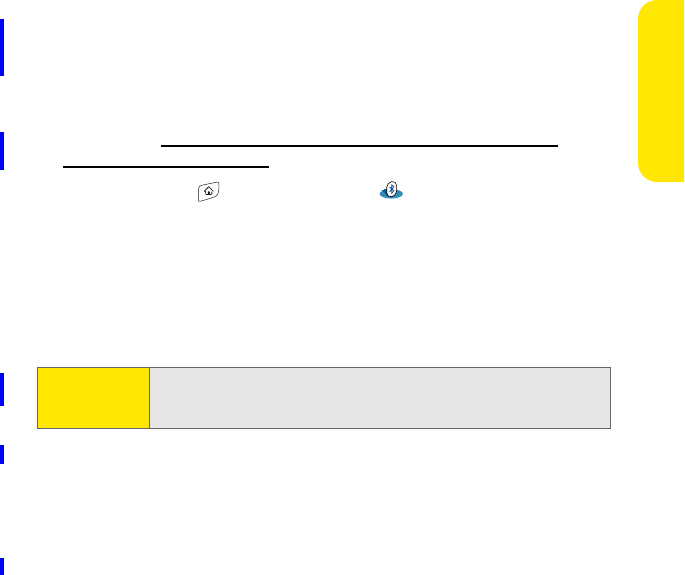
Section 7A: Help 333
Help
Hands-Free Devices
I Can’t Make or Receive Calls Using a Bluetooth Hands-Free Device
Confirm all of the following:
ⅷThe device with Bluetooth® wireless technology is compatible with your Treo
device. Go to http://www.palm.com/us/support/bluetooth/treo700p_
bluetooth_compatibility.html for a list of compatible devices.
ⅷGo to Applications and select Bluetooth . Make sure the Bluetooth
setting is turned on in the Bluetooth application.
ⅷYou have already formed a partnership between your Treo device and your
hands-free device, and the hands-free device appears in the Trusted Devices
list (see “Connecting to a Bluetooth Hands-Free Device” on page 84).
ⅷYour hands-free device is charged and turned on.
ⅷYour Treo device is within range of the hands-free device.
I Hear Static or Interference When Using My Hands-Free Device
ⅷTry moving your Treo device closer to the hands-free device. Audio quality
degrades as the distance between your Treo device and hands-free device
increases. The effective range for a hands-free device varies among
manufacturers.
ⅷConfirm that no obstructions, including your body, are between the Treo
device and your hands-free device.
Note: Bluetooth range is up to 30 feet in optimum environmental conditions.
Performance and range can be affected by physical obstacles, radio
interference from nearby electronic equipment, and other factors.
FINAL DRAFT Palm, Inc. Confidential

334 Section 7A: Help
Some Features of My Hands-Free Device Don’t Work With My Treo Device
ⅷCheck the Palm compatibility list at http://www.palm.com/us/support/
bluetooth/treo700p_bluetooth_compatibility.html to ensure that your device is
compatible.
ⅷNot all hands-free features work with every hands-free device. Check the
documentation that came with your hands-free device or the manufacturer’s
Web site for feature-compatibility information specific to your device.
Email
I Have Problems Using My Account
Occasionally you may experience problems using an email account after you set
it up. If you followed the account setup procedure and are experiencing problems
using the account, verify that the account complies with your email provider’s
requirements by following these steps:
ⅷVerify both your password and your username for your email account.
ⅷSome wireless service providers require you to be on their network to use
your email account. If this is the case, be sure to use your provider's network
as the connection type for the account.
ⅷSome email service providers have other requirements specific to their
service. For example, Yahoo! requires you to pay for a POP account in order to
Note: The following troubleshooting tips apply to the VersaMail® application
only. If you are using Sprint PCS Business ConnectionSM Personal Edition
or GoodLink™ as your email application, refer to the documentation
included with those applications for troubleshooting tips.
FINAL DRAFT Palm, Inc. Confidential

Section 7A: Help 335
Help
download email messages from your Yahoo! account to your device. Check
with your service provider to see if any provider-specific requirements exist.
ⅷService provider settings change frequently. If your email account was
working but you are currently experiencing problems, check with your
wireless or email service provider to see if any of the account settings have
changed.
I Have Problems Sending and Receiving Email
Short periods of time when email is unavailable are common due to server
problems or poor wireless coverage. If you have problems sending or receiving
mail for an extended period of time, check with your ISP or email service provider
to verify that the service is working properly, and check with Sprint Customer
Service for outage information in your area.
Auto Sync Is Not Working
If an Auto Sync operation is occurring and you turn your device’s phone off or the
connection to your email service provider is disconnected, the Auto Sync
operation fails. If a scheduled Auto Sync doesn’t take place or starts but does not
finish, make sure your device’s phone is on and that your data connection to your
email service provider has not been interrupted.
I Have Problems Sending Email
If you are able to receive email messages but cannot send them, try these steps,
in turn:
ⅷMake sure your ISP or email provider allows you to access email on a wireless
device. Several providers, like Hotmail, do not offer this option at all; other
providers require an upgrade to access email on a wireless device.
FINAL DRAFT Palm, Inc. Confidential

336 Section 7A: Help
ⅷTurn on ESMTP. Many services require authenticated access, or ESMTP, to use
their SMTP servers. See the User Guide for the VersaMail Application on the
Palm Software Installation CD for information on turning ESMTP on.
ⅷEnter the name of a different outgoing mail server for sending mail. Many
ISPs, such as cable companies, require that you have an Internet connection to
their network to send email through their servers. In this case, you can almost
always receive email from these accounts, but if you want to send email, you
must send it through another server. Check with your email service provider
for the correct outgoing mail server name.
I Have Problems Synchronizing Messages on My Device With Messages on
My Computer
Make sure you have chosen the same settings for the account on both your device
and your computer. For example, if the account is set up on your device to use the
POP protocol, check HotSync manager on your computer to make sure that POP is
selected as the protocol for that account.
My vCard or vCal Email Attachment Isn’t Forwarding Correctly
Palm Desktop software provides several features that work with email client
software on a Windows computer. For these features to work correctly, the email
client software must be properly set up. Follow these steps to check the settings:
1. Click Start on your computer, and then select Settings.
2. Select Control Panel.
3. Select Internet Options, and then click the Programs tab.
4. Make sure that the email field is set to the correct email client software.
FINAL DRAFT Palm, Inc. Confidential

Section 7A: Help 337
Help
5. Click OK.
6. Start the email client software and make sure it is configured as the default
MAPI client. (Consult the documentation for your desktop email application
for more information.)
After I Get Messages, Either Manually or Through Auto Sync, Messages
Disappear From My Inbox
If you have an account that uses Microsoft Exchange ActiveSync®, when you
perform an Auto Sync, the last three days’ worth of email messages are
downloaded from your mail server to your Inbox. All messages older than three
days are deleted from your Inbox; they are not deleted on the server, however.
You can change the setting in VersaMail® preferences to download fewer than
three days’ worth of messages (in which case, more-recent messages are deleted
from your Inbox), or to download all messages regardless of the date (in which
case all messages continue to appear in your Inbox).
I Am Using Microsoft Exchange ActiveSync, But Email Messages, Calendar
Events, and Contacts Information Are Not Downloading to My Device
Check with your system administrator to obtain the name of the mail server that
offers you wireless access to the corporate mail system. If you cannot obtain the
name of this server (some companies do not give it out, because they do not want
wireless access to their servers), you cannot synchronize email messages,
Calendar events, and Contacts information with the server using Microsoft
Exchange ActiveSync.
FINAL DRAFT Palm, Inc. Confidential

338 Section 7A: Help
Messaging
I Can’t Tell If Data Services Are Available
When your phone is on, icons appear in the title bar in the Main view of the Phone
application to indicate whether data services are available and whether a data
connection is active. See “Checking Signal Strength and Phone Status” on
page 100 for a description of the icons that indicate that data services are
available.
If your phone is on and you do not see any of the data icons, then data services
are not available in your current location.
I Can’t Send or Receive SMS Text Messages
ⅷMake sure your phone is turned on (see “Turning Your Device’s Phone On and
Off” on page 55).
ⅷContact Sprint to verify that your plan includes SMS messaging services, that
these services have been correctly activated, and that they are available at
your location. Sprint should be able to tell you if messaging services have
been experiencing transmission delays. Delays can also occur between the
time that a message is sent and the time it is received.
ⅷVerify with the recipient that the receiving device can handle text messages.
ⅷIf a text message arrives but does not display an alert, perform a soft reset
(see “Soft Reset” on page 314).
I Can’t Send or Receive Sprint PCS® Picture Mail Messages
ⅷMake sure your phone is turned on (see “Turning Your Device’s Phone On and
Off” on page 55).
FINAL DRAFT Palm, Inc. Confidential

Section 7A: Help 339
Help
ⅷContact Sprint to verify that your plan includes Sprint PCS Picture Mail
messaging services, that these services have been correctly activated, and
that they are available at your location. Sprint should be able to tell you if
messaging services have been experiencing transmission delays. Delays can
also occur between the time that a message is sent and the time it is received.
ⅷMake sure that the Sprint PCS Vision icon or Sprint Power VisionSM icon
or appears in the title bar of the Main view of the Phone application. If you
do not see one of these icons, data services are not available in your current
location and you cannot exchange Picture Mail messages.
ⅷVerify with the recipient that the receiving device can handle Picture Mail
messages.
ⅷIf you have an active DUN session (that is, you are using your device’s phone
as a modem), terminate the session (see “Using Your Device’s Phone as a
Modem” on page 118 or “Using Your Device as a Wireless Modem” on
page 173).
ⅷIf a Picture Mail message arrives but does not display an alert, perform a soft
reset (see “Soft Reset” on page 314).
FINAL DRAFT Palm, Inc. Confidential

340 Section 7A: Help
Web
I Can’t Tell If Data Services Are Available
When your phone is on, icons appear in the title bar in the Main view of the Phone
application to indicate whether data services are available and whether a data
connection is active. See “Checking Signal Strength and Phone Status” on
page 100 for a description of the icons that indicate that data services are
available.
If your phone is on and you do not see any of the data icons, then data services
are not available in your current location.
The Device Won’t Connect to the Internet
Your Treo 700P smart device supports Sprint PCS Vision and Sprint Power Vision,
two ways to connect to the Internet that are persistent and are faster and more
reliable than a regular dial-up connection. All Sprint customers can connect to
the Internet, but to avoid high per-minute charges, we recommend that you
subscribe to a Sprint PCS Vision plan. Contact Sprint to verify that your
subscription plan includes Sprint PCS Vision services and that these services have
been correctly activated, and to confirm your username and password. Sprint
should also be able to tell you if there are any outages in your area.
1. Press and hold Power/End to turn off your phone. Then press and hold
Power/End again to turn your phone back on.
2. Press Phone and look for either the Sprint PCS Vision icon or Sprint
Power Vision icon or in the title bar of the Main view.
FINAL DRAFT Palm, Inc. Confidential

Section 7A: Help 341
Help
3. If you see one of these icons, you are in a data coverage area. Try connecting
to the Internet again. If you do not see one of these icons, go to Applications
, select Prefs , and continue with the following steps.
4. Select Network.
5. Select the Service pick list and select PCS Vision. (If PCS Vision does not appear
in the list, call Sprint for assistance.)
6. Select Connect.
7. If the connection is successful, go to the Web browser. If you still can’t make
a connection, perform a soft reset (see “Soft Reset” on page 314).
8. If your phone did not turn on automatically, press and hold Power/End
to turn on your phone, and try connecting to the Internet.
9. Contact Sprint to verify the following:
ⅢYour subscription plan includes high-speed data services.
ⅢData services have been activated on your account.
ⅢData coverage is available in your location.
ⅢThere are no data service outages in your location.
I Can’t Access a Web Page
First, make sure you have Internet access: Open the Web browser to see if you can
view a Web page you’ve successfully viewed before. To ensure that you’re viewing
the page directly from the Internet, open the menus , select Go, and then select
Refresh.
If you can view the page after you refresh it but you still can’t access the page you
were originally trying to view, the page may contain elements that are not
FINAL DRAFT Palm, Inc. Confidential
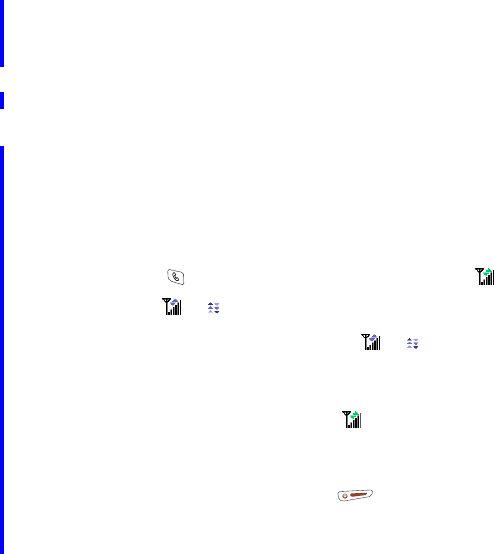
342 Section 7A: Help
supported by the Web browser. These include Flash, Shockwave, VBScript,
WMLScript, and other plug-ins.
Some Web sites use a redirector to their true home page. If the Web browser on
your device can’t follow the redirect, try using a desktop browser to see
the landing page of the redirector, and then enter that address in the Web
browser on your device.
It Takes a Long Time for a Web Page to Load
If it is taking longer than usual to load Web pages, you may have traveled from a
high-speed Sprint Power Vision service area to a Sprint PCS Vision service area.
Although Sprint PCS Vision data service is considered a high-speed data service, it
can seem slow if you are used to Sprint Power Vision speed.
1. Press Phone and look for the Sprint PCS Vision icon or Sprint Power
Vision icon or in the title bar of the Main view.
2. If you see the Sprint Power Vision icon or , there may be a problem
with the Web site you are trying to access. Try opening a different Web page
to see if the problem persists.
3. If you see the Sprint PCS Vision icon , you may be experiencing the
difference in performance between the two types of data networks.
4. To be sure there is not a problem with your connection to the Sprint
network, press and hold Power/End to turn off your phone. Then press
and hold the same button to turn it back on again.
5. Try opening the Web page again to see if it loads faster.
FINAL DRAFT Palm, Inc. Confidential

Section 7A: Help 343
Help
An Image or Map Is Displayed Too Small on the Device Screen
The Web browser has two modes: Optimized and Wide Page. Optimized mode
resizes all images and page elements to make them fit in a single vertical column
on the Treo device screen. Switch to Wide Page mode to see the image in its
original, full-size form (see “Viewing a Web Page” on page 160).
You may also be able to save the image to your device or to an expansion card and
then view the image later on your computer (see “Downloading Files From a Web
Page” on page 163 for information).
A Secure Site Refuses to Permit a Transaction
Some Web sites don’t support certain browsers for transactions. Please contact
the site’s Webmaster to make sure the site allows transactions using your
device’s Web browser.
FINAL DRAFT Palm, Inc. Confidential

344 Section 7A: Help
Dial-Up Networking Using Bluetooth Technology
My Computer Does Not Appear on the Trusted Devices Screen
ⅷIf you select Add Device and your computer does not appear on the list, make
sure that the computer’s Bluetooth setting is on and that the computer is
discoverable. Check with your computer manufacturer for help with locating
and changing these settings.
ⅷSelect Find More on the Trusted Devices screen again.
I Get a Message That There Is an Error Creating a DUN Connection With My Treo
Device
ⅷRe-create the partnership between your Treo 700P smart device and your
computer (see “Accepting a Connection From Another Bluetooth Device” on
page 177).
Camera
Here are some tips for taking good pictures with the built-in camera:
ⅷClean the camera’s lens with a soft, lint-free cloth.
ⅷTake pictures in brighter lighting conditions. Low-light images may be grainy,
due to the sensitivity of the camera.
ⅷHold the device as still as possible. Try supporting your picture-taking arm up
against your body or a stationary object (such as a wall).
ⅷKeep the subject of the pictures still. Exposure time is longer with lower light
levels, so you may see a blur.
ⅷFor best results, verify that you have the brightest light source coming from
behind you, lighting the subject’s face. Avoid taking indoor pictures with the
subject in front of a window or light.
FINAL DRAFT Palm, Inc. Confidential

Section 7A: Help 345
Help
ⅷMake sure the subject is at least 18 inches away from the camera to ensure
good focus.
Remember that when you synchronize your device with your computer, your
photos and videos are stored on your hard drive (see “Viewing Pictures and
Videos on Your Computer” on page 202).
FINAL DRAFT Palm, Inc. Confidential

346 Section 7A: Help
Making Room on Your Treo 700P Smart Device
Keep in mind that your Treo 700P smart device includes an expansion slot, and
that you can store applications and information on expansion cards (sold
separately). However, you still need free memory on the device itself to run
applications from an expansion card.
If you store a large number of entries or install many third-party applications, the
internal memory on your Treo 700P smart device may fill up. Here are some
common ways to clear space on your device:
ⅷEmail. Messages that have large attachments can quickly consume memory
on your device. Delete emails with large attachments. If you have hundreds of
messages with or without attachments, you may want to delete older
messages to make room (see the User Guide for the VersaMail Application on
the Palm Software Installation CD.)
ⅷPics&Videos Pictures can consume excessive memory. Move your pictures to
an expansion card, synchronize them to your computer (see “Viewing Pictures
and Videos on Your Computer” on page 202), or upload them to your account
on the Sprint PCS Picture Mail Web site, and then delete large files from your
Treo 700P smart device (see “Deleting a Picture or Video” on page 199).
ⅷMusic. Music files often consume excessive memory. Move music files to an
expansion card, or delete large files from your device.
ⅷInternet. If you have set a large Web browser cache, you may want to clear the
cache (see “Customizing Your Web Browser Settings” on page 170).
ⅷThird-party applications. You can delete infrequently used applications (see
“Removing Applications” on page 258) or move them to an expansion card
(see “Using Expansion Cards” on page 276).
FINAL DRAFT Palm, Inc. Confidential

Section 7A: Help 347
Help
Third-Party Applications
Some third-party applications can cause conflicts with your Treo device. Third-
party applications that modify the wireless features of your device may require
extra troubleshooting. If you recently installed an application and your Treo 700P
smart device seems to be stuck, try the following:
1. Perform a soft reset (see “Soft Reset” on page 314).
2. If the problem persists, perform a system reset (see “System Reset” on
page 315).
3. Delete the most recently installed application from your Treo 700P smart
device (see “Removing Applications” on page 258).
4. If the problem persists, perform another system reset.
5. If possible, synchronize your device with your computer to back up your
most recent information.
6. If you’re unable to perform the steps above or the problem persists, locate
your Backup folder on your computer and rename the folder (for example,
BackupOld). Note that “Palm” in the following locations might be
“Handspring” or “palmOne,” based on the device you’re upgrading from:
ⅢWindows: C:\Program Files\Palm\device name.
ⅢMac: Mac HD\Applications\Palm\Users\device name.
7. Perform a hard reset (see “Hard Reset” on page 315).
8. Synchronize to restore your Contacts, Calendar, Tasks, Memos, and
Pics&Videos information. You may need to manually restore information in
other applications.
FINAL DRAFT Palm, Inc. Confidential

348 Section 7A: Help
9. If the problem is resolved, begin reinstalling your third-party applications
one at a time by double-clicking a single file in the original Backup folder
that you renamed, and sync after each application you install.
10. If the problem recurs, delete the last application you installed and report
the problem to its developer.
Remember that not all third-party applications were written with the Treo 700P
smart device keyboard and 5-way navigator in mind. You may encounter
strange behavior or errors in these applications if you use the keyboard and
5-way .
Getting More Help
Contact the author or vendor of any third-party software if you require further
assistance. Sprint does not provide technical support for applications that are not
built into your Treo 700P smart device.
FINAL DRAFT Palm, Inc. Confidential

Section 7A: Help 349
Help
Errors
Your Treo device is designed to minimize interruptions when a system error
occurs. If your device encounters a system error, it automatically resets itself and
resumes functioning as normal. If possible, it even turns the phone back on if it
was on before the error occurred.
Sometimes you might want to know more about an error. The Treo 700P smart
device uses a special interface to show error messages in greater detail.
1. Press Phone .
2. Enter ##377, and then press Send .
3. Review the screen with details about the conditions that led up to the most
recent automatic reset.
4. Select OK.
Please note that third-party developers create their own error messages. If you do
not understand an error message, please contact the developer of the application
for help.
Fixing an Error 67 Message
1. Press Phone .
2. From the Dial Pad, dial ##data.
3. Open the menus .
4. Select Update Vision Profile from the Options menu.
5. Select Now.
FINAL DRAFT Palm, Inc. Confidential
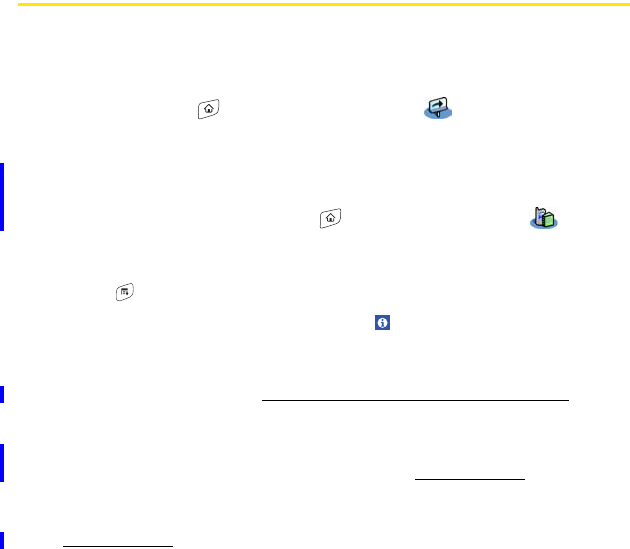
350 Section 7A: Help
Where to Learn More
For a Quick Introduction
ⅷQuick Tour: The Quick Tour introduces you to many of your Treo device’s
features. It is already installed on your device, and you can open it any time.
Go to Applications , and then select Quick Tour .
While Using Your Device
ⅷOn-device User Guide: A copy of this guide is included right on your device. The
on-device guide is specially formatted for your device screen. To view the
on-device guide, go to Applications , and then select My Treo .
ⅷTips: Many of the built-in applications include helpful tips for getting the
most out of your device. To view these tips, open an application, open the
menus , select Options, and then select Tips.
ⅷInformation: Many screens have a Tips icon in the upper-right corner. Select
the Tips icon to learn about the tasks you can perform in that dialog box.
ⅷOnline support from Palm: For up-to-date downloads, troubleshooting, and
support information, go to www.palm.com/us/support/treo700pSprint.
If You Need More Information
ⅷBooks: Many books on Palm OS devices are available in local or online book
retailers (look in the computers section), or visit www.palm.com.
ⅷOnline forums: Consult online Treo device user discussion groups to swap
information and learn about topics you may find nowhere else. Visit
www.palm.com for details.
FINAL DRAFT Palm, Inc. Confidential

Section 7A: Help 351
Help
Visiting the Sprint Web Site
You can get up-to-date information on Sprint PCS® services and options by
signing onto the Sprint Web site at www.sprint.com.
When you visit Sprint online, you can
ⅷReview coverage maps
ⅷLearn how to use voicemail
ⅷAccess your account information
ⅷPurchase accessories
ⅷAdd additional options to your service plan
ⅷCheck out frequently asked questions
ⅷAnd more
Reaching Sprint Customer Service
You can reach Sprint Customer Service many different ways:
ⅷOn your Treo 700P smart device, press Phone ; dial , and then
press Send .
ⅷSign on to your account at www.sprint.com.
ⅷCall toll-free at 1-888-211-4727 (Consumer customers),
–or–
1-888-788-4727 (Business customers).
ⅷWrite to Sprint Customer Service, P.O. Box 8077, London, KY 40742.
*
FINAL DRAFT Palm, Inc. Confidential
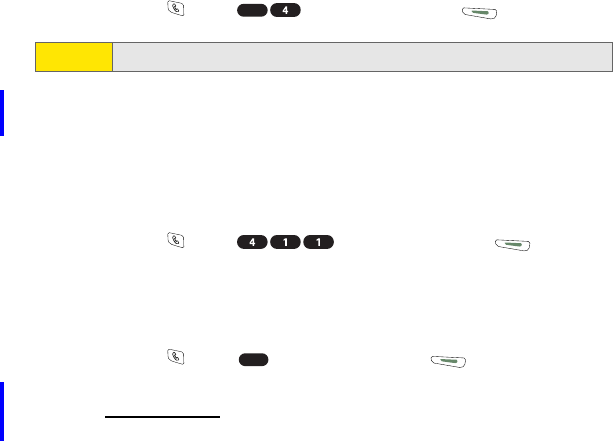
352 Section 7A: Help
Receiving Automated Invoicing Information
For your convenience, your phone gives you access to invoicing information on
your Sprint PCS Account. This information includes balance due, payment
received, invoicing cycle, and the number of minutes used since your last
invoicing cycle. (Normal airtime usage will apply.)
ᮣPress Phone , press , and then press Send .
Sprint 411
You have access to a variety of services and information through Sprint 411,
including residential, business, and government listings; assistance with local or
long-distance calls; movie listings; and hotel, restaurant, shopping, and major
local event information. There is a per-call charge and you will be billed for
airtime.
ᮣPress Phone , press , and then press Send .
Sprint PCS Operator Services
Sprint PCS Operator Services provides assistance when placing collect calls or
when placing calls billed to a local telephone calling card or third party.
ᮣPress Phone , press , and then press Send .
For more information or to see the latest in products and services, visit Sprint
online at www.sprint.com.
Note: This service may not be available in all Affiliate areas.
*
0
FINAL DRAFT Palm, Inc. Confidential

Section 7B: Glossary 353
Glossary
Section 7B
Glossary
1xEV-DO (Evolution Data Optimized): A wireless broadband technology (also
known as EVDO) that is designed for very high-speed data transfer with average
download speeds of 400 to 700Kbps and that is capable of reaching speeds up to
a theoretical maximum of 2.4Mb/s, and upload speeds up to 156Kb/s. The Sprint
Power VisionSM Network uses 1xEV-DO technology.
1xRTT: A standard of Mobile Internet connectivity that allows for persistent data
connections as long as you are actively using your data connection. The average
data transmission rate is around 70Kb/s, although theoretical limits are
153.6Kb/s. With Sprint PCS Vision® plans, you pay a monthly rate for unlimited
data transfer and you don't pay for connection time.
Alt (alternative) : A keyboard key. Enter a letter on the keyboard, and then press
Alt to access variations such as international characters and symbols.
Applications : The screen on your Treo™ 700P smart device from which you can
open all applications.
Auto-off interval: The time of inactivity that passes before the screen on your
Treo 700P smart device turns off. The wireless features on your device are
unaffected by this setting.
Beam: To send or receive an entry or application using the infrared port on your
Treo 700P smart device.
FINAL DRAFT Palm, Inc. Confidential

354 Section 7B: Glossary
Bluetooth® wireless technology: Technology that enables devices such as smart
devices, mobile phones, and computers to connect wirelessly to each other so
that they can exchange information over short distances.
Device name: The name associated with your Treo device that distinguishes it
from other Palm OS® devices. When you first synchronize your device, you are
asked to give it a device name. This name appears in the User list in
Palm® Desktop software.
Dial-up networking: Wireless technology that enables you to convert your device
into a wireless modem so that you can access the Internet from your computer.
Dialog box: A set of options and command buttons that is enclosed by a border
and that enables you to carry out a specific task.
Favorite: A button that provides quick access to a phone number (speed dial) or
commonly used application (Contacts, Web, Messaging, and so on). You can define
up to 70 favorite buttons in the Phone application.
GoodLink™ Applications software: An optional secure wireless messaging
application allowing real-time push synchronization with your Microsoft Outlook
server.
HotSync®: The technology that synchronizes your Treo 700P smart device and your
computer with the simple press of a button.
HotSync manager: The computer application that manages the synchronization
with your Treo 700P smart device.
Infrared (IR): A way of transmitting information using light waves. The IR port on
your Treo 700P smart device enables you to transfer information between other IR
devices within a short radius.
Lithium Ion (Li-Ion): The rechargeable battery technology used in Treo devices.
FINAL DRAFT Palm, Inc. Confidential

Section 7B: Glossary 355
Glossary
On Demand: A Sprint Power Vision Network feature that allows you to personalize
your device’s data features.
Option key : The keyboard button that enables you to access the number,
symbol, or feature that appears above the letter on each key.
Palm® Desktop software: A PIM application for computers that helps you manage
your personal information and keep it synchronized with your Treo 700P smart
device.
Palm OS®: The operating system of your Treo 700P smart device. Palm OS is known
for its simplicity of use and for the large number of compatible third-party
applications that can be added to your Treo 700P smart device.
Palm™ Quick Install: The component on your Windows computer that enables you
to install Palm OS applications and other information on your Treo 700P smart
device.
Partnership: Two Bluetooth devices—for example, your device and a hands-free
device—that can connect because each device finds the same passkey on the
other device. Once you form a partnership with a device, you don’t need to enter
a passkey to connect with that device. Partnership is also know as paired
relationship, pairing, trusted device, or trusted pair on some devices.
Phone :The application on your Treo device that enables you to make and
receive phone calls.
Phone as Modem: Feature that enables you to use your device’s Sprint Power
Vision data connection as a high-speed modem for your computer, using a wired
(USB sync cable) connection.
FINAL DRAFT Palm, Inc. Confidential

356 Section 7B: Glossary
PIM (personal information management): A genre of software that includes
applications such as Palm Desktop software, Microsoft Outlook, Lotus Notes, and
ACT!. PIMs generally store contacts, schedules, tasks, and memos.
SMS: The service that enables devices to exchange short text messages almost
instantly. Text messages are typically exchanged between mobile phones. These
messages can usually include up to 160 characters. Your device can send and
receive SMS messages while you are on a voice call.
Sprint PCS Business ConnectionSM: A service offered by Sprint that enables you to
access your existing corporate or personal email on your Treo™ 700P smart device.
For more information, visit www.sprint.com.
Sprint PCS® Picture Mail: An enhanced Sprint PCS Vision messaging service that
enables you to instantly share pictures and videos with friends and family. You
can also manage your pictures and videos online.
Sprint PCS Vision®: The next generation of Mobile Internet access that enables you
to check your email, browse the Web, and share pictures and videos with Sprint
PCS Picture Mail.
Sprint Power VisionSM Network: An advanced mobile data network using the fastest
commercially available wireless network technology (EVDO) to deliver
broadband-like transfer speeds for your data connections.
Sprint TVSM: A Sprint Power Vision Network service that allows you to view live
Mobile Digital TV (MDTV) on your Treo 700P smart device.
Streaming: Technology that enables you to access media content—for example,
to watch video or listen to an audio program—directly from the Internet on your
device without needing to download a file that you save on your device.
FINAL DRAFT Palm, Inc. Confidential

Section 7B: Glossary 357
Glossary
User folder: The folder on your computer that contains both the information you
enter in Palm® Desktop software and the information you enter on your device
and synchronize with Palm Desktop software.
FINAL DRAFT Palm, Inc. Confidential
358 Section 7B: Glossary
FINAL DRAFT Palm, Inc. Confidential
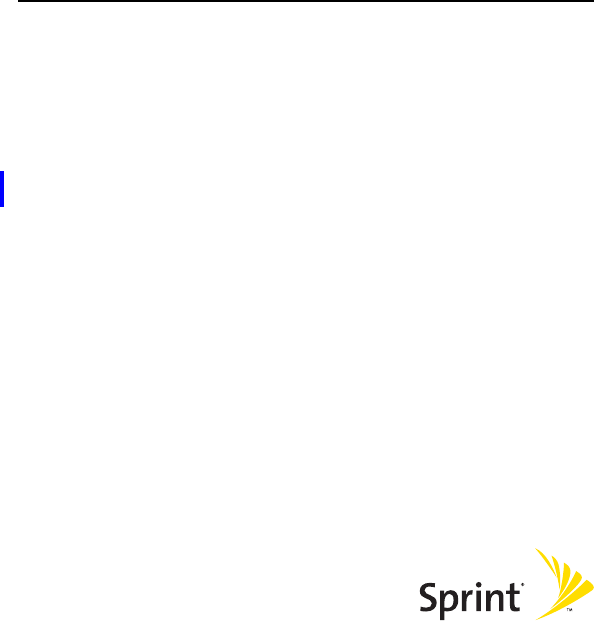
Section 8
Safety and Specifications
FINAL DRAFT Palm, Inc. Confidential
360
FINAL DRAFT Palm, Inc. Confidential

Section 8A: Important Safety Information 361
Safety
Section 8A
Important Safety Information
In This Section
ࡗGeneral Precautions
ࡗMaintaining Safe Use of and Access to Your Device
ࡗUsing Your Phone With a Hearing Aid Device
ࡗCaring for the Battery
ࡗRadiofrequency (RF) Energy
ࡗStatic Electricity, ESD, and Your Device
ࡗOwner’s Record
ࡗUser’s Guide Proprietary Notice
This guide contains important operational and safety information that will help you
safely use your Treo™ 700P smart device. Failure to read and follow the information
provided in this guide may result in serious bodily injury, death, or property
damage.
FINAL DRAFT Palm, Inc. Confidential

362 Section 8A: Important Safety Information
General Precautions
There are several simple guidelines to operating your device properly and
maintaining safe, satisfactory service.
ⅷHold the device with the antenna over your shoulder.
ⅷTry not to hold, bend, or twist the device’s antenna.
ⅷDon’t use the device if the antenna is damaged.
ⅷSpeak directly into the microphone.
ⅷAvoid exposing your device and accessories to rain or liquid spills. If your
device does get wet, immediately turn the power off and remove the battery.
ⅷAlthough your device is quite sturdy, it is a complex piece of equipment and
can be broken. Avoid dropping, hitting, bending, or sitting on it.
ⅷAny changes or modifications to your device not expressly approved in this
document could void your warranty for this equipment and void your
authority to operate this equipment.
Note: For the best care of your device, only Sprint authorized personnel should service
your device and accessories. Failure to do so may be dangerous and void your
warranty.
FINAL DRAFT Palm, Inc. Confidential
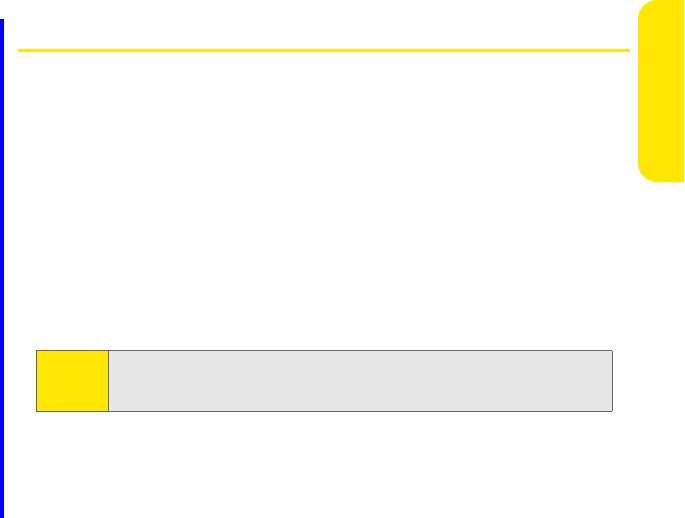
Section 8A: Important Safety Information 363
Safety
Maintaining Safe Use of and Access to Your Device
Do Not Rely on Your Device’s Phone for Emergency Calls
Wireless phones such as the one on your Treo device operate using radio signals,
which cannot guarantee connection in all conditions. Therefore you should never
rely solely upon any wireless phone for essential communication (for example,
medical emergencies). Emergency calls may not be possible on all cellular
networks or when certain network services and/or phone features are in use.
Check with your local service provider for details.
Using Your Phone While Driving
Talking on your phone while driving (or operating the phone without a hands-
free device) is prohibited in some jurisdictions. Laws vary as to specific
restrictions. Remember that safety always comes first.
Following Safety Guidelines
To operate your device safely and efficiently, always follow any special regulations
in a given area. Turn your device’s phone off in areas where use is forbidden or
when it may cause interference or danger.
Tip: Purchase an optional hands-free accessory at your local Sprint Store, or call the
Sprint PCS Accessory Hotline at 1-800-974-2221 or by dialing # 2 2 2 on your
Treo 700P smart device.
FINAL DRAFT Palm, Inc. Confidential

364 Section 8A: Important Safety Information
Using Your Device’s Phone Near Other Electronic Devices
Most modern electronic equipment is shielded from radiofrequency (RF) signals.
However, RF signals from wireless phones may affect inadequately shielded
electronic equipment.
RF signals may affect improperly installed or inadequately shielded electronic
operating systems and/or entertainment systems in motor vehicles. Check with
the manufacturer or their representative to determine if these systems are
adequately shielded from external RF signals. Also check with the manufacturer
regarding any equipment that has been added to your vehicle.
Consult the manufacturer of any personal medical devices, such as pacemakers
and hearing aids, to determine if they are adequately shielded from external RF
signals.
Turning Off Your Phone Before Flying
Turn off your phone before boarding any aircraft. To prevent possible interference
with aircraft systems, the U.S. Federal Aviation Administration (FAA) regulations
require you to have permission from a crew member to use your phone while the
plane is on the ground. To prevent any risk of interference, FCC regulations
prohibit using your phone while the plane is in the air.
Note: Always turn off the phone in health care facilities and request permission
before using the phone near medical equipment.
FINAL DRAFT Palm, Inc. Confidential

Section 8A: Important Safety Information 365
Safety
Turning Off Your Phone in Dangerous Areas
To avoid interfering with blasting operations, turn your phone off when in a
blasting area or in other areas with signs indicating two-way radios should be
turned off. Construction crews often use remote-control RF devices to set off
explosives.
Turn your phone off when you’re in any area that has a potentially explosive
atmosphere. Although it’s rare, your phone and accessories could generate
sparks. Sparks can cause an explosion or fire, resulting in bodily injury or even
death. These areas are often, but not always, clearly marked. They include:
ⅷFueling areas such as gas stations.
ⅷBelow deck on boats.
ⅷFuel or chemical transfer or storage facilities.
ⅷAreas where the air contains chemicals or particles such as grain, dust, or
metal powders.
ⅷAny other area where you would normally be advised to turn off your vehicle’s
engine.
Restricting Children’s Access to Your Device
Your Treo device is not a toy. Do not allow children to play with it as they could
hurt themselves and others, damage the device and/or its phone, or make calls
that increase your Sprint PCS Invoice.
Note: Never transport or store flammable gas, flammable liquid, or explosives in the
compartment of your vehicle that contains your phone or accessories.
FINAL DRAFT Palm, Inc. Confidential
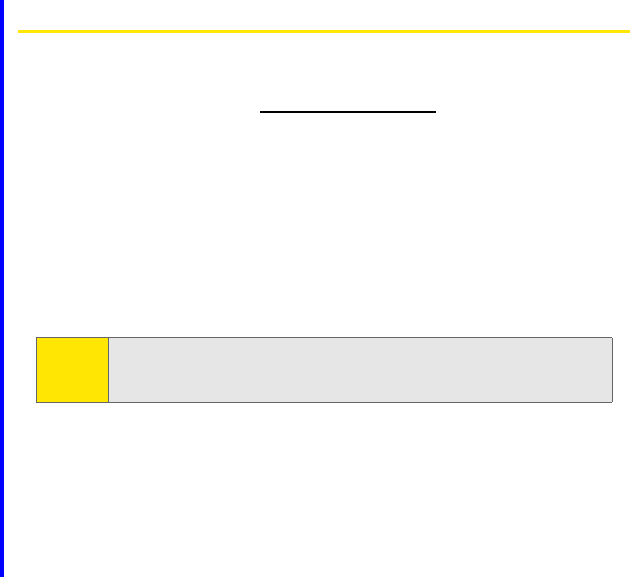
366 Section 8A: Important Safety Information
Using Your Phone With a Hearing Aid Device
Your Treo™ 700P smart device is compliant with the FCC Hearing Aid Compatibil-
ity (HAC) requirements. For additional HAC information, including the HAC rating
of this product, please refer to www.palm.com/treoHAC.
Your device has been tested for hearing aid device compatibility. When some
wireless phones are used near some hearing devices (hearing aids and cochlear
implants), users may detect a buzzing, humming, or whining noise. Some hearing
devices are more immune than others to this interference noise, and phones also
vary in the amount of interference they generate.
The wireless telephone industry has developed ratings for some of their mobile
phones, to assist hearing device users in finding phones that may be compatible
with their hearing devices. Not all phones have been rated. Phones that have
been rated will have an “M3” or “M4” rating on the box. Your Treo 700P smart
device phone has an M3 rating.
The M3/M4 ratings do not guarantee successful interoperation between your
phone and hearing aid device. Results will vary depending on the level of
immunity of your hearing device and degree of your hearing loss.
The more immune your hearing aid device is, the less likely you are to experience
interference noise from your wireless phone. Hearing aid devices should have
ratings similar to phones. Ask your hearing healthcare professional for the rating
of your aids. Most new hearing aids have at least an M2 immunity level. Add the
“M” ratings of your hearing aid and your phone to determine probable usability:
Note: Phones rated M3 or M4 meet FCC requirements and may generate less
interference to hearing devices than phones that are not labeled. M4 is the
better/higher of the two ratings.
FINAL DRAFT Palm, Inc. Confidential

Section 8A: Important Safety Information 367
Safety
ⅷAny combined rating equal to or greater than six offers best use.
ⅷAny combined rating equal to five is considered normal use.
ⅷAny combined rating equal to four is considered usable.
Thus, if you pair an M3 hearing aid with an M3 phone, you will have a combined
rating of six for “best use.”
Sprint further suggests you experiment with multiple phones (even those not
labeled M3 or M4) while in the store to find the one that works best with your
hearing aid device. Should you experience interference after purchasing your
phone, promptly return it to the store. With the Sprint 14-day Risk-Free
Guarantee you may return the phone within 14 days of purchase for a full refund.
Getting the Best Hearing Device Experience With Your Treo 700P Smart Device
To further minimize interference:
ⅷThere is usually less interference on the microphone setting than the telecoil
setting.
ⅷSet the phone’s screen and keyboard backlight settings to ensure the
minimum time interval. See “Optimizing Power Settings” on page 296 for
instructions.
ⅷPosition the phone so the antenna is farthest from your hearing aid.
ⅷMove the phone around to find the point with least interference.
FINAL DRAFT Palm, Inc. Confidential

368 Section 8A: Important Safety Information
Caring for the Battery
Protecting Your Battery
The guidelines listed below help you get the most out of your battery’s
performance.
ⅷRecently there have been some public reports of wireless phone batteries
overheating, catching fire, or exploding. It appears that many, if not all, of
these reports involve counterfeit or inexpensive, aftermarket-brand batteries
with unknown or questionable manufacturing standards. Sprint is not aware
of similar problems with Sprint PCS® Treo devices resulting from the proper
use of batteries and accessories approved by Sprint or the manufacturer of
your phone. Use only Sprint or manufacturer-approved batteries and
accessories found at Sprint Stores or through your device’s manufacturer, or
call 1-866-343-1114 to order. They’re also available at www.sprint.com — click
on the Shopping tab at top, then look under Phones & Accessories. Buying the
right batteries and accessories is the best way to ensure they’re genuine and
safe.
ⅷIn order to avoid damage, charge the battery only in temperatures that range
from 32° F to 113° F (0° C to 45° C).
ⅷDon’t use the battery charger in direct sunlight or in high humidity areas,
such as the bathroom.
ⅷNever dispose of the battery by incineration.
ⅷKeep the metal contacts on top of the battery clean.
ⅷDon’t attempt to disassemble or short-circuit the battery.
ⅷThe battery may need recharging if it has not been used for a long period of
time.
FINAL DRAFT Palm, Inc. Confidential

Section 8A: Important Safety Information 369
Safety
ⅷIt’s best to replace the battery when it no longer provides acceptable
performance. It can be recharged hundreds of times before it needs replacing.
ⅷDon’t store the battery in high temperature areas for long periods of time. It’s
best to follow these storage rules:
ⅢLess than one month:
-4° F to 140° F (-20° C to 60° C)
ⅢMore than one month:
-4° F to 113° F (-20° C to 45° C)
Disposal of Lithium Ion (LiIon) Batteries
Do not handle a damaged or leaking LiIon battery as you can be burned.
For safe disposal options of your LiIon batteries, contact your nearest Sprint
authorized service center.
Special Note: Be sure to dispose of your battery properly. In some areas, the
disposal of batteries in household or business trash may be prohibited.
FINAL DRAFT Palm, Inc. Confidential

370 Section 8A: Important Safety Information
Radiofrequency (RF) Energy
Understanding How Your Phone Operates
Your phone is basically a radio transmitter and receiver. When it’s turned on, it
receives and transmits radiofrequency (RF) signals. When you use your phone, the
system handling your call controls the power level. This power can range from
0.006 watts to 0.2 watts in digital mode.
Knowing Radiofrequency Safety
The design of your Sprint PCS Treo device complies with updated NCRP standards
described below.
In 1991-92, the Institute of Electrical and Electronics Engineers (IEEE) and the
American National Standards Institute (ANSI) joined in updating ANSI’s 1982
standard for safety levels with respect to human exposure to RF signals. More
than 120 scientists, engineers and physicians from universities, government
health agencies and industries developed this updated standard after reviewing
the available body of research. In 1993, the Federal Communications Commission
(FCC) adopted this updated standard in a regulation. In August 1996, the FCC
adopted hybrid standard consisting of the existing ANSI/IEEE standard and the
guidelines published by the National Council of Radiation Protection and
Measurements (NCRP).
FINAL DRAFT Palm, Inc. Confidential

Section 8A: Important Safety Information 371
Safety
Body-Worn Operation
To maintain compliance with FCC RF exposure guidelines, if you wear a handset
on your body, use the Sprint-supplied or -approved carrying case, holster, or other
body-worn accessory. If you do not use a body-worn accessory, ensure the
antenna is at least 7/16 inch (1.5 centimeters) from your body when
transmitting. Use of non-Sprint-approved accessories may violate FCC RF
exposure guidelines.
For more information about RF exposure, visit the FCC Web site at www.fcc.gov.
Specific Absorption Rate (SAR) for Wireless Phones
The SAR is a value that corresponds to the relative amount of RF energy absorbed
in the head of a user of a wireless handset.
The SAR value of a phone is the result of an extensive testing, measuring, and
calculation process. It does not represent how much RF the phone emits. All
phone models are tested at their highest value in strict laboratory settings. But
when in operation, the SAR of a phone can be substantially less than the level
reported to the FCC. This is because of a variety of factors including its proximity
to a base station antenna, phone design, and other factors. What is important to
remember is that each phone meets strict federal guidelines. Variations in SARs
do not represent a variation in safety.
All phones must meet the federal standard, which incorporates a substantial
margin of safety. As stated above, variations in SAR values between different
model phones do not mean variations in safety. SAR values at or below the
federal standard of 1.6 W/kg are considered safe for use by the public.
FINAL DRAFT Palm, Inc. Confidential

372 Section 8A: Important Safety Information
The highest reported (FCC) SAR values of the Treo™ 700P smart device by Palm
are:
FCC Radiofrequency Emission
FCC Radiofrequency Emission
This phone meets the FCC Radiofrequency Emission Guidelines and is certified
with the FCC as:
FCC ID number: O8F93001.
More information on the phone’s SAR can be found from the following
FCC Web site:
https://gullfoss2.fcc.gov/prod/oet/cf/eas/reports/GenericSearch.cfm.
Maximum SAR Values CDMA Cellular CDMA PCS
Held to Ear 1.48 (W/Kg) 1.13 (W/Kg)
Body-Worn .896 (W/Kg) .589 (W/Kg)
FINAL DRAFT Palm, Inc. Confidential

Section 8A: Important Safety Information 373
Safety
Static Electricity, ESD, and Your Device
Electrostatic discharge (ESD) can cause damage to electronic devices if discharged
into the device, so you should take steps to avoid such an occurrence.
Description of ESD
Static electricity is an electrical charge caused by the buildup of excess electrons
on the surface of a material. To most people, static electricity and ESD are nothing
more than annoyances. For example, after walking over a carpet while scuffing
your feet, building up electrons on your body, you may get a shock—the dis-
charge event—when you touch a metal doorknob. This little shock discharges the
built-up static electricity.
ESD-Susceptible Equipment
Even a small amount of ESD can harm circuitry, so when working with electronic
devices, take measures to help protect your electronic devices, including your
Palm® device, from ESD harm. While Palm has built protections against ESD into
its products, ESD unfortunately exists and, unless neutralized, could build up
to levels that could harm your equipment. Any electronic device that contains an
external entry point for plugging in anything from cables to docking stations is
susceptible to entry of ESD. Devices that you carry with you, such as your device,
build up ESD in a unique way because the static electricity that may have built up
on your body is automatically passed to the device. Then, when the device is con-
nected to another device such as a docking station, a discharge event can occur.
FINAL DRAFT Palm, Inc. Confidential

374 Section 8A: Important Safety Information
Precautions Against ESD
Make sure to discharge any built-up static electricity from yourself and your elec-
tronic devices before touching an electronic device or connecting one device to
another. The recommendation from Palm is that you take this precaution before
connecting your device to your computer, placing the device in a cradle, or con-
necting it to any other device. You can do this in many ways, including the follow-
ing:
ⅷGround yourself when you’re holding your mobile device by simultaneously
touching a metal surface that is at earth ground. For example, if your
computer has a metal case and is plugged into a standard three-prong
grounded outlet, touching the case should discharge the ESD on your body.
ⅷIncrease the relative humidity of your environment.
ⅷInstall ESD-specific prevention items, such as grounding mats.
Conditions That Enhance ESD Occurrences
Conditions that can contribute to the buildup of static electricity in the environ-
ment include the following:
ⅷLow relative humidity.
ⅷMaterial type (The type of material gathering the charge. For example,
synthetics are more prone to static buildup than natural fibers like cotton.)
ⅷThe rapidity with which you touch, connect, or disconnect electronic devices.
While you should always take appropriate precautions to discharge static elec-
tricity, if you are in an environment where you notice ESD events, you may want
to take extra precautions to protect your electronic equipment against ESD.
FINAL DRAFT Palm, Inc. Confidential

Section 8A: Important Safety Information 375
Safety
Owner’s Record
The model number, regulatory number, and serial number are located on a
nameplate inside the battery compartment. Record the serial number in the
space provided below. This will be helpful if you need to contact us about your
phone in the future.
Model: Sprint PCS Smart Device Treo™ 700P , by Palm
Serial No.:
User’s Guide Proprietary Notice
CDMA Technology is licensed by QUALCOMM Incorporated under one or more of
the following patents:
4,901,307 5,109,390 5,267,262 5,416,797
5,506,865 5,544,196 5,657,420 5,101,501
5,267,261 5,414,796 5,504,773 5,535,239
5,600,754 5,778,338 5,228,054 5,337,338
5,710,784 5,056,109 5,568,483 5,659,569
5,490,165 5,511,073
User’s Guide template version 5B (October 2005)
FINAL DRAFT Palm, Inc. Confidential
376 Section 8A: Important Safety Information
FINAL DRAFT Palm, Inc. Confidential

Section 8B: Specifications 377
Specifications
Section 8B
Specifications
In This Section
ࡗSpecifications
FINAL DRAFT Palm, Inc. Confidential

378 Section 8B: Specifications
Specifications
Radio CDMA 1900/800 MHz digital dual-band
EVDO and 1xRTT
Phone features Personal speakerphone
Hands-free headset jack
(2.5mm, 3-barrel connector)
Microphone mute option
TTY/TDD compatibility
3-way calling
Processor technology Intel XScale™ processor, 312MHz
Expansion SD/MultiMediaCard/SDIO card slot
Battery Rechargeable Lithium Ion
Removable for replacement
Up to 4.7 hours talk time
Up to 15 days standby time
3.5 hours full charge time
Palm OS version Palm OS® 5.4.9
Camera (not included
on all models)
Still image capture resolution (1280 x 1024), 1.3 megapixel
2x digital zoom
Video capture resolution (352 x 288)
Automatic light balance
Size/weight 5.08" x 2.28" x 0.89" with antenna
(129 mm x 58 mm x 22.5 mm)
6.4 ounces (180 g)
Connectivity Bluetooth® wireless technology
(1.2 compliant)
IR
FINAL DRAFT Palm, Inc. Confidential

Section 8B: Specifications 379
Specifications
Display Touch-sensitive LCD screen (includes stylus)
65,536 colors (16-bit color)
User-adjustable brightness
Keyboard Built-in QWERTY keyboard plus 5-way navigator
Backlight for low lighting conditions
Included software Phone (including Palm OS,
Favorites, Dial Pad)
Camera
Camcorder
Pics&Videos
Web browser (Internet)
Sprint PCS Business ConnectionSM
VersaMail® (email)
Calendar
Contacts
Tasks
SMS (text messages)
Sprint PCS® Picture Mail
(multimedia messages)
Calculator (basic/advanced)
Memos
World Clock
Voice Memo
Documents To Go
Palm® Desktop software/
HotSync® manager
Sprint TV
Pocket Tunes™ (music)
System requirements Windows 2000 or XP with USB port
Mac OS 10.2–10.3.x with USB port
Later versions may also be supported
Operating and storage
temperature range
32°F to 104°F (0°C to 40°C) 5% to 90% Relative Humidity (RH)
FINAL DRAFT Palm, Inc. Confidential
380 Section 8B: Specifications
FINAL DRAFT Palm, Inc. Confidential

Index 381
Index
Index
Numerics
1XRTT protocol 353
24-hour clock 288
5-way navigator 7, 40, 299
A
AC charger 9, 15, 307
accented characters 48, 49
accessing
alternate characters 47
alternative features 355
Bluetooth application 179, 272
calculator 248
command buttons 42
common tasks 78
Contacts list 58
corporate accounts 306
Dial Pad 57, 68
email 110, 142
invoicing information 352
messages 23
online album 200
palmOne online support 350
personal accounts 24, 351
personal information 301
Phone Book 220
Sprint PCS Vision services 111
Sprint PCS Web page 351
voicemail 66
Web pages 16, 152, 159, 166, 167
web pages 161
World Clock 246
accessories 276, 307, 351
account passwords 24
Accounts command 136
accounts. See Sprint PCS Vision Accounts
actions 41
activating
keyboard backlight 46
Sprint PCS Vision Smart Device 20
activating items on screen 42
Active Call View 69
Active Call view 67
active calls 72
adapters 307
Add Bookmark command 167
Add Call button 68
Add Contact command 70
Add New Contact prompt 70
Add Songs to Playlist screen 210, 211
Add Voice Memo option 149
adding
accessories 276, 307, 351
alerts 228
backgrounds 232
Bluetooth devices 176
FINAL DRAFT Palm, Inc. Confidential
382 Index
bookmarks 167–169
caller ID photos 221
Caller ID pictures 221
categories 290
cities to World Clock 246
contacts 79, 220
events 228, 229
favorite buttons 78–81
memos 240
passwords 24, 303
QuickText phrases 150
songs to playlists 211
tasks 235
trusted pairs 174, 272
voice captions 188
add-on applications 40
Address Book 76
addresses
adding multiple 80
creating links for 152
entering text messaging 146, 148,
150
highlighting 42
multiple recipients and 150
Sprint PCS Voice Command and 76
adjusting screen brightness 17, 286
adjusting volume 7, 90
music 209
phone calls 21
Advanced Mode (calculator) 248, 249,
250
Agenda view 224, 232
alarm 10, 89
See also alerts
alarm clock 247
Alarm Preferences command 247
Alarm Preset check box 234
Alarm Sound pick list 234, 239
alarm tones 233
album pick list 201
albums
adding pictures to 195, 200, 216
Alert Manager symbol 321
Alert screen 64, 151, 228
Alert Volume and Vibrate settings 89
alerts
adding 228
assigning to tasks 239
caution for incoming calls and 63
configuring message 157
displaying pending 228
selecting tones for 88, 233
setting multiple 151
setting up voicemail 64
untimed events and 228
viewing 101
Alerts command 157
aligning screen 289
Alt key 353
FINAL DRAFT Palm, Inc. Confidential

Index 383
Index
alternate characters 48, 49
anniversaries 228
Answer button 62
answering phone 23, 62, 71, 83
answering service. See voicemail
antenna 10
application buttons 50, 55
Application favorite buttons 80
application preferences 290–291, 293
applications
accessing Palm OS 52
arranging 290, 291
associating with buttons 292
beaming 266
copying 280
customizing 290
cycling through 52
displaying information about 260
displaying list of 291
displaying menus for 43
displaying private entries in 304
downloading 163, 256
expansion cards and 279
getting help with 350
installing 255–??, 255–257, 346, 347
navigational control and third-
party 40
opening 50, 279
removing 258, 259
searching 254
sending over Bluetooth
connections 261
setting default 293
synchronizing information from 31
transferring information from 33
troubleshooting 347
uninstalling 315
Applications button 52
Applications settings 290, 293
Applications View 279
Applications view 52, 279, 291, 353
appointments. See Calendar application
Archive folder 258
area conversions 249
arrow icons (documentation) 40
assigning passwords 24, 303
assistance 350, 352
attaching charger cable 13, 15
attachments 131–133
storing large 346
voice memos as 245
attendees 231
audio
listening to 82
audio captions
background music and 194
audio files 206
audio formats 206
audio player. See RealOne Player
Auto Lock Device box 301
FINAL DRAFT Palm, Inc. Confidential
384 Index
Auto naming pick list 192
Auto-Keyguard preference 298
automated invoicing information 352
automatic resets 349
automatic shut-off 296
auto-off interval 353
Auto-off setting 17, 296
B
back view (Sprint PCS device) 8
Background check box 232
background music 194
backgrounds 186, 232
Backspace key 59
Backup folder 258, 259
band width 16
Basic Mode (calculator) 248
basics 350
battery
charging 13–??, 13, ??–14, 16
conserving power for 16–17, 296
inserting 8, 11
recharging 16
replacing 307, 317
viewing status of 101
battery charge indicators 101
battery door release 8
Battery Door Release button 11
battery specifications 378
battery-ready indicator 13, 14
Beam Business Card command 223
Beam Category command 265
Beam command 265, 266
Beam Receive pick list 296
Beam Status dialog box 265, 266
beaming information 264–267, 353
beeps 55
See also alerts
belt clip 307
billing information 112
birthdays 228
blank screens 320
blinking asterisk 103, 321
Bluetooth application 84, 175, 176, 179,
272
Bluetooth devices 82, 84, 333
connecting to 174–??
naming 84, 175
turning on and off 101
viewing status of 101
Bluetooth headsets 68
Bluetooth technology 174–263
bookmarks 167–169, 264
Bookmarks view 168
Bookmarks view icon 168
brightness (screen) 17, 286
browser. See Web browser
built-in applications 255, 258, 350
built-in camera. See camera
built-in security software 297
FINAL DRAFT Palm, Inc. Confidential

Index 385
Index
business cards 223, 266
Business Connection application. See
Sprint PCS Business Connection
business directories 110
buttons
accessing command 42
accidentally pressing 68
arrow icons and navigator 40
assigning Quick Keys to 78
changing favorites 81
creating favorites 78–81
disabling 299
enabling dialog box 43
highlighting 42
opening applications from 50
reassigning 7
restoring factory defaults for 292
selecting 41
setting preferences for 292
waking up screen with 55
C
cache 171, 346
cache preferences 171
calculator 248–250
Calculator icon 248
Calendar 224
calendar
See also Calendar application
accessing from PCS Business
Connection 142, 143
accessing from Sprint PCS Business
Connection 110
adding alerts to 228
adding backgrounds to 232
adding events 228, 229
changing events for 231
customizing 231–233
deleting events 231
displaying 51
moving through 225
setting default view for 232
setting first day of week for 288
Calendar application
See also calendar
changing screen fonts for 287
color-coding events with 230
defining custom intervals for 229
displaying current event in 102
displaying current events from 93
managing events with 224–231
opening 7, 51
selecting views 224
setting display options in 231
setting sound preferences 233
synchronizing information in 33
viewing event status for 102
Calendar button 7, 51, 224
call forwarding 101
FINAL DRAFT Palm, Inc. Confidential
386 Index
call lists 61
Call Log buttons 80
Call Log View 61, 70
call waiting 63, 71, 98
Call Waiting dialog box 71
caller ID pictures 186
caller ID preferences 88, 90, 91
caller IDs 70, 221
calling cards 352
calling Customer Service 24, 351
calls. See phone
Camcorder icon 188
camera
customizing 191
location of built-in 8
power consumption and 17
specifications for 378
taking pictures 186–188
Camera icon 187
Cancel Spkr button 67
Caps Lock 47
Card Info application 281
Card Info button 281
card readers 207
categories
contacts and 221
receiving from Bluetooth and 263
Category command 290
Category pick list
applications 290
events 230, 232, 233
memos 240
tasks 235, 237
CDs 208
Center button 44
Change Lock Code setting 300
changing
bookmarks 168
color scheme 289
contact information 222
default settings 283
events 231
favorite buttons 81
passwords 24, 304
playlists 211
screen fonts 287
text entry fields 42
characters
accessing international 353
displaying alternate 48
displaying hexadecimal 249
entering from keyboard 47
maximum in notes 240
maximum in text messaging 146
messages and invalid 150
Quick Keys and 78
searching on 254
typing accented 48
charge indicator light 13
charge indicators 101
FINAL DRAFT Palm, Inc. Confidential

Index 387
Index
charger adapter 15
charger cable 13, 15
chargers (optional) 307
charging battery 13–14, 16
charging connector 9
charging the battery 13
Chat screen 154
chat session icon 155
chat sessions 109, 154, 156
Chat view 154, 157
choosing
applications 279
chat sessions 154
web links 161
City pick list 246
Clear Cache preferences 171
clock 51, 246, 288
clock preferences 294
collect calls 352
color palette 191
color preferences 289
color-coded category marker 233
color-coding events 230
Colors Theme screen 289
command buttons 42
command shortcuts 43
See also menus
compact discs 208
company names 305
completed tasks 238
completion dates 238
Compress Day View check box 232
compressed files 256
computers
downloading applications to 256
synchronizing with 33
transferring multimedia to 202
updating information on 33
computers. See CPUs
conduit software 31
conference calls 71, 74
configuring Sprint PCS Vision
services 108
Connect to the Internet dialog box 108
connecting
to websites 354
connecting to power sources 14
connections
Bluetooth devices 174–??
opening Internet 108
precautions for 374
receiving information over
Bluetooth 262
sending information over
Bluetooth 261
setting up 108
Sprint PCS Vision services 111
Sprint PCS Vision Smart Device 32
troubleshooting 330, 334, 340
TTY devices and 96
FINAL DRAFT Palm, Inc. Confidential
388 Index
viewing status of 100, 338, 340
connectivity 378
constants 250
Contact Edit dialog box 221
Contact Edit view 221–222
contacts
adding 79, 220
assigning pictures to 91, 92, 299, 300
changing information for 222
deleting 222
dialing by 58
entering multiple 220, 224
entering phone numbers for 70
marking as private 221
Contacts application 220–223
changing screen fonts for 287
synchronizing information in 33
Contacts buttons 80, 220
Contacts list 59, 222
context sensitive actions 7
conversion functions 249
cookies 170
coprocessing units. See CPUs
copying
applications 280
multimedia files 202
phone numbers 57
pictures 196
text 165
video clips 196
corporate accounts 142, 143, 306
coverage area 100
monitoring signal strength for 330
power consumption and 17
coverage maps 351
CPUs
connecting to 32
interactions with 26
removing applications from 259
transferring music from 206
creating
bookmarks 167–169
caller ID photos 221
categories 290
contact information 79, 220
events 226, 228, 229
memos 240
messages 129, 146
passwords 24, 303
playlists 210
QuickText phrases 150
tasks 235
trusted pairs 174, 272
voice captions 188
current events 102
Current Privacy pick list 303
Customer Service 24, 351
customer support 350
customizing
applications 290–291
FINAL DRAFT Palm, Inc. Confidential

Index 389
Index
buttons 292
calendar 231–233
camera 191
date and time ??–288, 294–??
email 136
messages 156
phone ??–93
screen 286–289
Sprint PCS Vision Smart Device 283
tasks 238
Web browser 170–172
D
Daily Repeating Events check box 233
data
accessing 24
locking 297
losing 315
protecting 24, 302
receiving over Bluetooth
connections 262
restoring 301
sending over Bluetooth
connections 261
storing 16, 346
synchronizing 16, 26, 33–35
transferring 264
updating 33
data service icons 338, 340
data services 338, 340
Date & Time Preferences screen 294
date formats 288
Date pick list 288
Date stamp pick list 191
dates
sorting on 152
dates. See calendar
Day view 225, 232
Daylight Savings Time 294
decimal display formats 249, 288
Default Apps preferences 293
default password 24
default settings 33
Default View pick list 232
defaults, restoring 292
Delete Contact command 222
Delete events older than pick list 231
Delete From pick list 258
Delete Item command 238, 240
deleting
applications 258, 259
bookmarks 168
contacts 222
email 135, 346
events 231
favorite buttons 81
memos 240
messages 156
photos 188, 189
pictures 199
FINAL DRAFT Palm, Inc. Confidential
390 Index
playlists 211
private entries 304
tasks 238
text messages 153
Details button 42
device
ESD and 373
Device name field 84, 175
device name field 272
Dial dialog box 60
Dial Extra Digits Automatically option 80
Dial Pad 57, 68
Dial Pad buttons 68, 80
dialing 57–??, 68, 71
dialing shortcuts 79
dialog boxes 43
getting help with 350
digital movies 109
digital networks 98
digital pictures 109
Directory Assistance 352
Disable Cookies check box 170
Disable Images check box 171
Disable JavaScript check box 171
disabling
Add New Contact prompt 70
cookies 170
onscreen buttons 299
playback 210
smart device 17
Discovery Results View 176, 261
disk space 346
display options (calendar) 231
Display Options command 231
display. See screen
displaying
alerts 101
alternate characters 48
applications 290, 291
attachments 133
available applications 52
calendar 51
clock 51
connection status 100, 338, 340
contact information 222
current event 102
decimal values 249, 288
events 233
menu items 43
numeric pages 66
on-device guide 350
pending alerts 228
photos 202
pictures 193, 200, 202
private entries 303
recently dialed numbers 61
recording time 190
status information 7, 100
tasks 232, 237, 238
tips 350
FINAL DRAFT Palm, Inc. Confidential

Index 391
Index
unread messages 102, 232
video clips 194, 202
Web pages 160, 166, 167
web pages 160
docking cradle 307
documentation ii, 4, 350
arrow icons in 40
Documents application
creating files 243
editing files 243
overview 242
viewing files 243
downloading
applications 163, 256
files 163, 164
from the web 163–164
images 110
ringtones 109
songs 206
support information 350
Drafts button 130
Due Date pick list 235
due dates 235, 237, 238
E
earpiece 7, 68
eBooks 16
Edit Bookmarks command 168
Edit Categories option 290
Edit Favorites Button command 81
Edit Favorites Pages command 78, 81
Edit QuickText option 150
editing. See changing
Effects pick list 191
electrostatic discharge 373–374
email
accessing 110, 142, 306
active calls and 69
adding attachments to 131–133
adding links to 152
addressing 80
attaching voice memos to 245
checking status of 128
checking unread messages for 102,
232
creating 129
customizing 136
deleting 135, 346
highlighting addresses 42
marking priority for 130
power consumption for 16
responding to 129
sending 129
setting default browser for 293
setting up accounts for 124–??
sort options for 128
switching accounts for 136
troubleshooting 334–337
viewing attachments in 133
Email buttons 80
FINAL DRAFT Palm, Inc. Confidential
392 Index
email providers 122
emergency calls 95, 299
emoticons 150
emotive symbols 150
Empty battery icon 14
Enable Background Playback check
box 210
Enable Local Network Time box 294
enabling
Bluetooth devices 272
wide web page layout 160
entering
passkeys 176, 177
phone numbers 70
entering information 47
entering phone numbers 221
errors 349
ESD (electrostatic discharge) 373–374
event conflicts 102, 232
events
adding alerts for 228
adding notes to 231
changing 231
checking status of 102
color-coding 230
creating 226, 228, 229
deleting 231
displaying 233
purging 231
rescheduling 231
scheduling 226
viewing duration of 232
events, assigning time zones to 227
Excel files 132, 243
Excel spreadsheets
managing files for 242
opening 243
exiting pick lists 44
expansion card slot 10, 276, 378
expansion cards
copying applications to 280
downloading to 163, 164
formatting 281, 282
moving pictures to 196
opening applications on 279
overview 276
removing applications from 258
storing information on 346
transferring music to 206
viewing information about 281
extending battery life 16
extensions (phone calls) 68, 80
Extra Digits button 65, 68
Extra Digits option 80
F
fade setting 232
FAQs 351
favorite buttons
assigning images to 110
FINAL DRAFT Palm, Inc. Confidential

Index 393
Index
defining 78–81
Favorites pages 81
features 43, 109
files 133, 163, 164
opening 243
files, downloading 163
financial calculator 249
Find dialog box 254
Find Text on Page command 166
finding
Sprint PCS Vision user names 111
text 166, 254
5-way navigator 299
Flash mode 74
Font command 287
fonts 287
forgetting passwords 301, 304
Formats command 288
Formats Preferences screen 288
formatting
date and time 288
expansion cards 281, 282
numbers 288
Forward all calls pick list 74
forwarding messages 129
freeing memory 171, 238, 258, 346
frequently asked questions 351
front view (Sprint PCS device) 6
Full battery icon 14
full charge (battery) 13
functions 249
G
Game Volume pick list 285
games 109
Games icon 109
Get BC icon 142, 143
getting started 350
Glossary 353
glossary iii
graphics. See images
green lightning bolt 14
greeting messages 64
Guest Books 150
H
handset speaker 7
hands-free devices 9, 82
troubleshooting 333–334
Hands-free Setup screen 85, 176
Hang Up All button 72
Hang Up button 67
hard resets 301, 315
hardware 4
headsets 9, 82
listening to music and 82
hearing-impaired services 96
help 257, 348, 350, 351
hexadecimal characters 249
Hide Records setting 303
FINAL DRAFT Palm, Inc. Confidential
394 Index
hiding private entries 303
highlighting
items on screen 41
phone numbers 60
web links 161
highlighting applications 52
highlighting screen items 41
hints 301
History command 166
History list 166
Hold button 68
holding phone calls 69
holidays 228
home city 246
home pages 170
HotSync button 35
HotSync cable 32, 307
HotSync connector 9
HotSync cradle 307
HotSync Manager 354
HotSync operations 28, 35
See also synchronization
HotSync technology 353
hyperlinks. See Web links
I
icons 112, 291
Ignore button 62, 72
images 171
disabling 162
downloading 110
managing online 201
saving 164
setting preferences for 191
troubleshooting 343
inactive devices 302
Inbox 155
Inbox folder 135, 154
included software 379
indicator light 7, 13, 14
Info screen 260
information
accessing 24
beaming 264–267, 353
entering 47
locking 297
losing 282, 301, 315
marking as private 302
protecting 24, 302
receiving automated invoicing 352
receiving over Bluetooth
connections 262
restoring 301
sending over Bluetooth
connections 261
setting owner preferences for 305
storing 16, 346
synchronizing 16, 26, 31, 33, 35
updating 33
information screens 41
FINAL DRAFT Palm, Inc. Confidential

Index 395
Index
Infrared port. See IR port
infrared-enabled devices 10
inserting battery 8, 11
installer 255
installing
applications 255–??, 255–257, 346,
347
bonus software 255
synchronization software 26
third-party applications 319
interference 331, 333
international characters 353
international clock 246, 288
international travel adapters 307
Internet connections 354
enabling 55
installing from 256
opening 108
setting up proxy server for 172
troubleshooting 340
viewing online album from 200
invalid characters 150
invoicing information 352
IR devices 354
IR port 10, 264, 354
items
highlighting 41
selecting or activating 42
iTunes 205
K
keyboard
accessing alternate characters on 47
dialing with 58
locking 297, 299
overview 45–48
restoring factory defaults for 292
selecting menu commands with 43
setting timed events with 226
setting up Quick Keys for 78
silencing ringer from 63
keyboard shortcuts 292
Keyguard 297
Keyguard preferences 298, 299
Known Caller Tone pick list 88, 90
L
language settings 320
large attachments 346
launching applications 50, 279
LED display 7
length conversions 249
lens (camera) 8
letters. See characters
liability 2
light. See indicator light
lightning bolts 14
Li-Ion battery. See battery
Li-Ion technology 354
links. See Web links
FINAL DRAFT Palm, Inc. Confidential
396 Index
list screens 42
list view 291
listening to music 82, 203–211
listening to voice captions 193, 201
lists 44
Lithium Ion technology 354
loading web pages 342
locating
Sprint PCS Vision user names 111
text 166, 254
location privacy icon 100
location-based services 95
locations, disabling/enabling
transmission of 95
lock codes 20, 300
Lock Device screen 302
lock icon 258, 265, 266
Lock Phone options 300
locking smart device ??–302
locking the keyboard 297, 299
logic functions 249
losing information 282, 301, 315
Lost Password box 304
Lotus Notes 110, 142
low lighting conditions 46
lowercase letters 47
M
Mac operating systems
installing synchronization software
on 31
removing applications and 259
system requirements for 26
transferring music from 207
mail. See email
Main View 289
maps 351
marking private contacts 221
Mask Records setting 303
masking private entries 303
mathematical constants 250
mathematical functions 249
maximizing battery life 16
media formats 206
media players 16
memory
freeing 171, 258, 346
purging events and conserving 231
setting cache 171
memory consumption 346
Memos application 240, 287
synchronizing information in 33
Memos icon 240
Menu button 43
menu shortcuts 43
menus 43
Message buttons 80
messages
accessing 23
FINAL DRAFT Palm, Inc. Confidential

Index 397
Index
adding Web links to 152
addressing 80, 146, 148, 150
chat sessions and 154
checking status of 102, 232
configuring alerts for 157
creating 129, 146
customizing 156
deleting 156
dialing from 60
drafting 130
forwarding 129
inserting emotive symbols in 150
power consumption and 16
receiving 151
recording greeting 64
retrieving 65, 101
sending 150
sorting 128
Messaging application
accessing Web pages from 152
changing screen fonts for 287
creating and sending messages
with 146
displaying numeric pages from 66
getting chat conversations and 154
invalid characters and 150
managing messages with 155–??
opening 7, 51, 109
setting alert options 151, 157
setting chat preferences 156
setting message preferences 156
troubleshooting 338
Messaging button 7, 51
Messaging icon 109, 142, 143
metric conversions 249
microphone 9, 68
Microphone sounds pick list 191
Microsoft Excel spreadsheets See Excel
spreadsheets
Microsoft Exchange ActiveSync
accounts 220, 224, 275
Microsoft Office Manager See
Documents application
Microsoft Windows. See Windows
Microsoft Word documents 242, 243
migrating to 27
military time 288
mobile networks 330
model numbers 375
modems 354
monitoring signal strength 100
Month view 225, 233
mouthpiece 9
MP3 files 206
MPEG-4 formats 202
Multi-connector port 9
multimedia messages 109, 148–150
attaching voice memos to 245
MultiMediaCard cards 10, 276
multi-phone accounts 24
FINAL DRAFT Palm, Inc. Confidential
398 Index
multiple addresses 80
multiple alerts 151
multiple recipients 150
music
adjusting volume 209
answering calls and 63
changing playlists for 211
downloading 206
listening to 82, 203–211
memory consumption and 346
pausing 209
setting background playback for 210
transferring from CDs 208
music files 206
Mute button 68
N
name preferences 305
names
sorting on 152
naming
Bluetooth devices 84, 175, 272
expansion cards 281
NationalAccess connections 342
Nationwide Sprint PCS Network
roaming and 98
navigation bar (Web browser) 162
navigation control 7, 40
network connections 330–334
Network Name status 100
New Bookmark screen 167
New button 42
New events use time zones box 227
new lines 240
New Message alert screen 66
New Message screen 129
No Service message 100
Note button 221
notes 221, 231, 236
adding to contact information 221
notifications 64
See also alerts
number display formats 250
numbers
displaying as decimals 249, 288
entering 47, 226
formatting 288
Quick Keys and 78
storing in calculator 250
Numbers pick list 288
O
offline viewing 167
OK button 42
On phone power off check box 300
One-Touch Message Access 23
online forums 350
online photo album 200
online services 108
online support 350
FINAL DRAFT Palm, Inc. Confidential

Index 399
Index
opening
applications 50, 279
Applications view 52
calculator 248
files 243
Guest Book 150
VersaMail 128, 129, 134
web pages 161, 342
World Clock 246
opening Reminders screen 103
operating systems 355
Operator Services 352
Optimized mode 343
Option key 47, 355
Option Lock 47
optional passwords 24
options 10, 351
organizer features 16
Outbox 155
Outbox button 130
Outbox folder 150
outgoing messages 147
Outlook
accessing 110, 142, 143
multiple contacts and 220, 224
synchronizing with 268
Outlook, attendees 231
Outlook, synchronizing with 227, 231
Outlook, time zones 227
overdue tasks 232, 237
Owner Preferences screen 305
P
Page view 166
Palm Desktop
entering multiple contacts with 220,
224
entering passwords for 304
Palm Desktop application 355
Palm OS (defined) 355
Palm OS applications 255
See also applications
Palm OS database files 255
Palm OS devices
beaming information to 264
installing synchronization software
for 30
Palm OS version 378
Palm Powered devices 350
palmOne online support 350
palmOne Treo™ 650. See Sprint PCS
Vision Smart Device
palmOneSoftware.pkg icon 31
paper clip icon 133
Partial battery icon 14
passkeys 176, 177
Password box 301
password hints 301
passwords
assigning system 301
FINAL DRAFT Palm, Inc. Confidential
400 Index
changing 24, 304
creating 24, 303
entering in phone numbers 68
entering voicemail 64, 65
forgetting 304
online photo album and 200
Paste command 165
pasting phone numbers 57
pasting text 165
patches 258
Pause button 209
pausing
music 209
voice memos 245
PCs
connecting to 32
interactions with 26
removing applications from 259
transferring music from 206
PCS Business Connection 142
PCS Vision Smart Device
setting up email accounts on 125,
128, 129, 134
pending alerts 151, 228
personal accounts 24, 351, 352
personal computers
downloading applications to 256
synchronizing with 33
transferring multimedia to 202
updating information on 33
personal computers. See PCs
personal contacts 110, 142, 143
personal information 301, 305
See also private entries
Personal Information Manager 356
personal information managers 319
phone
See also phone numbers
accessing directory assistance for 352
accessing operator assistance for 352
answering 23, 71, 83
customizing ??–93
dialing extra digits on 68, 80
hands-free devices and 82
hanging up 7, 67, 69
locking 299
making calls with 57–61
power consumption and 16
roaming and 98
setting up call waiting for 71
specifications for 378
text messaging and 150
turning on 7
waking up screen for 69
Phone application
accessing Dial Pad from 57
displaying calendar in 225
managing active calls with 67–71
monitoring status from 100
opening 51
FINAL DRAFT Palm, Inc. Confidential

Index 401
Index
selecting wallpaper for 92
Phone Book 220–223
phone calls
adjusting volume for 21
placing on hold 69
transmitting location during 95
Phone Info command 22, 111
Phone Info screen 22, 111
Phone Lock command 299, 300
phone numbers
adding emergency 95, 300
adding links for 152
assigning images to 110
assigning Quick Keys to 78, 79, 80
creating speed dial button for 79
dialing 57–??, 68, 71
displaying recently dialed 61
entering 70, 74, 221
getting 22
highlighting 42, 60
pasting 57
redialing 61, 72
setting owner preferences for 305
Phone Off message 100
Phone preferences 74
Phone screen. See Phone application
Phone/Send button 51
photo albums. See albums
Photo Settings screen 191
photos
adding caller ID 221
adding voice captions 188
backing up 202
creating wallpaper with 92, 198
deleting 188, 189
saving 188, 189
viewing 202
photos. See pictures
pick lists 42, 44
Picture box 91
Picture icon 149
Picture Mail
accessing online album for 200
creating messages with 148
customizing camera 191
defined 356
displaying items in 193–??
opening 109
organizing pictures and videos 195,
216
overview 186
recording video clips with 188
setting up Web account for 148
taking pictures from ??–188, 214
troubleshooting 338
Picture Mail icon 109
Picture Mail Website 200, 202
Picture message icon 102
picture thumbnails 232
pictures
FINAL DRAFT Palm, Inc. Confidential
402 Index
adding as backgrounds 232
adding Caller ID 221
adding to albums 195, 200, 216
adding to messages 149
assigning to contacts 91, 92, 299, 300
attaching to email 131
copying 196
deleting 199
displaying 193, 200, 202
taking 8, 17, 91, 187
uploading 148
Pictures & Videos application
synchronizing information in 33
PIM applications 356
PIMs 319
placing calls on hold 71
playback
pausing 209
stopping 245
playing
voice captions 193
playing music 203–211
playing voice captions 201
playlists 210
ports 10, 32
power adapter 9, 307
power consumption 16, 296
Power Preferences screen 296
power sources 14
Power/End button 7, 20, 55
caution for waking up screen and 69
Powering off screen 55
PowerPoint files 132, 243
PowerPoint files, creating and
viewing 243
precautions 374
preferences
buttons 292
Preferences dialog box 238
Premium Services 24
Preparing Vision Services dialog box 108
preset delays 302
pressing onscreen buttons 299
prioritizing tasks 235, 239
priority settings 130, 235
privacy flag 236
Privacy Mode option 156
privacy settings 297
privacy status icon 100
Private box 303
private contacts 221
private entries 302–304
processor 378
programmable buttons 78
Prompt sound pick list 191
protecting personal information 24, 302
protecting Treo 650 smartphone 297–??
proxy servers 172
punctuation 47
purchasing accessories 307, 351
FINAL DRAFT Palm, Inc. Confidential

Index 403
Index
purchasing Premium Services 24
Purge command 153, 231, 238
Purge pick list 153
purging events 231
purging. See removing
Q
Quick Install 355
Quick Install icon 257
Quick Keys 78
Quick Tour 350
R
radio 378
random number generator 249
range (Bluetooth devices) 84, 333
readjusting screen 289
RealOne Player 206
reassigning buttons 7
receiving
information over Bluetooth
connections 262
receiving invoicing information 352
receiving messages 151
receiving phone calls 23, 62
rechargeable battery. See battery
recharging battery 16
Record Completion Date check box 238
recording greeting messages 64
recording time 190
recording video clips 188, 191
recurring events. See repeating events
red lightning bolt 14
redialing phone numbers 61, 72
regulatory numbers 375
Reminder Sound pick list 234
reminders 235
Reminders screen 103
removing
email 346
photos 188, 189
private entries 304
text messages 153
removing. See deleting
Rename Card command 281
renaming expansion cards 281
Repeat Alarm pick list 234
repeat intervals (calendar) 229
Repeat pick list 229
repeating events 229, 233
repeating tasks 236
replacement stylus 307
replacing battery 307, 317
rescheduling events 231
resetting smart device 314–316
resolution 187
Resolution pick list 191
restoring defaults 292
restoring information 301
restoring private entries 304
FINAL DRAFT Palm, Inc. Confidential
404 Index
restricting location information 95
retrieving
text messages 101
retrieving voicemail messages 101
Review photos/videos pick list 192
ringer
adjusting volume 7, 90
downloading tones for 109
selecting tones for 88
ringer switch 10, 284
Ringers icon 109
Ringtone pick list 91
ringtones 132
assigning to caller IDs 221
roaming 16, 98
Roaming icon 98
Roaming message 100
roaming status 101
Roaming Tone pick list 89, 90
S
safe resets 315
safety guidelines 361
Save as Wallpaper command 198
Save Page command 167
saving
images 164
notes 240
photos 188, 189
Web pages 167
schedules. See Calendar application
scheduling events 226
screen
activating items on 42
adjusting brightness 17, 286
assigning Quick Keys to specific 78
automatically turning off 296
customizing 286–289
decreasing Auto-off setting for 17
disabling items on 297
highlighting items on 41
moving around in 40–??
realigning 289
selecting items on 42
selecting wallpaper for 110
specifications for 379
troubleshooting problems with 320
turning off 54
turning on and off 7, 302
turning on or off 296
waking up 69
screen fonts 287
screen savers 110
Screen Savers icon 110
scrolling 41
SD cards 10, 276
SDIO cards 10, 276
searching for signal 17
secure connections 174
Secure Digital cards 10, 276
FINAL DRAFT Palm, Inc. Confidential

Index 405
Index
secure websites 343
security features 297–??
Security icon 301, 303, 304
security software 297
selecting
applications 279
chat sessions 154
time zones 226
web links 161
self-portrait mirror 8
Send button 130
sending
applications over Bluetooth 261
information over Bluetooth 261
voice memos 245
sending email 129
sending messages 150
Sent folder 155
serial numbers 375
setting up
Bluetooth devices 176
Setup Devices view 85, 176
Shift/Find key 47
Short Messaging Service (SMS) 356
shortcuts 43
Show Calendar event box 225
Show Calendar event check box 93
Show Categories check box 239
Show Category Column check box 233
Show Category List check box 232, 233
Show Completed Items check box 238
Show Due Dates check box 238
Show Due Tasks check box 232
Show Messages check box 232
Show Priorities check box 239
Show Records setting 303
Show Time Bars check box 232
Shutter sound pick list 191
side buttons 7
signal
battery life and 16
locating 55
low coverage areas and 330
monitoring strength 100
searching for 17
sending and receiving 10
silent alarm 284
sit files 256
slide show options 194
slide shows 194
Slideshow Setting command 194
smartphone
as wireless modem 354
charging battery for 13
connecting Bluetooth devices to 272
getting additional information
about 350
getting phone number for 22
installing applications on 256
protecting 297–??
FINAL DRAFT Palm, Inc. Confidential
406 Index
synchronizing with personal
computers 33
troubleshooting 350
updating information on 33
SMS (Short Messaging Service) 356
SMS message icon 102
SMS messaging services 338, 339
soft resets 314
software 5, 30, 255, 379
installing 255
Sort by Date command 152
Sort by Name command 152
Sort by pick list 238
sorting
text messages 152
sorting messages 128
sorting tasks 238
Sound & Alerts screen 88, 90, 285
sound clips 148
Sound Mode icons 284
sound preferences 109, 284
Sound Preferences command 88, 89, 233
sound settings. See sound preferences
sounds 89
speakerphone
adjusting volume 90
battery life and 16
enabling 67
location of 9
muting 68
speakers 7, 9
special characters. See alternate
characters
special characters. See alternate
characters
specifications 378
speech-impaired services 96
Speed Dial buttons 68, 79, 109
Spkr-phone button 67
spreadsheets
creating and viewing 243
managing files for 242
opening 243
Sprint PCS Accessory Hotline 307
Sprint PCS Business Connection 7, 110,
111, 356
Sprint PCS Directory Assistance 352
Sprint PCS Operator Services 352
Sprint PCS Vision 98, 108–112, 356, 377
Sprint PCS Vision Accounts 24, 108, 111,
112, 351, 352
Sprint PCS Vision data services 159
Sprint PCS Vision home page 108
Sprint PCS Vision Password 24
Sprint PCS Vision Phone 24
See also phone
Sprint PCS Vision Service 19, 97, 108, 111
Sprint PCS Vision sessions 315
Sprint PCS Vision Smart Device 27
accessories for 307
FINAL DRAFT Palm, Inc. Confidential

Index 407
Index
activating 20
changing color scheme for 288, 289,
292, 293, 294, 296, 305, 306
charging battery for 13–14, 16
components shipped 4
connecting to power sources 14
customizing 283
downloading ringtones for 109
entering passwords for 301
extending battery life for 16
extending storage capacity 276
features described 109
inserting battery for 8, 11
locking ??–302
monitoring status 7, 100
not turning on 16
readjusting screen for 289
removing applications from 258, 259
replacing battery for 307, 317
resetting 301, 314–316
silencing ringer for 284
specifications for 378
temporarily disabling 17
unlocking 301, 305
Sprint PCS Vision symbols 112
Sprint PCS Vision user names 111
Sprint PCS Voice Command service 76,
98
Sprint PCS Web page 351
standby time 378
Start With pick list 170
starting
Outlook applications 268
starting Sprint PCS Vision sessions 315
static 331, 333
static electricity 373–374
statistical functions 249
status icons 128
status information 7, 100, 162
stereo adapters 203
stereo headphone 203
stopping
voice memo playback 245
storage capacity 276
storing
information 16, 346
music files 207
notes 240
numbers 250
pictures 186, 200
video clips 186
stylus 10, 40, 42, 307
sub-account passwords 24
support 24, 351
support information 350
symbols 47, 150, 353
sync connector 9
synchronization
Bluetooth devices and 271
defined 26
FINAL DRAFT Palm, Inc. Confidential
408 Index
deleting private entries and 304
installing third-party applications
for 319
recommendations for 16
removing applications and 258
troubleshooting 321–327
upgrades and 28
synchronization applications 31, 322
synchronization software 26, 28, 30, 319
synchronizing
photos and videos 202
with Microsoft Outlook 268
synchronizing information 31, 33
system errors 349
system passwords 301
system requirements 379
system resets 315
System Volume pick list 285
T
taking pictures 8, 17, 91, 187
talk time 16
Tap and Drag pick list 171
tapping 321, 341
Task Details screen 235
tasks
adding 235
completing 237, 238
customizing 238
deleting 238
displaying 232, 237, 238
prioritizing 235, 239
setting alerts for 239
sorting 238
Tasks application
changing screen fonts for 287
managing tasks with 235–238
setting display options for 237
setting preferences for 238–239
synchronizing information in 33
Tasks icon 235
Tasks list screen 237, 238
TDD devices 96
technical support 24, 351
telecommunications devices 96
telephone. See phone
temperature 379
temperature conversions 249
text
changing screen font for 287
copying 165
entering 47, 240, 305
highlighting 42
searching for 166, 254
viewing against pictures 232
text fields 41, 42
text messages
deleting 153
dialing from 60
retrieving 101
FINAL DRAFT Palm, Inc. Confidential

Index 409
Index
sorting 152
text messaging 80, 109, 146, 154
See also Messaging application
Text Telephone devices 96
third-party applications
getting help with 257
installing 255, 346
navigation control and 40
searching 254
troubleshooting 347
uninstalling 315
third-party phone calls 352
thumbnails (pictures) 232
time
See also clock
displaying recording 190
entering from keyboard 226
viewing 247
time bars 232
time formats 288
time intervals (calendar) 229
Time pick list 288
time stamps 156
Time Zone pick list 226
time zones 294
timed events 226, 228, 233
Timed Events check box 233
tips 350
Tips command 350
Tips icon 350
To Do lists. See tasks
To pick list 146, 148
top view (Sprint PCS device) 10
touchscreen. See screen
Touchscreen command 289
touch-sensitive actions 7
transferring
applications 262
data from another device 27
transferring calls to voicemail 23
transferring information 264
transmitting location 95
Trash folder 135
travel adapters 307
Treo™ 650. See Sprint PCS Vision Smart
Device
trigonometric functions 249
troubleshooting 319, 350
trusted devices 174, 272
trusted pairs 174, 272
TTY devices 96
TTY/TDD Mode icon 101
turning Bluetooth devices on and off 101
turning off beeps and alarms 10
turning off keyboard backlight 46
turning off smartphone screen 54
turning on
keyboard backlight 46
turning on or off
screen 296
FINAL DRAFT Palm, Inc. Confidential
410 Index
U
unanswered calls 23
unauthorized calls 299
unauthorized users 297
uninstalling applications 315
Unknown Caller Tone pick list 89
unlocking Sprint PCS device 20, 301, 305
unread messages 102, 155, 232
untimed events 228, 233
Untimed Events check box 233
Update Vision Profile command 349
updates (smart device) 351
updating
information 33
World Clock 294
upgrades 27
upgrading from another device 27
Upload icon 200
uploading pictures 148, 200
uploading video clips 148
uppercase letters 47
urgent messages 155
URLs 152, 170, 264
USB docking cradle 307
USB port 32
USB sync cable 9, 32, 307
User Guide 350
user names 111
V
vehicle charger 15
vehicle power adapter 307
Verizon Wireless
troubleshooting Internet connections
and 341
VersaMail 51, 124
VersaMail icon 128, 129, 134
version information 260
VGA resolution 378
vibrate settings 89
vibrating alarm 89, 284
video clips
adding to messages 149
attaching to email 131
copying 196
displaying 194, 202
recording 188, 191
uploading 148
Video icon 149
video recording screen 190
videos
backing up 202
viewing 202
View By pick list 291
viewing
alerts 101
alternate characters 48
applications 290, 291
attachments 133
FINAL DRAFT Palm, Inc. Confidential

Index 411
Index
available applications 52
calendar 51
clock 51
connection status 100, 338, 340
contact information 222
current event 102
decimal values 249, 288
events 233
menu items 43
numeric pages 66
on-device guide 350
pending alerts 228
photos 202
pictures 193, 200, 202
private entries 303
recently dialed numbers 61
recording time 190
status information 7, 100
tasks 232, 237, 238
tips 350
unread messages 102, 232
video clips 194, 202
Web pages 160, 166, 167
web pages 160
virtual private networks 306
voice captions 188, 193, 201
background music and 194
Voice Memo application ??–245
voice memos 148
voicemail
accessing 66
checking status of 101
creating passwords for 24
entering passwords for 64, 65
getting help with 351
retrieving messages from 65, 101
roaming and 98
sending calls to 72
setting up 23, 64
voicemail access numbers 64
voicemail button 81
Voicemail favorite button 64, 65
Voicemail icon 64
Voicemail Quick Key 78
volume 7, 90
Volume button 21, 209
volume button 7, 90
volume conversions 249
VPN clients 306
VPNs (virtual private networks) 306
W
waking up screen 69
wallpaper 92, 110, 198, 289
warm resets 315
Web browser
beaming from 264
connecting to Sprint PCS Vision home
page from 108
customizing 170–172
FINAL DRAFT Palm, Inc. Confidential
412 Index
downloading files with 163, 164
enabling offline viewing in 167
finding text with 166
opening 51
opening Guest Book from 150
overview 159
setting bookmarks for 167–169
setting default 293
troubleshooting 343
viewing Web pages from 160–??
web browser
downloading files with 163
installing applications from 256
web browsing
active calls and 69
Web icon 110
Web Link buttons 80
Web links 42, 152
web links
highlighting 161
selecting 161
Web pages
accessing 16, 152, 159, 166, 167
beaming 264
caching 171
copying text in 165
deleting saved 168
dialing from 60
displaying 160, 166
downloading files from 163, 164
locating text in 166
saving 167
saving images on 164
setting default browser for 293
setting default view for 170
setting home page for 170
setting preferences for 170–172
signing onto Sprint PCS 351
troubleshooting 341–??
turning off images in 162
uploading pictures to 148
viewing offline 167
viewing status for 162
web pages
accessing palmOne online
support 350
dialing from 60
displaying 160
enabling wide layouts for 160
loading 342
Websites 110, 159, 200
Week starts pick list 288
Week view 225
weights 249
Welcome screen 55
Wide Page View 161
Wide Page view 343
Windows operating systems
entering passwords and 304
installing applications from 256
FINAL DRAFT Palm, Inc. Confidential

Index 413
Index
removing applications and 259
system requirements for 26
transferring music from 206
wireless coverage 17
wireless modems 354
Word documents 242, 243
Word files 132
creating and viewing 243
World Clock 51, 246–247, 288
World Clock icon 246
World Wide Web. See Web
Wrap Search box 166
Y
Year view 225
Z
zip files 256
zoom settings 187
FINAL DRAFT Palm, Inc. Confidential
414 Index
FINAL DRAFT Palm, Inc. Confidential